
Origin of Language?
In this blog, I will mostly address the evidence of writing, as it is what we can prove. However, to me, language or shared speech, in a general way, is likely pre-modern human.
Homo habilis had some possable linguistic vocal development
Homo erectus may have been able to speak
Homo heidelbergensis may have been able to speak
Neanderthals could speak like modern humans
“Early Humans have been speaking for a lot longer than we initially thought. New research suggests language is eight times older than previously thought. Significantly, human brain size increased particularly rapidly from 2 million BCE, especially after 1.5 million BCE. Associated with that brain size increase was a reorganization of the internal structure of the brain – including the first appearance of the area of the frontal lobe, specifically associated with language production and language comprehension. Known to scientists as Broca’s area, it seems to have evolved out of earlier structures responsible for early humanity’s ability to communicate with hand and arm gestures.” ref
“New scientific research suggests that the appearance of Broca’s area was also linked to improvements in working memory – a factor crucial to sentence formation. But other evolutionary developments were also crucial for the birth of rudimentary language. The emergence, around 1.8 million years ago, of a more advanced form of bipedalism, together with changes in the shape of the human skull, almost certainly began the process of changing the shape and positioning of the vocal tract, thus making speech possible. Other key evidence pointing to around 1.6 million BCE as the approximate date humans started speaking, comes from the archaeological record. Compared to many other animals, humans were not particularly strong. To survive and prosper, they needed to compensate for that relative physical weakness. In evolutionary terms, language was almost certainly part of that physical strength compensation strategy.” ref
“In order to hunt large animals (or, when scavenging, to repel physically strong animal rivals), early humans needed greater group planning and coordination abilities – the development of language would have been crucial in facilitating that. Significantly, date-wise, human hunting began around two million years ago – but seems to have substantially accelerated by around 1.5 million years ago. Around 1.6 million BCE also saw the birth and inter-generational cultural transmission of much more sophisticated stone tool technology.” ref
“That long-term transfer of complex knowledge and skills from generation to generation also strongly implies the existence of speech. What’s more, linguistic communication was probably crucial in allowing humans to survive in different ecological and climatic zones – it’s probably no coincidence that humans were able to massively accelerate their colonization of the world around 1.4 million years ago, i.e., shortly after the likely date of the birth of language. Language enabled humans to do three key forward-looking things – to conceive of and plan future actions and to pass on knowledge.” ref
“Early humans first developed rudimentary language around 1.6 million years ago – somewhere in eastern or southern Africa. Humanity’s development of the ability to speak was, without doubt, the key that made much of subsequent human physical and cultural evolution possible. That’s why dating the emergence of the earliest forms of language is so important,” Dr Mithen, professor of early prehistory at the University of Reading ” ref
Noam Chomsky, a prominent proponent of discontinuity theory, argues that a single chance mutation occurred in one individual in the order of 100,000 years ago, installing the language faculty (a component of the mid-brain) in “perfect” or “near-perfect” form. ref
Now for my thoughts on the “Roots of Languages” start around 100,000 years ago with the emergence of meaningful symbolism in Africa with Animism. Which then becomes more developed after 50,000 years ago with Totemism. Which then keeps solidifying until around 25,000 years ago in France with that becoming universal symbols and Proto-Language with Shamanism then this was further developed in Asia moving to the Balkans then turkey with the emergence of Paganism, with symbolic Goddesses in art after 12,000 years ago and the birth of the Creation of Male God around 7,000 years ago and proto-kings, such as seen in the royal nobility skeleton discovered in Grave No. 43 in the Varna culture (around 6,400-6,100 years ago) Chalcolithic Necropolis together with the numerous gold artifacts dating to the middle of the 5th Millenium BCE – and is the old processed gold in the world.
Which took it to a few different areas but defiantly is seen in a new way as it moved north to the step lands of Eastern Europe and the Proto-Indo-European language as well as south into Jordan and Israel by 6,500 to 6,000 years ago at which time it then moves to Egypt becoming more advanced with the emergence of an emerging nation of Egypt around 5,000 years ago as well as Mesopotamia with Progressed organized religion.
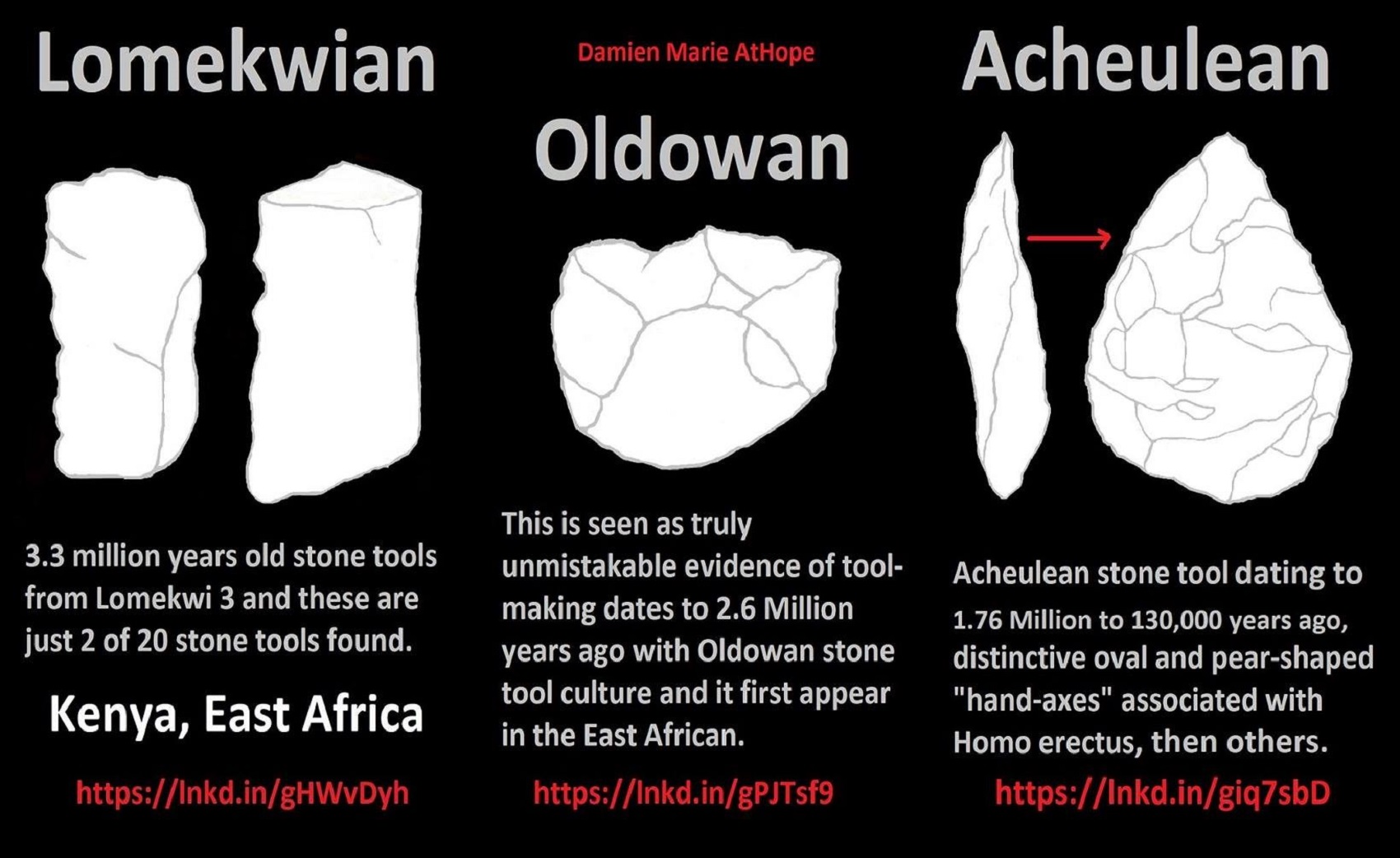
“Statistical assessment of the temporal and cultural relationship between the Lomekwian 3 dates to 3.3 million years ago and Oldowan 2.58 million years ago to 1.6 stone tool cultures.
Results suggest the Lomekwian and Oldoan result from the same cultural process. Both should currently be considered part of the same cultural evolutionary process.” ref

Early Stone Age (Lower Paleolithic): “The Lower Paleolithic is the earliest subdivision of the Paleolithic or Old Stone Age. It spans the time from around 3 million years ago when the first evidence for stone tool production and use by hominins appears in the current archaeological record, until around 300,000 years ago, spanning the Oldowan (“mode 1”) and Acheulean (“mode 2”) lithics industries. In African archaeology, the time period roughly corresponds to the Early Stone Age, the earliest finds dating back to 3.3 million years ago, with Lomekwian stone tool technology, spanning Mode 1 stone tool technology, which begins roughly 2.6 million years ago and ends between 400,000 and 250,000 years ago, with Mode 2 technology.” ref
Middle Stone Age (Middle Paleolithic): “The Middle Paleolithic (or Middle Palaeolithic) is the second subdivision of the Paleolithic or Old Stone Age as it is understood in Europe, Africa, and Asia. The term Middle Stone Age is used as an equivalent or a synonym for the Middle Paleolithic in African archeology. The Middle Paleolithic broadly spanned from 300,000 to 30,000 years ago. There are considerable dating differences between regions. The Middle Paleolithic was succeeded by the Upper Paleolithic subdivision which first began between 50,000 and 40,000 years ago. Pettit and White date the Early Middle Paleolithic in Great Britain to about 325,000 to 180,000 years ago (late Marine Isotope Stage 9 to late Marine Isotope Stage 7), and the Late Middle Paleolithic as about 60,000 to 35,000 years ago. According to the theory of the recent African origin of modern humans, anatomically modern humans began migrating out of Africa during the Middle Stone Age/Middle Paleolithic around 125,000 years ago and began to replace earlier pre-existent Homo species such as the Neanderthals and Homo erectus.” ref
“Middle Paleolithic burials at sites such as Krapina in Croatia (dated to c. 130,000 years ago) and the Qafzeh and Es Skhul caves in Israel (c. 100,000 years ago) have led some anthropologists and archeologists (such as Philip Lieberman) to believe that Middle Paleolithic cultures may have possessed a developing religious ideology which included concepts such as an afterlife; other scholars suggest the bodies were buried for secular reasons. According to recent archeological findings from Homo heidelbergensis sites in the Atapuerca Mountains, the practice of intentional burial may have begun much earlier during the late Lower Paleolithic, but this theory is widely questioned in the scientific community.” ref
“The earliest undisputed evidence of artistic expression during the Paleolithic period comes from Middle Paleolithic/Middle Stone Age sites such as Blombos Cave in the form of bracelets, beads, art rock, ochre used as body paint and perhaps in ritual, though earlier examples of artistic expression such as the Venus of Tan-Tan and the patterns found on elephant bones from Bilzingsleben in Thuringia may have been produced by Acheulean tool-users such as Homo erectus prior to the start of the Middle Paleolithic period. Activities such as catching large fish and hunting large game animals with specialized tools indicate increased group-wide cooperation and more elaborate social organization. In addition to developing advanced cultural traits, humans also first began to take part in long-distance trade between groups for rare commodities (such as ochre (which was often used for religious purposes such as ritual) and raw materials during the Middle Paleolithic as early as 120,000 years ago. Inter-group trade may have appeared during the Middle Paleolithic because trade between bands would have helped ensure their survival by allowing them to exchange resources and commodities such as raw materials during times of relative scarcity (i.e., famine or drought).” ref
Later Stone Age (Upper Paleolithic): “The Upper Paleolithic (or Upper Palaeolithic) is the third and last subdivision of the Paleolithic or Old Stone Age. Very broadly, it dates to between 50,000 and 12,000 years ago (the beginning of the Holocene), according to some theories coinciding with the appearance of behavioral modernity in early modern humans, until the advent of the Neolithic Revolution and agriculture. Anatomically modern humans (i.e. Homo sapiens) are believed to have emerged in Africa around 300,000 years ago, it has been argued by some that their ways of life changed relatively little from that of archaic humans of the Middle Paleolithic, until about 50,000 years ago, when there was a marked increase in the diversity of artifacts found associated with modern human remains. This period coincides with the most common date assigned to an expansion of modern humans from Africa throughout Asia and Eurasia, which contributed to the extinction of the Neanderthals. The Upper Paleolithic has the earliest known evidence of organized settlements, in the form of campsites, some with storage pits. Artistic work blossomed, with cave paintings, petroglyphs, carvings, and engravings on bone or ivory.” ref
“The first evidence of human fishing is also found, from artifacts in places such as Blombos cave in South Africa. More complex social groupings emerged, supported by more varied and reliable food sources and specialized tool types. This probably contributed to increasing group identification or ethnicity. The peopling of Australia most likely took place before c. 60,000 years ago. Europe was peopled after c. 45,000 years ago. Anatomically modern humans are known to have expanded northward into Siberia as far as the 58th parallel by about 45 ka (Ust’-Ishim man). The Upper Paleolithic is divided by the Last Glacial Maximum (LGM), from about 25,000 to 15,000 years ago. The peopling of the Americas occurred during this time, with East and Central Asia populations reaching the Bering land bridge after about 35 ka, and expanding into the Americas by about 15,000 years ago. In Western Eurasia, the Paleolithic eases into the so-called Epipaleolithic or Mesolithic from the end of the LGM, beginning 15 ka. The Holocene glacial retreat begins 11.7,00 years ago (10th millennium BCE), falling well into the Old World Epipaleolithic, and marking the beginning of the earliest forms of farming in the Fertile Crescent.” ref
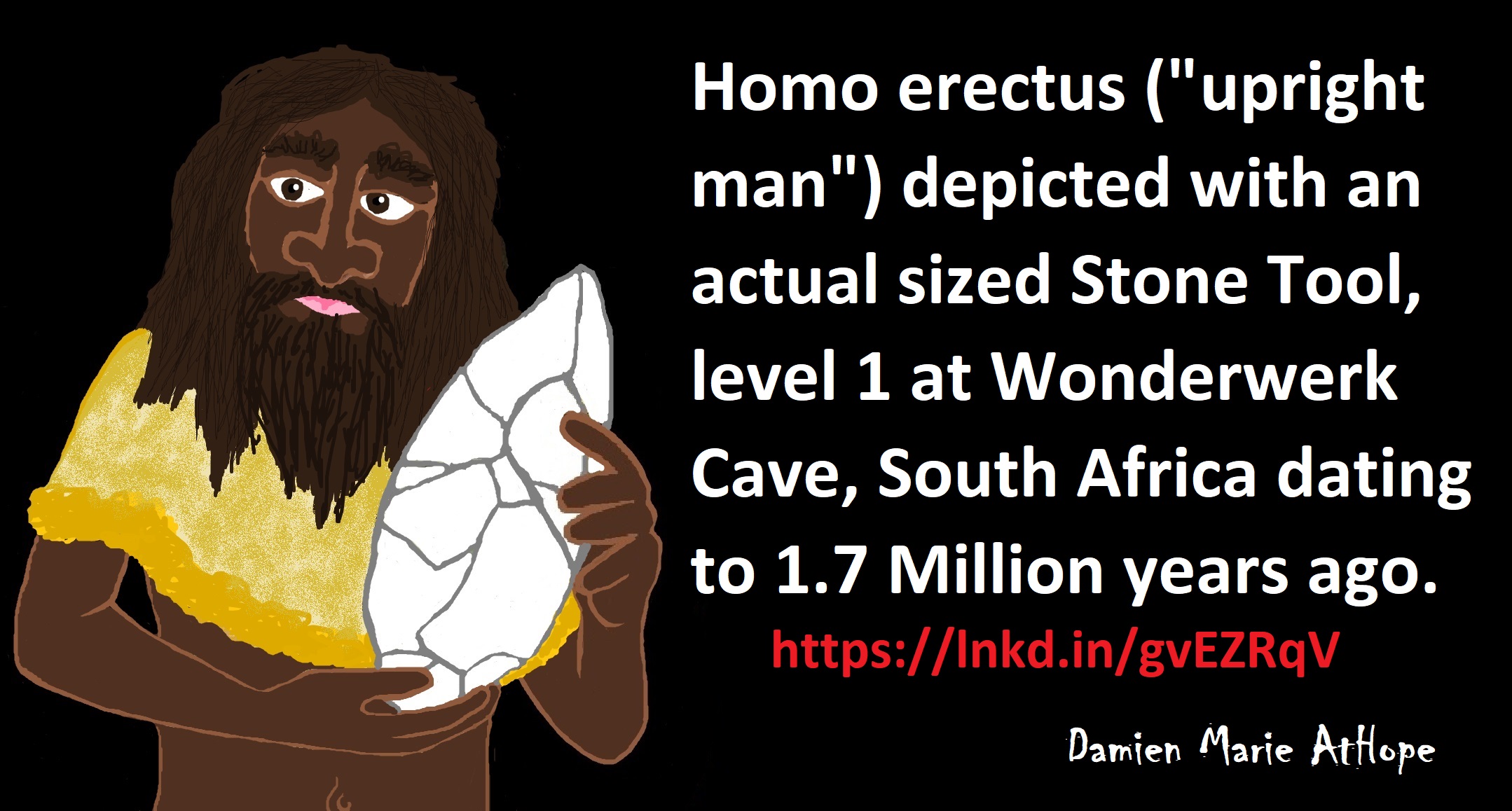
“Wonderwerk Cave is an archaeological site, in the Kuruman Hills, situated between Danielskuil and Kuruman in the Northern Cape Province, South Africa, dating suggests that basal sediment entered the cave some 2 million years ago. Evidence within Wonderwerk cave has been called the oldest controlled fire with what is thought to be Fire-Making by about 1.7 Million Years Ago. Moreover, evidence for fire-making ranges from the end of the Later Stone Age to the very base of the Acheulean. That discovery is seen to be in accord with findings from four other regional sites, which together provide evidence that can be construed as support for fire-making over almost the same time span.” ref, ref
“A handaxe (or hand ax) is a prehistoric stone tool with two faces that is the longest-used tool in human history. Hand axe tools were possibly used to butcher animals; to dig for tubers, animals, and water; to chop wood and remove tree bark; and/or process vegetal materials. Other scholars have proposed that hand axes were used to throw at prey; for a ritual or social purpose; or possibly as a source for flake tools. Moreover, No academic consensus describes their use, but it is commonly agreed that the hand axe was some form of unhafted all-purpose tool. The pioneers of Palaeolithic tool studies first suggested that bifaces were used as axes despite the fact that they have a sharp border all around. Other uses seem to show that hand axes were a multi-functional tool, leading some to describe them as the “Acheulean Swiss Army knife“. Other academics have suggested that the hand axe was simply a byproduct of being used as a core to make other tools, a weapon, and/or was perhaps used ritually.” ref
“Evidence for unusual symbolic activity in Wonderwerk date to around 400,000–500,000 years ago, which predates Middle Stone Age sites like Blombos Cave deposits that currently date at between c. 100,000 and 70,000 years ago.” ref, ref

Acheulean tools date to about 1.76 million to 130,000 years ago, are typically found with Homo erectus remains and were produced during the Lower Palaeolithic era across Africa and much of West Asia, South Asia, and Europe, and are typically found with Homo erectus remains. It is thought that Acheulean technologies developed from the more primitive Oldowan technology associated with Homo habilis. ref
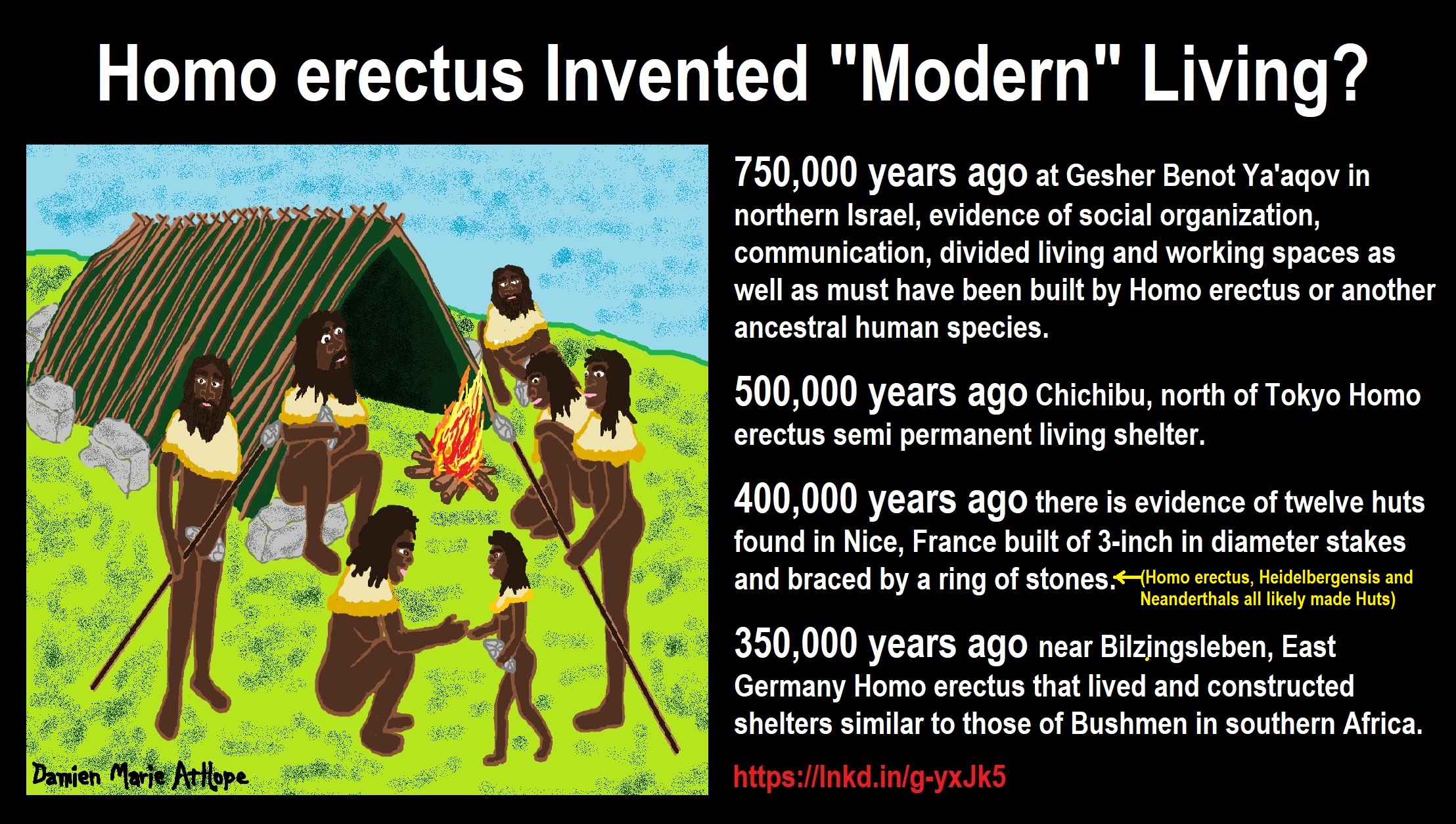
Homo erectus Invented “Modern” Living?
750,000 years ago at Gesher Benot Ya’aqov in northern Israel, is found some of the earliest known evidence of social organization, communication, and divided living and working spaces—all considered hallmarks of modern human behavior. The former hunter-gatherer encampment dates back as far as 750,000 years ago, and must have been built by Homo erectus or another ancestral human species. ref
Homo heidelbergensis likely emerged at least 600,000 years ago, left Africa between 300,000 to 400,000 years ago and is also believed to have lived in huts, utilised fire, use stone-tipped spears, and there is some evidence that they may have buried their dead which if confirmed, thought by some doubted, would be an indication of symbolic / abstract thought. Red ochre has also been found at some Homo heidelbergensis sites. The Homo heidelbergensis that remained in Africa would later evolve into Homo sapiens approximately 130,000 years ago. ref
500,000 years ago Chichibu, north of Tokyo Homo erectus semi permanent living shelter. It consists of what appear to be 10 post holes, forming two irregular pentagons which may be the remains of two huts. Thirty stone tools were also found scattered around the site. ref
400,000 years ago there is evidence of twelve huts found in Nice, France (the question is who made this, and the ideas rang from Homo erectus, Homo heidelbergensis to even possibly Neanderthals as all three are believed to make and live in Hut shelters at least at sometimes). They where oval shelters ranged from 26 feet to 49 feet in length and were between 13 feet and 20 feet wide. They were built of 3-inch in diameter stakes and braced by a ring of stones. Longer poles were set around the perimeter as supports. The huts had hearths and pebble-lined pits and were defined by stake holes. ref
350,000 years ago near Bilzingsleben, East Germany Homo erectus that lived and constructed shelters similar to those of Bushmen in southern Africa. Circular bone and stone foundations were discovered for three huts between 9 and 13 feet across. In the middle of on circle, archaeologist found an elephant tusk, which they speculated was a center post. ref
Daniel L. Everett: How Language Began. Homo erectus and the Origin of Language (video)
Book: How Language Began: The Story of Humanity’s Greatest Invention
- Average Customer Review: 3.9 out of 5 stars 25 customer reviews
How Language Began revolutionizes our understanding of the one tool that has allowed us to become the “lords of the planet.”
“Mankind has a distinct advantage over other terrestrial species: we talk to one another. But how did we acquire the most advanced form of communication on Earth? Daniel L. Everett, a “bombshell” linguist and “instant folk hero” (Tom Wolfe, Harper’s), provides in this sweeping history a comprehensive examination of the evolutionary story of language, from the earliest speaking attempts by hominids to the more than seven thousand languages that exist today.” ref
“Although fossil hunters and linguists have brought us closer to unearthing the true origins of language, Daniel Everett’s discoveries have upended the contemporary linguistic world, reverberating far beyond academic circles. While conducting field research in the Amazonian rainforest, Everett came across an age-old language nestled amongst a tribe of hunter-gatherers. Challenging long-standing principles in the field, Everett now builds on the theory that language was not intrinsic to our species. In order to truly understand its origins, a more interdisciplinary approach is needed―one that accounts as much for our propensity for culture as it does our biological makeup.” ref
“Language began, Everett theorizes, with Homo Erectus, who catalyzed words through culturally invented symbols. Early humans, as their brains grew larger, incorporated gestures and voice intonations to communicate, all of which built on each other for 60,000 generations. Tracing crucial shifts and developments across the ages, Everett breaks down every component of speech, from harnessing control of more than a hundred respiratory muscles in the larynx and diaphragm, to mastering the use of the tongue. Moving on from biology to execution, Everett explores why elements such as grammar and storytelling are not nearly as critical to language as one might suspect.” ref
“In the book’s final section, Cultural Evolution of Language, Everett takes the ever-debated “language gap” to task, delving into the chasm that separates “us” from “the animals.” He approaches the subject from various disciplines, including anthropology, neuroscience, and archaeology, to reveal that it was social complexity, as well as cultural, physiological, and neurological superiority, that allowed humans―with our clawless hands, breakable bones, and soft skin―to become the apex predator.” ref
“How Language Began ultimately explains what we know, what we’d like to know, and what we likely never will know about how humans went from mere communication to language. Based on nearly forty years of fieldwork, Everett debunks long-held theories by some of history’s greatest thinkers, from Plato to Chomsky. The result is an invaluable study of what makes us human.” ref
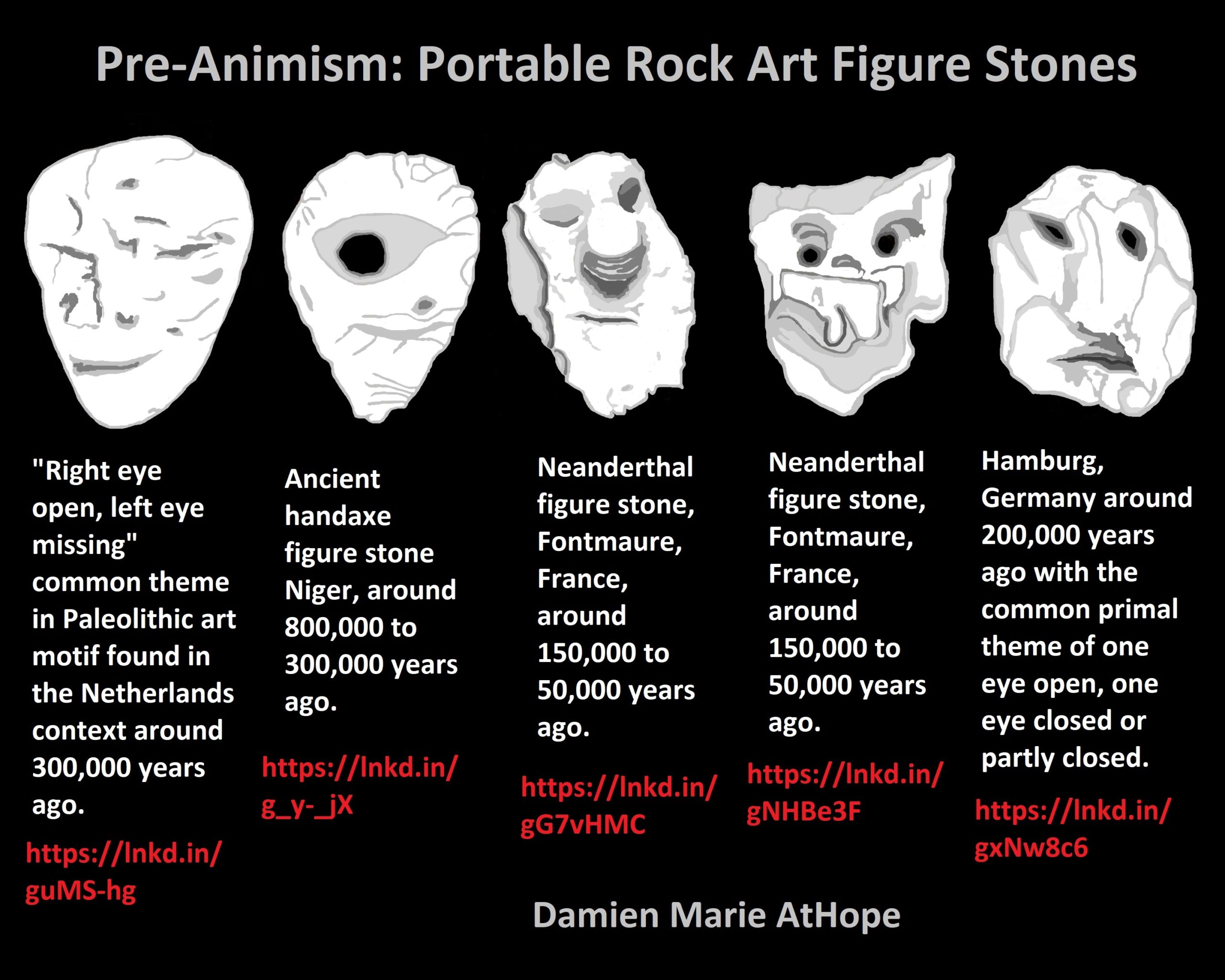
Pre-Animism: Portable Rock Art Figure Stones
Ancient handaxe figure stone Niger, around 800,000 to 300,000 years ago. ref
“Right eye open, left eye missing”a common theme in Paleolithic art motif found in the Netherlands context around 300,000 years ago. ref
Neanderthal figure stone, Fontmaure, France, around 150,000 to 50,000 years ago. ref, ref
Hamburg, Germany around 200,000 years ago with the common primal theme of one eye open, one eye closed or partly closed. ref
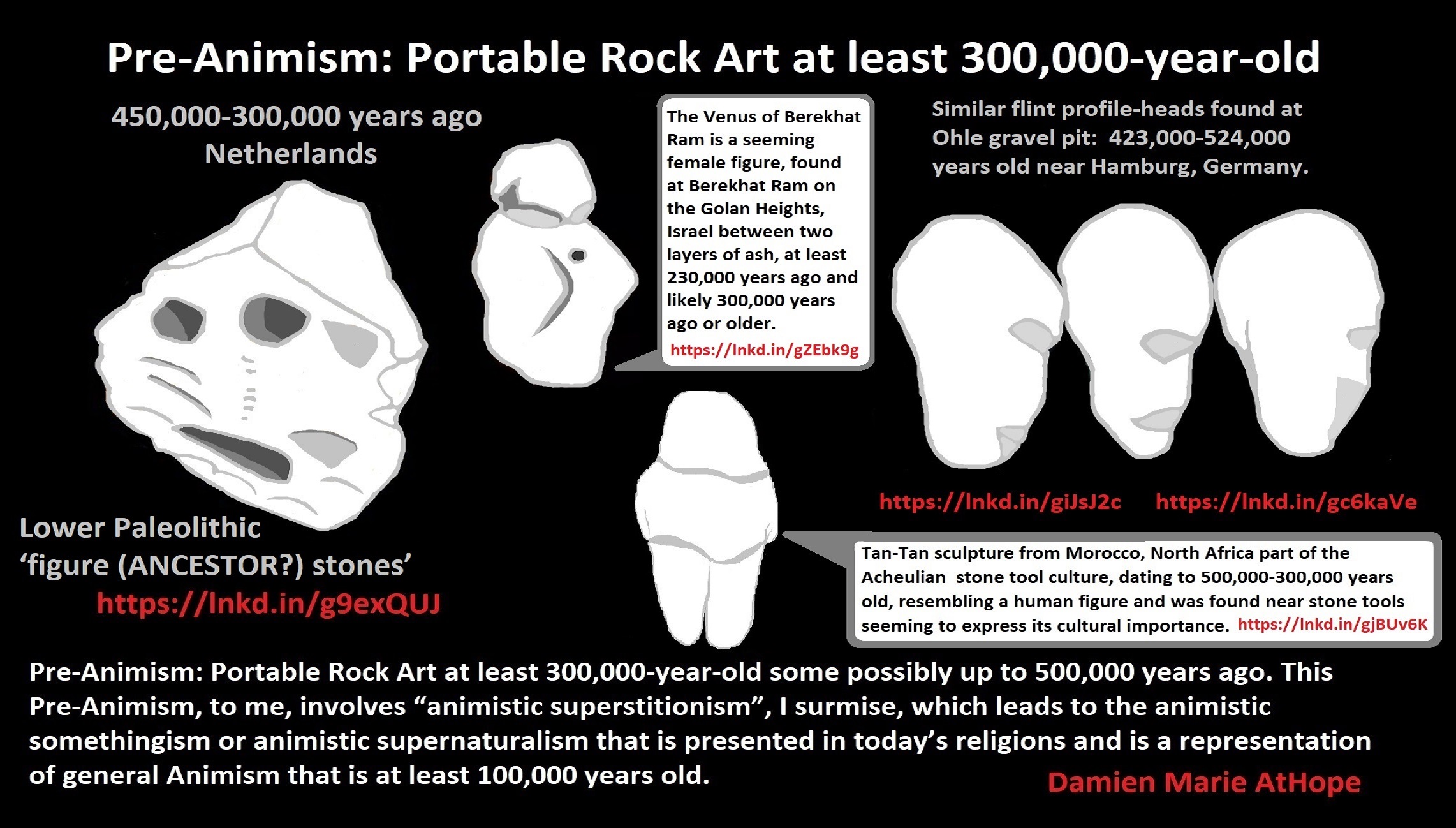
Pre-Animism: Portable Rock Art at least 300,000-year-old
The Origin of Us- Spread of Humans, Ancient African Languages, Stone Tools and Cognition
Prehistoric Art of the Stone Age: Types, Characteristics, Chronology
- Lower Paleolithic (2.5 million – 200,000 years ago)
- Middle Paleolithic (200,000 – 42,000 years ago)
- Upper Paleolithic (Europe and Rest of World 42,000-12,000 years ago)
- Mesolithic Culture
- (12,000-10,000 years ago the Middle East and Rest of World), (12,000-9,000 years ago Southeast Europe), (12,000-6,000 years ago Northern and Western Europe)
- Neolithic Culture
- (10,000-2,000 years ago: the Middle East & Rest of World), (8,000 – 4,000 years ago: Southeast Europe), (6,000-4,000 years ago: Northern and Western Europe)
- Bronze Age Art (Europe, 5,000-3,200 years ago)
- Iron Age Art (Europe, 3,500-2,200 years ago)

Fossils from Morocco suggest the Homo sapiens lineage became distinct as early as 350,000 years ago, adding as much as 150,000 years to our species’ history, as before it was assumed our Human line emerged around 200,000 years ago. ref
Humans are not the only species, which bury their dead. The practice has been observed in chimpanzees, elephants, and possibly dogs. Intentional burial, particularly with grave goods, signify a “concern for the dead” and Neanderthals were the first human species to practice burial behavior and intentionally bury their dead, doing so in shallow graves along with stone tools and animal bones. Exemplary sites include Shanidar in Iraq, Kebara Cave in Israel, and Krapina in Croatia. The earliest undisputed human burial dates back 100,000 years ago with remains stained with red ochre, which show ritual intentionality similar to the Neanderthals before them. ref, ref
“300,000 years ago: the first possible appearance of Homo sapiens, in Jebel Irhoud, Morocco.
- 270,000 years ago: age of Y-DNA haplogroup A00(“Y-chromosomal Adam“).
- 250,000 years ago: the first appearance of Homo neanderthalensis (Saccopastore skulls)
- 250,000-200,000 years ago: modern human presence in West Asia (Misliya cave)
- 230,000–150,000 years ago: age of mt-DNA haplogroup L (“Mitochondrial Eve“)
- 195,000 years ago: Omo remains (Ethiopia), the emergence of anatomically modern humans.
- 160,000 years ago: Homo sapiens idaltu
- 170,000 years ago: humans are wearing clothing by this date.
- 150,000 years ago: Peopling of Africa: Khoisanid separation, an age of mtDNA haplogroup L0
- 125,000 years ago: the peak of the Eemian interglacial period.
- 120,000–90,000 years ago: Abbassia Pluvial in North Africa—the Sahara desert region is wet and fertile.” ref
Neanderthals, diverged from Arcane Humans around 500,000, with several likely occurrences of interbreeding after that. Evidence from Neanderthal DNA found in a German cave expresses early interbreeding, dating back more than 200,000 years. Moreover, a 200,000 years old prehistoric jawbone was found in an Israeli cave. Then there is DNA evidence for interbreeding around 100,000 years ago from the Altai mountains on the Russia-Mongolia border. An early modern human population left Africa much earlier met with Neanderthals, possibly those moving from Europe towards the East, sometime around 100,000 years ago. Anatomically modern humans migrated massively from Africa into the Middle East and later Europe, starting some 65,000 years ago. Anatomically modern humans migrated massively from Africa into the Middle East and later Europe, starting some 65,000 years ago. A 55,000-year-old incomplete skull found in Israel may belong to a human group that interbred with Neanderthals. And then there is interbreeding with modern humans about 65,000-47,000 years ago, With East Asian populations, genetics relating to Neanderthals emerging around 45,000 years ago. Modern Humans share 99% their genes with Neanderthal “proto-humans.” DNA analysis of one of the oldest Homo sapiens skeletons in Europe, also found in Romania and dated to around 40,000 years ago, has shown that this individual’s ancestors had interbred with Neanderthals between four to six generations earlier. ref, ref, ref, ref, ref, ref
Genome studies of Neanderthals (Homo neanderthalensis) and of both ancient and contemporary H. sapiens suggest that the two species interbred somewhere in the Middle East between 50,000 and 60,000 years ago. But no remains of anatomically modern humans have been discovered in the Middle East from this crucial period, after H. sapiens left Africa and before it colonized Europe and Asia. Ref
Neanderthal introgression within the chromosome 3p21.31 region, occurring with a high frequency in East Asians (ranging from 49.4% to 66.5%) and at a low frequency in Europeans. We also detected a signal of strong positive selection in this region only in East Asians. Our data indicate that likely candidate targets of selection include rs12488302-T and its associated alleles—among which four are nonsynonymous, including rs35455589-G in HYAL2, a gene related to the cellular response to ultraviolet-B irradiation. Furthermore, suggestive evidence supports latitude-dependent selection, implicating a role of ultraviolet-B. Interestingly, the distribution of rs35455589-G suggests that this allele was lost during the exodus of ancestors of modern Eurasians from Africa and reintroduced to Eurasians from Neanderthals.The introgressive haplotypes were positively selected in only East Asian populations, rising steadily from 45,000 years ago until a sudden increase of growth rate around 5,000 to 3,500 years ago. They occur at very high frequencies among East Asian populations in contrast to other Eurasian populations (e.g. European and South Asian populations). The findings also suggests that this Neanderthal introgression occurred within the ancestral population shared by East Asians and Native Americans. Ref
Analyzing chromosome 21 of the Altai (Siberia), El Sidrón (Spain), and Vindija (Croatia) Neanderthals, it is determined that—of these three lineages—only the El Sidrón and Vindija Neanderthals display significant rates of gene flow (0.3–2.6%) into modern humans, suggesting that the El Sidrón and Vindija Neanderthals are more closely related than the Altai Neanderthal to the Neanderthals that interbred with modern humans about 47,000–65,000 years ago. Conversely, it is also determined that significant rates of modern human gene flow into Neanderthals occurred—of the three examined lineages—for only the Altai Neanderthal (0.1–2.1%), suggesting that modern human gene flow into Neanderthals mainly took place after the separation of the Altai Neanderthals from the El Sidrón and Vindija Neanderthals that occurred roughly 110,000 years ago. The findings show that the source of modern human gene flow into Neanderthals originated from a population of early modern humans from about 100,000 years ago, predating the out-of-Africa migration of the modern human ancestors of present-day non-Africans. ref
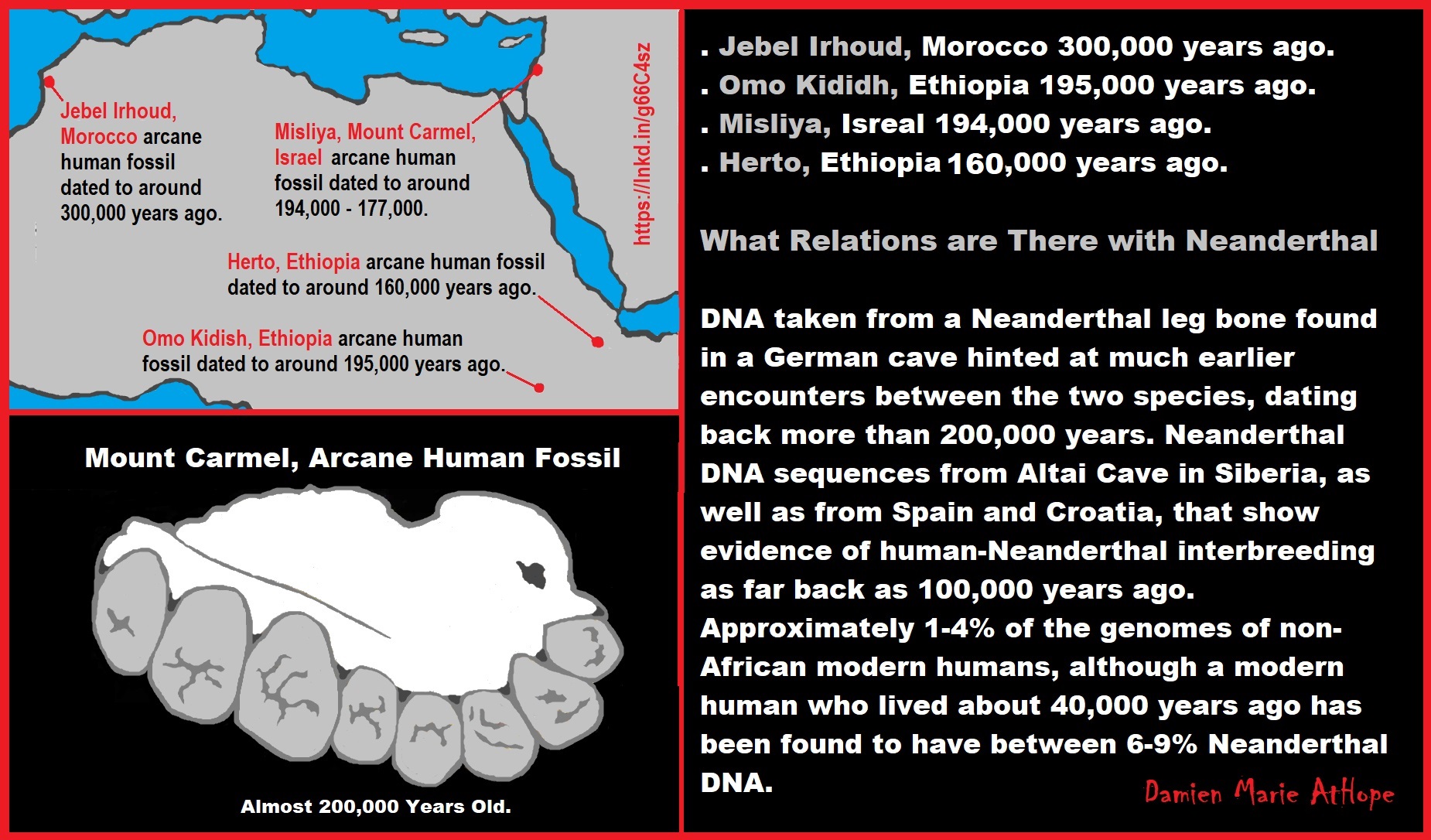
. Jebel Irhoud, Morocco 300,000 years ago. ref
. Omo Kididh, Ethiopia 195,000 years ago. ref
. Misliya, Isreal 194,000 years ago. ref
. Herto, Ethiopia 160,000 years ago. ref
What Relations are There with Neanderthal
DNA taken from a Neanderthal leg bone found in a German cave hinted at much earlier encounters between the two species, dating back more than 200,000 years. Neanderthal DNA sequences from Altai Cave in Siberia, as well as from Spain and Croatia, that show evidence of human-Neanderthal interbreeding as far back as 100,000 years ago. Approximately 1-4% of the genomes of non-African modern humans, although a modern human who lived about 40,000 years ago has been found to have between 6-9% Neanderthal DNA. ref, ref
Although all of the early fossils of Homo sapiens are found with Middle Stone Age artifacts, it is unlikely that our species was the exclusive author of MSA lithic technology. On present evidence, the oldest Middle Stone Age sites are in eastern Africa, at around 276,000 years ago, such as at Gademotta, Ethiopia. The overlap between age estimates for the earliest MSA and the latest Acheulian sites supports the hypothesis of a prolonged shift to MSA technologies. The youngest reported Acheulian artifacts are surface collected from the Herto Member of the Bouri Formation of Ethiopia, dated to around 154–160,000 years ago, and in situ material around 125,000 years ago from Abdur, Eritrea, in northeast Africa. The Acheulian attribution of the material from Abdur results suggest around 100,000–150,000 years overlap between Acheulian and MSA technologies in eastern Africa. There remains the possibility that the Acheulian artifacts from the Herto Member are older than the dated sediments by an unknown but possibly large interval. ref, ref
However, L0 most likely has a southern African origin on the basis of its prevalence in indigenous Khoe (both herder and hunter-gatherer) and San (Ju- and Tuu-speaking “Bushman” hunter-gatherer) populations, as well as in exclusively southern African Bantu speakers – although one of the main subclades of L0 (L0a’b’f) may have an eastern African origin. Thus from the time after the main African clades have evolved they can prove highly informative; but the final path back to the human mtDNA root remains mysterious. Furthermore, it is not clear that different systems are informing us about the same phenomena. “Modern” features in human anatomy, appear ~150,000–200,000 years ago, and predominate in Africa after 130,000 years ago, but there is no indication in the fossil record of a speciation event at this time, and Homo sapiensemerges gradually from more archaic specimens in Africa over the preceding few hundred thousand years. ref
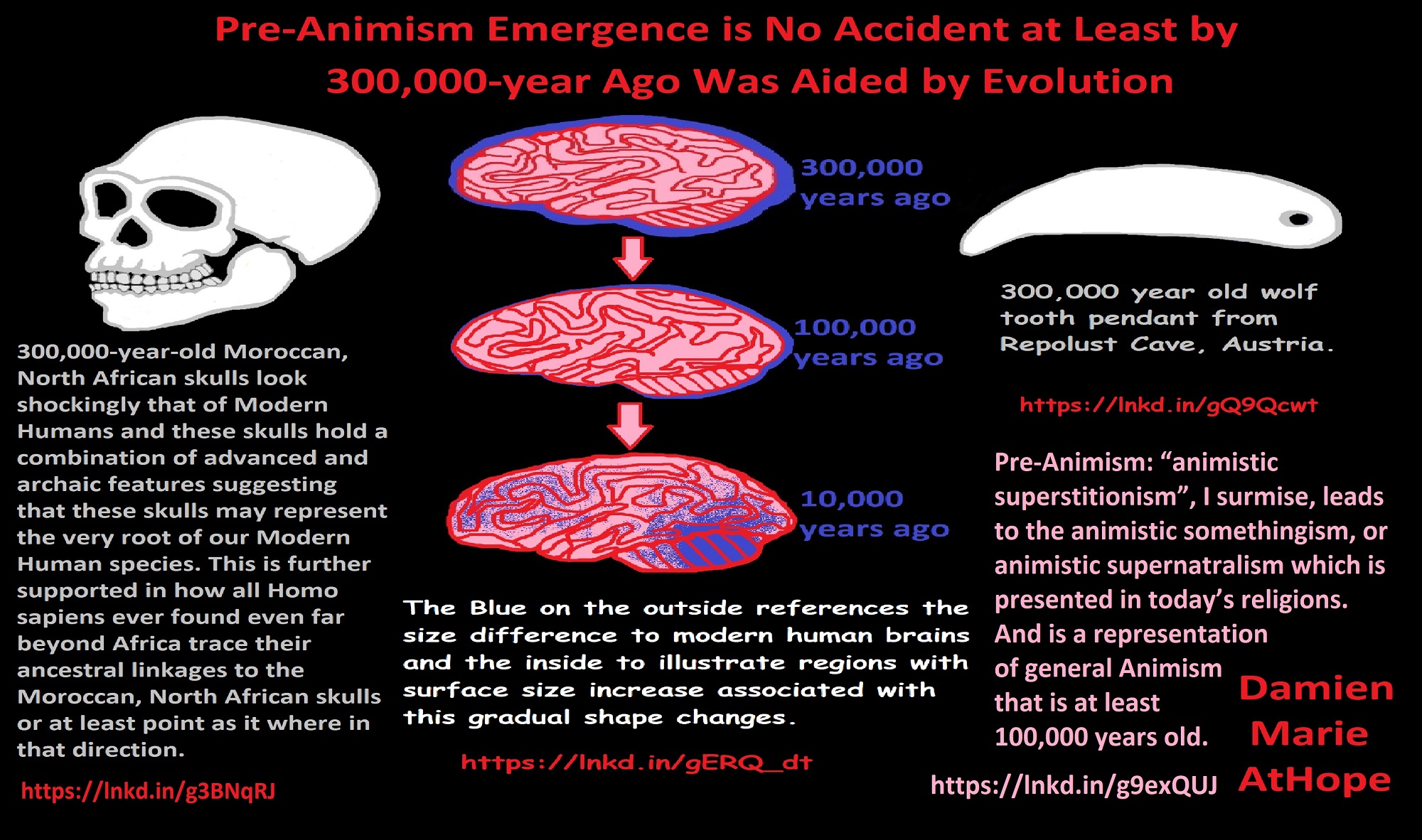
Pre-Animism Emergence is No Accident at Least by 300,000-year Ago Was Aided by Evolution
Pre-Animism: “animistic superstitionism”, I surmise, leads to the animistic somethingism, or animistic supernatralism is presented in today’s religions and is a representation of general Animism that is at least 100,000 years old. ref
The Blue on the outside references the size difference to modern human brains and the inside to illustrate regions with surface size increase associated with this gradual shape changes. ref
300,000-year-old Moroccan, North African skulls look shockingly that of Modern Humans and these skulls hold a combination of advanced and archaic features suggesting that these skulls may represent the very root of our Modern Human species. This is further supported in how all Homo sapiens ever found even far beyond Africa trace their ancestral linkages to the Moroccan, North African skulls or at least point as it where in that direction. And seemingly Homo sapiens could have been living across Africa and sem9ingly engaging in extensive movement, which could have involved exchange both in ideas, technology as well as even genetics. ref
300,000-year-old wolf tooth pendant from Repolust Cave, Austria. ref

Three, 200,000 years old fragments of ostrich-eggshell beads, connecting to Late Acheulian of El Greifa E, Libya which are similar to beads found at two Upper Palaeolithic sites in India. Ref
What is the meaning of early beads and pendants? Well, for sure some beads, in which production has been pushed to the limits allowed by the medium, seem to express a sense of perfection, and it is contended that beads are among the most informative forms of exograms that could possibly have survived from these very early times. A key requisite for the use and appreciation of all beads and pendants is a level of hominin self-awareness that essentially expresses full cognitive modernity. Beads can be used in a number of ways or for several purposes and provide various forms of information about the wearer and the possible status in their society/culture. One might believe that beads are simply a body adornment, but this is almost certainly an oversimplification that is limited as o the original meaning (if they relate to stars it could be thought to represent the ancestors. The concept of “Personal Adornment” itself is rather anthropocentric; we do not assume that other animals perceive the information imparted by the beads as meaningful. Ref
Estimates for the date at which early migration out of sub-Saharan Africa occurred vary from 200,000 to 80,000 years ago, evidence is elusive, but the excavation of what is being called ‘the deepest archaeological trench in North Africa’ has now proved that modern humans were living on the north coast of Libya at least 80,000 years ago; the question now is just how much further back they go but it is thought that the deepest archaeological trench in North Africa has potentially a 200,000-year-old story to tell. Moreover, modern humans (Homo sapiens) did not arrive in North Africa until around 40,000 years ago, which is about when they reached Europe. ref

Neanderthals, diverged from Arcane Humans around 500,000, with several likely occurrences of interbreeding after that. Evidence from Neanderthal DNA found in a German cave expresses early interbreeding, dating back more than 200,000 years. Moreover, a 200,000 years old prehistoric jawbone was found in an Israeli cave. Then there is DNA evidence for interbreeding around 100,000 years ago from the Altai mountains on the Russia-Mongolia border. An early modern human population left Africa much earlier met with Neanderthals, possibly those moving from Europe towards the East, sometime around 100,000 years ago. Anatomically modern humans migrated massively from Africa into the Middle East and later Europe, starting some 65,000 years ago. Anatomically modern humans migrated massively from Africa into the Middle East and later Europe, starting some 65,000 years ago. A 55,000-year-old incomplete skull found in Israel may belong to a human group that interbred with Neanderthals. And then there is interbreeding with modern humans about 65,000-47,000 years ago, With East Asian populations, genetics relating to Neanderthals emerging around 45,000 years ago. Modern Humans share 99% their genes with Neanderthal “proto-humans.” DNA analysis of one of the oldest Homo sapiens skeletons in Europe, also found in Romania and dated to around 40,000 years ago, has shown that this individual’s ancestors had interbred with Neanderthals between four to six generations earlier. ref, ref, ref, ref, ref, ref
Genome studies of Neanderthals (Homo neanderthalensis) and of both ancient and contemporary H. sapiens suggest that the two species interbred somewhere in the Middle East between 50,000 and 60,000 years ago. But no remains of anatomically modern humans have been discovered in the Middle East from this crucial period, after H. sapiens left Africa and before it colonized Europe and Asia. ref
Neanderthal introgression within the chromosome 3p21.31 region, occurring with a high frequency in East Asians (ranging from 49.4% to 66.5%) and at a low frequency in Europeans. We also detected a signal of strong positive selection in this region only in East Asians. Our data indicate that likely candidate targets of selection include rs12488302-T and its associated alleles—among which four are nonsynonymous, including rs35455589-G in HYAL2, a gene related to the cellular response to ultraviolet-B irradiation. Furthermore, suggestive evidence supports latitude-dependent selection, implicating a role of ultraviolet-B. Interestingly, the distribution of rs35455589-G suggests that this allele was lost during the exodus of ancestors of modern Eurasians from Africa and reintroduced to Eurasians from Neanderthals.The introgressive haplotypes were positively selected in only East Asian populations, rising steadily from 45,000 years ago until a sudden increase of growth rate around 5,000 to 3,500 years ago. They occur at very high frequencies among East Asian populations in contrast to other Eurasian populations (e.g. European and South Asian populations). The findings also suggests that this Neanderthal introgression occurred within the ancestral population shared by East Asians and Native Americans. Ref
Analyzing chromosome 21 of the Altai (Siberia), El Sidrón (Spain), and Vindija (Croatia) Neanderthals, it is determined that—of these three lineages—only the El Sidrón and Vindija Neanderthals display significant rates of gene flow (0.3–2.6%) into modern humans, suggesting that the El Sidrón and Vindija Neanderthals are more closely related than the Altai Neanderthal to the Neanderthals that interbred with modern humans about 47,000–65,000 years ago. Conversely, it is also determined that significant rates of modern human gene flow into Neanderthals occurred—of the three examined lineages—for only the Altai Neanderthal (0.1–2.1%), suggesting that modern human gene flow into Neanderthals mainly took place after the separation of the Altai Neanderthals from the El Sidrón and Vindija Neanderthals that occurred roughly 110,000 years ago. The findings show that the source of modern human gene flow into Neanderthals originated from a population of early modern humans from about 100,000 years ago, predating the out-of-Africa migration of the modern human ancestors of present-day non-Africans. ref

Neanderthals “Primal Religion (Pre-Animism/Animism?)” Mystery Cave Rings 175,000 Years Ago
Neanderthals “Primal Religion (Pre-Animism/Animism?)”, Mystery Cave Rings 175,000 Years Ago, possibly a chapel or sacred space? Well, we do know it had meaning in some symbolic way, and they easily predate the arrival of modern humans in Europe. Thus, likely, they were built by Neanderthals, the only hominins in the region. The stalagmite structures are 50 centimeters high in places, says Jaubert. They are built from around 400 individual stalagmites with a combined weight of about 2 tons which must take time [to shift] and thus some time and effort to arrange the structures. ref
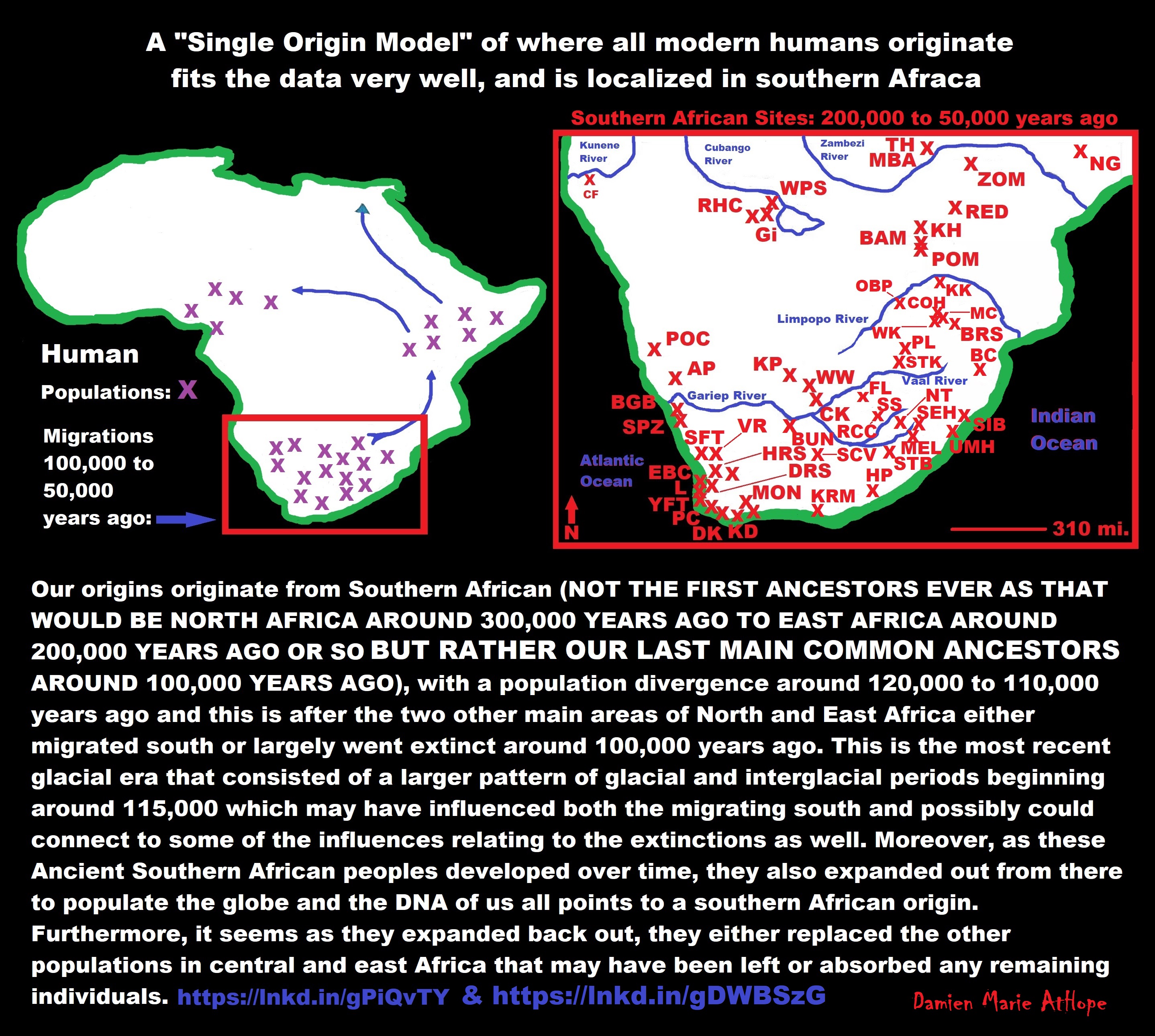
Our origins originate from Southern African (NOT THE FIRST ANCESTORS EVER AS THAT WOULD BE NORTH AFRICA AROUND 300,000 YEARS AGO TO EAST AFRICA AROUND 200,000 YEARS AGO OR SO BUT RATHER OUR LAST MAIN COMMON ANCESTORS AROUND 100,000 YEARS AGO), with a population divergence around 120,000 to 110,000 years ago and this is after the two other main areas of North and East Africa either migrated south or largely went extinct around 100,000 years ago. This is the most recent glacial era that consisted of a larger pattern of glacial and interglacial periods beginning around 115,000 which may have influenced both the migrating south and possibly could connect to some of the influences relating to the extinctions as well. Moreover, as these Ancient Southern African peoples developed over time, they also expanded out from there to populate the globe and the DNA of us all points to a southern African origin. Furthermore, it seems as they expanded back out, they either replaced the other populations in central and east Africa that may have been left or absorbed any remaining individuals. Ref
Southern African Middle Stone Age sites:
(Ap) Apollo 11; (BAM) Bambata; (BBC) Blombos Cave; (BC) Border Cave; (BGB)Boegoeberg; (BPA) Boomplaas; (BRS) Bushman Rock Shelter; (BUN) Bundu Farm; (CF)Cufema Reach; (CK) Canteen Kopje; (COH) Cave of Hearths; (CSB) Cape St Blaize; (DK)Die Kelders Cave 1; (DRS) Diepkloof Rock Shelter; (EBC) Elands Bay Cave; (FL) Florisbad; (≠GI) ≠Gi; (HP) Howiesons Poort; (HRS) Hollow Rock Shelter; (KD) Klipdrift; (KKH) Klein Kliphuis; (KH) Khami; (KK) Kudu Koppie; (KP) Kathu Pan; (KRM) Klasies River Main Site; (L) Langebaan; (MBA) Mumbwa Caves; (MC) Mwulu’s Cave; (MEL)Melikane; (MON) Montagu Cave; (NBC) Nelson Bay Cave; (NG) Ngalue; (NT) Ntloana Tšoana; (OBP) Olieboomspoort; (PC) Peers Cave; (POC) Pockenbank; (PL) Plover’s Lake; (POM) Pomongwe; (PP) Pinnacle Point; (RCC) Rose Cottage Cave; (RED) Redcliff; (RHC) Rhino Cave; (SCV) Seacow Valley; (SFT) Soutfontein; (SEH) Sehonghong; (SIB)Sibudu Cave; (SPZ) Spitzkloof Rock Shelter; (SS) Sunnyside 1; (STB) Strathalan Cave B; (STK) Sterkfontein; (TR) Twin Rivers; (UMH) Umhlatuzana; (VR) Varsche Rivier 003; (WPS) White Paintings Shelter; (WK) Wonderkrater; (WW) Wonderwerk; (YFT)Ysterfontein 1; (ZOM) Zombepata Cave. Ref
Africa’s Middle Stone Age is best known for innovations that appearing various times after about 200,000 years ago. Such innovations might have been linked to new types of social behavior as well as pulses in movements within and out of the continent of Africa. Population shifts likely occurred repeatedly during the 200,000 to 50,000 years ago. Southern African sites seem concentrated in the interior of the subcontinent before 130,000 years ago seemingly coinciding with the dispersal after 130,000 years ago of populations from the interior to mountainous areas, but, more particularly, to the coastal stretches of the southern and western Cape. Then by around 58,000 years ago occupations tended once more to shift away from the southern coast and back into the interior, or to the eastern seaboard. Regional and even local variability is characteristic of stone artifacts of the time, while sites seem to have fewer ornaments or decorated items than was formerly the case. ref
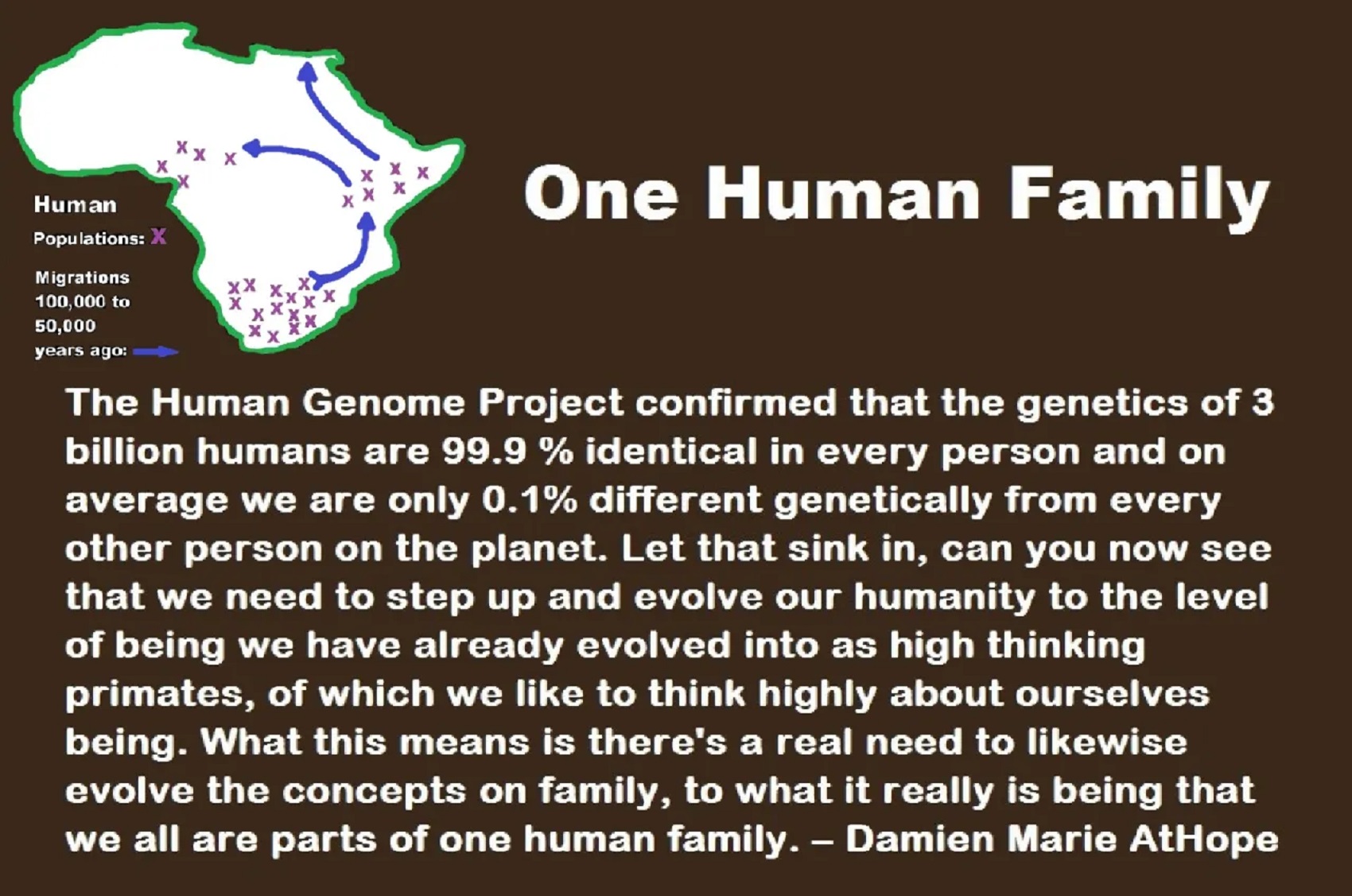
“When researchers completed the final analysis of the Human Genome Project in April 2003, they confirmed that the 3 billion base pairs of genetic letters in humans were 99.9 percent identical in every person. It also meant that individuals are, on average, 0.1 percent different genetically from every other person on the planet. And in that 0.1 percent lies the mystery of why some people are more susceptible to a particular illness or more likely to be healthy than their neighbor – or even another family member.” ref
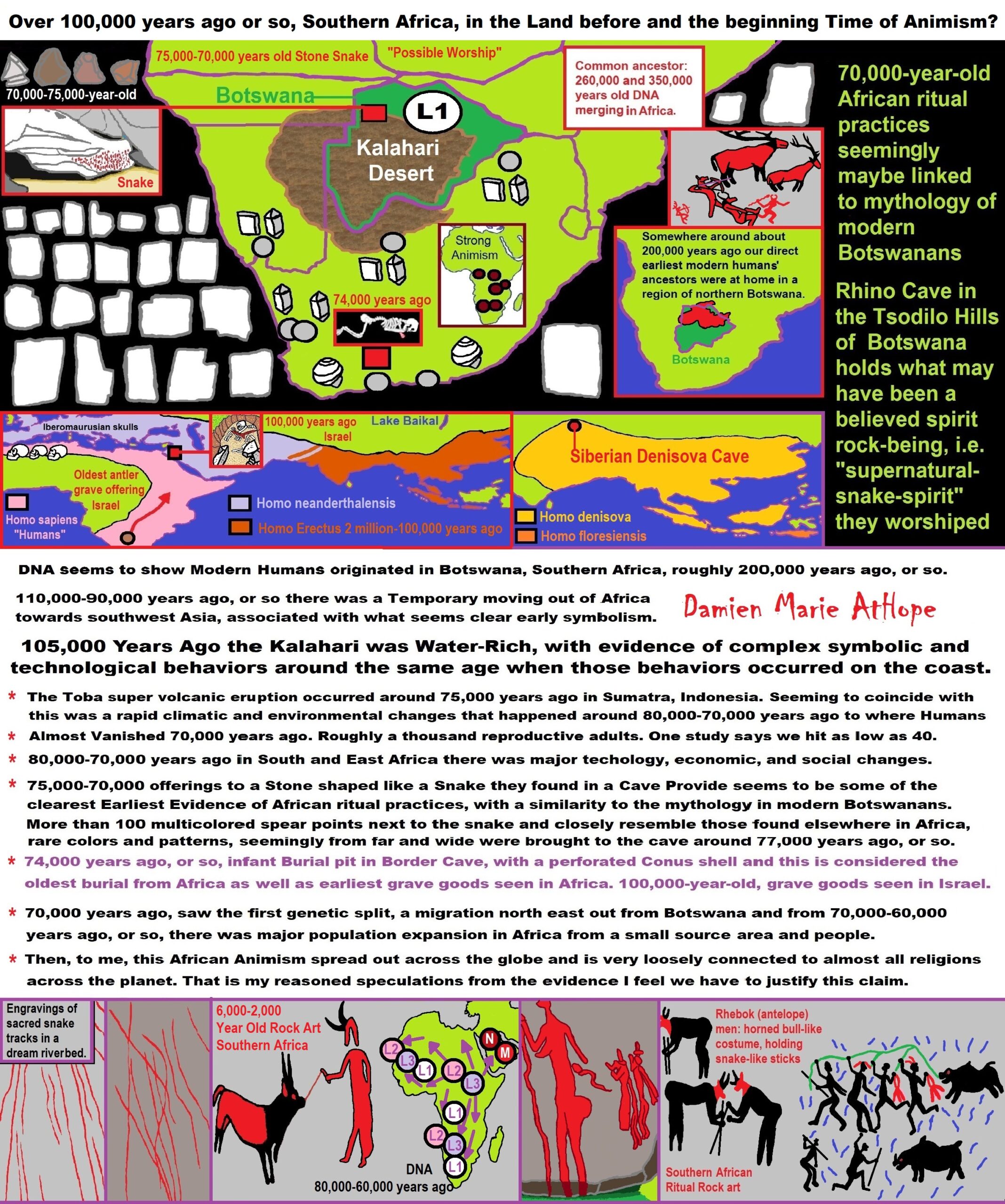
ref, ref, ref, ref, ref, ref, ref, ref, ref, ref, ref, ref, ref, ref, ref, ref, ref, ref, ref, ref, ref, ref, ref, ref, ref, ref, ref, ref, ref, ref, ref, ref, ref, ref, ref, ref, ref, ref, ref, ref, ref, ref, ref, ref, ref, ref, ref, ref, ref, ref, ref, ref
Animism: a belief among some indigenous people, young children, or all religious people!
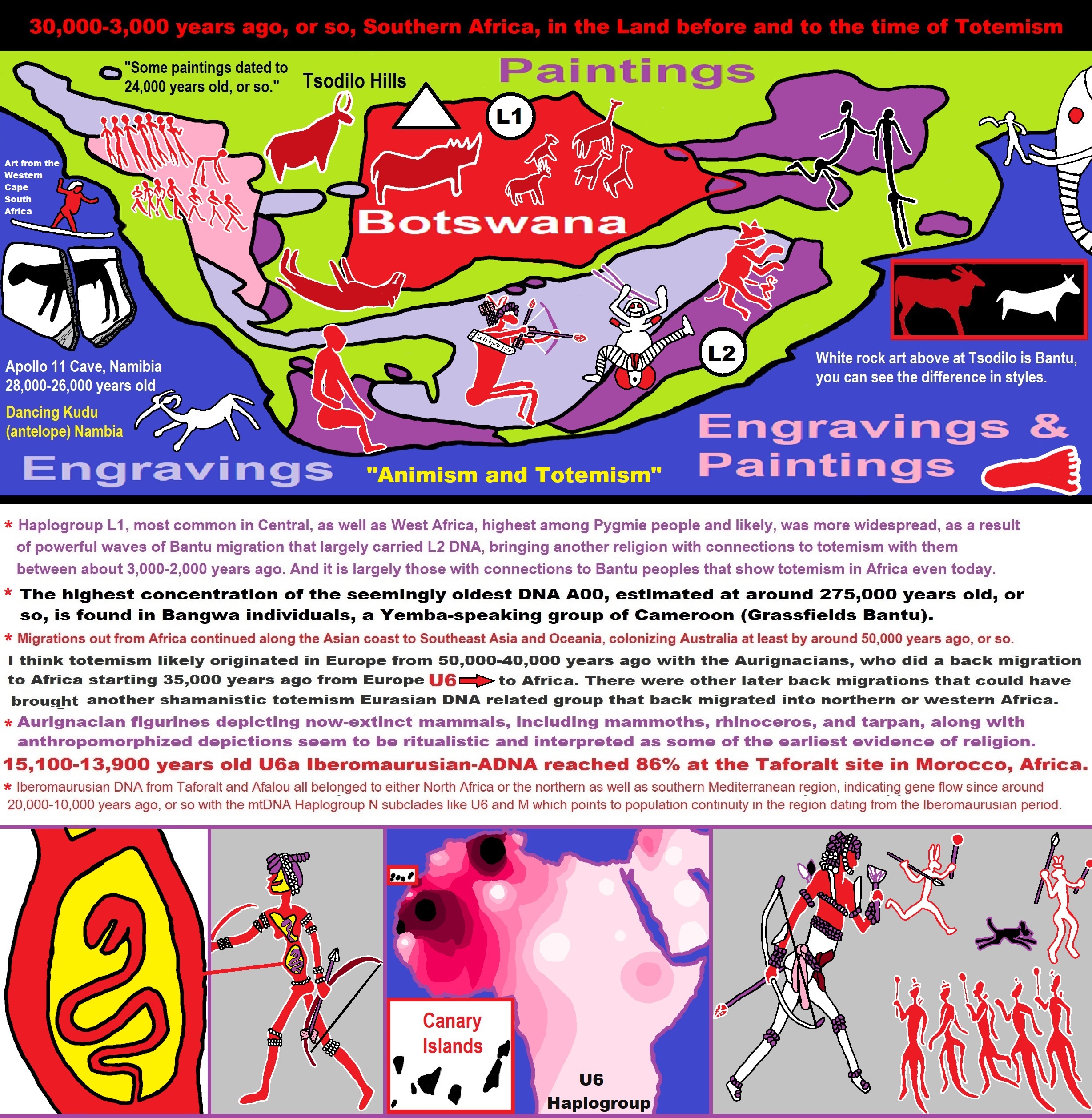
ref, ref, ref, ref, ref, ref, ref, ref, ref, ref, ref, ref, ref, ref, ref, ref, ref, ref, ref, ref, ref, ref, ref, ref, ref, ref, ref, ref, ref, ref, ref, ref, ref, ref, ref, ref, ref, ref, ref, ref, ref, ref, ref, ref, ref, ref, ref, ref, ref, ref, ref, ref, ref, ref, ref, ref, ref, ref, ref, ref,
Explaining the Earliest Religious Expression, that of Animism (beginning 100,000 to 70,000 years ago?) to Totemism (beginning 30,000 to 3,000 years ago?) in Southern Africa: LINK
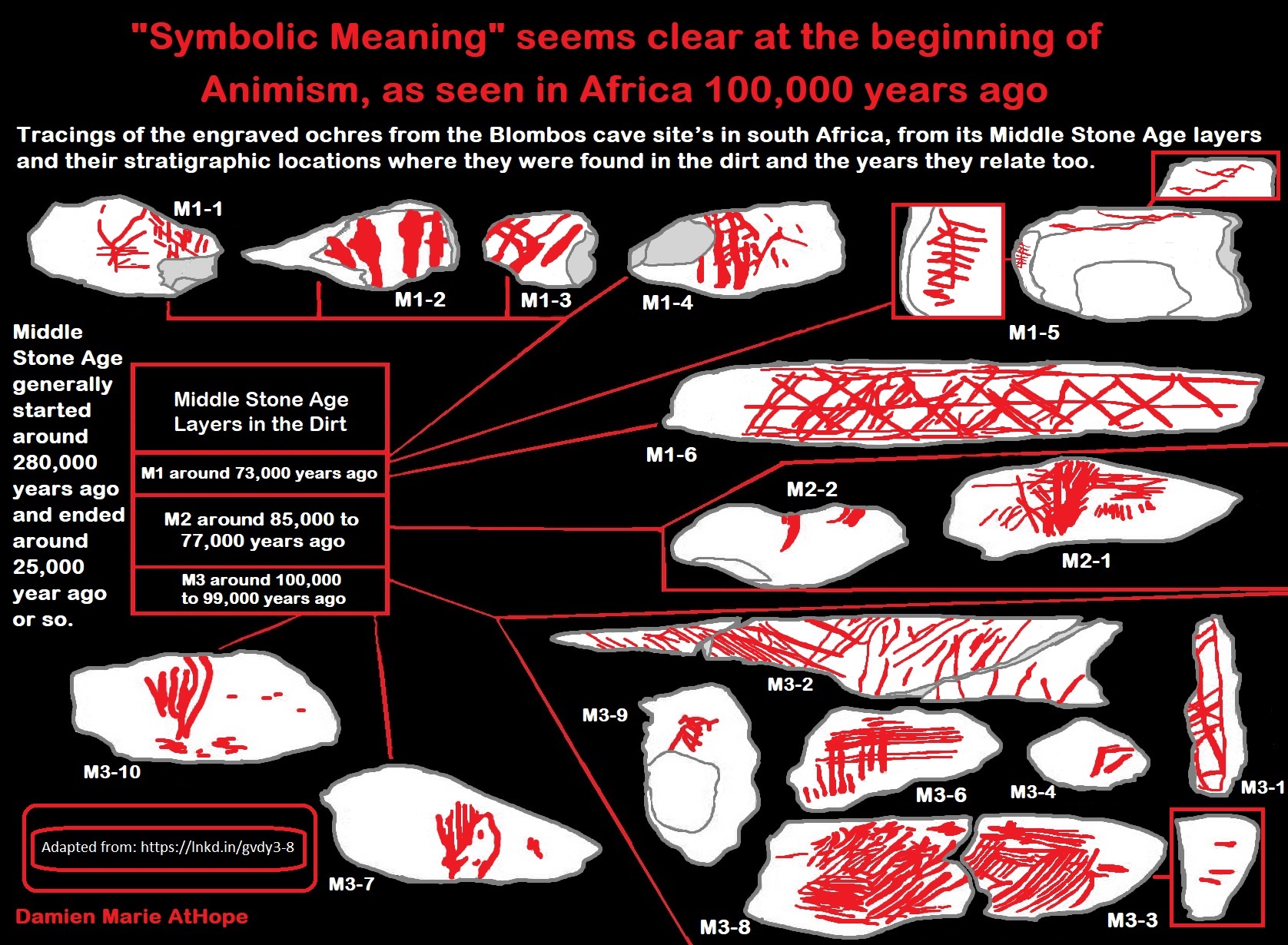
Adapted from: ref
Here we see the tracings of the engraved ochres from the Blombos cave site’s in South Africa, from its Middle Stone Age layers and their stratigraphic locations where they were found in the dirt and the years they relate to. M1 dates to around 73,000 years ago, M2 around 85,000 to 77,000 years ago, and M3 dates to around 100,000 to 99,000 years ago. Middle Stone Age generally started around 280,000 years ago and ended around 25,000 years ago or so. Therefore, amazing as it is, here we have proof that “Symbolic Meaning,” seems to be clear at the beginning of Animism, as seen in Africa 100,000 years ago. In a landmark study, it was demonstrated, for the first time, that there are seeming tradition in the production of geometric engraved representations, includes the production of a number of different patterns and this set of evolving traditions have roots that go back in time to at least 100,000 years ago (around a time I say Animism begins in Africa). The fact that they were created, that most of them are deliberate and were made with representational intent, strongly suggests they functioned as artifacts within a society by symbols with meaning. ref
77,000-year-old example of meaning consisting of Symbolic Etchings, lines and hashtag patterns onto a piece of red ochre found at Blombos Cave, South Africa. ref

“Mtoto’s burial, to experts it is believed the child was around three years old when they died and was likely wrapped in a shroud and had their head on a pillow. Besides the seemingly deliberate position of the body, the team noticed a few clues that suggested the child was swaddled in cloth, possibly with the intention of preserving the corpse. They also speculate the body was placed in a cave fissure — known as funerary caching — before being covered with sediment.” ref, ref
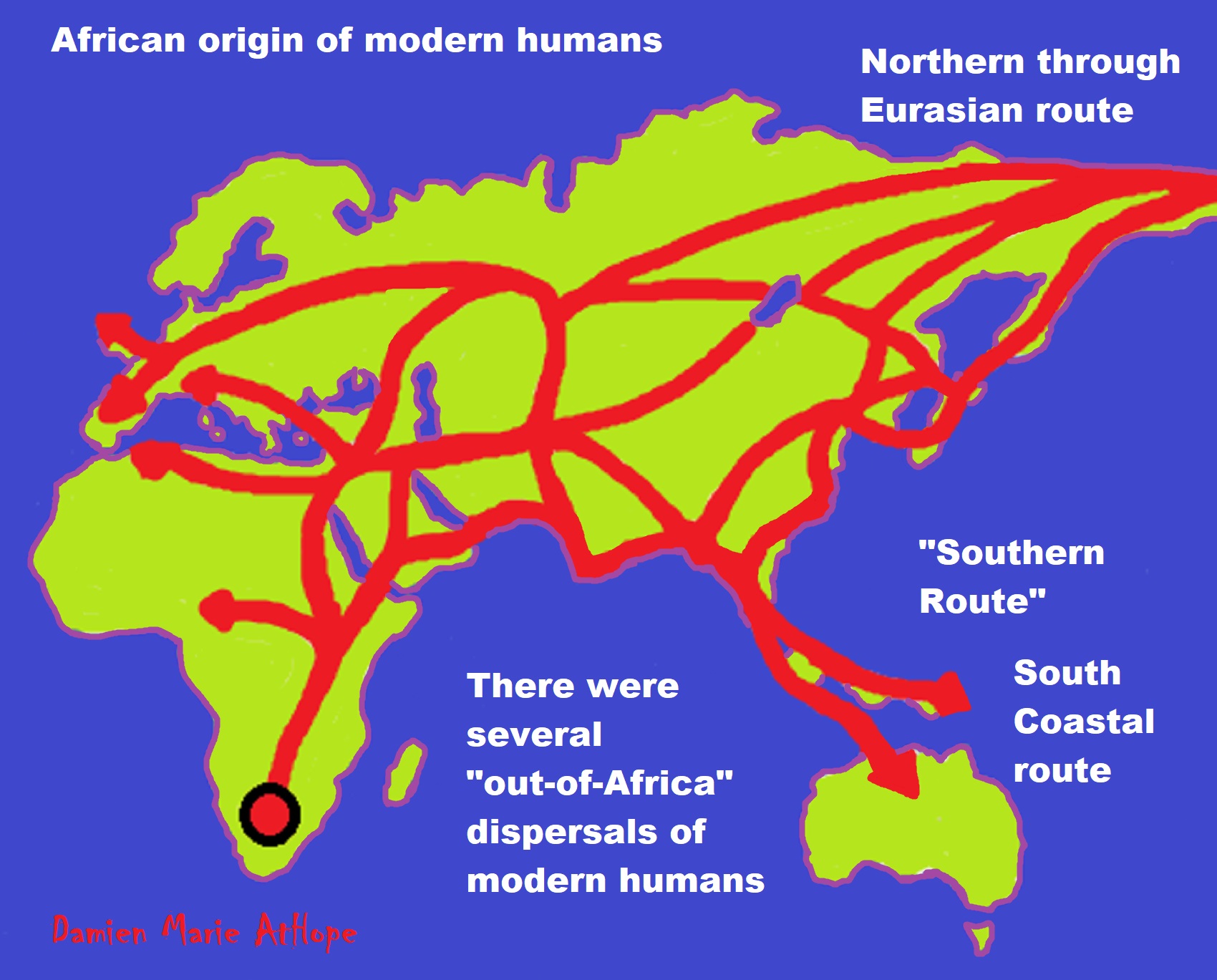
ref, ref, ref, ref, ref, ref, ref, ref
“There are two geographically plausible routes that have been proposed for humans to emerge from Africa: through the current Egypt and Sinai (Northern Route), or through Ethiopia, the Bab el Mandeb strait, and the Arabian Peninsula (Southern Route).” ref
“Although there is a general consensus on the African origin of early modern humans, there is disagreement about how and when they dispersed to Eurasia. This paper reviews genetic and Middle Stone Age/Middle Paleolithic archaeological literature from northeast Africa, Arabia, and the Levant to assess the timing and geographic backgrounds of Upper Pleistocene human colonization of Eurasia. At the center of the discussion lies the question of whether eastern Africa alone was the source of Upper Pleistocene human dispersals into Eurasia or were there other loci of human expansions outside of Africa? The reviewed literature hints at two modes of early modern human colonization of Eurasia in the Upper Pleistocene: (i) from multiple Homo sapiens source populations that had entered Arabia, South Asia, and the Levant prior to and soon after the onset of the Last Interglacial (MIS-5), (ii) from a rapid dispersal out of East Africa via the Southern Route (across the Red Sea basin), dating to ~74,000-60,000 years ago.” ref
“Within Africa, Homo sapiens dispersed around the time of its speciation, roughly 300,000 years ago. The so-called “recent dispersal” of modern humans took place about 70–50,000 years ago. It is this migration wave that led to the lasting spread of modern humans throughout the world. The coastal migration between roughly 70,000 and 50,000 years ago is associated with mitochondrial haplogroups M and N, both derivative of L3. Europe was populated by an early offshoot that settled the Near East and Europe less than 55,000 years ago. Modern humans spread across Europe about 40,000 years ago, possibly as early as 43,000 years ago, rapidly replacing the Neanderthal population.” ref, ref
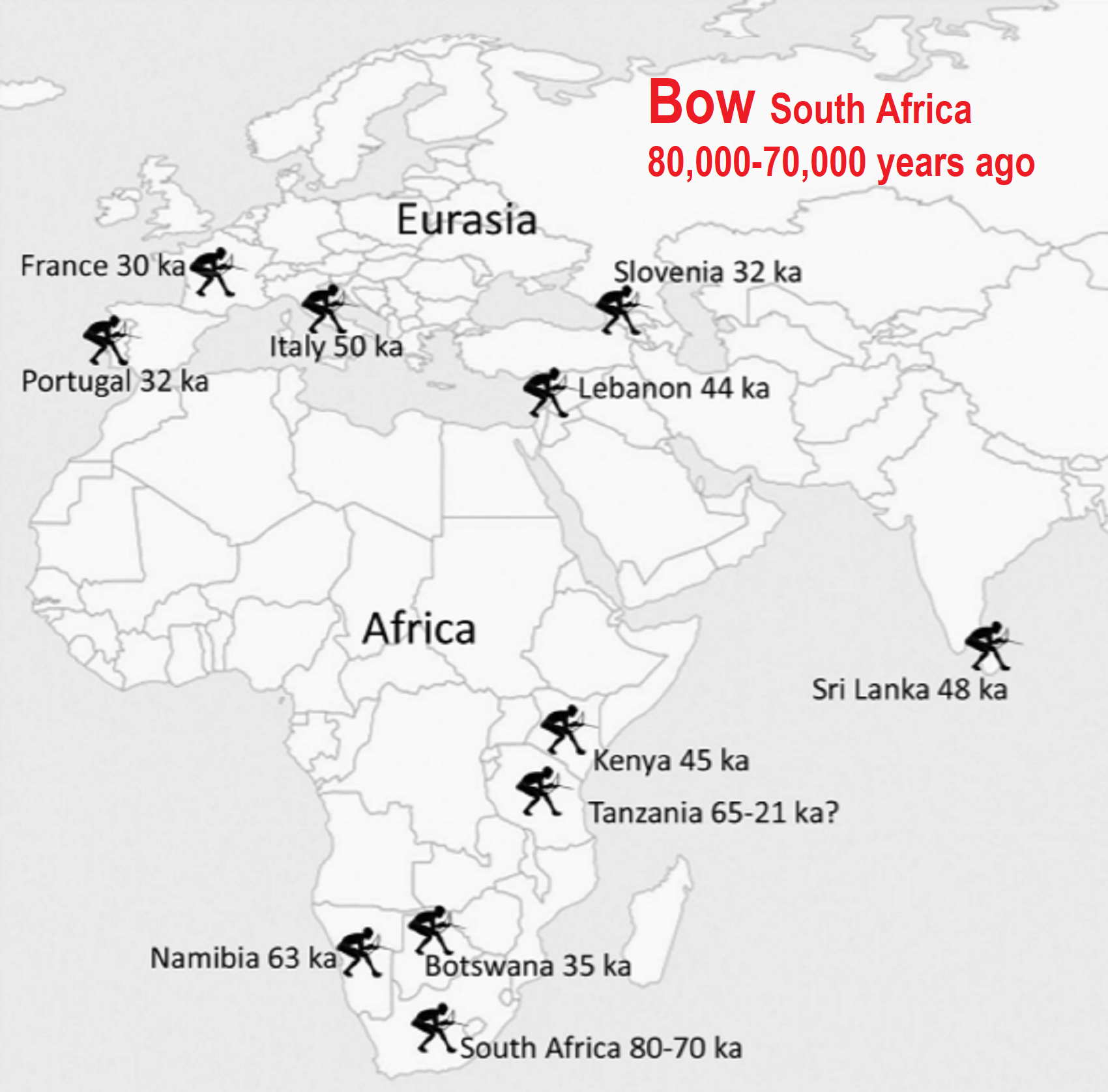
Did Pleistocene Africans use the spearthrower‐and‐dart?
“Well, evidence grows apace for ever-more ancient bow-and-arrow use. List of age estimates, locations, and current evidence bundles for the use of either arrows or darts by/before 30,000 years ago, the list may not be exhaustive, but we suggest that it broadly summarizes current knowledge (MSA = middle stone age).” ref
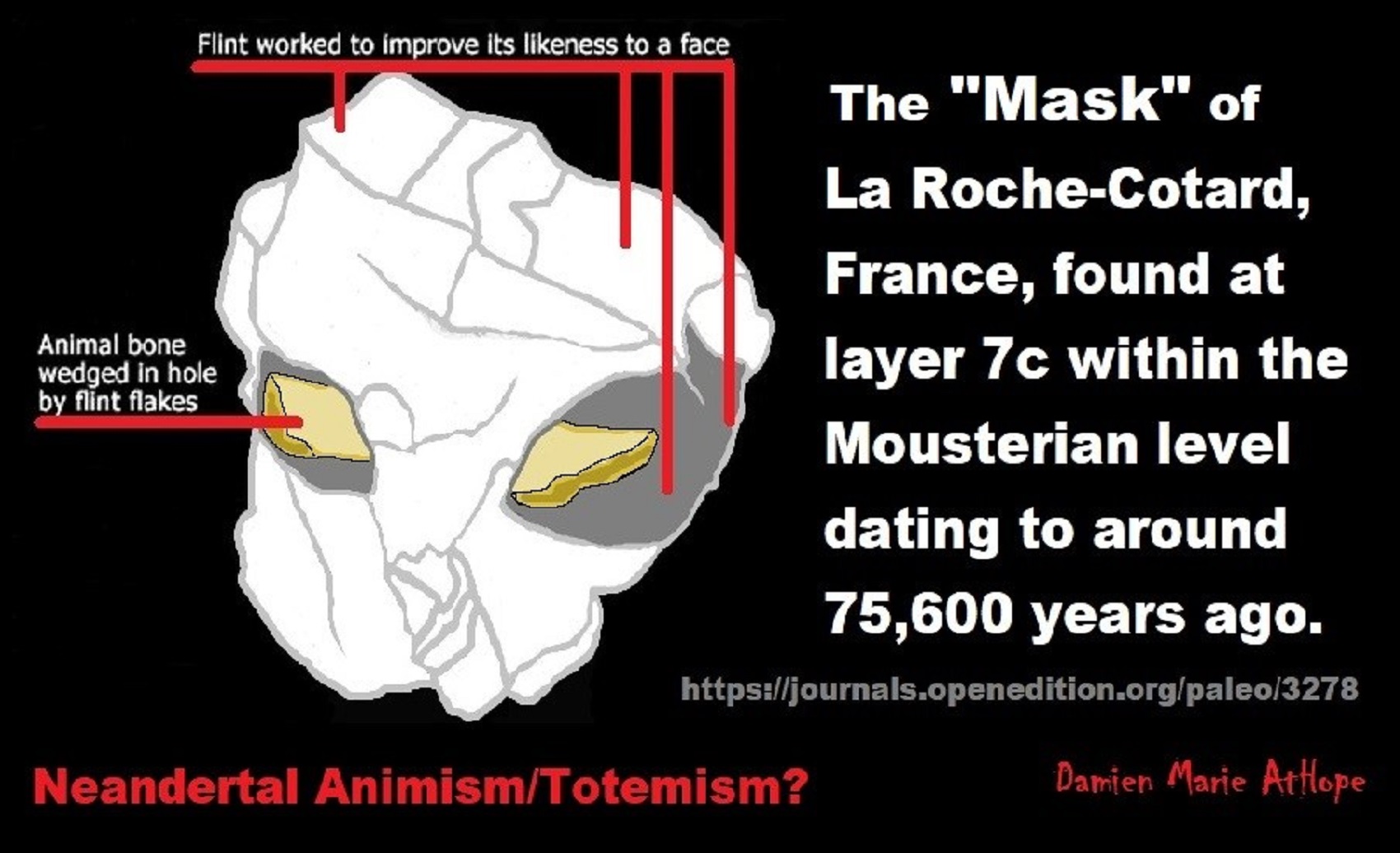

Stone Snake of South Africa: “first human worship” 70,000 years ago
Evidence from Rhino Cave, in Botswana produced results that revealed a very special set of behavioral patterns which best-fit ritualized behavior. There were colorful non-local stone tools carefully and often elaborately made just to be offered to the stone snake; burned and smashed beyond use then abandoned. ref
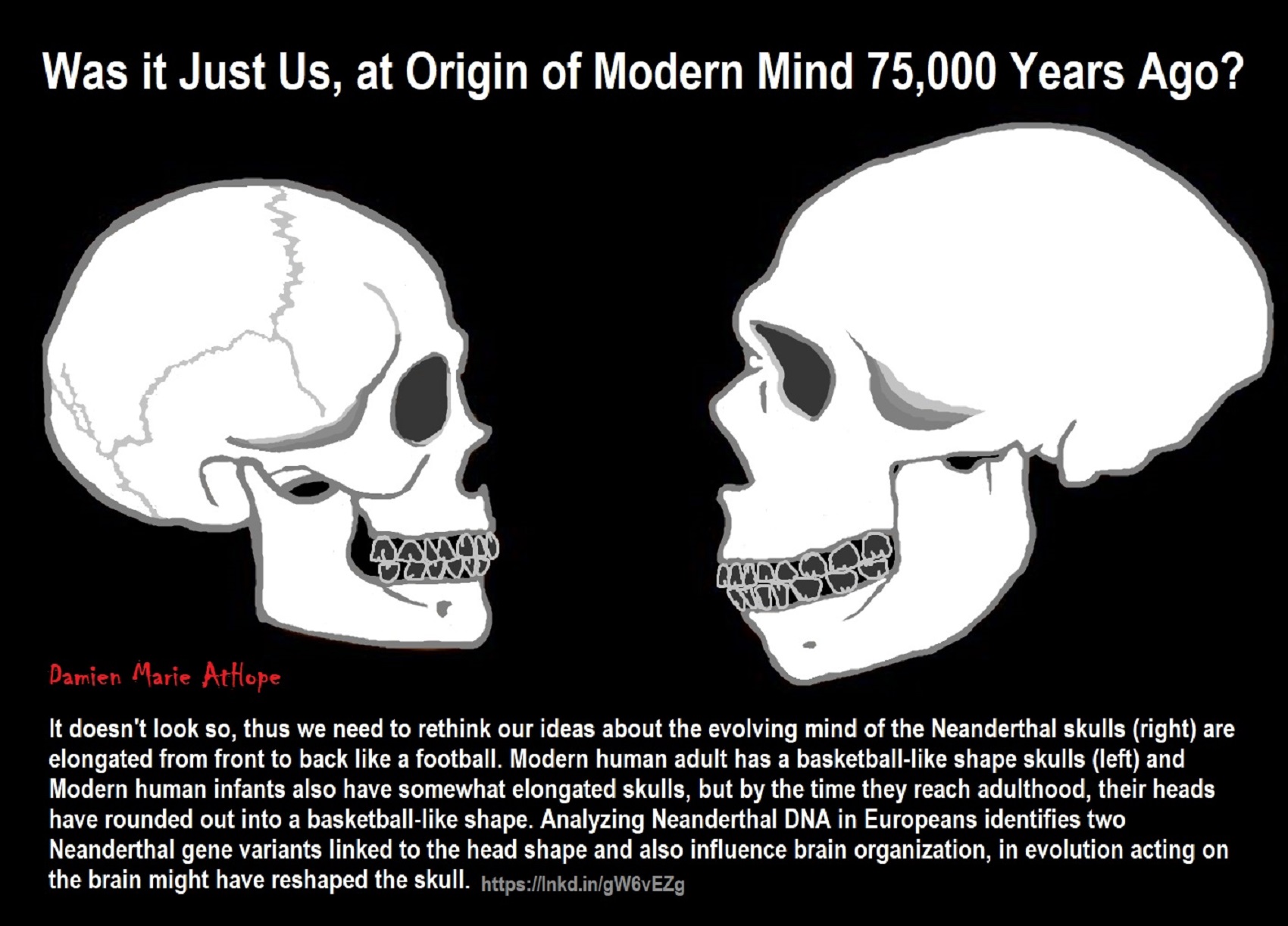
The so-called “transitional industries” are a key for understanding the replacement process of Neanderthals by modern humans in western Eurasia at the beginning of the Upper Paleolithic between 50,000 and 40,000 years ago. While in Europe the older Mousterian industry of the Middle Paleolithic can be clearly attributed to Neanderthals and the later Upper Paleolithic assemblages to modern humans, the nature of the makers of the transitional Châtelperronian (CP) industry has long been disputed. ref, ref, ref
Haplogroup O-M175 is a descendant haplogroup of Haplogroup NO-M214, and first appeared according to different theories either in Southeast Asia approximately 40,000 years ago (or between 31,294 and 51,202 years ago. This haplogroup appears in 80-90% of most populations in East Asia and Southeast Asia, and it is almost exclusive to that region: M175 is almost nonexistent in Western Siberia, Western Asia, Europe, most of Africa, and the Americas, where its presence may be the result of recent migrations. Certain subclades of Haplogroup O-M175 do achieve significant frequencies among some populations of South Asia, Central Asia, and Oceania. Significant presence of Haplogroup O-M50 have been found in Bantu-speaking populations of the Comoros along with a single instance of O-MSY2.2(xM50) while both O-M50 and O-M95(xM88) occur commonly among the Malagasy people of Madagascar. O-M175(xM119, M95, M176, M122) Y-DNA in 1/18 Iranians from Teheran, 2/37 Tajiks from Badakhshan Province of Afghanistan, and 1/97 Mongols from northwest Mongolia, while finding O-M176 only in 1/20 Mongols from northeast Mongolia. Ref
K2b probably is around 50,000 years old is the ancestor of Haplogroup K2 (K-M526), is found in southeast Asia around 30,000-40,000 years ago. Splitting into: K3(P79) , M(P256), NO(M214), P(M45) and S(M230). Y- DNA Haplogroup M (P256) is a descendant of Haplogroup K2b1, and it presumably first mutated between 32,000 and 47,000 years ago in south Asia. Most populations (50%-100%) in West Papua and western Papua New Guinea belong to haplogroup M (P256). Haplogroup M (P256) likely originated in Melanesia and then spread into Indonesia, Micronesia, and New Guinea. Haplogroup S-M230 is found primarily in populations in Papua New Guinea with lower frequencies in Melanesia and Indonesia. Possible time of origin is 28,000-41,000 years before present and possibly originated in New Guinea or Indonesia. K2b1, its subclades and P* are virtually restricted geographically to South East Asia and Oceania. Whereas, in a striking contrast, P1(P-M45) and its primary subclades Q and R now make up “the most frequent haplogroup in Europe, the Americas, and Central Asia and South Asia“. The estimated dates for the branching of K, K2, K2b and P point to a “rapid diversification” within K2 “that likely occurred in Southeast Asia”, with subsequent “westward expansions” of P*, P1, Q and R ref, ref
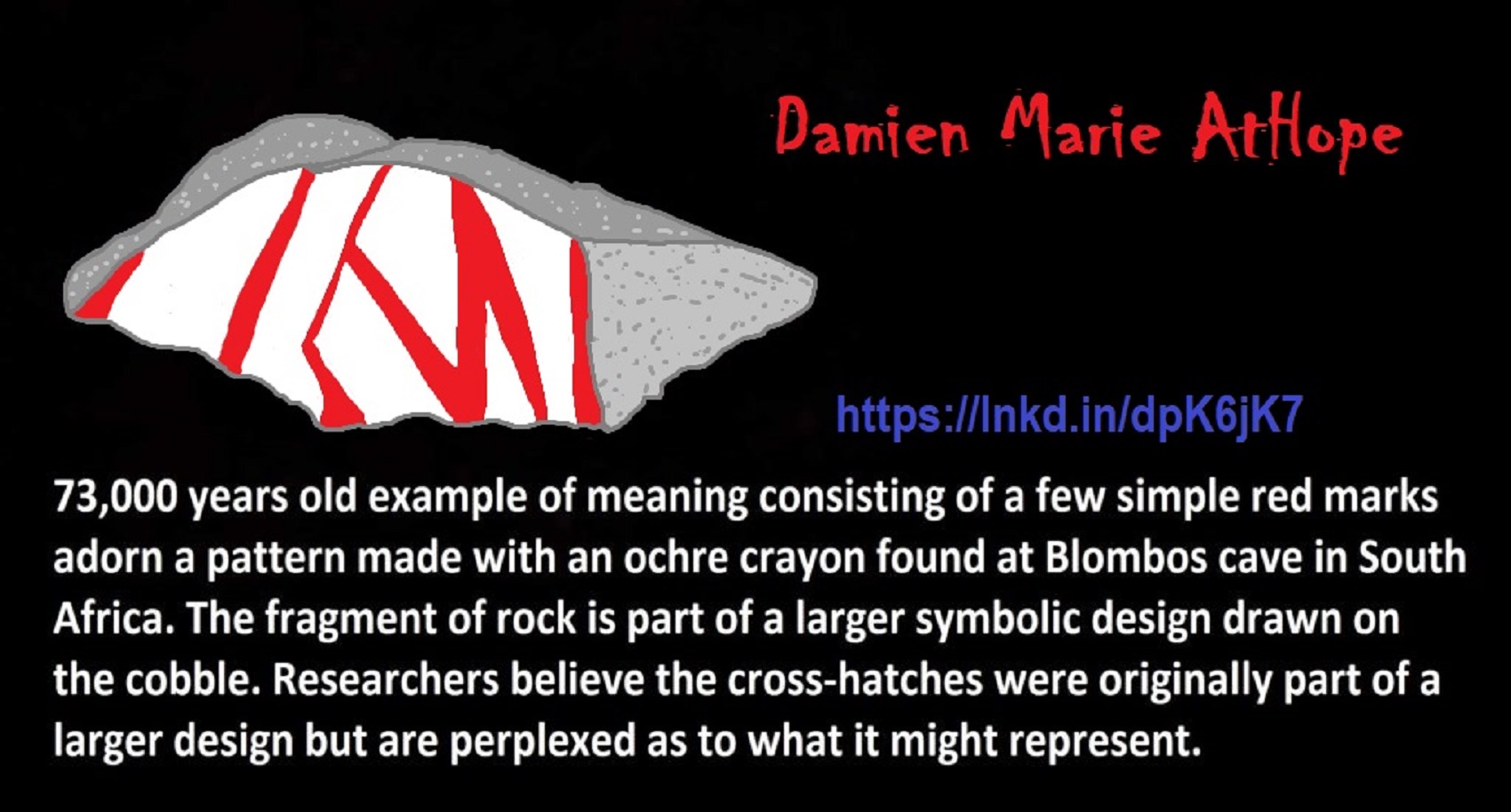
73,000 years old example of meaning consisting of a few simple red marks adorn a pattern made with an ochre crayon found at Blombos cave in South Africa. The fragment of rock is part of a larger symbolic design drawn on the cobble. Researchers believe the cross-hatches were originally part of a larger design but are perplexed as to what it might represent. ref
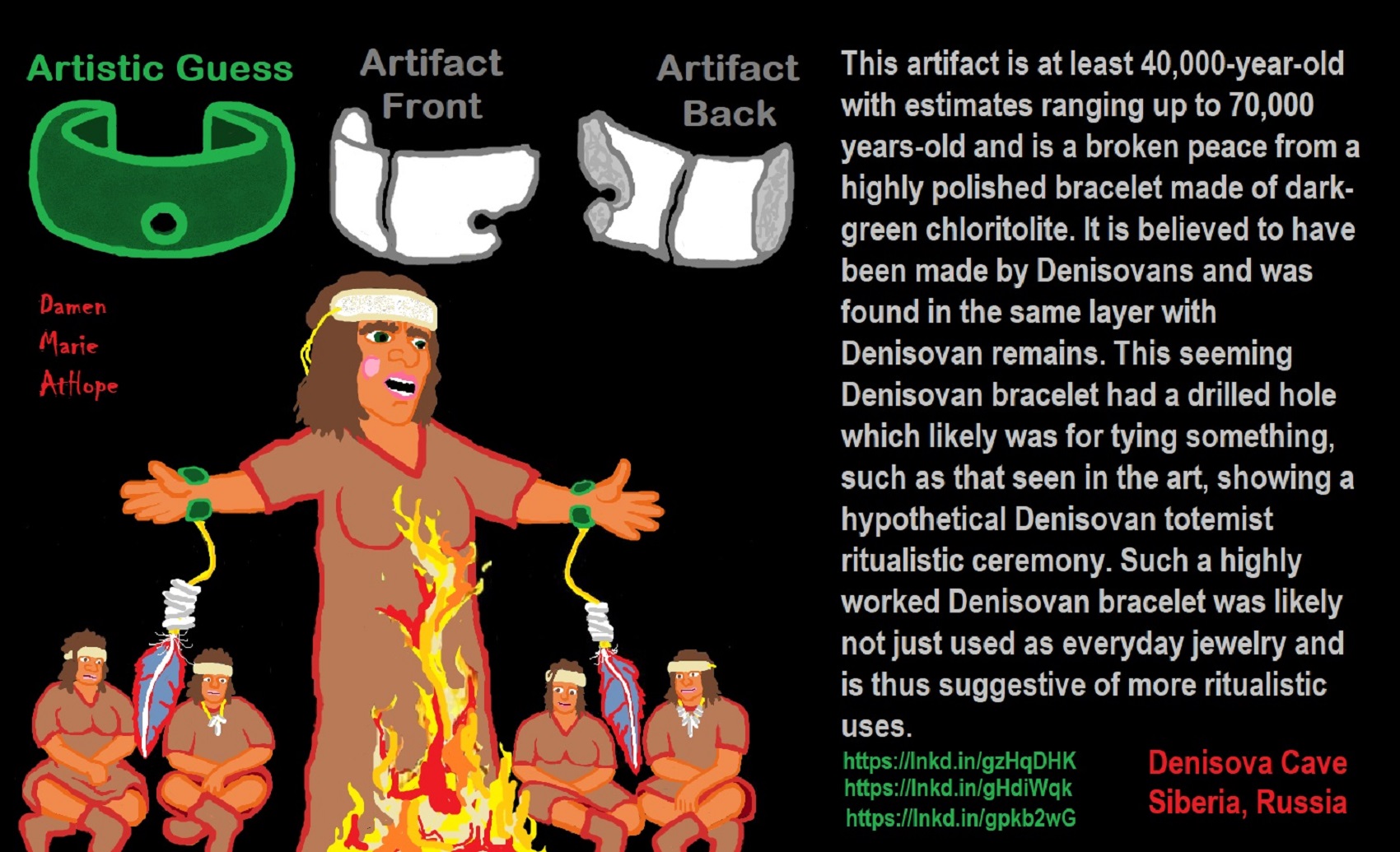
“This is the oldest stone bracelet in the world, believed to have been made by the extinct Denisovan species of early humans, dated as being between 40,000 – 50,000 to be 65,000 – 70,000 years old, long before ancient people were believed to capable of making such remarkable objects. The bracelet is thought to have adorned a very important woman or child on only special occasions. And it is unlikely it was used as an everyday jewelry piece. I believe this beautiful and very fragile bracelet was worn only for some exceptional moments.” ref

“Prehistoric cave paintings in Spain show Neanderthals were artists. Red ochre pigment discovered on stalagmites in the Caves of Ardales, near Malaga in southern Spain, were created by Neanderthals about 65,000 years ago, making them possibly the first artists on earth, according to the study published in the Proceedings of the National Academy of Sciences (PNAS) journal. Modern humans were not inhabiting Europe at the time the cave images were made.” ref
Scientists have found the first major evidence that Neanderthals made cave paintings, indicating they may have had an artistic sense similar to our own. A new study led by the University of Southampton and the Max Planck Institute for Evolutionary Anthropology shows that paintings in three caves in Spain were created more than 64,000 years ago – 20,000 years before modern humans arrived in Europe. This means that the Palaeolithic (Ice Age) cave art – including pictures of animals, dots, and geometric signs – must have been made by Neanderthals, a ‘sister’ species to Homo sapiens, and Europe’s sole human inhabitants at the time. It also indicates that they may have had a similar artistic sense, in terms of thinking symbolically, to modern humans.
Published in the journal Science, the study reveals how an international team of scientists used a state-of-the-art technique called uranium-thorium dating to fix the age of the paintings as more than 64,000 years. Until now, cave art has been attributed entirely to modern humans, as claims to a possible Neanderthal origin have been hampered by imprecise dating techniques. However, uranium-thorium dating provides much more reliable results than methods such as radiocarbon dating, which can give false age estimates. Results show that the paintings we dated are, by far, the oldest known cave art in the world, and were created at least 20,000 years before modern humans arrived in Europe from Africa so it is assumed – therefore they may have been painted by Neanderthals.
All three caves contain red (ochre) or black paintings of groups of animals, dots, and geometric signs, as well as hand stencils, handprints, and engravings. According to the researchers, creating the art must have involved such sophisticated behavior as the choice of a location, planning of light source and mixing of pigments. There is evidence that Neanderthals in Europe used body ornamentation around 40,000 to 45,000 years ago, but many researchers have suggested this was inspired by modern humans who at the time had just arrived in Europe. Study co-author Paul Pettitt, of Durham University, commented: “Neanderthals created meaningful symbols in meaningful places. The art is not a one-off accident. ref
Neanderthals are our closest extinct relative, but for a long time, they had a reputation for being pretty backward. Early modern humans, for example, made cave paintings. But even though Neanderthals used pigments and decorated themselves with eagle claws and shells, there was no clear proof that they painted caves. One theory goes that Neanderthals developed their rudimentary culture only after early modern humans arrived in Europe some 40,000 to 50,000 years ago. The most recent painting is at least 64,800 years old, according to this technique, and the oldest is more than 66,000 years old. ref
The Neanderthal was the only proven Human of Europe at the time, but was his or her brain up to the job? Or did modern humans reach Europe tens of thousands of years earlier than thought? The ancient art forms are symbolic but not figurative, explain their finders. In Spain, a cave in Maltravieso features hand stencils more than 66,000 years old, Prof. Dirk Hoffmann of the Max Planck Institute for Evolutionary Anthropology and others report in their paper, published in Science. The La Pasiega Cave in Cantabria features a ladder form composed of red horizontal and vertical lines that were created more than 64,000 years ago, they say. Further supporting the Neanderthal-as-artist theory, a related paper published Thursday in Science Advances reports that dyed and decorated seashells found in a Spanish cave dated to more than 115,000 years ago.
Perforated shells found in sediments in Cueva de los Aviones that date to between 115,000 and 120,000 years. There’s no argument that there were Neanderthals in Europe 64,000 years ago. Homo sapiens, on the other hand, was thought to have reached Europe only 45,000 to 40,000 years ago. There is no evidence for modern humans in Iberia before 41,000 years ago, and there is evidence for Neanderthal presence until about 36,000 years ago in southern Spain and Portugal. Neanderthals existed for twice the time modern people have, if not more, and were once the dominant hominin in Europe. While Neanderthals may have etched a crisscross and perhaps carved a flute, look what Homo sapiens achieved, Coolidge says. The Paleolithic record is replete with exquisite works, from cave paintings to carvings done tens of thousands of years ago – such as the Lion Man sculpture found in a German cave and made of mammoth ivory some 38,000 years ago. ref
Neanderthal ritual or religious practice at around 50,000 years old burial in Sima de las Palomas in Murcia, Southeast Spain of a female covered with rocks inturned with a cut off panther paw, suggesting that Neanderthals—much like today’s bear hunters—ceremoniously cut off panther paws and kept them as totemistic trophies. This 50,000-year-old Neanderthal burial ground actually includes the remains of at least three individuals intentionally buried, with each Neanderthal’s arms folded such that the hands were close to the head. Remains of other Neanderthals have been found in this position, suggesting that it held meaning. The remains of six to seven other Neanderthals, including one baby and two juveniles, have also been excavated at the site. The tallest individual appears to have been an adult who stood around 5 feet 1 inch tall. ref, ref

60,000 years old fragments of engraved ostrich eggshells from the Diepkloof Rock Shelter, Western Cape, South Africa.
Symbolic meaning expressed in art or designs and patterns, starting with animism at 100,000 years ago and more so around 50,000 years ago with the emergence of totemism and shamanism 30,000 years ago which I think all connect in a general way to religious thinking or mindsets that create the art or patterns and are not only a much older phenomenon than previously thought and has its roots in the African continent. Such early symbolic expression is seen in things like personal ornamentation and engraved designs, traditions that go far back into African prehistory. The patterns are symbolic and could have been used to express religious clan connections, group relations or personal expression. The patterns may indeed have a meaning and while abstract in representation they are unequivocal evidence for symbolic thought and one step closer to language. The first examples of what we might term ‘art’ in Africa, dating from between 100,000–60,000 years ago, emerge in two very distinct forms: personal adornment in the form of perforated seashells suspended on twine and incised and engraved stone, ochre, and ostrich eggshell. Despite some sites being around 5,000 miles and 40,000 years apart, an intriguing feature of the earliest art is that these first forays appear remarkably similar. ref
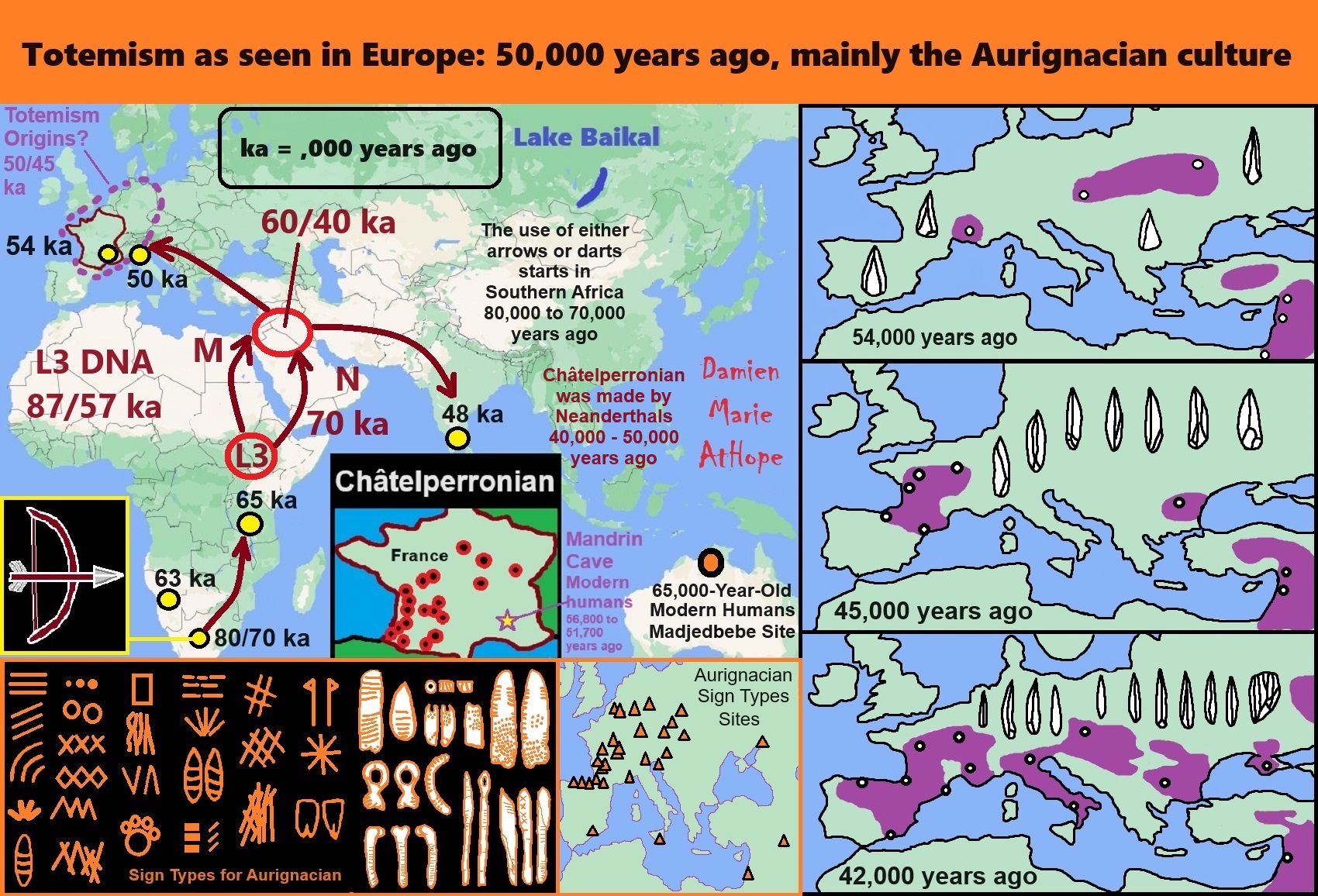
ref, ref, ref, ref, ref, ref, ref, ref, ref, ref, ref, ref, ref, ref, ref, ref, ref, ref, ref, ref, ref, ref, ref
This is my thoughts/speculations on the origins of Totemism
Totemism as seen in Europe: 50,000 years ago, mainly the Aurignacian culture
- Pre-Aurignacian “Châtelperronian” (Western Europe, mainly Spain and France, possible transitional/cultural diffusion between Neanderthals and humans around 50,000-40,000 years ago)
- Archaic–Aurignacian/Proto-Aurignacian (Europe around 46,000-35,000)
- Aurignacian “classical/early to late” (Europe and other areas around 38,000 – 26,000 years ago)
“In the realm of culture, the archeological evidence also supports a Neandertal contribution to Europe’s earliest modern human societies, which feature personal ornaments completely unknown before immigration and are characteristic of such Neandertal-associated archeological entities as the Chatelperronian and the Uluzzian.” – (PDF) Neandertals and Moderns Mixed, and It Matters: Link
Totemism as seen in Europe: 50,000 years ago, mainly the Aurignacian culture

Denisovan Totemism 50,000 years ago?
Suspicion is that this male tiara or diadem (mammoth ivory) was made by Denisovans and hints at the depth of Denisovan technology 50,000 to 45,000 years ago. Expression for family, clan or tribe, So maybe early Totemistic behaviors. ref
Denisovan technology is at least by 50,000 years ago, such as their making elegant needles out of ivory and a sophisticated and beautiful stone bracelet. It appears to have had a practical use: to keep hair out of the eyes; its size indicates it was for male, not female, use. Interestingly tiaras were made 20,000 to 28,000 years later by people living in the Russian Far East, around the Yana River in Yakutia and they could have denoted the family, clan, or tribe, So maybe early Totemistic behaviors. ref
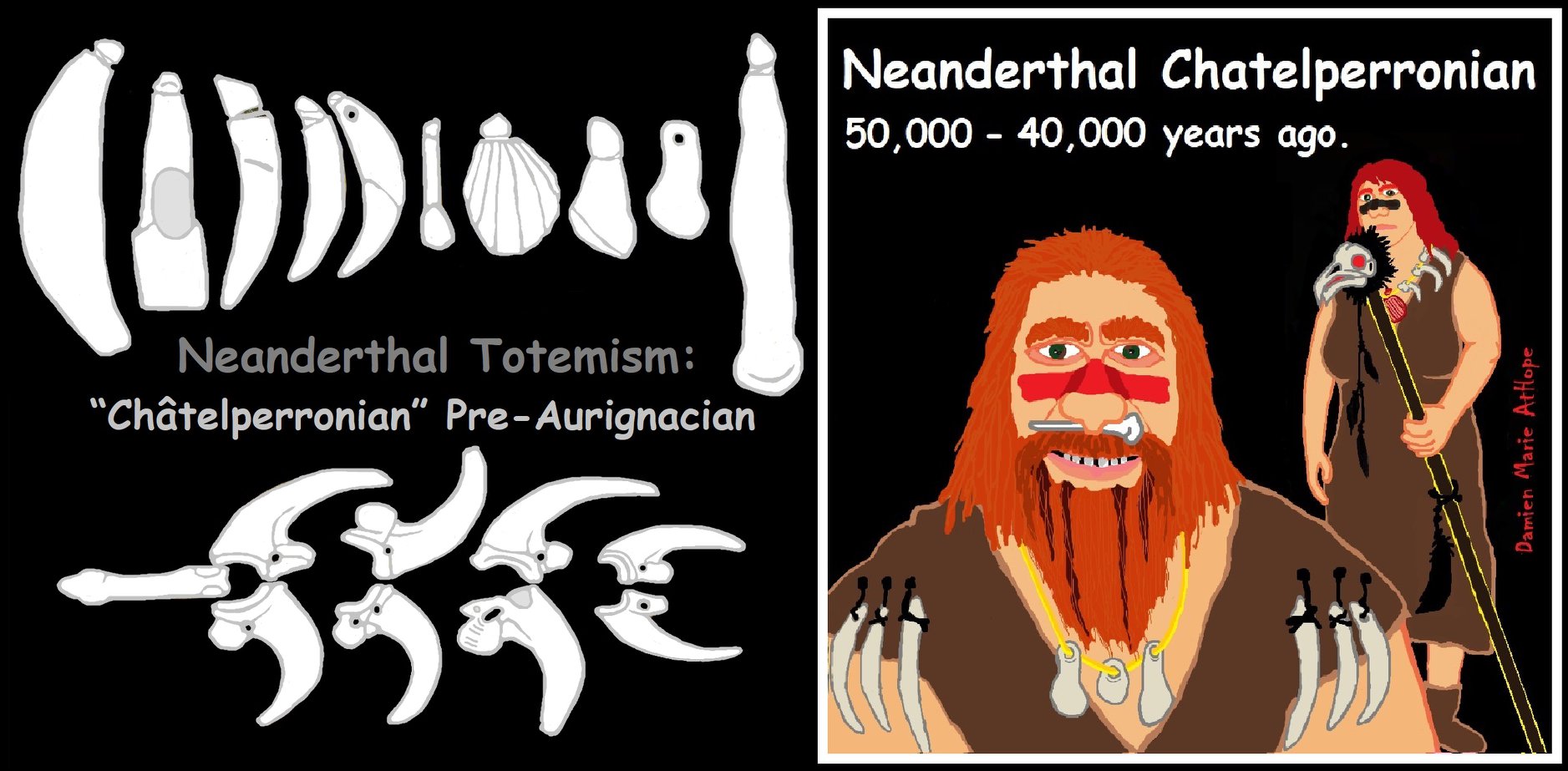
The so-called “transitional industries” are a key for understanding the replacement process of Neanderthals by modern humans in western Eurasia at the beginning of the Upper Paleolithic between 50,000 and 40,000 years ago. While in Europe the older Mousterian industry of the Middle Paleolithic can be clearly attributed to Neanderthals and the later Upper Paleolithic assemblages to modern humans, the nature of the makers of the transitional Châtelperronian (CP) industry has long been disputed. ref, ref, ref
Haplogroup O-M175 is a descendant haplogroup of Haplogroup NO-M214, and first appeared according to different theories either in Southeast Asia approximately 40,000 years ago (or between 31,294 and 51,202 years ago. This haplogroup appears in 80-90% of most populations in East Asia and Southeast Asia, and it is almost exclusive to that region: M175 is almost nonexistent in Western Siberia, Western Asia, Europe, most of Africa, and the Americas, where its presence may be the result of recent migrations. Certain subclades of Haplogroup O-M175 do achieve significant frequencies among some populations of South Asia, Central Asia, and Oceania. Significant presence of Haplogroup O-M50 have been found in Bantu-speaking populations of the Comoros along with a single instance of O-MSY2.2(xM50) while both O-M50 and O-M95(xM88) occur commonly among the Malagasy people of Madagascar. O-M175(xM119, M95, M176, M122) Y-DNA in 1/18 Iranians from Teheran, 2/37 Tajiks from Badakhshan Province of Afghanistan, and 1/97 Mongols from northwest Mongolia, while finding O-M176 only in 1/20 Mongols from northeast Mongolia. Ref
K2b probably is around 50,000 years old is the ancestor of Haplogroup K2 (K-M526), is found in southeast Asia around 30,000-40,000 years ago. Splitting into: K3(P79) , M(P256), NO(M214), P(M45) and S(M230). Y- DNA Haplogroup M (P256) is a descendant of Haplogroup K2b1, and it presumably first mutated between 32,000 and 47,000 years ago in south Asia. Most populations (50%-100%) in West Papua and western Papua New Guinea belong to haplogroup M (P256). Haplogroup M (P256) likely originated in Melanesia and then spread into Indonesia, Micronesia, and New Guinea. Haplogroup S-M230 is found primarily in populations in Papua New Guinea with lower frequencies in Melanesia and Indonesia. Possible time of origin is 28,000-41,000 years before present and possibly originated in New Guinea or Indonesia. K2b1, its subclades and P* are virtually restricted geographically to South East Asia and Oceania. Whereas, in a striking contrast, P1(P-M45) and its primary subclades Q and R now make up “the most frequent haplogroup in Europe, the Americas, and Central Asia and South Asia“. The estimated dates for the branching of K, K2, K2b and P point to a “rapid diversification” within K2 “that likely occurred in Southeast Asia”, with subsequent “westward expansions” of P*, P1, Q and R ref, ref

Mitochondrial haplogroups A, B, and G originated about 50,000 years ago, and bearers subsequently colonized Siberia, Korea, and Japan, by about 35,000 years ago. Several phenotypical traits associated with Mongoloids with a single mutation of the EDAR gene, dated to c. 35,000 years ago. A Paleolithic site on the Yana River, Siberia, at 71°N, lies well above the Arctic Circle and dates to 27,000 radiocarbon years before present, during glacial times. This site shows that people adapted to this harsh, high-altitude, Late Pleistocene environment much earlier than previously thought. ref
40,000 to 50,000 years ago, the Emergence of Norm Violations
In the video “Robert Sapolsky: The Biology of Humans at Our Best and Worst” (17 or so minutes in) states the emergence of norm violations of moral disgust occurred around 40,000 to 50,000 years ago which is about the time that genetics shows after 40,000 years ago there was an extreme lowering of insect behaviors coinciding with the emergence of more complex cave art, figurines, and personal adornments all confirming my thoughts on totemism emerging after 50,000 years ago in Europe by the Early Aurignacian or Proto-Aurignacian stage. And in the video “DNA Mammoths, Neanderthals, and Your Ancestors,” it also quickly includes the evidence for early people following incest taboos, are clearly evident after 40,000 years ago by genetics. Which, to me, likely connects to the motivations adopted by societies believing in Totemism. ref, ref
The first insights of the genetics of early Eurasian modern humans were recently provided by four ancient human genomes: Ust’-Ishim (Western Siberia, 45,000 years ago), Kostenki (Russia, 39,000–36,000 years ago), Fumane 2 (Italy, 41,000–39,000 years ago) and Peştera cu Oase (Romania, 37,000–42,000 years ago). Population genetic analyses of modern-day human mitochondrial haplogroup distributions suggest that in conjunction with the Eurasian expansion, some populations initiated a back-migration to North Africa. Although the first genome of an ancient African individual (Ethiopia, 4,000-5,000 years ago) identified a back-migration from Eurasia to Africa within the at last 4.500 years, the scarcity of older human remains in North Africa has prevented researchers from obtaining direct evidence of such a migratory phenomenon during the Paleolithic period. We present the mitochondrial genome (mitogenome) of the Peştera Muierii 1 (PM1) remains from Romania, directly dated to 35,000 years ago, which sheds new light on the Early Upper Paleolithic (EUP) migrations in Eurasia and North Africa. ref
Ust’-Ishim man 45,000-year-old remains of a male hunter-gatherer, (I presume a totemist or connected to the firsts totemic peoples by around 50,000 years ago
then by 30,000 years ago are shamanistic-totemists) one of the early modern humans to inhabit western Siberia.
Ust’-Ishim man has been classified as belonging to Y-DNA haplogroup K2a*, belonged to mitochondrial DNA haplogroup R*. Before 2016 they had been classified as U*. Both of these haplogroups and descendant subclades are now found among populations throughout Eurasia, Oceania and The Americas. When compared to other ancient remains, Ust’-Ishim man is more closely related, in terms of autosomal DNA to Tianyuan man, found near Beijing and dating from 42,000 to 39,000 years ago; Mal’ta boy (or MA-1), a child who lived 24,000 years ago along the Bolshaya Belaya River near today’s Irkutsk in Siberia, or; La Braña man – a hunter-gatherer who lived in La Braña (modern Spain) about 8,000 years ago. ref
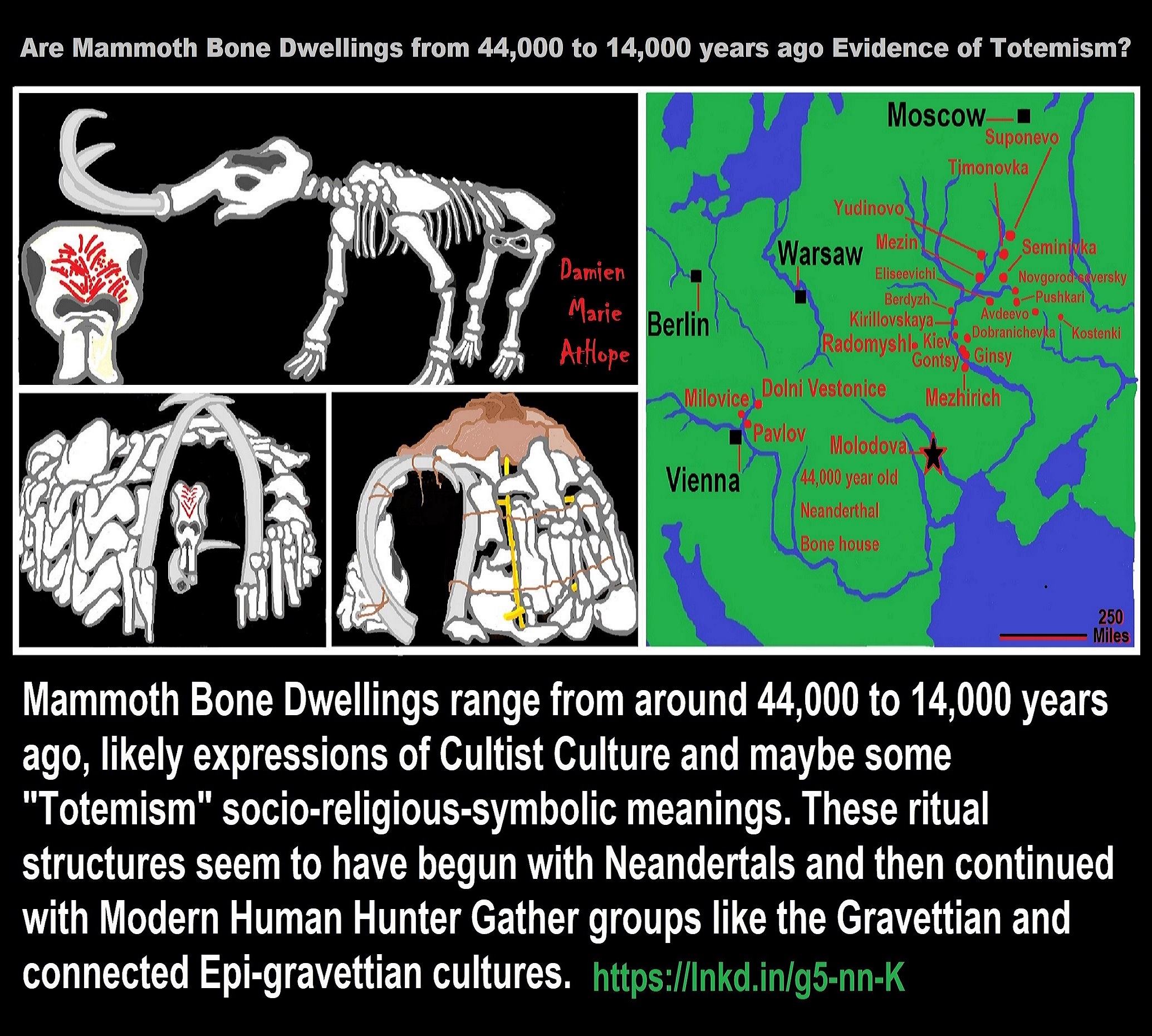
Mammoth bone dwellings are a very an early type of housing constructed by Upper Paleolithic hunter-gatherers mainly in central Europe. ref
Mammoth Bone Dwellings range from around 44,000 to 14,000 years ago, likely expressions of Cultist Culture and maybe some “Totemism” socio-religious-symbolic meanings. These ritual structures seem to have begun with Neandertals and then continued with Modern Human Hunter Gather groups like the Gravettian and connected Epi-gravettian cultures. ref
Gravettian and Epigravettian mammoth bone dwellings range from: Pavlovian (Early Gravettian of Moravia), Gagarino and Pouchkari (Gravettian of Eastern Europe), Kostienki 11/1a (Zamiatnine culture), and Mezinian. ref
The 44,000-year-old site from Molodova in eastern Ukraine was a Neanderthal “Mousterian Culture” Mammoth Bone Dwelling with possible “Totemism” connections due to how some of the bones used to build the ritual structure home had decorative carvings and added pigments. It was an incredible 26 foot wide circular building believed to be earliest bone built cultural structure and where they lived for extended periods of time. ref ref
The 44,000-year-old Neanderthal bone structure near Molodova was constructed with 116 large deliberately selected mammoth bones including skulls, jaws, tusks and leg. Inside there was at least 25 fire pits and from the artifacts found Neanderthals made many decorated carvings in addition to the symbolic adding of ochre pigments to the bones. ref ref
The painting in red on the front of mammoth skull may represent the flames and sparks of a fire and as bones where found burned in fire pits so there could be a ritualistic representation connection, which I think it is. It could be a prehistoric “drum” consisted of a mammoth skull, which may relate to a change from totemism to shamanism and was set at the entrance as well as contained a painted pattern of red ocher dots and lines. The top of this skull bears depressions where it seems to have been beaten by “drumsticks,” the animal long bones that were found to bear corresponding damage on their ends. It is possible that the building may have served some ritual or communal function at which the mammoth bone rhythms were beaten out, although many Ukrainian huts of a similar size seem to have been ordinary living places. ref ref ref
Even more telling to its ritualistic relevance is that is was found at the entrance to one of the mammoth hunter’s huts, which could also hold a vaginal/womb reference and as there was also an oddly placed signal tusk pointing in and hugging the head sticking upright out of the ground almost as if it represents a phallus entering the vaginal/womb thus fertility hunting cult suggestions as well as maybe fire worship. ref ref
Inside the Mezherich building, there were some remarkable finds: amber ornaments and fossil shells, transported an estimated 218 to 310 miles from their source, and the remains of one of the earliest percussion instruments ever found. The middle Dnepr basin is the origin of amber is well known near Kiev where it was collected throughout the Upper Palaeolithic. Amber objects have been used as pieces of small adornment inthe Upper Palaeolithic sites of the Dnepr basin: Gontsy, Dobra-nichivka, Mejiriche, Semenivka 2, Ioudinovo, Chulatovo 2, Mezine,Osokorivka (level 2), and Kaistrova balka 2 ref ref
A spectacular prehistoric art is visible in the dwellings of the Mezinian, in the grouping in the outer wall of jaws and long bones showing a geometric pattern of lines, chevrons and zigzags, which are also figured in the painted bones of the dwellings and in the mobile art of the statuettes, tools and various artifacts, confirming they are the manifestation of a socio-symbolic system of the Mezinian culture. ref
A mammoth bone dwelling hold a common form of a circular or oval structure with walls made of stacked large mammoth bones often modified to allow them to be lashed together or implanted into the soil. Within the interior is typically found a central fire pits or several scattered fire pits. External fire pits, butchering areas, and flint workshops are often found in association with the hut: scholars call these combinations Mammoth Bone Settlements (MBS). ref
The mammoth bone dwellings are not random. And they seem to express a pattern, thus this may demonstrate cultural/religious transfer inclinations and consistency in tradition over thousands of years. Similarly they are composed of several hundred bones and tusks arranged in a rough circles with a diameter of 20 to 33 feet. Even more interesting is that the first Neanderthal mammoth bone dwelling at 44,000-year-old was also in the range at 26 feet, thus it too is consistent with all the rest seeming to hit that they share some deep possible connection. ref
Such bone houses have been found in considerable numbers, often clustered together in little “villages” of four or five houses in the fertile valleys of the Ukraine and the same method of construction has appeared as far west as Kracow, in Poland, with three rings of mammoth bones exactly similar to those in Russia and dating to about 20 000 years ago. ref
Relatively all of the mammoth bone dwelling sites date to the Upper Paleolithic period (Gravettian or Epi-Gravettian), with the sole exception of Molodova 1, which dates to the Middle Stone Age and is associated with Neanderthals. ref
Most huts in central Europe date between 20,000 to 14,000 years ago:
Ukraine: Molodova 5, Molodova I, Mezhirich, Kiev-Kirillovskii, Dobranichevka, Mezin, Ginsy, Novgorod-seversky, Gontsy, Pushkari, Radomyshl’
Czech Republic: Predmosti, Dolni Vestonice, Vedrovice 5, Milovice G
Poland: Dzierzyslaw, Krakow-Spadzista Street B
Romania: Ripiceni-Izvor
Russia: Kostenki I, Avdeevo, Timonovka, Elisseevich, Suponevo, Yudinovo
Belarus: Berdyzh ref
Some archaeologists, have argued that they possess religious or ritual social significance and have been described as the earliest examples of ‘monumental architecture’ as well as evidence of increased social complexity and status differentiation. ref
Ritual Adornments
Mobile art adornment in the Upper Palaeolithic ( between 50,000-10,000 years ago) in the form of ivory sculptures, preferably female representations, was present in the settlements of Dobranichivka, Mejiriche, Mezine, and Elisseevichi 1. Several types of ivory adornments are present in Gontsy, Mezine, Mejiriche, Elisseevichi1, Ioudinovo, and Suponevo. The clear preference for the use of ivory in the manufacture of different types of ornament (pearl, pendant as well as a bracelet) and figurative statuettes, as also utilitarian or non-utilitarian objects, occurs in many residential settlements. ref
A Complicated Lunar Mythology was Indeed Developed in Paleolithic Times
Artifact finds dating to Upper and Middle Paleolithic times (around 100,000 to 14,000 years ago). Among the finds unearthed at Gontsy and Kiev-Kirillovskaya were mammoth tusk fragments which feature engraved patterns that have been interpreted as tables of lunar phase observations. More remarkable are two mammoth ivory bracelets from the site of Mezin which contain elaborate engraved ornamentation that also has been connected with a lunar calendar. Not to mention astronomical finds at Paleolithic sites on the Crimean peninsula, including the famous solar petroglyph at Chokcurcha-1 and a possible star map‘ engraved on a mammoth shoulder bone that was found at Chokurcha-2. ref
Ivory beads and pendants are known in Gontsy, Mezine, Mejiriche, Ioudinovo, Elisseevichi 1, and Suponevo, but one site, Ioudinovo, has ivory beads in large quantities. The tiny beads with a hole in the center have varied shapes: square, rectangular, oval, and circular. Their dimensions vary. ref
Modern Culture 44,000 years ago?
A study was conducted by an international team of experts, including researchers from South Africa, France, Italy, Norway, the USA, and Britain with their findings published in the Proceedings of the National Academy of Sciences.
The archaeological materials uncovered by the anthropologists portray a remarkably complex culture — and one that emerged far earlier than anyone could have imagined. This was around the same time that humans were making their way into Europe, but experts believe there were significant differences between the two groups. Anthropologists refer to this era (which we now know began as early as 44,000 years ago) as the Later Stone Age, comparable to the Upper Paleolithic. Specific artifacts left behind by these San hunter-gatherer peoples include ostrich eggshell beads, thin bone arrowhead points, wooden digging sticks, a gummy material called pitch that was used to affix bone and stone blades to shafts. There were also worked tusks from a boar-like creature that were used to plane wood, and notched bones that were likely used for counting. And then there was the remarkable discovery of poison — what would have been (literally) the killer app of hunting technology back then. Chemical analysis indicated that poison was being applied to bone points, a substance that was likely derived from the seeds of castor oil plants (ricinoleic acid). The poison-tipped bone points would have been thrust through the thick hide of a medium or large-sized herbivore — but because this weapon lacked ‘knock-down’ power, it would have been part of a larger, highly skilled attack. Archeologists also found wooden digging sticks, which were found near bored and broken stones, likely to weigh the sticks down. These devices were probably used by the San culture to dig up bulbs and termite larvae — a practice that continued for tens of thousands of years. As for the beeswax, which was also dated to 40,000 years ago, it is the oldest specimen known to be used by humans. It was likely used as a kind of adhesive (what’s called hafting), while other specimens wrapped in plant fibers indicate that it was used to make the strings for hunting bows. The Upper Paleolithic era was characterized by the emergence of complex and new technologies that helped humans survive in both Africa and Europe. These tools included spear-throwers, bone needles with eyelets for sewing furs, bone fishing hooks, bone flutes, and ivory figurines carved from mammoth tusks. And astonishingly, this study suggests that Upper Paleolithic culture may have roots even earlier than 44,000 years ago — possibly as early as 50,000 to 60,000 years ago. If this is correct, and if new archaeological evidence reaffirms these suspicions, it is quite possible that the first humans to venture into Europe were actually influenced by this phase of African culture. ref, ref, ref, ref
The Distribution Cave-art primary Palaeolithic locations in Eurasia.
Palaeolithic people also produced amazing open rock art at Six sites, found in Spain, Portugal, and the French Pyrenees, with engravings that are Palaeolithic in style not typical of the period. Cave art most abundant areas that are also rich in decorated objects: the Périgord, the French Pyrenees, and Cantabrian Spain. Paleolithic decorated caves are found from Portugal and the very south of Spain to the north of France with less found in southwest Germany, Italy, Sicily, Yugoslavia, Romania, and Russia. The current total for Eurasia is about 280 sites with some sites contain only one or a few figures on the walls, whereas others like Lascaux or Les Trois Frères have hundreds. ref
All recorded cave signs from 146 sites in France covering 25,000 years of time – from 37,000-12,000 years ago. 26 signs, all drawn in the same style, appear again and again at different sites. Similar symbols turn up in Australia and southern Africa and it might be argued that early human migrants brought them Out of Africa. The race is on to interpret the meaning behind the signs. Found mostly in France and Spain, Rouffignac dates to around 13,000 years old, while those at nearby Chauvet and Lascaux are thought to be more than 30,000 years old. ref
Some these signs are gathered in groups, some appear in ones or twos, while others are mixed in with the caves’ images of animals. There are triangles, squares, full circles, semicircles, open angles, crosses and groups of dots. Others are more complex: drawings of hands with distorted fingers (known as negative hands); rows of parallel lines (called finger flutings); diagrams of branch-like symbols or little sketches of hut-like entities called tectiforms. In total, 26 specific signs are used repeatedly in these caves, created in the millennia when Europe descended into – and emerged from – the last great Ice Age. ref, ref
Researchers now identify European Paleolithic art as more than just art and in fact is tied to the use of complex astronomy Aas far back as 40,000 years ago, ancient people kept track of time using relatively advanced knowledge of astronomy. And if you wonder why I would say likely due to early religious concepts about the world around them, like how, to me, they thought stars where their ancestors up in heaven they could see them shining they thought it was such proof of their religious ideas started in Animism (such as that seen in Africa: 100,000 years ago)and further developedTotemism (Europe: 50,000 years ago). From there it was further formalized and more widely dispersed in Shamanism (beginning around 30,000 years ago)and they organized and developed to astrology in Paganism (beginning around 12,000 years ago)which then was made into a religious doctrine in Progressed organized religion (around 5,000 years ago). ref
“Artworks at Paleolithic sites across Europe are not simply depictions of wild animals,” said University of Kent researcher Alistair Coombs and University of Edinburgh’s Dr. Martin Sweatman. Instead, the animal symbols represent star constellations in the night sky and are used to represent dates and mark events such as comet strikes.” ref
Scientists concluded this connection by studying details of Paleolithic art featuring animal symbols at sites in Turkey, Spain, France, and Germany. They found all the sites used the same method of date-keeping based on sophisticated astronomy, even though the art was separated in time by tens of thousands of years. And these results confirmed by comparing the age of many examples of cave art — known from chemically dating the paints used — with the positions of stars in ancient times reveal that perhaps as far back as 40,000 years ago, humans kept track of time using knowledge of how the position of the stars slowly changes over thousands of years, as well as suggesting that ancient people understood an effect caused by the gradual shift of Earth’s rotational axis, called precession of the equinoxes, was previously credited to the ancient Greek astronomer Hipparchus. ref

In Kostënki 17, Russia, there were numerous pendants recovered and at least one, seen above, was dated to 43,000 years ago, which was made from fossil belemite rostrum. The artifacts include a group of more than 40 pendants made from fox canines teeth. In addition, there were pendants made from stone and fossils as well. Along with shell beads from the lower layers of Kostënki 14 and the Kostënki 17 pendants are the earliest good evidence for personal adornment anywhere in Eastern Europe. The occupations at Kostenki include several Late Early Upper Paleolithic levels, dated between 42,000 to 30,000 calibrated years ago (cal BP). Kostenki, the Aurignacian sequence was considered the oldest component associated with modern humans at archaeological sites in Europe, underlain by Mousterian-like deposits representing Neanderthals. Kostenki 14, also known as Markina Gora, is the main site at Kostenki, and it has been found to contain genetic evidence concerning the migration of early modern humans from Africa into Eurasia. ref, ref
Here we see a pendant created with lines and thus, could reflect symbolic meaning.
Two sites located on the northern Levantine coast, Üçağızlı Cave (Turkey) and Ksar ‘Akil (Lebanon) have yielded numerous marine shell beads between roughly 41,000–43,000 years ago for the oldest ornament-bearing levels in Üçağızlı Cave. Based on stratigraphic evidence, the earliest shell beads from Ksar ‘Akil may be even older. These artifacts provide some of the earliest evidence for traditions of personal ornament manufacture by Upper Paleolithic humans in western Asia, comparable in age to similar objects from Eastern Europe and Africa. ref
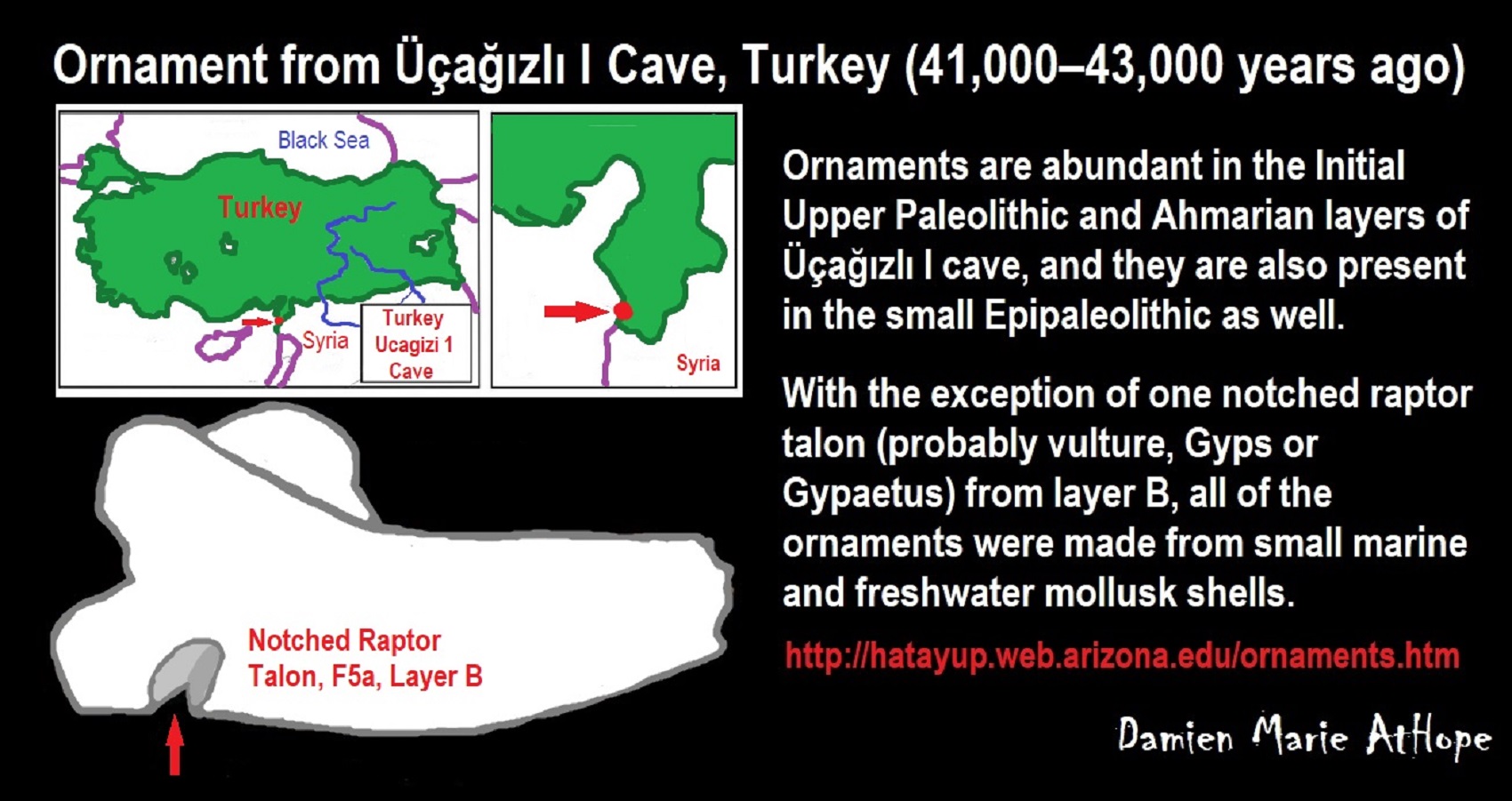
To me, the importance of talon ornaments, like the one in Üçagızlı Cave, “Sky burial”
Ornament from Üçağızlı I Cave, Turkey (41,000–43,000 years ago). ref
The early Upper Paleolithic occupations at Uçagızlı Cave (Hatay, Turkey)
Ornaments at Üçağızlı I Cave, Turkey
Ornaments are abundant in the Initial Upper Paleolithic and Ahmarian layers of Üçağızlı I cave, and they are also present in the small Epipaleolithic as well. With the exception of one notched raptor talon (probably vulture, Gyps or Gypaetus) from layer B, all of the ornaments were made from small marine and freshwater mollusk shells. ref
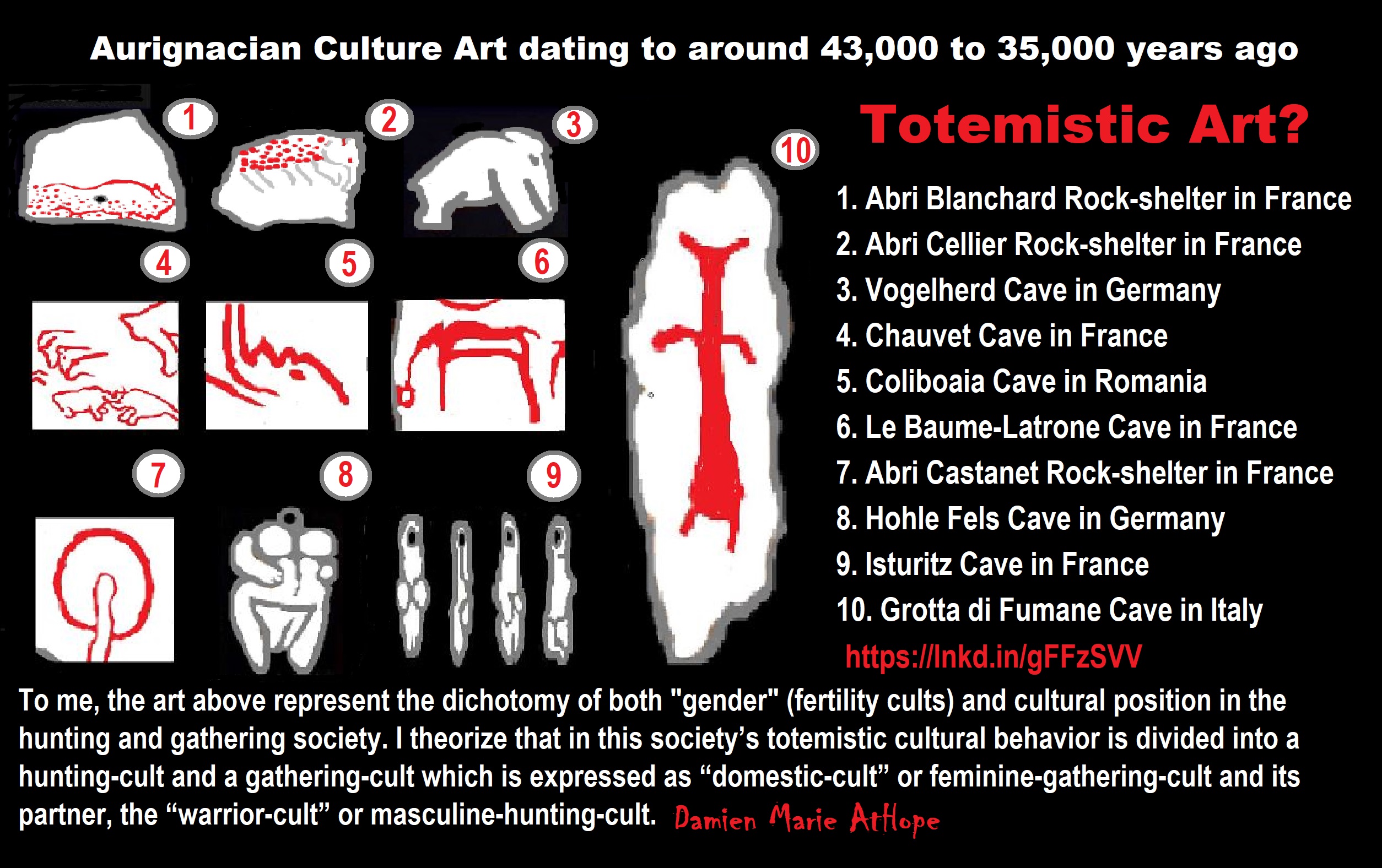

Paleolithic Y–chromosomal haplogroups by chronological period
Proto-Aurignacian (47,000 to 43,000 years before present; eastern Europe): F
Y-DNA Haplogroup F – HaploMaps – Y-DNA HAPLOGROUP F, Haplogroup F also known as F-M89 and its sub-clades compose of more than 90 % of the male population including almost everyone outside Africa. First appeared in N. Africa about 45,000 years ago and is believed to exhibit a “second-wave” of expansion exiting Africa. However. The location of this lineage’s rise to expansion was observed to be India or somewhere close to South Asia or the Middle East. The vast majority of individual males fall into its immediate descendant haplogroup major-clade GHIJK, which branches subsequently into Haplogroup G and Haplogroup HIJK. Under Haplogroup HIJK, sub-clades include H and IJ, K with IJK down streaming into I, J, L, M, N, O, P, Q, R, S and T. All haplogroup F descendants show a pattern of radiation. From S. Asia (H and K) and the Middle East (G and IJ). Apart from these, haplogroup F has four other intermediate descendant sub-clades, rare in the modern population F-M89* also called F(xGHIJK), F1, F2 and F3. The broader haplogroup F (F-M89) has sometimes been called FT to distinguish it from its rare sub-clade F-M89*.
Haplogroup F is a human mitochondrial DNA (mtDNA) haplogroup. The clade is most common in East Asia and South East Asia. It has not been found among Native Americans. And it is a primary branch of haplogroup of haplogroup R9b.
The F haplogroup is fairly common in East Asia. High frequencies of the clade are found among the Lahu from Yunnan (33% – 77%, average 52%), Nicobar Islands (50%), Shors from Kemerovo Oblast of Siberia (41%), and Arunachal Pradesh, India (31%).[19] There is also an important frequency in Taiwanese aborigines, Khakas, Kets, Han Chinese (and, thus, nearly all of China), Lombok, Sumba, Thailand, and Vietnam. Its distribution extends with low frequency to the Tharu of southern Nepal and the Bashkirs of the southern Urals. – Haplogroup F (mtDNA) – Wikipedia
Paleolithic Y-chromosomal haplogroups by chronological period
- Proto-Aurignacian (47,000 to 43,000 years before present; eastern Europe): F
- Aurignacian Culture (43,000 to 28,000 ybp ; all ice-free Europe): CT, C1a, C1b, I
- Gravettian Culture (31,000 to 24,000 ybp ; all ice-free Europe): BT, CT, F, C1a2
- Solutrean Culture (22,000 to 17,000 ybp ; France, Spain): ?
- Epiravettian Culture (22,000 to 8,000 ybp ; Italy): R1b1a
- Magdalenian Culture 17,000 to 12,000 ybp ; Western Europe): IJK, I
- Epipaleolithic France (13,000 to 10,000 ybp): I
- Azilian Culture (12,000 to 9,000 ybp; Western Europe): I2 ref
Y-DNA Haplogroup F – HaploMaps – This basal major-clade has neither been identified in living males nor in ancient remains. This suggests that populations with high proportions of descendant sub-clade haplogroups L, M, N, O, P, Q, R, S and T were predominating the geographical region way before the modern era!
Haplogroup G, J and R dominated the Caucasus and West Asia region
Haplogroups H, L and R dominated South Asia.
In Europe, haplogroups I, J, P, Q, R and N prevailed
In East Asia, Southeast Asia and Oceania, K, M, N, O and S haplogroups reigned.
Haplogroups P, Q and R dominated Central Asia
In N. America, Native American peoples are of the Haplogroup Q.

ref, ref, ref, ref, ref, ref, ref, ref, ref, ref, ref
U6 related Culture Haplogroup U6 (Back migration to Africa of U6: 30,000 years ago)
The image above relates to the distribution of cave-art, primary in Palaeolithic locations in Eurasia.
Grasping the long evolution to modern writing goes far back, way past simply looking to arcane writing. One must first track symbolic meaning, which, to me, is indeed a key cultural innovation is better understood as a complex.

I think the adding of dots could referencing starts, like the sun in day and stats and moon at night or other celestial bodies.
Cave art dated to at least 40,800 years old, was discovered in the Cave of El Castillo, “the cave of castles”, in the Cantabria region of Spain. The El Castillo cave contains a large red stippled disk in the Panel de las Manos dated to more than more than 40,800 years old and is consistent with the tradition of cave painting originating in the Proto-Aurignacian. Modern humans are believed to have also been in the area at the time, arriving about 41,500 years ago. Habitation roughly involves 55 000 to 45 000 years ago there is occupation by Neanderthals. From then 45 000 to 35 000 years ago is a transition period, the first phase of occupation by modern man during the upper Palaeolithic. And it is believed that Aurignacian involves at least three phases of occupation, clearly evident from 35,000 to 30,000 when it turns to Gravettian seeming to involve two phases of occupation from around 30,000 to 25,000 years ago. Followed by Magdalenian, with two phases of occupation dated to around 20 000 to 15 000 years ago. ref, ref
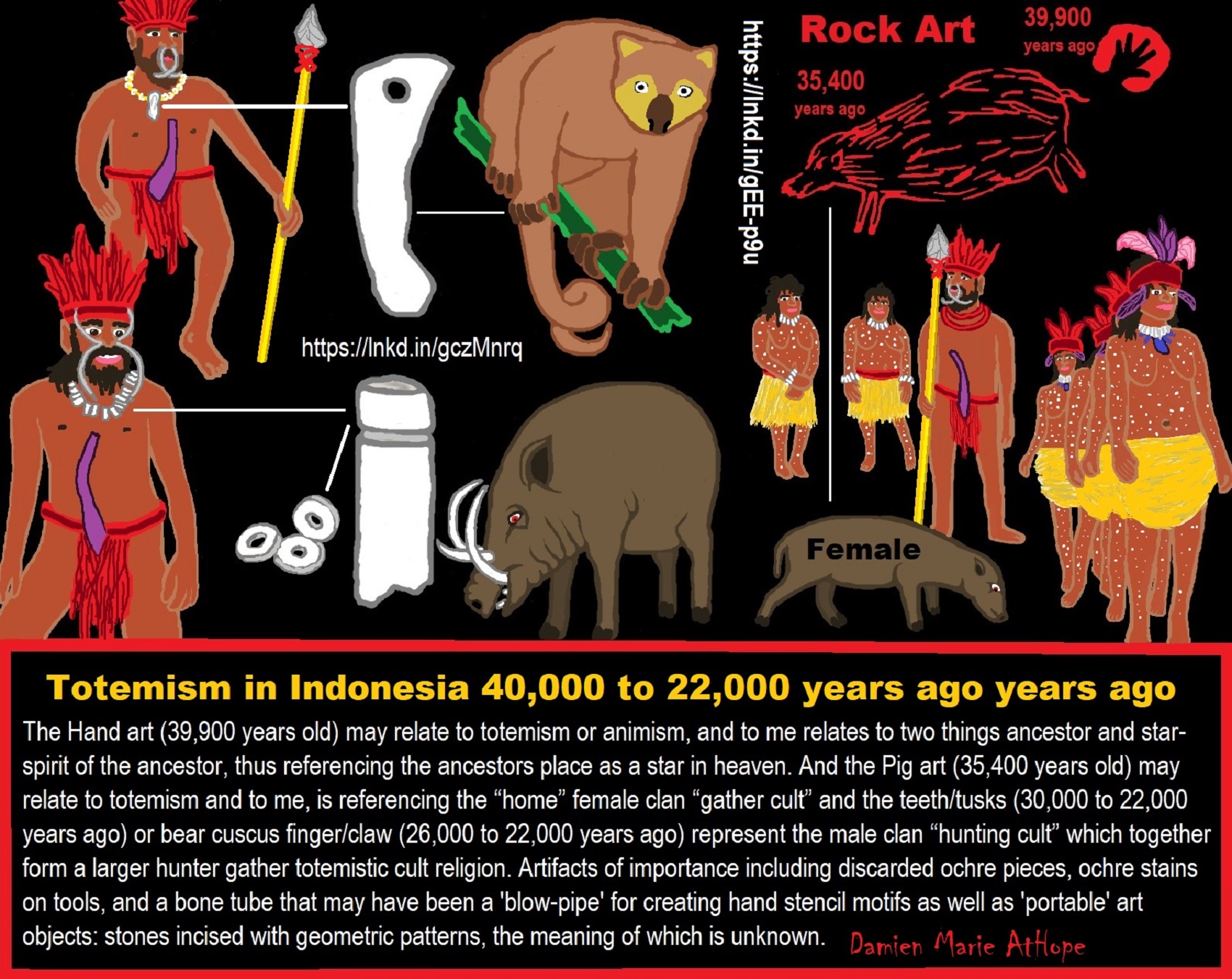
While humans seem to first settle in East Timor 42,000 years ago and a 39,900 years old hand stencil that is from the Leang Timpuseng Cave on the Island of Sulawesi in Indonesia also includes some of the most ancient animal paintings, all made by Aborigine migrants who were probably heading for Australia. and the image of the “pig-deer” at the Sulawesi Cave, Indonesia, dating to as old as 35,400 years ago. ref, ref, ref
Stars: Ancestors, Spirit Animals, and Deities (around 6,000 years ago, with connections to shamanism at 30,000 years ago and possibly further back to at least 40,000 years ago with totemism)
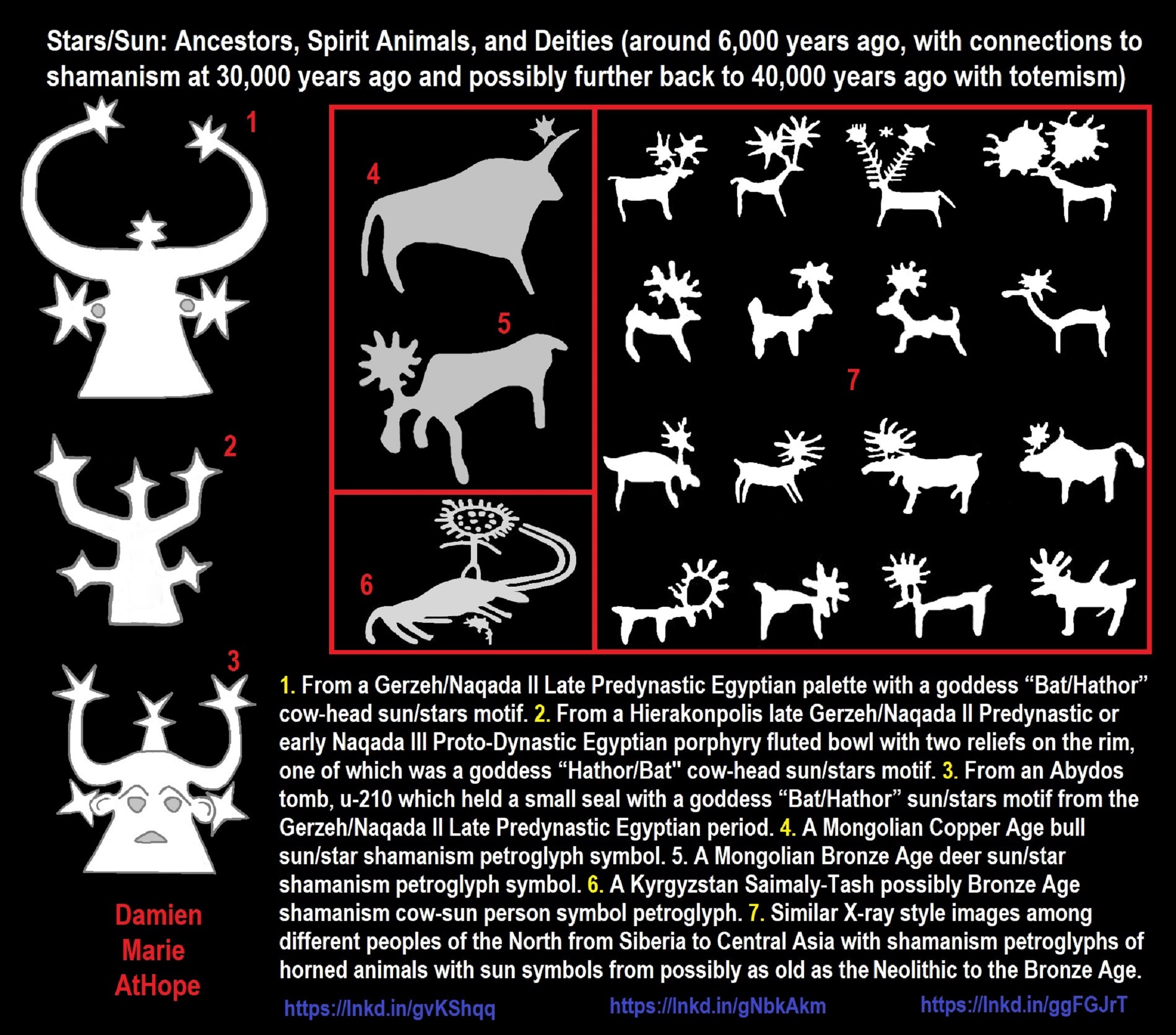
- From a Gerzeh/Naqada II Late Predynastic Egyptian palette with a goddess “Bat/Hathor” cow-head sun/stars motif.
- From a Hierakonpolis late Gerzeh/Naqada II Predynastic or early Naqada III Proto-Dynastic Egyptian porphyry fluted bowl with two reliefs on the rim, one of which was a goddess “Hathor/Bat” cow-head sun/stars motif.
- From an Abydos tomb, u-210 which held a small seal with a goddess “Bat/Hathor” sun/stars motif from the Gerzeh/Naqada II Late Predynastic Egyptian period.
- A Mongolian Copper Age bull sun/star shamanism petroglyph symbol.
- A Mongolian Bronze Age deer sun/star shamanism petroglyph symbol.
- A Kyrgyzstan Saimaly-Tash possibly Bronze Age shamanism cow-sun person symbol petroglyph.
- Similar X-ray style images among different peoples of the North from Siberia to Central Asia with shamanism petroglyphs of horned animals with sun symbols from possibly as old as the Neolithic to the Bronze Age. ref, ref, ref
Suggests That Prehistoric Humans Had Sophisticated Knowledge of Astronomy. The paintings appear to reflect the position of the stars in the night sky. ref
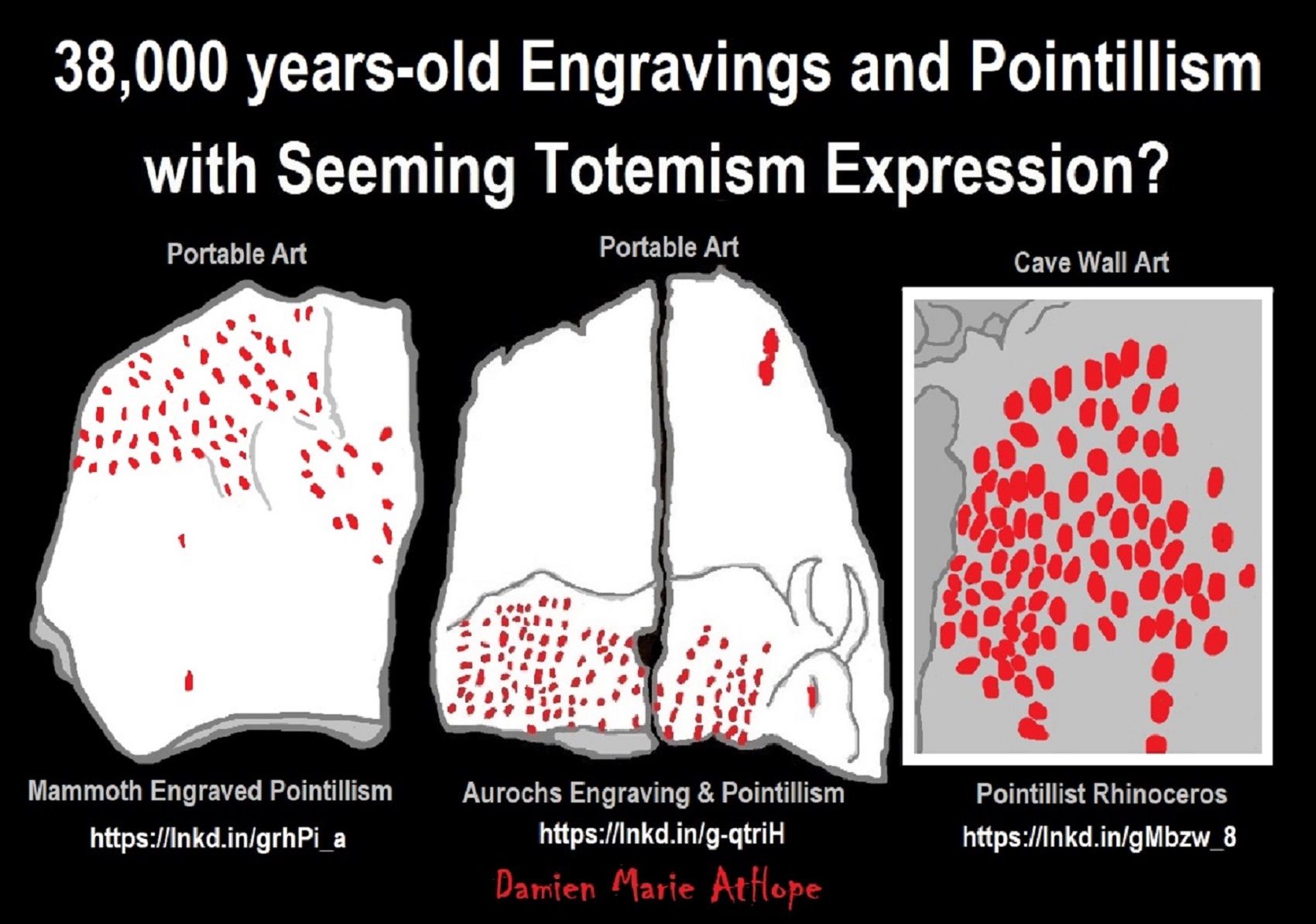
Ritual Pointillism, to me, references stars/ancestor worship in Aurignacian culture totemism, which I think relates to the Neanderthal Châtelperronian culture totemism. There was 16 engraved and otherwise modified limestone blocks, created 38,000 years ago, pointillist techniques: small dots to create the illusion of a larger image. ref

“The Adorant from the Geißenklösterle cave is a 35,000-to-40,000-year-old section of mammoth ivory with a depiction of a human figure, found in the Geißenklösterle cave in the Swabian Jura near Blaubeuren, Germany. The front face has a human figure of uncertain sex in relief, with raised arms and outstretched legs, but no hands. The posture is usually interpreted as an expression of worship, which is why in German the figure is called an “adorant”, a word meaning “worshipper”. It has been claimed that a belt and sword can be seen, although these are probably natural features of the ivory. On the plate’s reverse are rows of small notches. The piece is 38 mm (1.50 in) tall, 14 mm (0.55 in) wide, and 4.5 mm (0.18 in) thick. Traces of manganese and ochre can be found on it by microscope analysis. It is somewhat like the Lion-Human of Hohlenstein-Stadel ivory statue also found in Germany.” ref
“The Löwenmensch figurine, also called the Lion-Human of Hohlenstein-Stadel, is a prehistoric ivory sculpture discovered in Hohlenstein-Stadel, a German cave. The German name, Löwenmensch, meaning “lion-person” or “lion-human”, is used most frequently because it was discovered and is exhibited in Germany. Determined by carbon dating of the layer in which it was found to be between 35,000 and 40,000 years old, it is one of the oldest-known examples of an artistic representation and the oldest confirmed statue ever discovered. Its age associates it with the archaeological Aurignacian culture of the Upper Paleolithic. An example of zoomorphic art, the Lion-Human was carved out of mammoth ivory, using a flint stone knife. Seven parallel, transverse, carved gouges are on the left arm.” ref
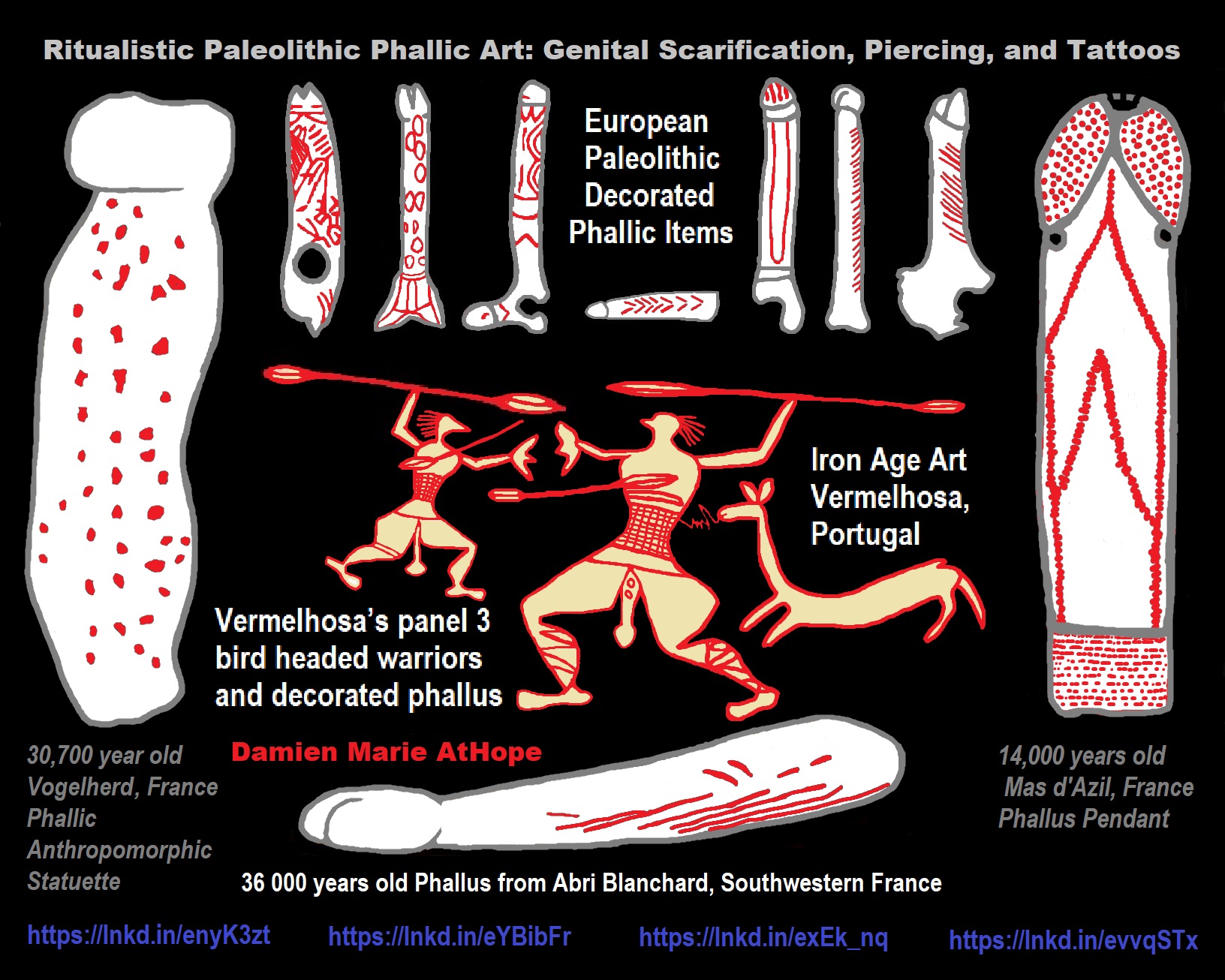
Aurignacian burials (c.37,000-30,000 years ago) belong to the early phase of this period in Europe. Examples have been excavated at Cave of Cavillon, Liguria – a burial wearing a cap of netted whelk shells with a border of deer’s teeth, red ochre around the face and a bone awl at the side. ref
Aurignacian in the Zagros region dates back to about 35,500 years ago at Yafteh Cave, Lorestan, Iran. ref

ref, ref, ref, ref, ref, ref, ref, ref, ref, ref, ref, ref, ref, ref, ref, ref, ref, ref, ref
Here are my thoughts/speculations on where I believe is the possible origin of shamanism, which may have begun sometime around 35,000 to 30,000 years ago seen in the emergence of the Gravettian culture, just to outline his thinking, on what thousands of years later led to evolved Asian shamanism, in general, and thus WU shamanism as well. In both Europe-related “shamanism-possible burials” and in Gravettian mitochondrial DNA is a seeming connection to Haplogroup U. And the first believed Shaman proposed burial belonged to Eastern Gravettians/Pavlovian culture at Dolní Věstonice in southern Moravia in the Czech Republic, which is the oldest permanent human settlement that has ever been found. It is at Dolní Věstonice where approximately 27,000-25,000 years ago a seeming female shaman was buried and also there was an ivory totem portrait figure, seemingly of her.
And my thoughts on how cultural/ritual aspects were influenced in the area of Göbekli Tepe. I think it relates to a few different cultures starting in the area before the Neolithic. Two different groups of Siberians first from northwest Siberia with U6 haplogroup 40,000 to 30,000 or so. Then R Haplogroup (mainly haplogroup R1b but also some possible R1a both related to the Ancient North Eurasians). This second group added its “R1b” DNA of around 50% to the two cultures Natufian and Trialetian. To me, it is likely both of these cultures helped create Göbekli Tepe. Then I think the female art or graffiti seen at Göbekli Tepe to me possibly relates to the Epigravettians that made it into Turkey and have similar art in North Italy. I speculate that possibly the Totem pole figurines seen first at Kostenki, next went to Mal’ta in Siberia as seen in their figurines that also seem “Totem-pole-like”, and then with the migrations of R1a it may have inspired the Shigir idol in Russia and the migrations of R1b may have inspired Göbekli Tepe.
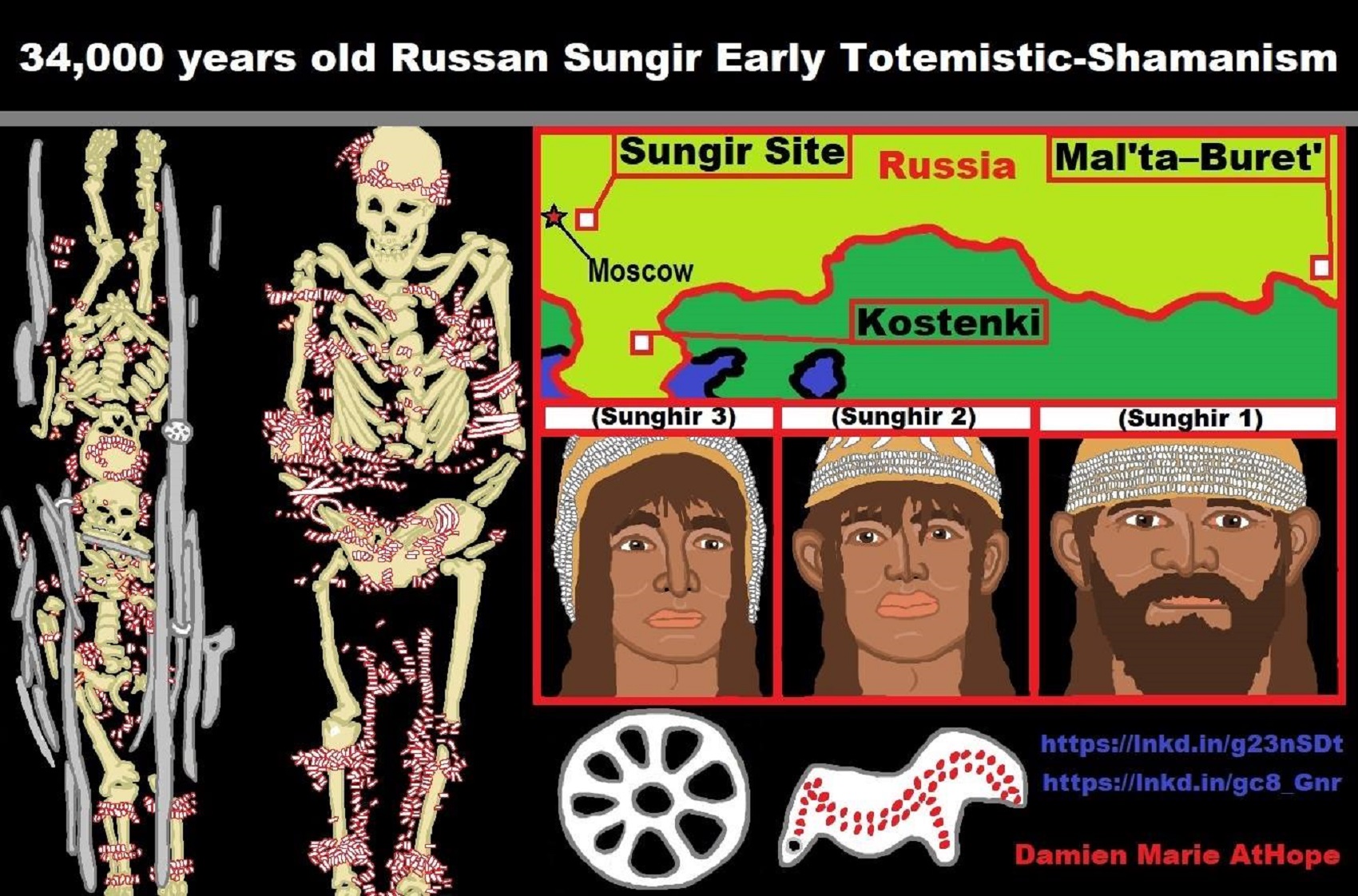
ref, ref, ref, ref, ref, ref, ref, ref, ref, ref, ref
Archaeologists usually describe two regional variants: the western Gravettian, known namely from cave sites in France, Spain, and Britain, and the eastern Gravettian in Central Europe and Russia. The eastern Gravettians include the Pavlovian culture, which were specialized mammoth hunters and whose remains are usually found not in caves but in open air sites. The origins of the Gravettian people are not clear, they seem to appear simultaneously all over Europe. Though they carried distinct genetic signatures, the Gravettians and Aurignacians before them were descended from the same ancient founder population. According to genetic data, 37,000 years ago, all Europeans can be traced back to a single ‘founding population’ that made it through the last ice age. Furthermore, the so-called founding fathers were part of the Aurignacian culture, which was displaced by another group of early humans members of the Gravettian culture. Between 37,000 years ago and 14,000 years ago, different groups of Europeans were descended from a single founder population. To a greater extent than their Aurignacian predecessors, they are known for their Venus figurines. ref, ref, ref, ref, ref, ref, ref, ref, ref, ref, & ref
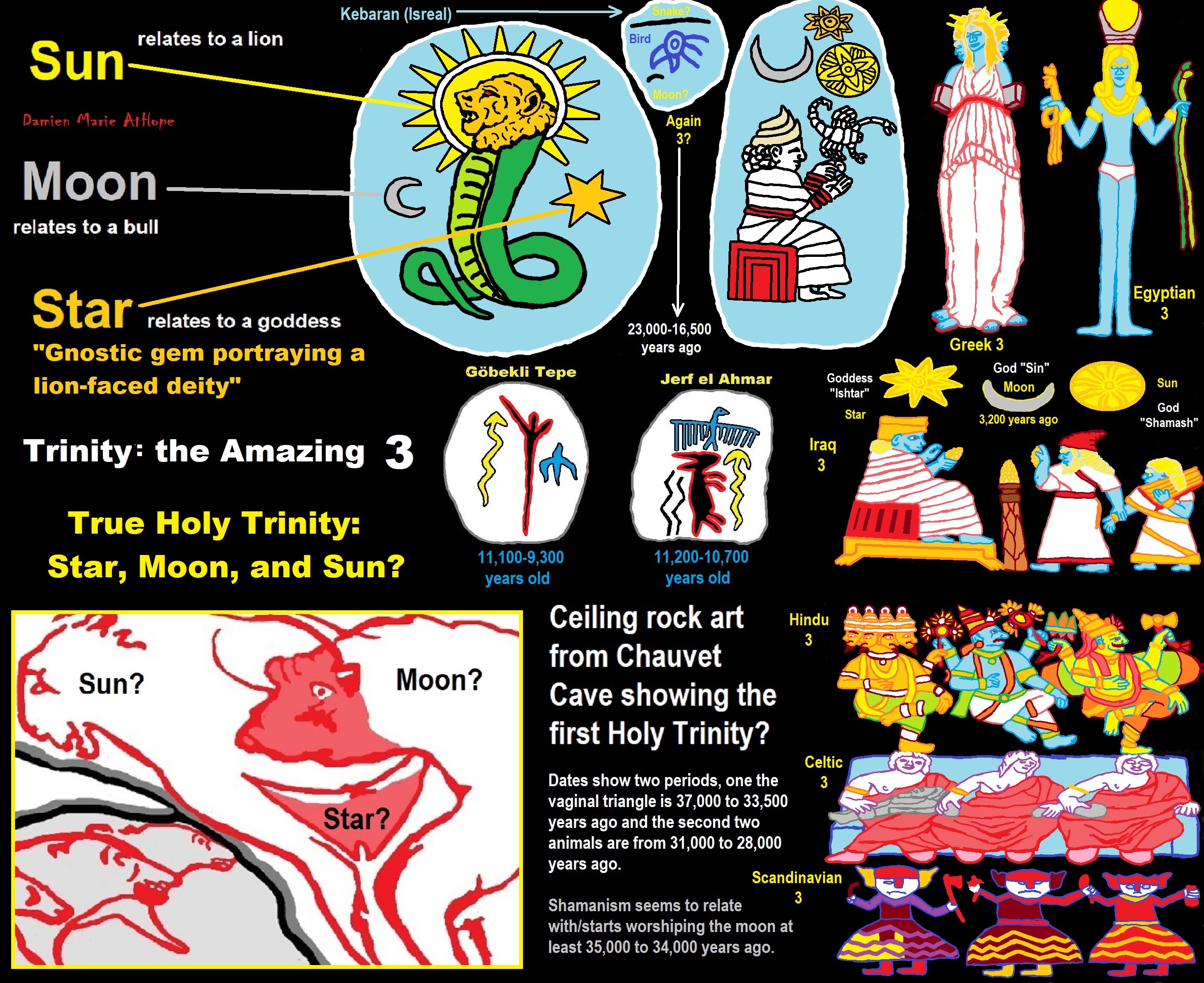

“Lunar and lunisolar calendars differ as to which day is the first day of the month. In some lunisolar calendars, such as the Chinese calendar, the first day of a month is the day when an astronomical new moon occurs in a particular time zone. In others, such as some Hindu calendars, each month begins on the day after the full moon. Others are based on the first sighting of the lunar crescent, such as the lunar Hijri calendar (and, historically, the Hebrew calendar).” ref
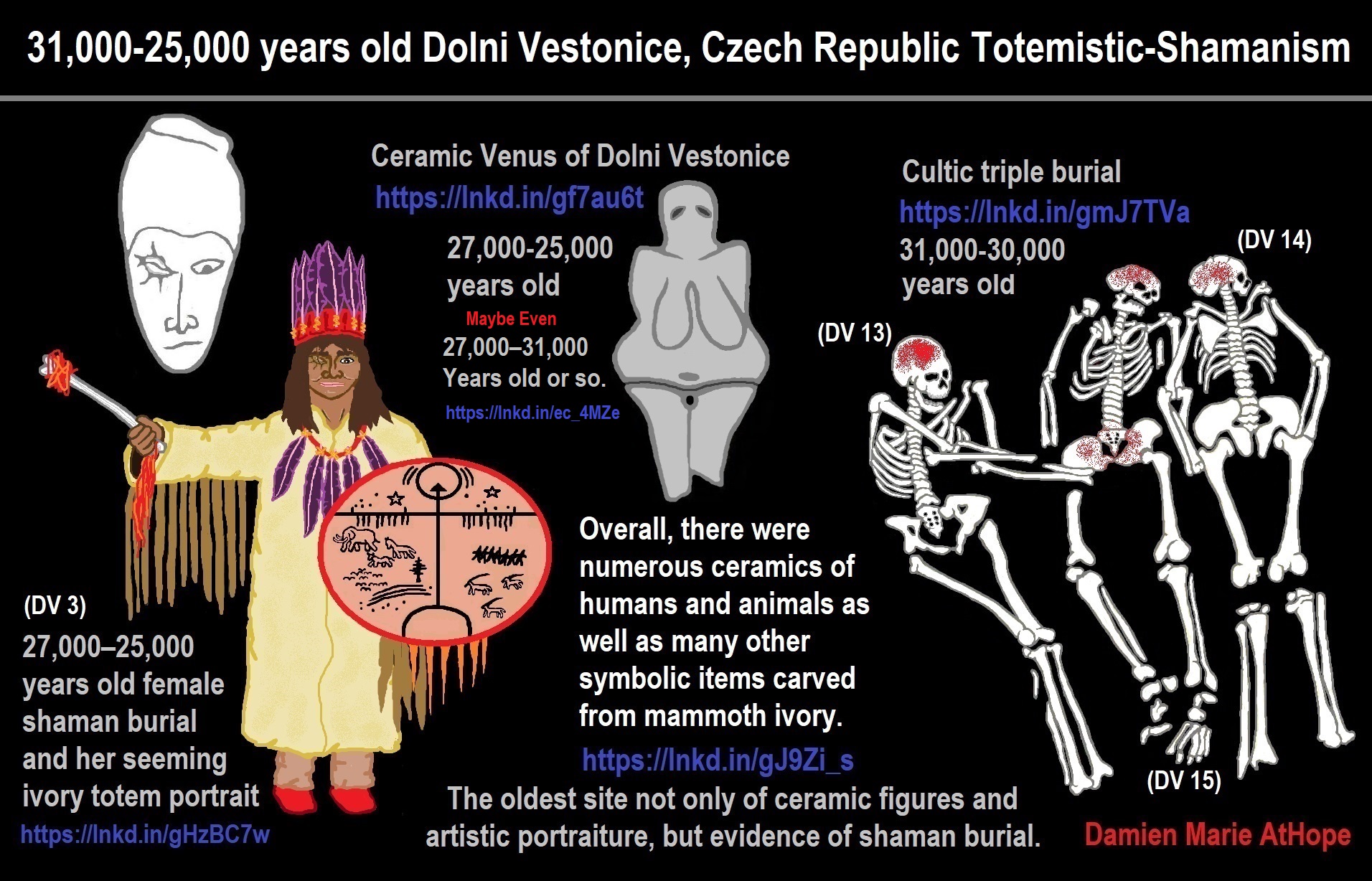


Shamanistic rock art from central Aboriginal Siberians
Shamanism (such as that seen in Siberia Gravettian culture: 30,000 years ago). Gravettian culture (34,000–24,000 years ago; Western Gravettian, mainly France, Spain, and Britain, as well as Eastern Gravettian in Central Europe and Russia. The eastern Gravettians, which include the Pavlovian culture). And, the Pavlovian culture (31,000 – 25,000 years ago such as in Austria and Poland). 31,000 – 20,000 years ago Oldest Shaman was Female, Buried with the Oldest Portrait Carving.
Shamanism is approximately a 30,000-year-old belief system and believe in spirit-filled life and/or afterlife that can be attached to or be expressed in things or objects and these objects can be used by special persons or in special rituals that can connect to spirit-filled life and/or afterlife. If you believe like this, regardless of your faith, you are a hidden shamanist.
Around 29,000 to 25,000 years ago in Dolní Vestonice, Czech Republic, the oldest human face representation is a carved ivory female head that was found nearby a female burial and belong to the Pavlovian culture, a variant of the Gravettian culture. The left side of the figure’s face was a distorted image and is believed to be a portrait of an elder female, who was around 40 years old. She was ritualistically placed beneath a pair of mammoth scapulae, one leaning against the other. Surprisingly, the left side of the skull was disfigured in the same manner as the aforementioned carved ivory figure, indicating that the figure was an intentional depiction of this specific individual. The bones and the earth surrounding the body contained traces of red ocher, a flint spearhead had been placed near the skull, and one hand held the body of a fox. This evidence suggests that this was the burial site of a shaman. This is the oldest site not only of ceramic figurines and artistic portraiture but also of evidence of early female shamans. Before 5,500 years ago, women were much more prominent in religion.
Archaeologists usually describe two regional variants: the western Gravettian, known namely from cave sites in France, Spain, and Britain, and the eastern Gravettian in Central Europe and Russia. The eastern Gravettians include the Pavlovian culture, which were specialized mammoth hunters and whose remains are usually found not in caves but in open air sites. The origins of the Gravettian people are not clear, they seem to appear simultaneously all over Europe. Though they carried distinct genetic signatures, the Gravettians and Aurignacians before them were descended from the same ancient founder population. According to genetic data, 37,000 years ago, all Europeans can be traced back to a single ‘founding population’ that made it through the last ice age. Furthermore, the so-called founding fathers were part of the Aurignacian culture, which was displaced by another group of early humans members of the Gravettian culture. Between 37,000 years ago and 14,000 years ago, different groups of Europeans were descended from a single founder population. To a greater extent than their Aurignacian predecessors, they are known for their Venus figurines. ref, ref, ref, ref, ref, ref, ref, ref, ref, ref, & ref
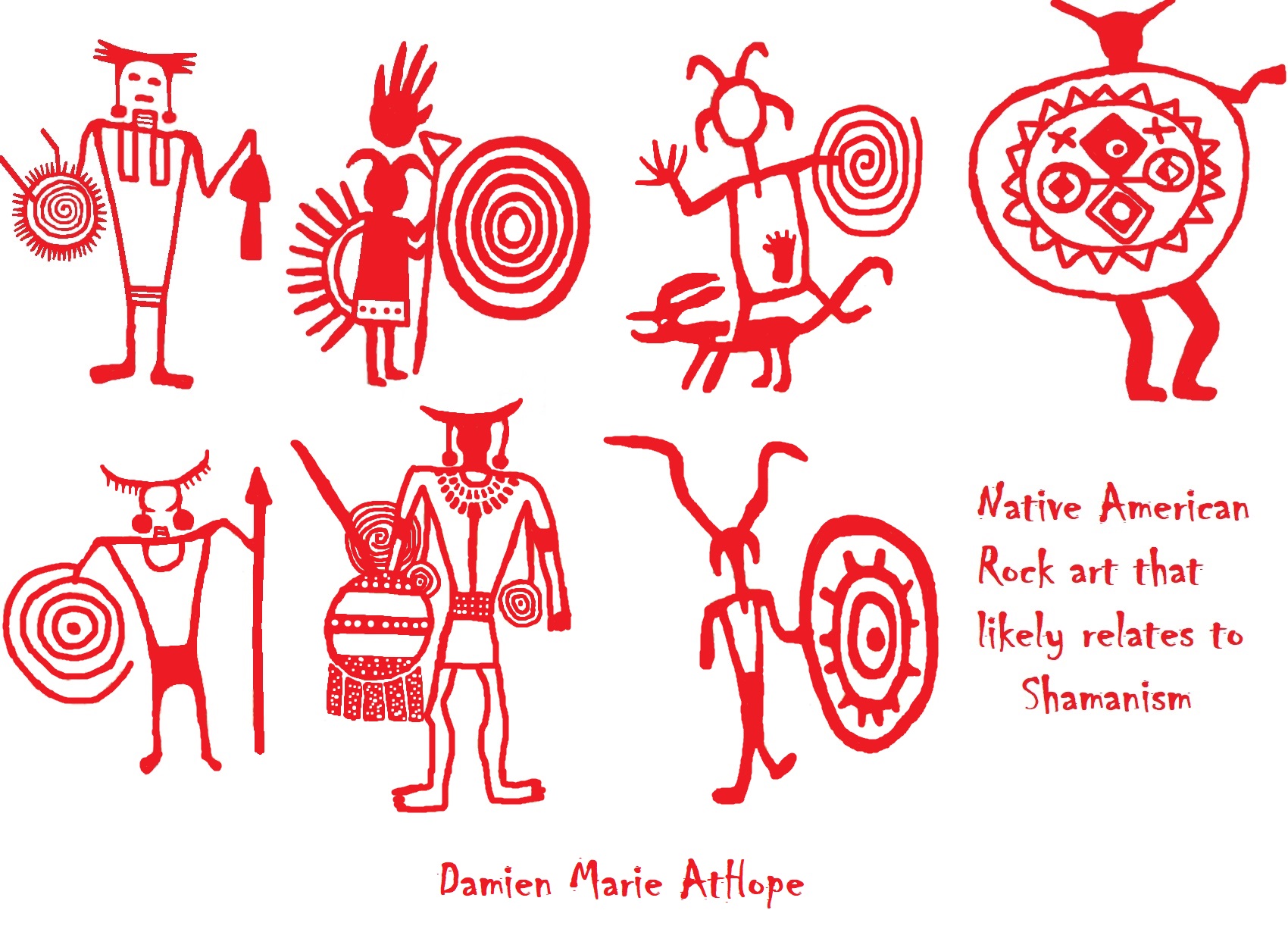
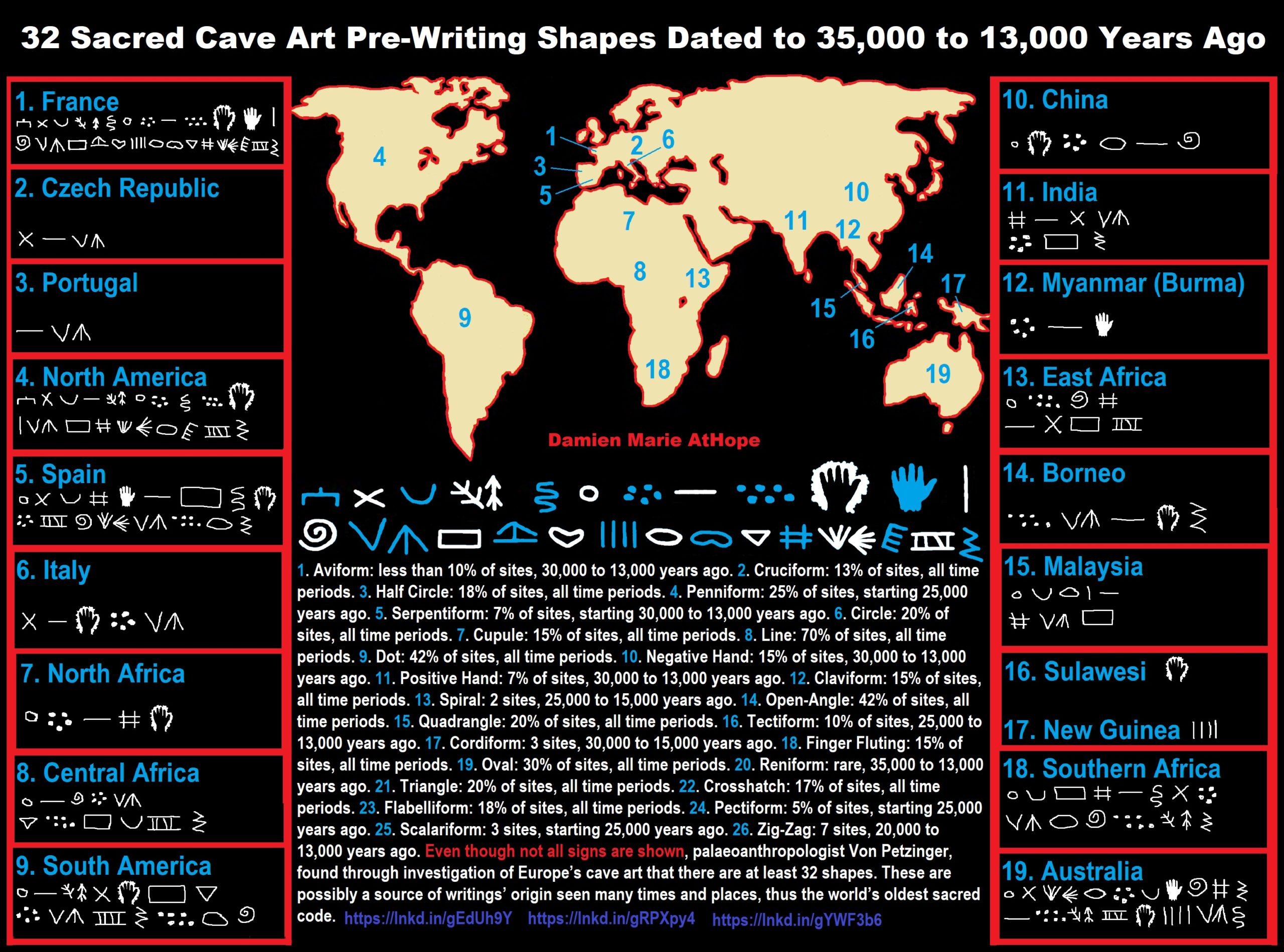
Why are these 32 symbols found in caves all over Europe
32 Sacred Cave Art Pre-Writing Shapes Dated to 35,000 to 13,000 Years Ago
- 1. Aviform: less than 10% of sites, 30,000 to 13,000 years ago.
- 2. Cruciform: 13% of sites, all time periods.
- 3. Half Circle: 18% of sites, all time periods.
- 4. Penniform: 25% of sites, starting 25,000 years ago.
- 5. Serpentiform: 7% of sites, starting 30,000 to 13,000 years ago.
- 6. Circle: 20% of sites, all time periods.
- 7. Cupule: 15% of sites, all time periods.
- 8. Line: 70% of sites, all time periods.
- 9. Dot: 42% of sites, all time periods.
- 10. Negative Hand: 15% of sites, 30,000 to 13,000 years ago.
- 11. Positive Hand: 7% of sites, 30,000 to 13,000 years ago.
- 12. Claviform: 15% of sites, all time periods.
- 13. Spiral: 2 sites, 25,000 to 15,000 years ago.
- 14. Open-Angle: 42% of sites, all time periods.
- 15. Quadrangle: 20% of sites, all time periods.
- 16. Tectiform: 10% of sites, 25,000 to 13,000 years ago.
- 17. Cordiform: 3 sites, 30,000 to 15,000 years ago.
- 18. Finger Fluting: 15% of sites, all time periods.
- 19. Oval: 30% of sites, all time periods.
- 20. Reniform: rare, 35,000 to 13,000 years ago.
- 21. Triangle: 20% of sites, all time periods.
- 22. Crosshatch: 17% of sites, all time periods.
- 23. Flabelliform: 18% of sites, all time periods.
- 24. Pectiform: 5% of sites, starting 25,000 years ago.
- 25. Scalariform: 3 sites, starting 25,000 years ago.
- 26. Zig-Zag: 7 sites, 20,000 to 13,000 years ago.
Even though not all signs are shown, palaeoanthropologist Von Petzinger, found through investigation of Europe’s cave art that there are at least 32 shapes. These are possibly a source of writings’ origin seen many times and places, thus the world’s oldest sacred code. A paleoanthropologist and rock art researcher explains that even though to many written language is the hallmark of human civilization, this construct in behavior didn’t just suddenly appear one day. Thousands of years before the first fully developed writing systems, our ancestors scrawled geometric signs across the walls of the caves they sheltered in. She has studied and codified these ancient markings in caves across Europe, suggesting that graphic communication, and the ability to preserve and transmit messages beyond a single moment in time, may be much older than we think. ref, ref, ref, ref
A Chart of the 26 recurring shapes (proto-alphabet) from the 146 French rock art sites.
Code hidden in Stone Age art may be the root of human writing.
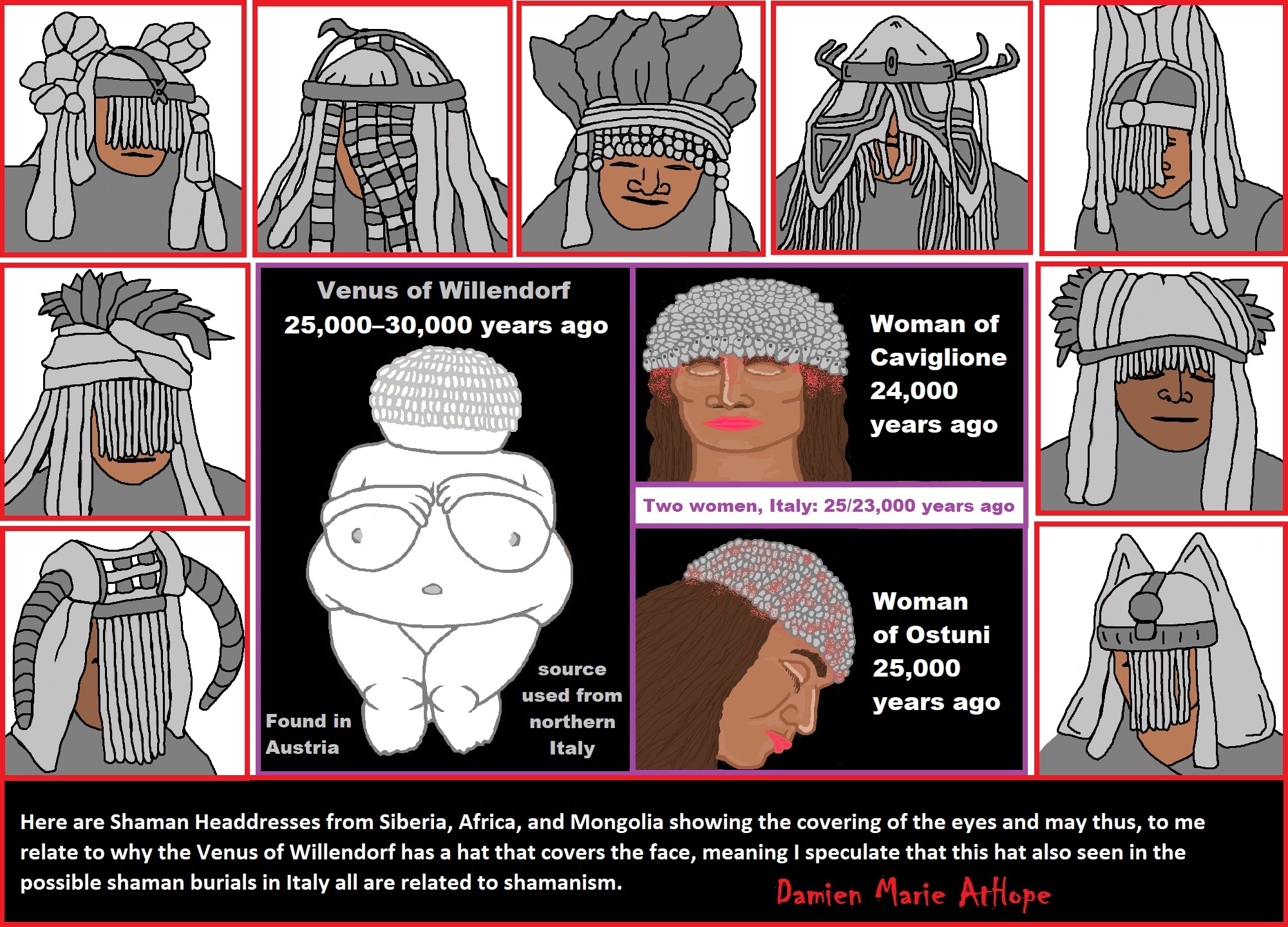
Here are Shaman Headdresses from Siberia, Africa, and Mongolia showing the covering of the eyes and may thus, to me relate to why the Venus of Willendorf has a hat that covers the face, meaning I speculate that this hat, also seen in the possible shaman burials in Italy all are related to shamanism.
“Venus figurines have been unearthed in Europe, Siberia, and much of Eurasia.
Most date from the Gravettian period but start in the Aurignacian era, and lasts to the Magdalenian time.” ref
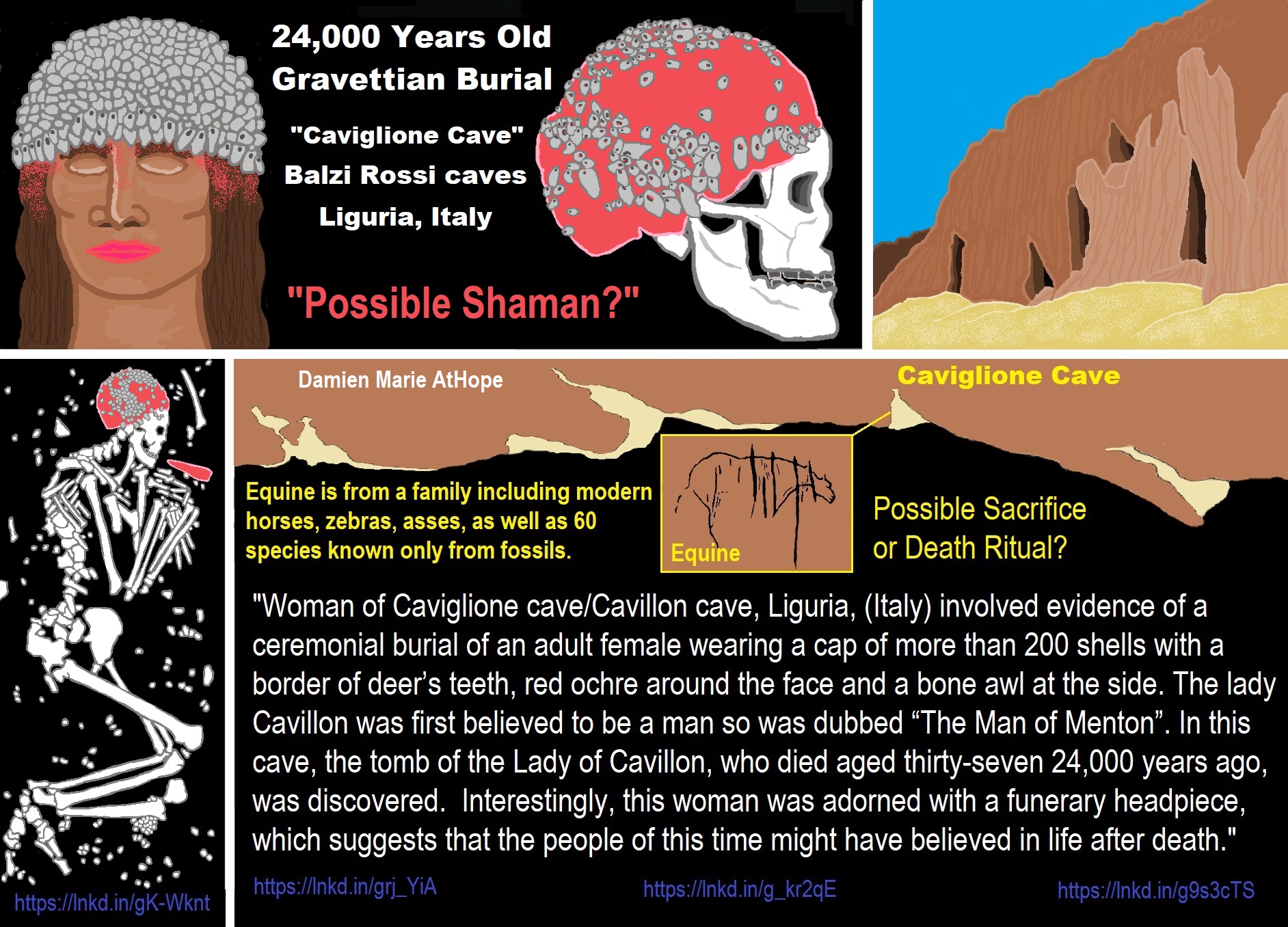
“Woman of Caviglione cave/Cavillon cave, Liguria, (Italy) involved evidence of a ceremonial burial of an adult female wearing a cap of more than 200 shells with a border of deer’s teeth, red ochre around the face and a bone awl at the side. The lady Cavillon was first believed to be a man so was dubbed “The Man of Menton”. In this cave, the tomb of the Lady of Cavillon, who died aged thirty-seven 24,000 years ago, was discovered. Interestingly, this woman was adorned with a funerary headpiece, which suggests that the people of this time might have believed in life after death.” Ref, Ref, Ref, Ref
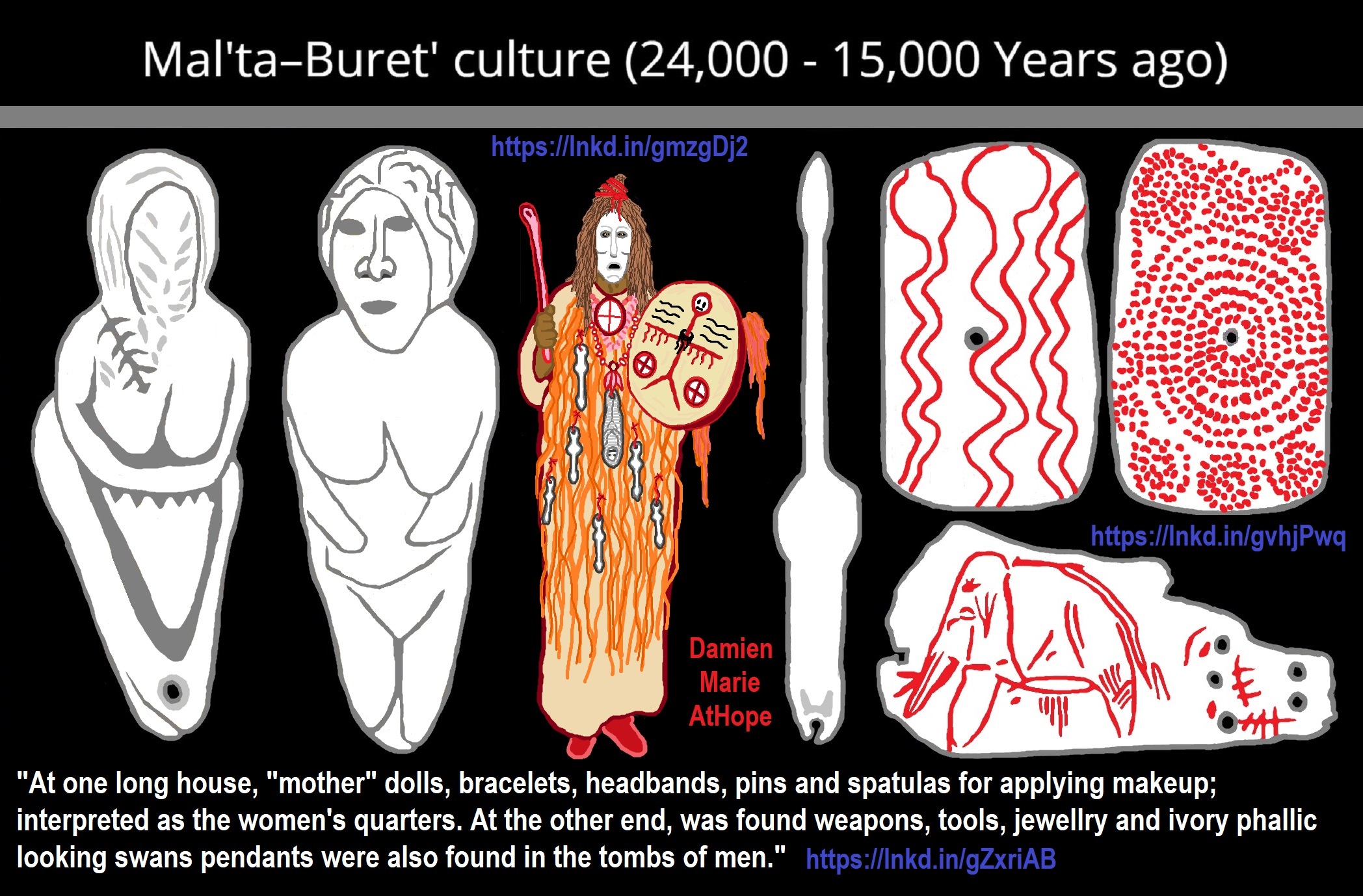
On the left was a figure that is believed to express arctic clothing, possibly a female and the clothing idea seems true due to a reconstruction of this culture’s artifacts found in this culture and shows the originality as well as the decoration of the clothing. Each of the Venus figurines from the Mal’ta and Buret culture sites differs a little from the others. ref
From the right demonstrates a shared clothing and symbolic artifact joint use as many of the Malta-bureť artifacts are manufactured as lockets. The right picture is of a likely shaman showing how such items may have been wearing either as a decoration or for protection and driving away the evil spirits. ref
There is excellent workmanship in the small artifacts (decorative plates, pins, shaking hoops and figurines of water birds) made of hard, durable material (ivory, antlers) from the Malta and Buret sites. These artifacts suggest us of the quality of the objects that did not remain (e.g. boats, oars, sled, ski, winter boots, bags, baskets, etc.)
The quality of the Gravettian products was dictated by the harsh arctic conditions. Everything had to be light, ingenious, well made and, above all, extremely reliable. Nobody surely wanted to lose a glove during a several days long expedition. This would have surely meant a frostbite and loss of several fingers. Unreliable boots or sleds would have certainly meant death. That is why archaeologists find so many proofs of the meticulous work of the Gravettian designers, craftsmen, and artists, all these skills often represented probably one and the same person. ref
A boy whose remains were found near Mal’ta is usually known by the abbreviation MA-1 (or MA1). According to research published since 2013, MA-1 belonged to a population related to the genetic ancestors of Siberians, American Indians, and Bronze Age Yamnaya people of the Eurasian steppe. Modern-day Native Americans, Kets, Mansi, Nganasansand Yukaghirs were found to be harbor a lot of ancestries related to MA-1. ref
Mal’ta is a ~24,000 years old Siberian genome, recently described as a representative of ancient North Eurasians (ANE), a previously unknown northeastern branch of the Eurasian Paleolithic population. ANE contributed roughly 30–40% to the gene pool of Native Americans of the first settlement wave and about 50% to the Bronze Age Yamnaya culture in the Pontic-Caspian steppe. A massive expansion of the Corded Ware culture around 5,000-4,000 years ago, originating from the Yamnaya source, introduced the ANE genetic pool into Central and Western Europe and thus reshaped its genetic landscape. During the same period, the Afanasievo and Andronovo cultures, genetically similar to the Yamnaya culture, expanded into the Altai region (South Siberia) and later mixed with Siberian populations, giving rise to the Bronze Age Karasuk culture and later Iron Age cultures. ref
A global maximum of ANE ancestry occurs in Native Americans, with lower levels in peoples of more recent Beringian origin, i.e. indigenous populations of Chukotka, Kamchatka, the Aleutian Islands, and the American Arctic. According to a single f4 statistic, the current cay Ket people had the third highest value of ANE genetic contribution among all Siberian ethnic groups, preceded only by Chukchi and Koryaks. Thus, we suggest that the Kets might represent the peak of ANE ancestry in Siberia; the hypothesis we tested extensively in this study. The Kets are thought to be the only survivors of an ancient nomadic people believed to have originally lived throughout central and southern Siberia.We also investigated continuity between the modern Kets and Altaians, and the ancient Bronze and Iron Age populations of the Altai region discussed above: the Karasuk culture samples dated to 3,531-3,261 years ago, and Iron Age samples roughly dated to 2,900-1,100 years ago. ref
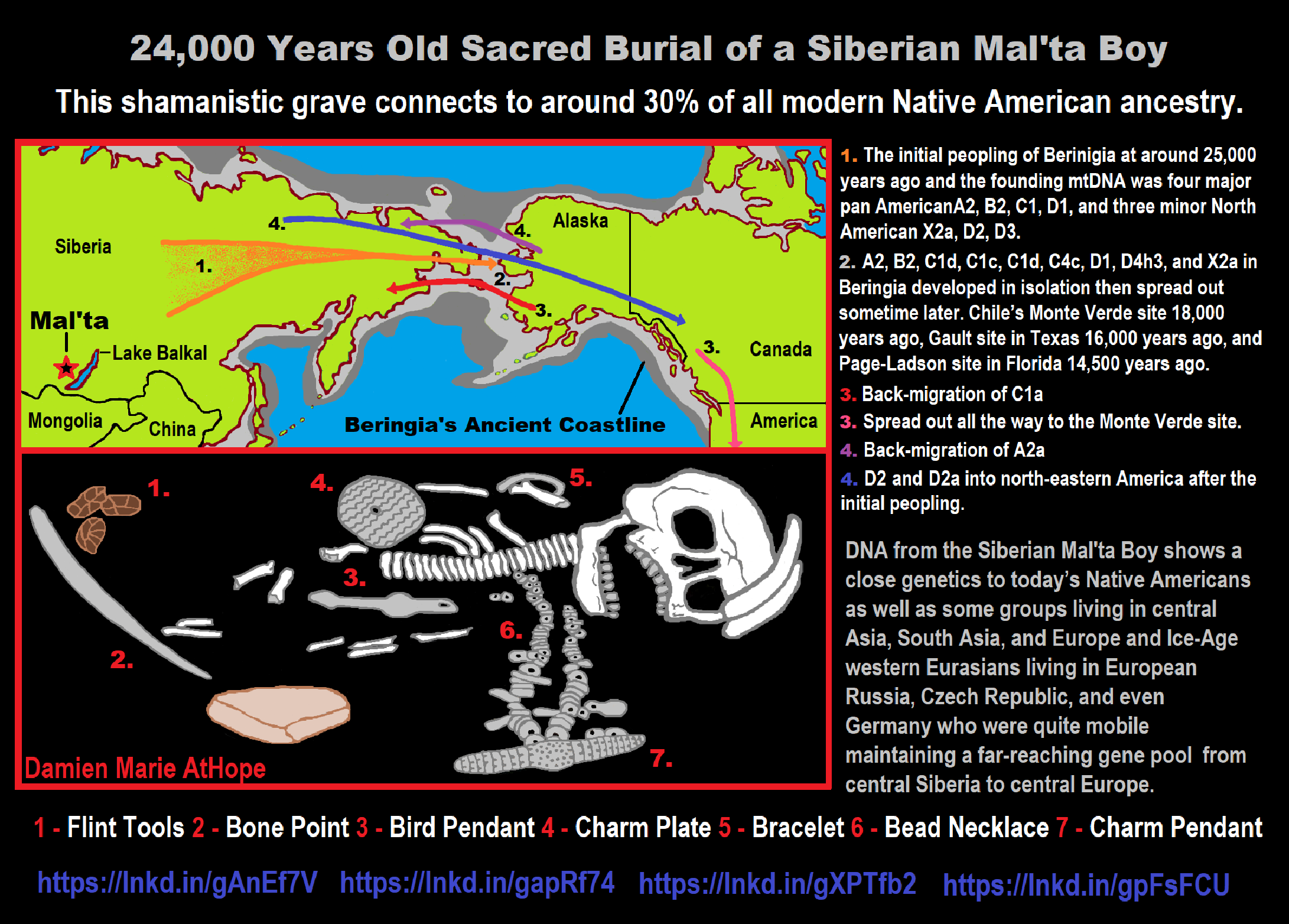


“Migration from Siberia behind the formation of Göbeklitepe: Expert states. People who migrated from Siberia formed the Göbeklitepe, and those in Göbeklitepe migrated in five other ways to spread to the world, said experts about the 12,000-year-old Neolithic archaeological site in the southwestern province of Şanlıurfa.“ The upper paleolithic migrations between Siberia and the Near East is a process that has been confirmed by material culture documents,” he said.” ref
“Semih Güneri, a retired professor from Caucasia and Central Asia Archaeology Research Center of Dokuz Eylül University, and his colleague, Professor Ekaterine Lipnina, presented the Siberia-Göbeklitepe hypothesis they have developed in recent years at the congress held in Istanbul between June 11 and 13. There was a migration that started from Siberia 30,000 years ago and spread to all of Asia and then to Eastern and Northern Europe, Güneri said at the international congress.” ref
“The relationship of Göbeklitepe high culture with the carriers of Siberian microblade stone tool technology is no longer a secret,” he said while emphasizing that the most important branch of the migrations extended to the Near East. “The results of the genetic analyzes of Iraq’s Zagros region confirm the traces of the Siberian/North Asian indigenous people, who arrived at Zagros via the Central Asian mountainous corridor and met with the Göbeklitepe culture via Northern Iraq,” he added.” ref
“Emphasizing that the stone tool technology was transported approximately 7,000 kilometers from east to west, he said, “It is not clear whether this technology is transmitted directly to long distances by people speaking the Turkish language at the earliest, or it travels this long-distance through using way stations.” According to the archaeological documents, it is known that the Siberian people had reached the Zagros region, he said. “There seems to be a relationship between Siberian hunter-gatherers and native Zagros hunter-gatherers,” Güneri said, adding that the results of genetic studies show that Siberian people reached as far as the Zagros.” ref
“There were three waves of migration of Turkish tribes from the Southern Siberia to Europe,” said Osman Karatay, a professor from Ege University. He added that most of the groups in the third wave, which took place between 2600-2400 BCE, assimilated and entered the Germanic tribes and that there was a genetic kinship between their tribes and the Turks. The professor also pointed out that there are indications that there is a technology and tool transfer from Siberia to the Göbeklitepe region and that it is not known whether people came, and if any, whether they were Turkish.” ref
“Around 12,000 years ago, there would be no ‘Turks’ as we know it today. However, there may have been tribes that we could call our ‘common ancestors,’” he added. “Talking about 30,000 years ago, it is impossible to identify and classify nations in today’s terms,” said Murat Öztürk, associate professor from İnönü University. He also said that it is not possible to determine who came to where during the migrations that were accepted to have been made thousands of years ago from Siberia. On the other hand, Mehmet Özdoğan, an academic from Istanbul University, has an idea of where “the people of Göbeklitepe migrated to.” ref
“According to Özdoğan, “the people of Göbeklitepe turned into farmers, and they could not stand the pressure of the overwhelming clergy and started to migrate to five ways.” “Migrations take place primarily in groups. One of the five routes extends to the Caucasus, another from Iran to Central Asia, the Mediterranean coast to Spain, Thrace and [the northwestern province of] Kırklareli to Europe and England, and one route is to Istanbul via [Istanbul’s neighboring province of] Sakarya and stops,” Özdoğan said. In a very short time after the migration of farmers in Göbeklitepe, 300 settlements were established only around northern Greece, Bulgaria, and Thrace. “Those who remained in Göbeklitepe pulled the trigger of Mesopotamian civilization in the following periods, and those who migrated to Mesopotamia started irrigated agriculture before the Sumerians,” he said.” ref
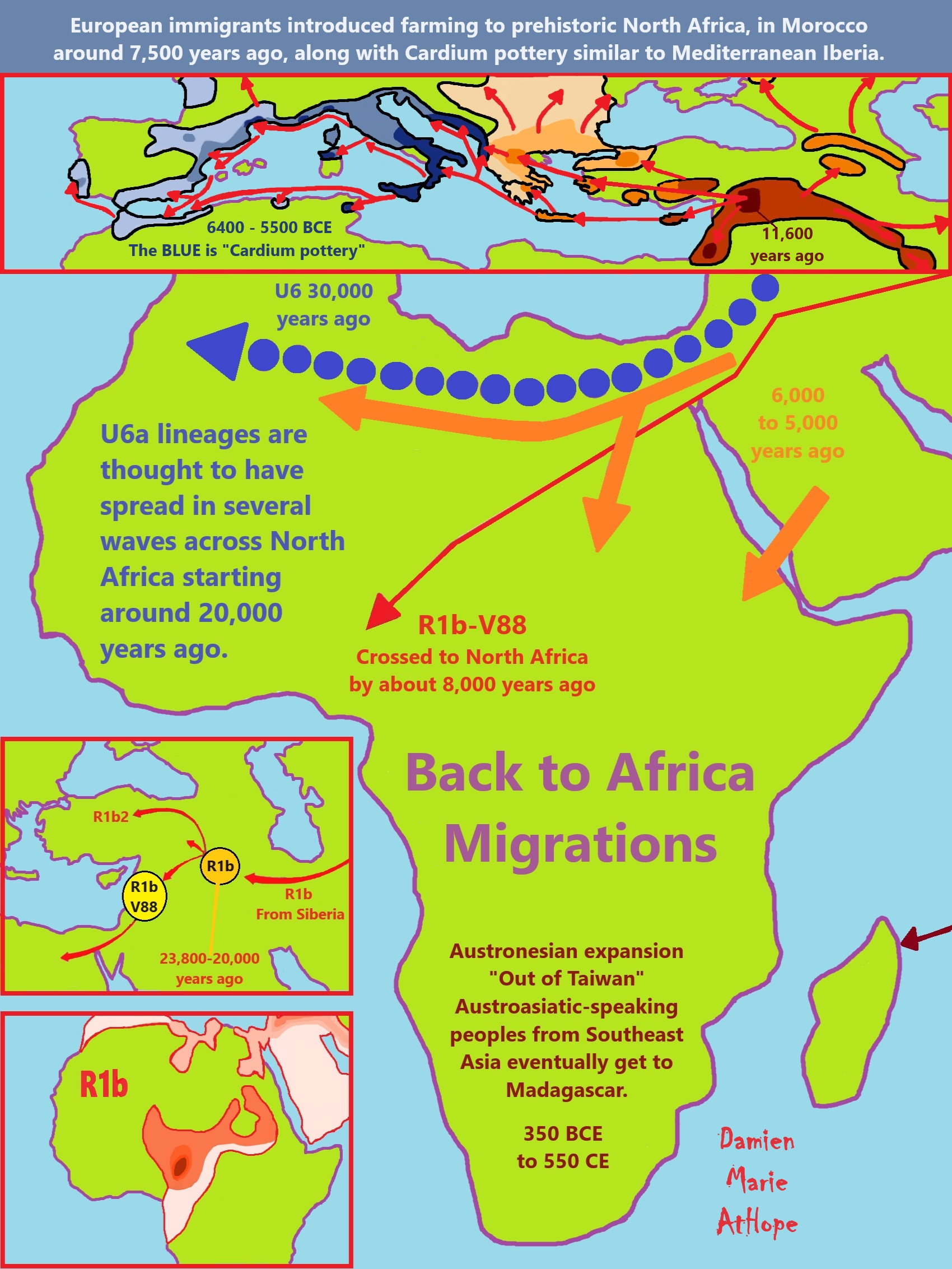

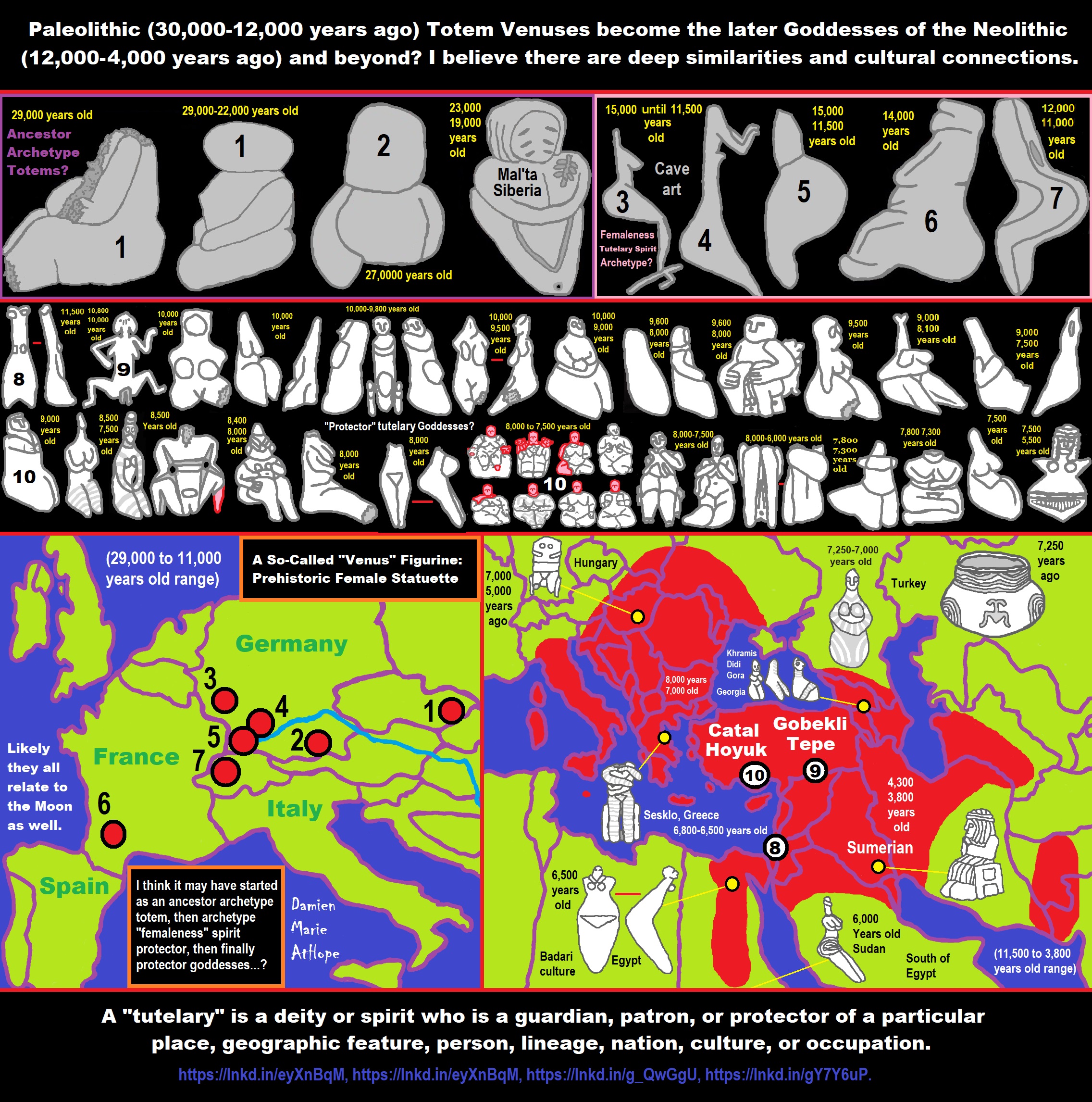

ref, ref, ref, ref, ref, ref, ref, ref
The Ishango Bone, 22,000-20,000 years old notches It was discovered in the area of Ishango near the Semliki River in the Democratic Republic of the Congo found among the remains of a small community that fished and gathered in this area of Africa. Ideas on its etchings, which seem to be in grouped marks range from tally stick to record numbers, tracking the moon in relation to menstrual cycles or even messages of some kind, maybe an early prayer.
A common form of the same kind of primitive counting device is seen in various kinds of prayer beads. Made out of the fibula of a baboon similar to the Lebombo Bone, 37,000 years old bone, also with notches that were deliberately cut into a baboon’s fibula found in southern Africa and is thought to be a tally-bone, moon calendar and could relate to menstruation as well.
Both may have used the bone of a Baboons because they express a hierarchy system of dominance. where a dominant male usually runs the troop, and thus these similar objects could show a deeper connections to such artifacts related to such symbolic marks on this type of animal as being magic totem to or of it expressed metaphorically in the welding of such an item referencing displays of dominance likely seen as giving power then this would demonstrate totemistic clan thinking and behavior. ref, ref
By 20,000 years ago, Upper Paleolithic people were leaving tally marks on cave walls and cutting hash marks onto portable sticks. ref

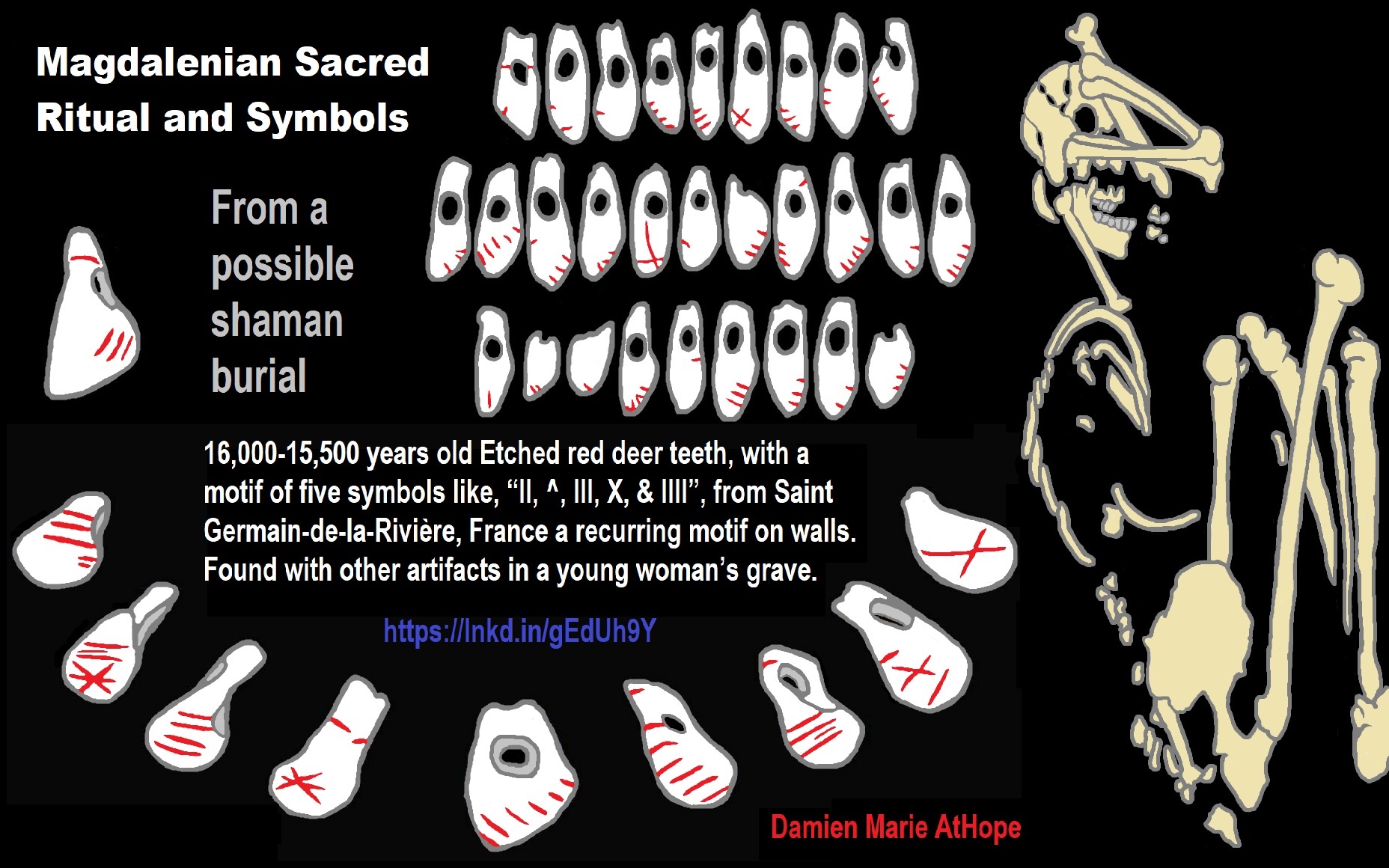
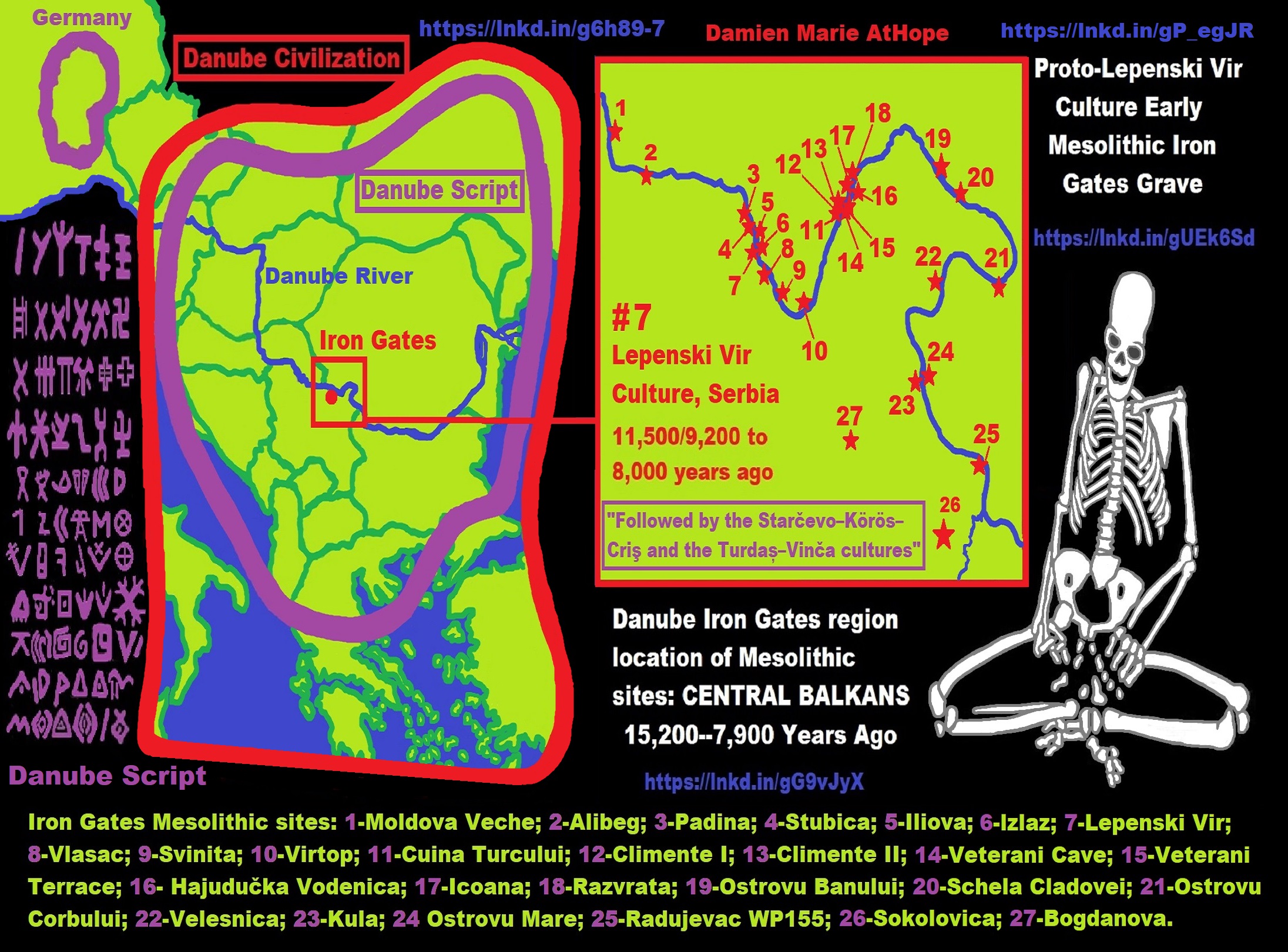

12,000-year-old Gobekli Tepe: “first human-made pagan temple”
Just think of the kind and amount of religious faith one would need to build such a site as this. Speaking of building, one of the most fascinating facts about this site is that they didn’t have the wheel nor metal tools. All they had were stone tools and little else.
- Epipalaeolithic Near East 20,000 to 9,000 years ago and the Emergence of Advanced Culture as well as New Religion?
- Epigravettians Join the Religious Partying at Gobekli Tepe?
- Gobekli Tepe is more like Shamanistic early Paganism, Not Adam, Eve, and Cain or Bible anything!
- Male-Homosexual (female-like) / Trans-woman (female) Seated Figurine from Gobekli Tepe
- Alcohol, where Agriculture and Religion Become one? Such as Gobekli Tepe’s Ritualistic use of Grain as Food and Ritual Drink
- Ritualistic Bird Symbolism at Gobekli Tepe and its “Ancestor Cult”
- Göbekli Tepe 12,000 years old T-shaped Pillars are not Alone (not Ancient Aliens)
- Could a 12,000-year-old Bull Geoglyph at Göbekli Tepe relate to older Bull and Female Art 25,000 years ago and Later Goddess and the Bull cults like Catal Huyuk?
- The Gravettian culture (Europe) shared ritual ideas and The Ancient North Eurasian culture (Asia) 24,000 years ago
- Are the Natufians of Israel around 15,000 to 11,500 years ago who you thought they were?
- 12,400 – 11,700 Years Ago – Kortik Tepe (Turkey) Pre/early-Agriculture Cultic Ritualism
- Pre-Pottery Neolithic (10000 – 6500 BCE) and Pottery Neolithic (7000–5000 BCE)
- Masked Head Hunters of “Karahan Tepe” 11,400-year-old monumental site from the Pre-Pottery Neolithic A to B
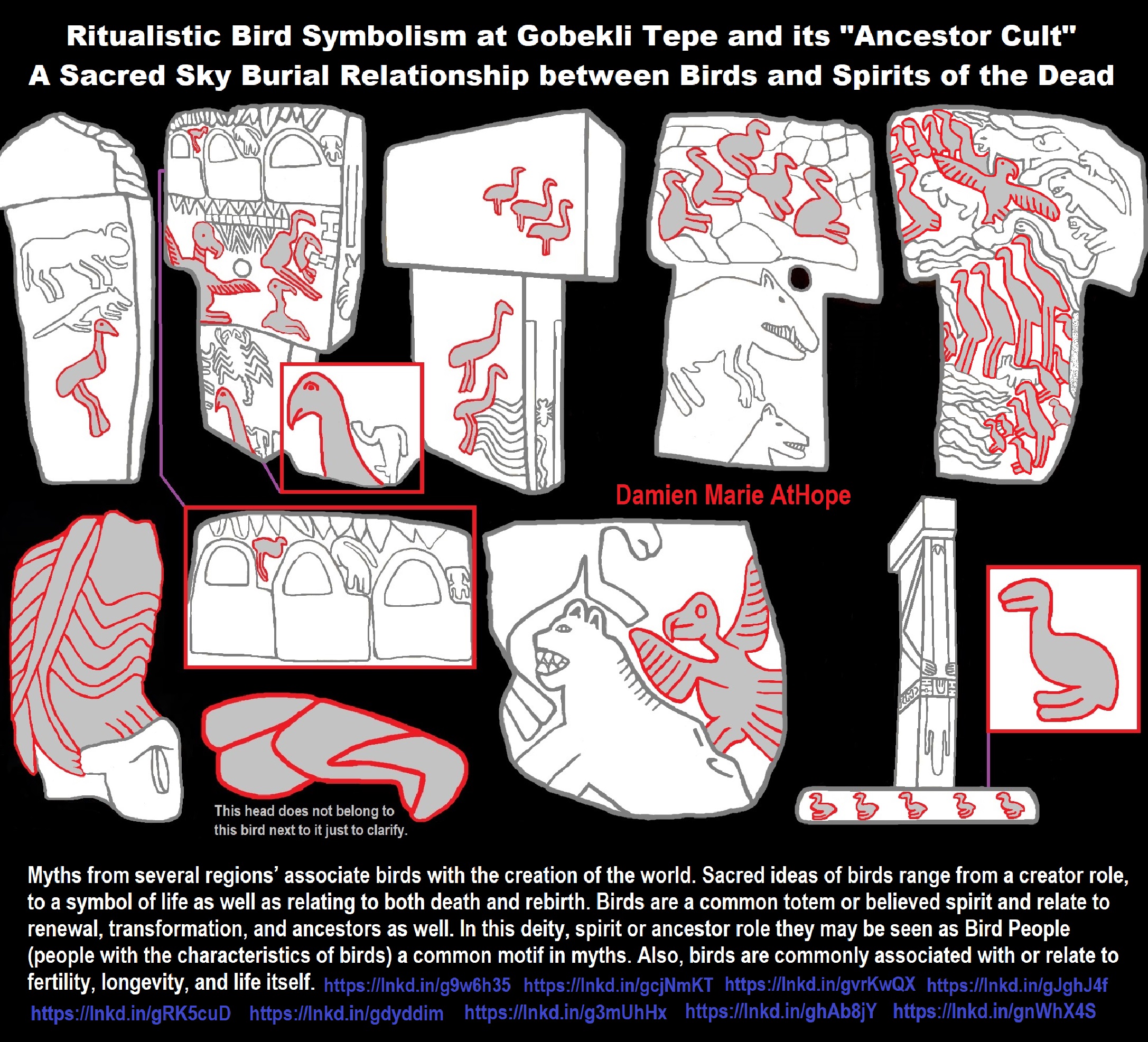
ref, ref, ref, ref, ref, ref, ref, ref, ref, ref, ref, ref, ref, ref, ref, ref, ref
Göbekli Tepe 12,000 years old T-shaped Pillars are not Alone (not Ancient Aliens)
“The large pillars are so far only known from Göbekli Tepe. This may change over time however, as there now are several sites that show smaller pillars, resembling those of Göbekli Tepe´s younger layer. T-shaped pillars resembling the smaller examples from Göbekli Tepe’s Layer II were first recorded at the settlement site of Nevalı Çori. Several more sites in the near vicinity of Göbekli – Sefer Tepe, Karahan, and Hamzan Tepe – are known to have similar pillars, but no excavation work has been carried out so far. With the Neolithic site of Urfa-Yeni Yol, which seems to have revealed a small T-shaped pillar in the course of construction work in that area, with Taşlı Tepe, and with Gusir Höyük three more related sites were added to this list recently. A further addition to the sites with T-shapes is the so-called Kilisik statue, that closely resembles the general pillar form but has more naturalistic features [find a text by Marc Verhoeven on this find here – external link].” ref
“While most sites concentrate in a rather small radius around Göbekli Tepe, Gusir Höyük in the Turkish Tigris region [more information – external link] has considerably widened the distribution area of circular enclosures, however the pillars discovered there are slightly differently shaped – they seem to be missing the bar of the T. Similar stelae have been discovered in Cayönü and Qermez Dere. As only Gusir Höyük has been excavated, nobody can tell at the moment what the other sites might hide.” ref
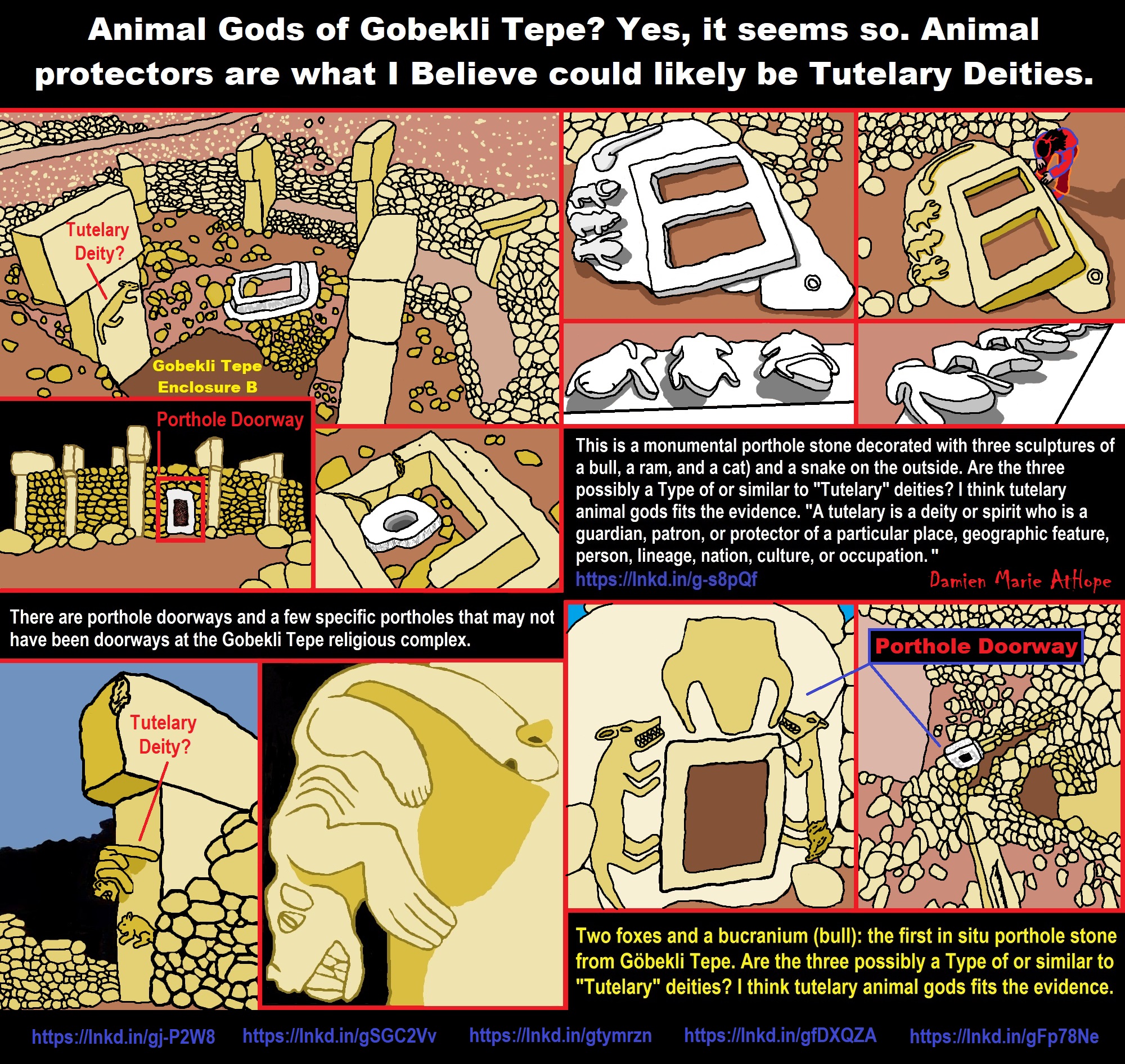
Tutelary deity
“A tutelary (also tutelar) is a deity or spirit who is a guardian, patron, or protector of a particular place, geographic feature, person, lineage, nation, culture, or occupation. The etymology of “tutelary” expresses the concept of safety and thus of guardianship. In late Greek and Roman religion, one type of tutelary deity, the genius, functions as the personal deity or daimon of an individual from birth to death. Another form of personal tutelary spirit is the familiar spirit of European folklore.” ref
“A tutelary (also tutelar) in Korean shamanism, jangseung and sotdae were placed at the edge of villages to frighten off demons. They were also worshiped as deities. Seonangshin is the patron deity of the village in Korean tradition and was believed to embody the Seonangdang. In Philippine animism, Diwata or Lambana are deities or spirits that inhabit sacred places like mountains and mounds and serve as guardians. Such as: Maria Makiling is the deity who guards Mt. Makiling and Maria Cacao and Maria Sinukuan. In Shinto, the spirits, or kami, which give life to human bodies come from nature and return to it after death. Ancestors are therefore themselves tutelaries to be worshiped. And similarly, Native American beliefs such as Tonás, tutelary animal spirit among the Zapotec and Totems, familial or clan spirits among the Ojibwe, can be animals.” ref
“A tutelary (also tutelar) in Austronesian beliefs such as: Atua (gods and spirits of the Polynesian peoples such as the Māori or the Hawaiians), Hanitu (Bunun of Taiwan‘s term for spirit), Hyang (Kawi, Sundanese, Javanese, and Balinese Supreme Being, in ancient Java and Bali mythology and this spiritual entity, can be either divine or ancestral), Kaitiaki (New Zealand Māori term used for the concept of guardianship, for the sky, the sea, and the land), Kawas (mythology) (divided into 6 groups: gods, ancestors, souls of the living, spirits of living things, spirits of lifeless objects, and ghosts), Tiki (Māori mythology, Tiki is the first man created by either Tūmatauenga or Tāne and represents deified ancestors found in most Polynesian cultures). ” ref, ref, ref, ref, ref, ref, ref
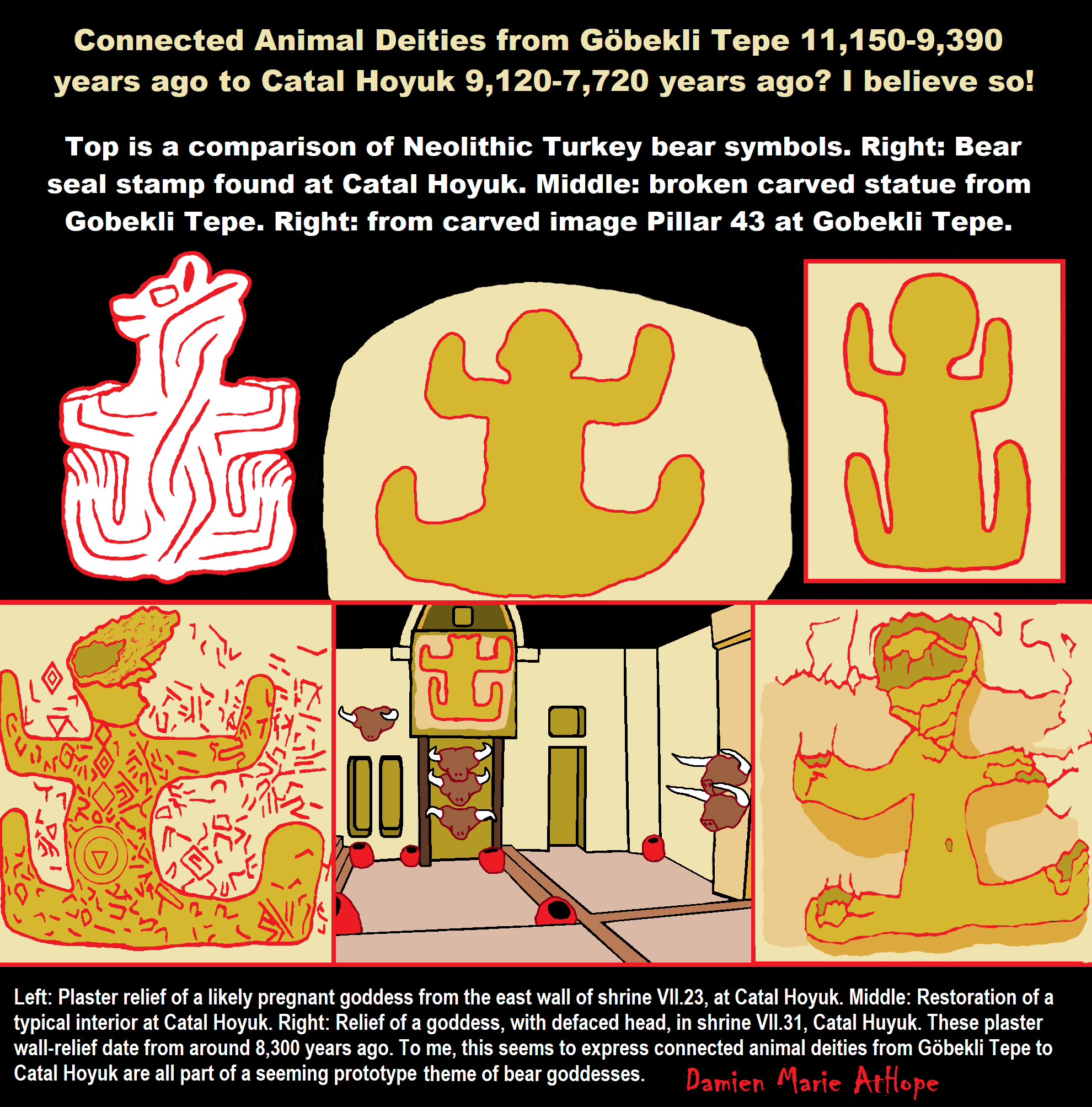
Pictures link, link, link, link, link, link, link, link
“At Göbekli Tepe, was found a monumental porthole stone from the northwestern hilltop areas. Several such stones with a central opening are known from the site, and they could have played a role as entrances to the enclosures or other buildings. One of them lies approximately in the center of Enclosure B and gives some reason to think about an entrance through a possible roof for that building. However, this new porthole stone from the northwestern areas was completely different, and that not only regarding its enormous measurements. First, unlike all examples found before, it has two openings. Second, it is richly decorated with three sculptures of quadrupeds (bull, ram, and a wildcat) and a snake in high relief, as well as a row of cup holes. Unfortunately, the stone was not in situ, that is, not in its original architectonic context. But the decorations clearly show that it must have been part of an important building whose entrance had to be guarded accordingly.” ref
“The megalith pillars themselves, 43 of which have been unearthed so far, are mainly T-shaped pillars of soft limestone up to around 16 feet in height and were excavated and transported from a stone quarry on the lower southwestern slope of the hill. Geophysical surveys on the hill indicate that there are as many as 250 more megaliths lying buried around the site, suggesting that another 16 complexes once existed at Göbekli Tepe. Although some of the standing stones at Göbekli Tepe are blank, others display extraordinary artwork in the form of elaborately carved foxes, lions, bulls, scorpions, snakes, wild boars, vultures, waterfowl, insects, and arachnids. Although the pictograms at Göbekli Tepe do not represent a form of writing, they may have functioned as sacred prewriting symbols whose meanings were implicitly understood by local populations at the time.” ref
“The many animals depicted include foxes, birds, lions, scorpions, snakes, and boars. There is a scorpion the size of a small suitcase, and a jackal-like creature with an exposed rib cage. The exact meanings of the carvings appear to be unknown. On one pillar a row of lumpy, eyeless “ducks” float above a boar, with an erect penis. Another relief consists of the simple contour of a fox also with a distinct penis. Most mammals represented at Göbekli Tepe are visibly male, except for one fox, which, in place of a penis, has several snakes coming out of its abdomen. Perhaps the most debated composition portrays a vulture carrying a round object on one wing; below its feet, a headless male torso displays yet another erect penis.” ref
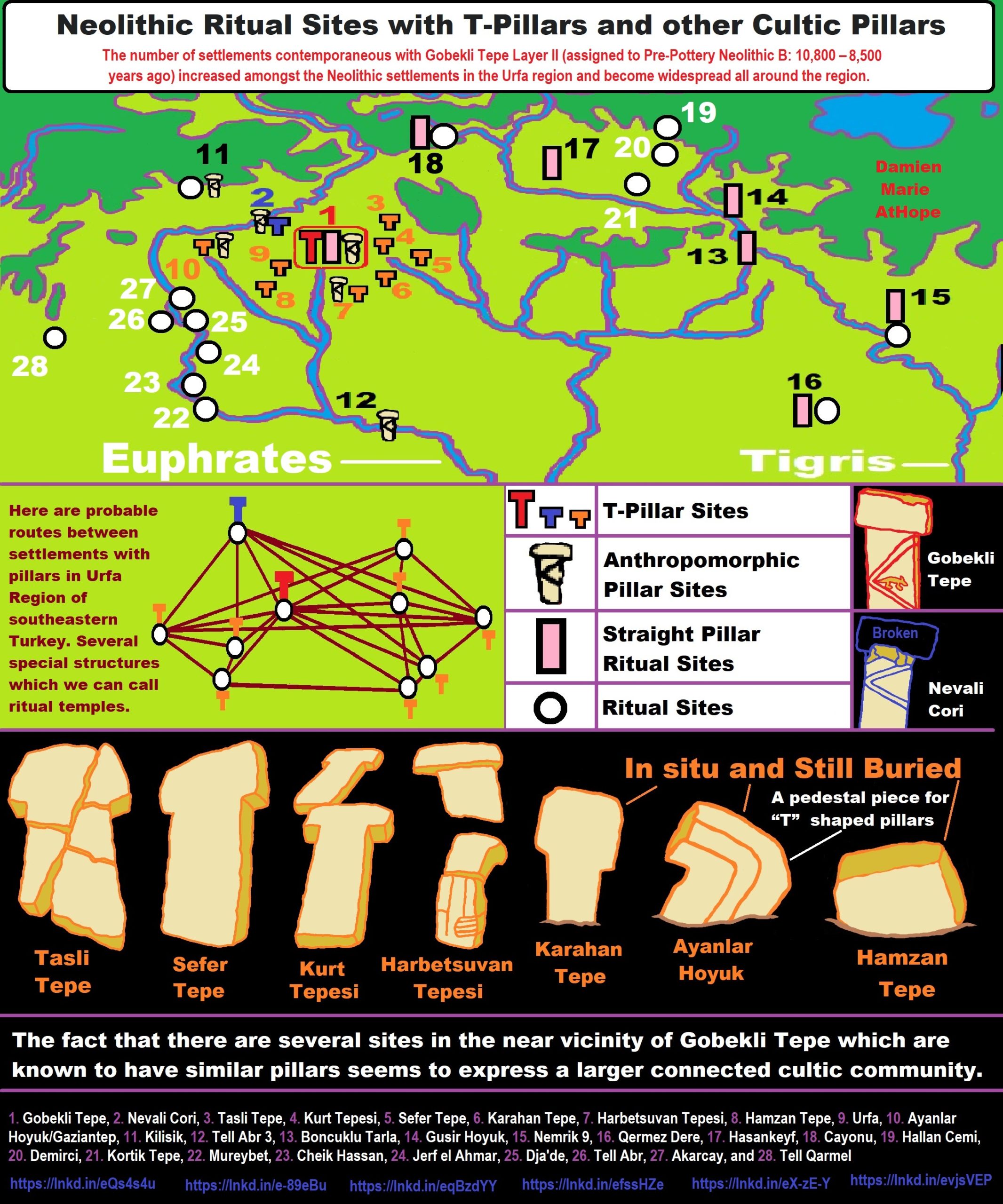
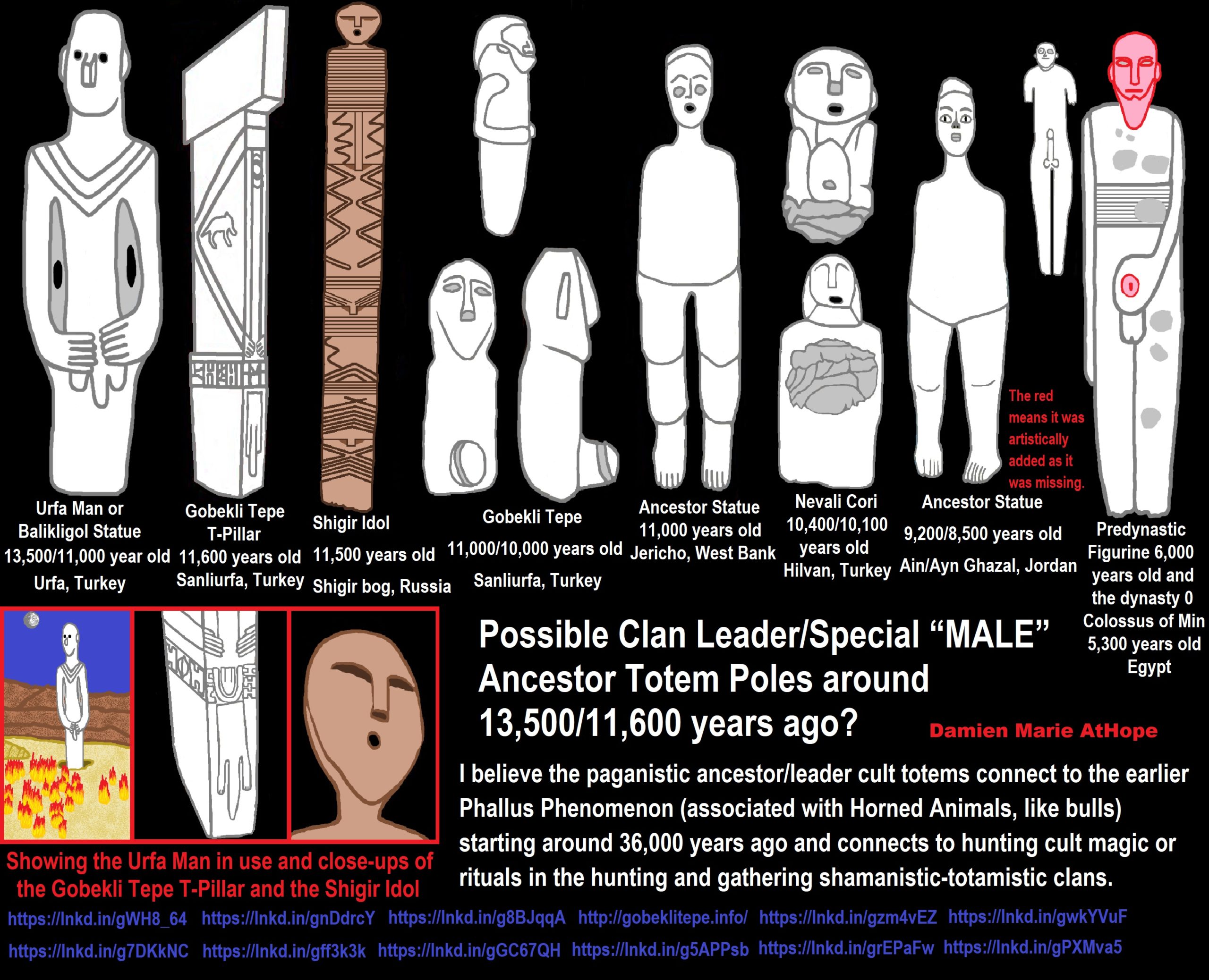
ref, ref, ref, ref, ref, ref, ref, ref, ref, ref, ref, ref, ref
I believe the paganistic ancestor/leader cult totems connect to the earlier Phallus Phenomenon (associated with Horned Animals, like bulls) starting around 36,000 years ago and connects to hunting cult magic or rituals in the hunting and gathering shamanistic-totamistic clans.
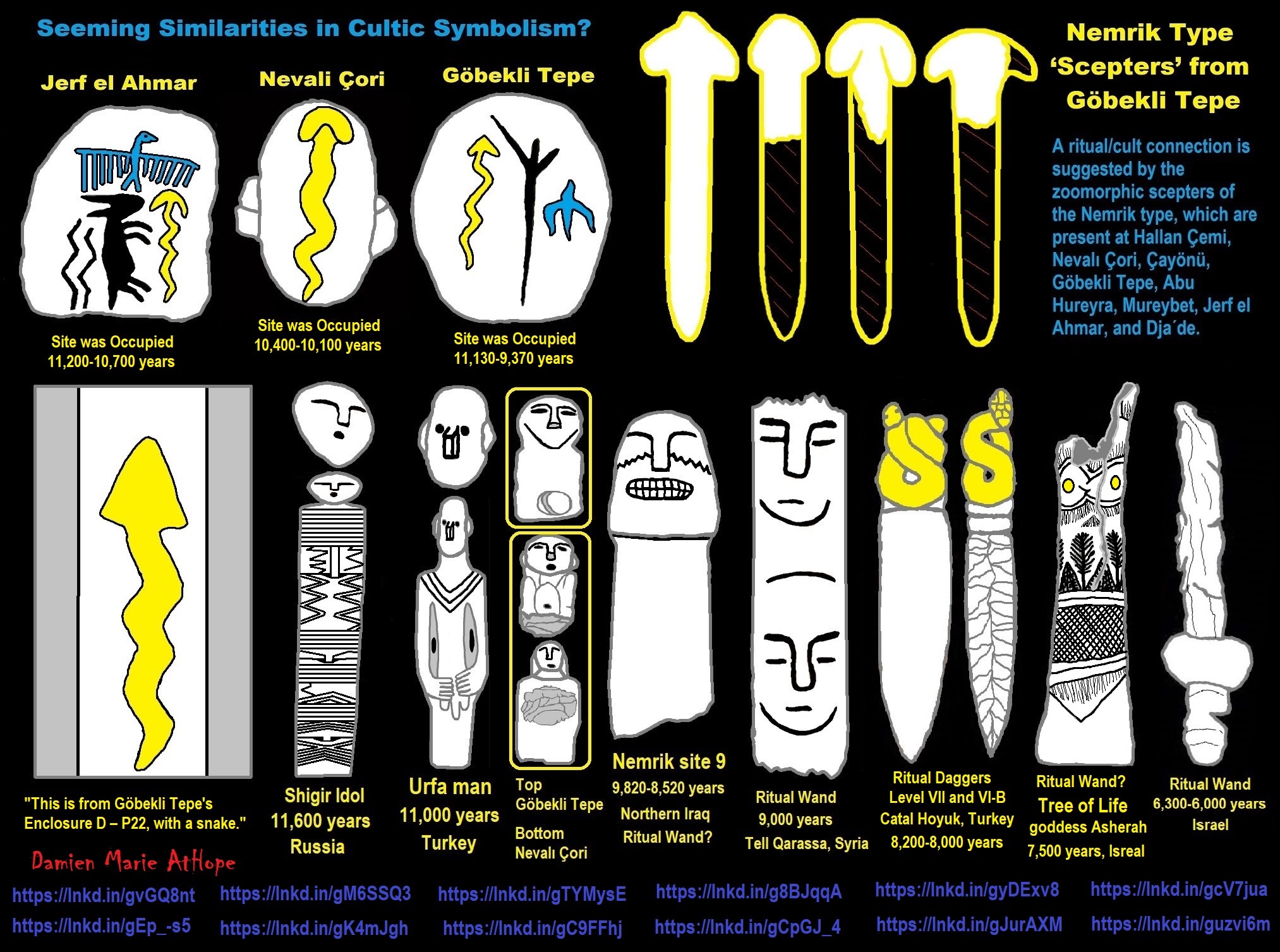
ref, ref, ref, ref, ref, ref, ref, ref, ref, ref, ref, ref
The earliest swastika ever found was uncovered in Mezine, Ukraine, carved on an ivory figurine, which dates an incredible 12,000 years, and one of the earliest cultures that are known to have used the Swastika was a Neolithic culture in Southern Europe, in the area that is now Serbia, Croatia, Bosnia and Herzegovina, known as the Vinca Culture, which dates back around 8,000 years. In Nordic Myths , Odin is represented passing through space as a whirling disk or swastika looking down through all worlds. In North America, the swastika was used by the Navajos. It has been used by the Phoenicians as a symbol of the Sun and it was a sacred symbol used by the priestesses. Hinduism, the right-hand swastika is a symbol of the God Vishnu and the Sun, while the left-hand swastika is a symbol of Kali and Magic. The double meaning of symbols is common in ancient traditions, like for example the symbol of the pentagram (five pointed star), which is viewed as negative when pointing downwards, and positive when pointing upwards. ref
In Bronze Age Europe, the “Sun cross” appears most frequently of all continents, often interpreted as a solar symbol. Swastika shapes have been found on numerous artifacts from Iron Age Europe (Greco-Roman, Illyrian, Etruscan, Baltic, Celtic, Germanic, Slavic and Georgian Borjgali).This prehistoric use seems to be reflected in the appearance of the symbol in various folk cultures of Europe. The symbol has been found on vessels in the ancient city of Troy, The evidence shows that it served as a symbol of fertility and life. Its similar use can be found in Trench Graves in Mycanae, Greece, on Athenian vases and even decorating the garments of Aphrodite, the Greek goddess of love. Also the Greek Parthenon had this symbol as a Greek design just like other designs. Swastika is a definite European sign moving east into Indus Valley Civilization. It was brought by migrating tribes to India where it is revered in the religious and cultural life of the Indo-Aryans. It did not originate in the Indus Valley Civilization as some people thought. ref
Azilian Culture of the Epipaleolithic in Northern Spain and Southern France following the Magdalenian Culture who themselves are descendants of the Aurignacian and not from the Gravettian. The end of the Ice Age (11,000-10,000 years ago). French Pyrenes and other European areas produce puzzling designs and decorations on pebbles. A recent analysis indicates that the decorations are not random and may represent some sort of notation. ref
Armenian Petroglyphs from 9,000-3,000 BC
“Cave Writing from Lake Sevan. Before hieroglyphic writing was developed between 900 and 700 BC, the inhabitants of the Armenian Highlands expressed themselves by carving and painting on the rocks. These three pictograms were completed between the 8th and 4th millennia BC (from 9,000 to 3,000 BC). According to archaeologists, the drawings are associated with Neolithic cultures, especially in the higher mountain regions, including Aragats, Armaghan, and the Lake Sevan basin.” – Art-A-Tsolum
“Before hieroglyphic writing was developed, between 9000 and 7000 BCE, people of the Armenian region expressed themselves by carving and painting designs on rocks. These three pictographs (see “source link) were executed between the 8th and 4th millenia BCE, (9000 to 3000 BCE). According to archaelogists, the drawings are associated with Neolithic cultures, especially in the higher mountain regions (Aragats and Aghmaghan and the basin of Lake Sevan). Around 3000 B.C.E., the Proto-Indo-European family of languages was probably closely unified, but by 2000 B.C.E., Greek and two extinct languages, Hittite and Sanskrit, were distinct languages. Though changes in grammar and meaning have taken place, analysis of vocabulary indicates that the people of the ancient Indo-European culture were metal-using farmers tending domestic animals. Recent discoveries suggest links to the Kurgan people, who lived on the steppes west of the Ural Mountains. In the Kingdom of Van, 810 BCE, inscriptions of economic and sacrificial nature were written in hieroglyphics. Specimens of Armenian hieroglyphics are also evident in Urartean excavations at Karmir-Blur, where pottery, bronze cups and cylinder seals were found. This type of writing was used by peoples living on the Ararat Plain, even before the penetration of the Urartian tribes, according to excavations at Cholagerd.” The Evolution of the Armenian Alphabet – Armenian Highlands
“Experts on Indo-European languages agree that the Proto-Indo-European divisions took place 4000 years BC into separate branches that pursued independent paths of linguistic evolution. Similarly, around 3500 BC, the Proto-Armenian tribes — whether European in origin (the Thraco-Phyrigian theory firmly held by Western scholars,) or Asian (Aryan/Indigenous/Asian) — developed an economic structure in the geographical space that became to be known as the Armenian plateau, based on agriculture, metal working and animal husbandry. Recent archeological evidence in Armenia confirms several agreements between this civilization and Indo-European culture. It is almost a certainty to presume that this led to the creation of a distinct identity and culture that was separate from the other human groupings in Asia Minor and Upper Mesopotamia. Within this context, Armenian, with an uninterrupted evolution through time and geographical space, continued to evolve and be enriched by neighboring cultures, as attested by the loan words, and, after the alphabetization of the languages, to be further enhanced by exchanges with distant cultures. Consequently, it is safe to assume that the Armenian language in its current expression has a history of approximately 6000 years.” The Evolution of the Armenian Alphabet – Armenian Highlands
“Ughtasar Petroglyphs are petroglyphs found on Ughtasar mountain near the town of Sisian in Armenia‘s southern province of Syunik. There are dozens of rock carvings, known as “Itsagir”, found in the territory of Armenia. Reproductions of the petroglyphs, or rock engravings, of Ughtasar can be found all over Yerevan; they are inscribed onto silver jewelry, painted onto coffee cups, traced into hand-made pottery, and they adorn the walls of cafes. However reaching the actual petroglyphs of Ughtasar (“ught” meaning camel and “sar” meaning mountain, due to the resemblance of its peaks to the humps of a camel) can be challenging, as with most of Armenia’s noteworthy sites. Located in the Syunik mountain range about 20 miles from Sisian in southern Armenia, the petroglyphs can only be accessed by an uphill climb in a Soviet-era 4×4 UAZ.” Ughtasar Petroglyphs – Wikipedia
“Over 2,000 decorated rock fragments extend to the foot of the mountain. The petroglyphs, some believed to date back to the Paleolithic Era (12,000 BCE), are carved onto dark brownish-black volcanic stones left behind by an extinct volcano. Although the site was discovered in the early 20th century, it was not really studied until the 1920s and again in the late 1960s; it is still not fully understood today.
The carvings on the rock fragments depict hunting scenes, a wide array of animals, spirals, circles and geometric shapes, and even zodiac signs. Research suggests that the area served as a temporary dwelling for nomadic cattle-herding tribes, and studies of the rock carvings indicate that they were in use for hundreds of years, with peoples of later eras adding their ownengravings to the stones. According to the research of Hamlet Martirosyan, the pictograms of Ughtasar represent a writing system called “goat writing”. Many scholars believe that this was due to the large number of goats drawn on the stones, but according to Martirosyan it is because in the ancient Armenian language, the words “goat” and “writing” were homonyms. They would use these homonyms to express concepts through pictures, thus the abstract concept of “writing” (which in ancient Armenian can be expressed with words like “shar” – arrange, “sarel” – compile, “tsir” – a line) found its reflection in the representation of a goat (“zar”), because the words for “writing” and “goat” sounded the same. Goats are a prevalent theme on the stones, possibly because the word “dig” in ancient Armenian meant goat and was close enough to “diq,” the ancient word for gods. By combining abstract signs with the images of animals and people in horizontal or vertical rows, prehistoric engravers were able to convey specific messages.” Ughtasar Petroglyphs – Wikipedia
Jewish People with DNA at least 13,200 years old, Judaism, and the Origins of Some of its Ideas
“The people closest to the Jews from a genetic point of view may be the Kurds than between the Jews and their Arab neighbors., according to results of a new study at the Hebrew University. The research said the findings seem to indicate both peoples had common ancestors who lived in the northern half of the fertile crescent, where northern Iraq and Turkey are today. Some of them, it is assumed, wandered south in pre-historic times and settled on the eastern shores of the Mediterranean. The researchers used the DNA of 1,847 Jewish men of Ashkenazi, Sephardi and Kurdish descent; Muslims and Christians of Kurdish, Turkish and Armenian descent; various Arab populations; and Russians, Poles and residents of Belarus.” –Haaretz.
“A previous study, showed that about 70 percent of Jewish paternal ancestries and about 82 percent of Palestinian Arabs share the same chromosomal pool. With their closer relationship to Jews, the Palestinian Arabs are distinctive from other Arab groups, such as Syrians, Lebanese, Saudis, and Iraqis, who have less of a connection to Jews. And a genetic connection between Arabs (especially Syrians and Palestinians) and Jews, but had not tested Kurds, so it was less complete. Genetic marker from the northern Middle East which is not unique to Jews. However, its existence among many Kurds and Armenians, as well as some Italians and Hungarians, would seem to support the overall contention that Kurds and Armenians are the close relatives of modern Jews and that the majority of today’s Jews have paternal ancestry from the northeastern Mediterranean region.” – Free Republic
G1-M342, formed 26.000 years ago, TMRCA 18,600 years ago, has its highest concentrations in Iran, most are in the Near East, South Asia, Central Asia, and East Asia.
G1a-CTS11562, formed 18600 years ago, TMRCA 14800 years ago.
G1a1-BY1124/GG353.
G1a1a-Z3353, arose 14,600 years ago .
G1a1a1-L1324, formed 13.200 years ago and is found among Ashkenazi Jews, Bulgarians, Kazakhs, Mongols, Kuwaitis.
G1a1a2-GG362/Z3189, arose 13.200 years ago Slovakia, Germany, Turkey, India (Gujaratis), n.e. Europe (Ashkenazi Jews), Kazakhs, Argyn, Iran, Arabia.
G1a1a1a1-L201, Ashkenazi Jews of Europa, Arose probably 5,000 years ago.
G1a1a1a1a~FGC39025, Ashkenazi Jews of Europa, Arose probably 5,000 years ago.
G1a1a1a1b-Z45735, Ashkenazi Jews of Europa, Arose probably 5,000 years ago.
G1b1a-Z18606, Ashkenazi Jews of Europa, 5.000 years ago.
Archaeology Disproves the-bible
It starts with provable lies why trust it? Where did the Jewish people come from genetically helps deconstruct the bible falsehoods more accurately? The Bible having a some random unamazingly facts start after the time of the claimed King David before that we enter the complete fantasy portion of the bible so yes the entire beginning of the bible is mythical, not historical and that removes original sin as that shit never happened, neither did a fluid nor any Exodus or a mountain with any ten commandments. All the beginning stories of the bible are discredited. DNA shows that sometime around 4,000 years ago, the Kurds and the Ashkenazi Jews shared a common ancestor who lived in the Lake Van region (mount Ararat: Turkey). About 80% of modern Jews have Ashkenazi ancestry, according to the Hebrew University of Jerusalem. Albert Einstein was an Ashkenazi Jew, as were Gertrude Stein and Carl Sagan. Steven Spielberg and Scarlett Johansson are also Ashkenazi Jews, along with three current members of the U.S. Supreme Court (Ruth Bader Ginsburg, Stephen Breyer and Elena Kagan) when ancient people split off from the ancestors of today’s Middle Easterners more than 20,000 years ago, with a founding group of about 3,500 to 3,900 people, according to the study. The founding they are referring to is Jews were found to be more closely related to groups in the north of the Fertile Crescent (Kurds, Turks, and Armenians: think of the ancestor in Turkey) than to their Arab neighbors. Ref, Ref
So, if we have errors in the bible then is it lies? Or something else inaccurate, thus an unreliable source for the seemingly “historical tangible facts how could one be certain of the claims of supernatural magic that are not tangible as what is offered as presumably facts are clearly not true? And as for the few things that are known mainly are after the time of the reported king David, but don’t be confused this bible is impregnated with errors and contradictions that should cause any honest thinker to question such an unreliable source (myth sprinkled with truths add in the myths believability through familiar references to its original audience) has added some things as is common in history produced mythic propaganda.
The Art of Writing
Strange markings on a hillside curiously match the eloquent letters on parchment. The graceful arch of vowels and consonants devised in the 4th century CE are echoed in carvings showing the sun, moon, and the exact locations of constellations from the zodiac. Our guide smiles, and astonishingly covers 20,000 years of writing in a single sentence, “From stone to paper, you can find the curve of our people in a single path. Most people think the Armenian letters began with Mashtots in 406 CE.” The Evolution of the Armenian Alphabet – Armenian Highlands
But look here, and you will find a divine inspiration 19,000 years before then.” Beginning from astral symbols found on the Geghama Lehr (Mountain Range) between Sevan and the Ararat Plain, including the signs of the Zodiac and star positions at Karahundj and Metsamor; to Vishaps, obelisks covered with cuneiform and pictograms, the Armenian language has its roots. From the heart of Noah to the furthest stretches of Mesopotamia, India and Europe, it spread to encompass most of the Old World. The guide points to controversy and historical fact, to scientific research and popular myth as he gathers energy with his argument. “The glories of manuscript art have their ancestors, just as we do and if you want to believe that the center of language and culture came from this part of the world, then you can’t also believe the Armenian’s were illiterate at the same time. There is a source, and it came before the Mashtots Script.“The Evolution of the Armenian Alphabet – Armenian Highlands
Beyond stone carvings (called “pictograms”, since they represented ideas through pictures, as opposed to an alphabet, which captures sounds and is used to create words and sentences to express ideas), there is very little to suggest what a native language was like in Armenia between the Paleolithic and Urartian periods. Detailed maps showing ancient fortified towns and roads that exist to this day are scrawled on the sides of stone foundations, as are complex trigonometry and geometric formulas pointing to astral, solar and lunar phases. The inscriptions even include one of the first calendars and compasses ever created. The Metsamorians and their ancestors were the earliest known civilization to forge copper, bronze and iron, they created a pantheon of gods that foreshadow the Greek pantheon. Having one of the greatest cultures of the Bronze Age (the “Metsamor Kingdom”), Ancestral Armenians curiously left no written words behind. ” The Evolution of the Armenian Alphabet – Armenian Highlands
Emma Khanzatian, director of excavations at Metsamor, and the Grande Dame of archeology in Armenia, does not find a missing language all that curious.
“It is impossible to have a culture this advanced with no written language,” Ms. Khanzatian says. “Just impossible. They were among the leaders in the known world at that time in science, industry and trade. Metsamor era artifacts are found in Egypt, Syria, Persia, India and Central Asia. Their distinct black and geometric pottery made its way to Mycenae, they may even have created the wheel. They knew trigonometry, astronomy and geomtetry–you can have none of these sciences without notation, the forms of writing. How could they leave nothing in writing behind?” The Evolution of the Armenian Alphabet – Armenian Highlands
Part of how is shown by several strata of excavations at Metsamor and other ancient cities. Black, charred earth, pottery and skeletons lie in heaps in several layers from the middle Bronze and early Iron Age. Sieges and burnt earth policy began far before recent memory. If anything like parchment was created along with spectacular bronze and gold objects uncovered at Metsamor, AdaBlur, Jerahovit and MokhraBlur, it was surely burned along with the population. More recent layers of excavation show continued sieges and burning in the common era, including a 4th century layer that was a result of struggle between Pagan and Christian armies. It is not until the Urartian period (ca. 1300-550 BC) that a written language has been found and that was borrowed from Sumerians and Assyrians. Stone was the preferred medium of expression, though there is some proof that wood and leather parchment were used along with clay tablets in Mesopotamia and Egypt. But other than signs of zodiac, maps and geometric equations, no signs of writing from the Metsamor period have been uncovered.” The Evolution of the Armenian Alphabet – Armenian Highlands
“Khanzatian smiles and nods her head towards a central mound at Metsamor. “We haven’t begun to uncover what lies beneath this ground. And just think what must be under a city as old as Jerahovit or Aigeshat. Just because we haven’t found it doesn’t mean it isn’t there.” A wizened face carved from years of excavating the windswept earth on the Ararat plain laughs and points to the central mound. “And somewhere under the main citadel lies a treasure as important as any gold artifact the archive.” The Evolution of the Armenian Alphabet – Armenian Highlands

ref, ref, ref, ref, ref, ref, ref, ref, ref, ref, ref
Star Carr dating to around 10,770 – 10,460 year held an early proto-writing pendant. It is very similar to a number of other pendants from northern European sites, though its unique due to it being made from shale, where others are commonly made of amber. Research suggests two phases of markings on the pendant and possibly more than one artist. The markings may represent a tree, a map, a leaf, tally marks, even a wooden platform, which are found at Star Carr. ref, ref, ref


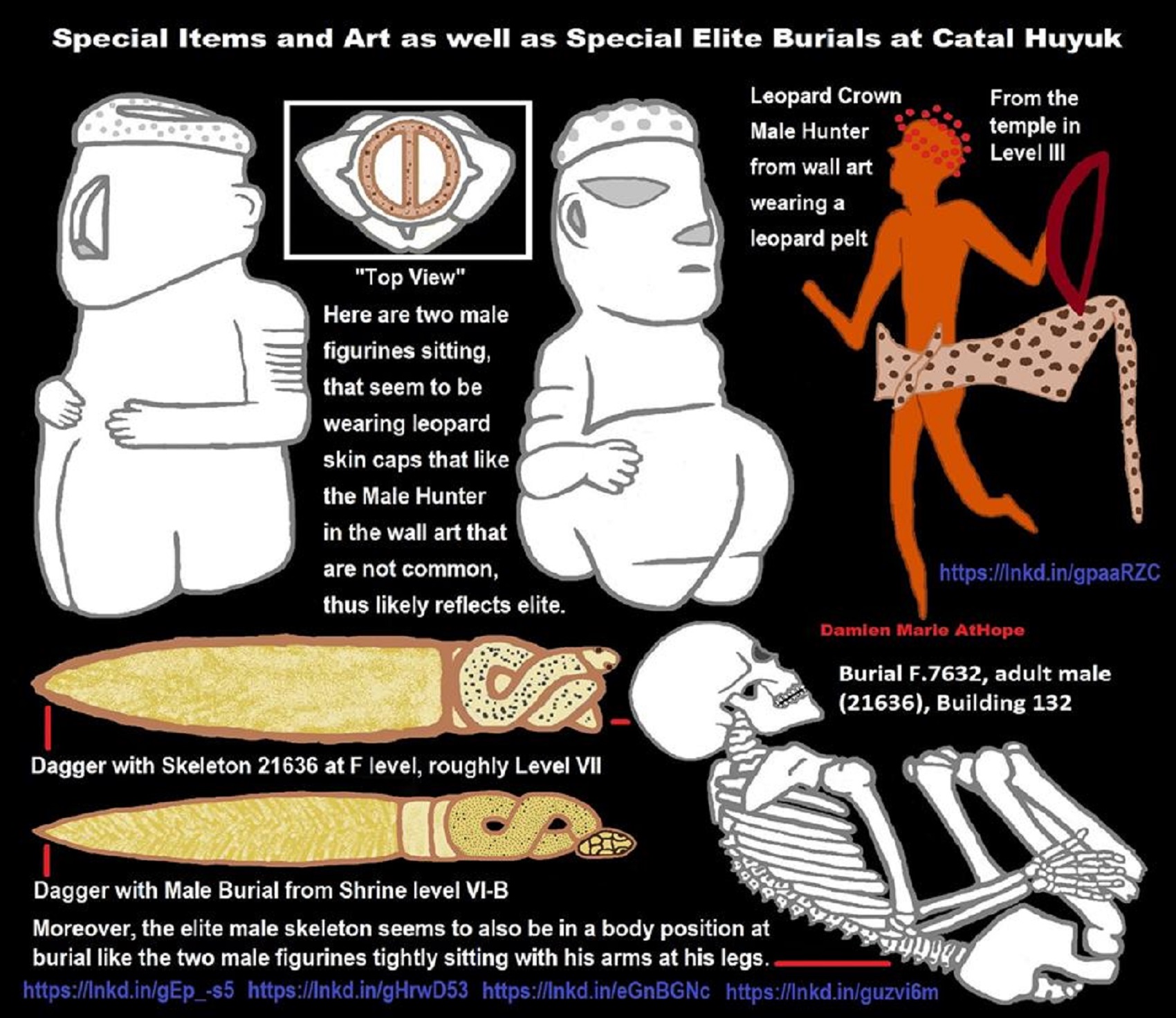
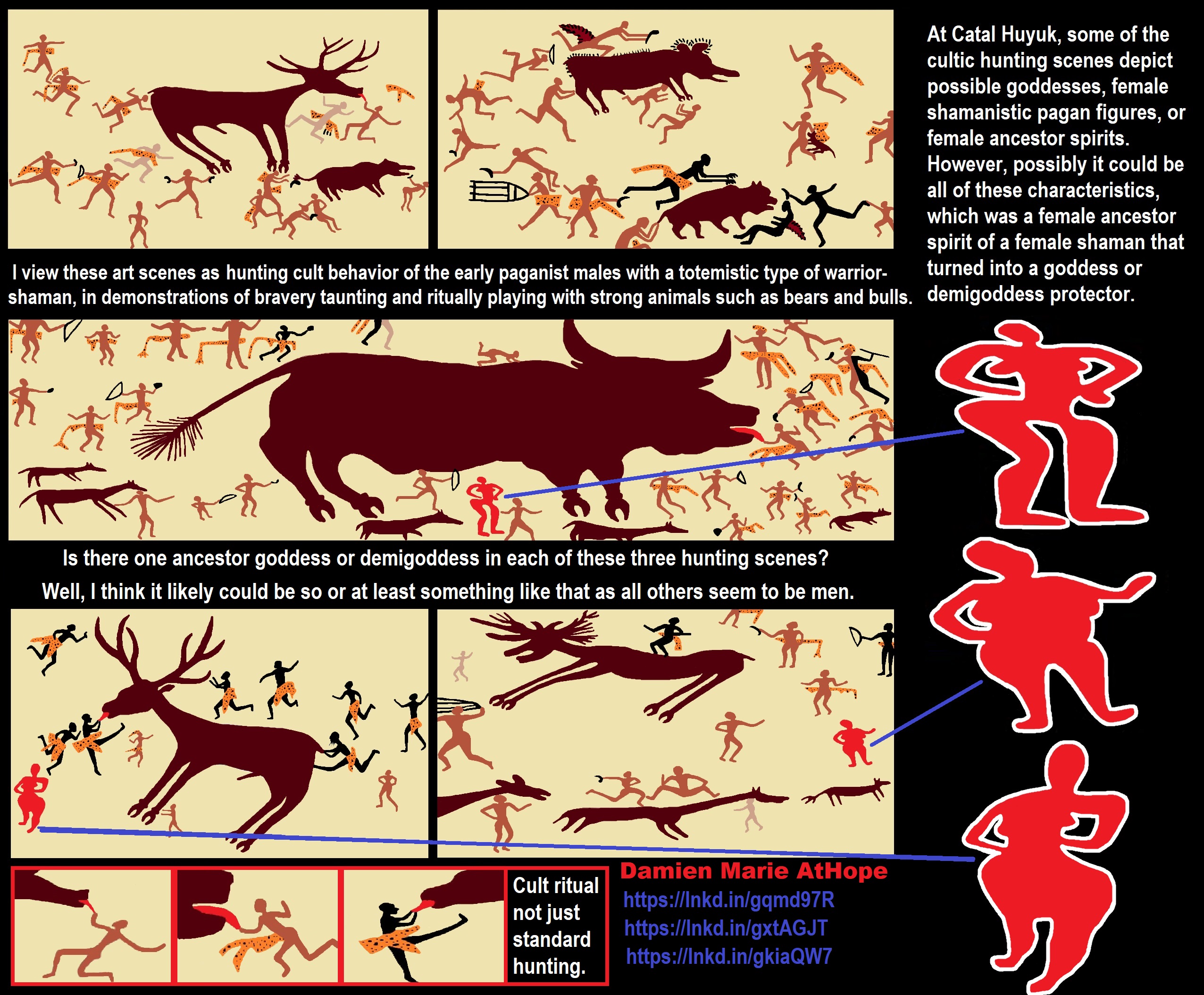

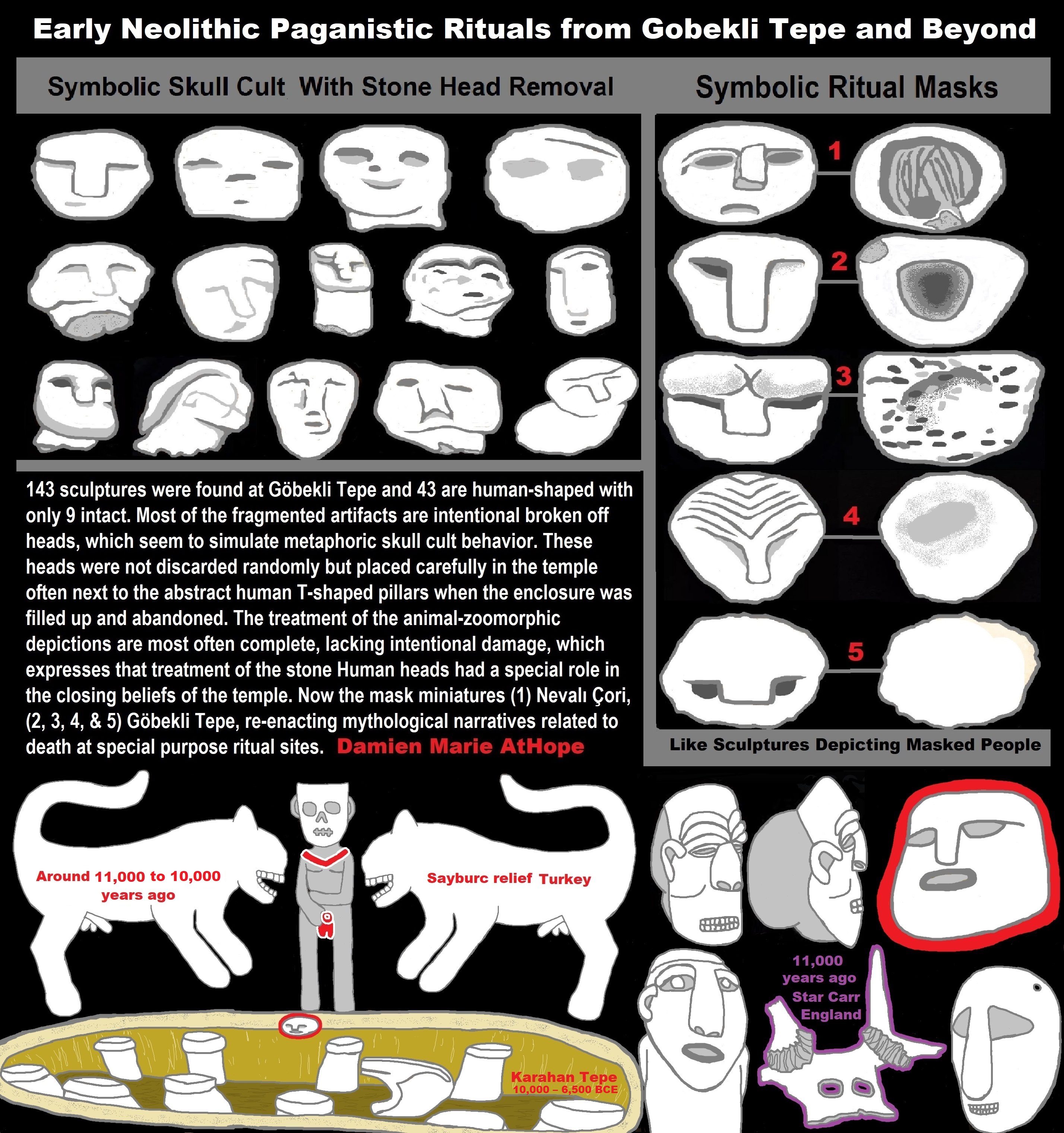
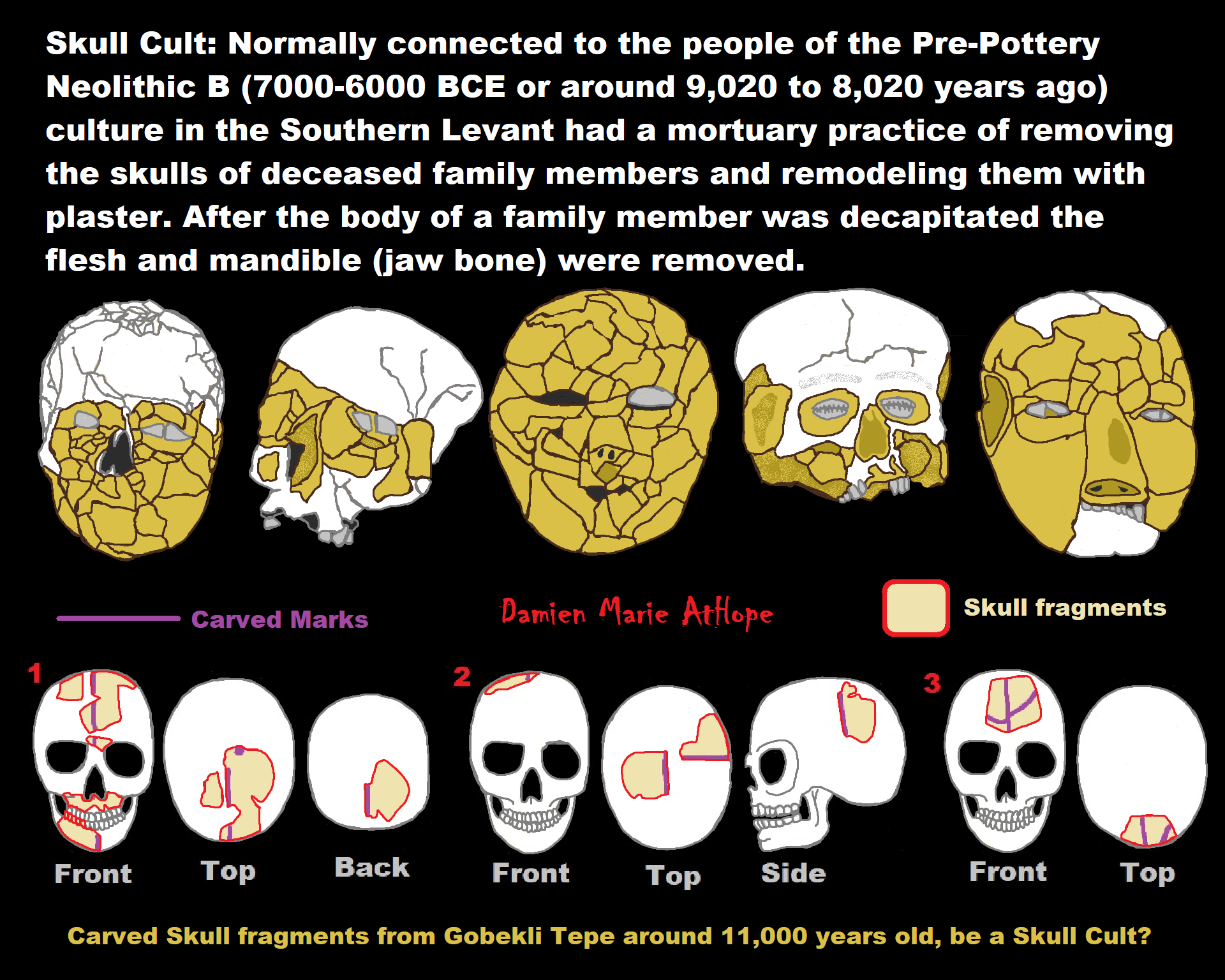
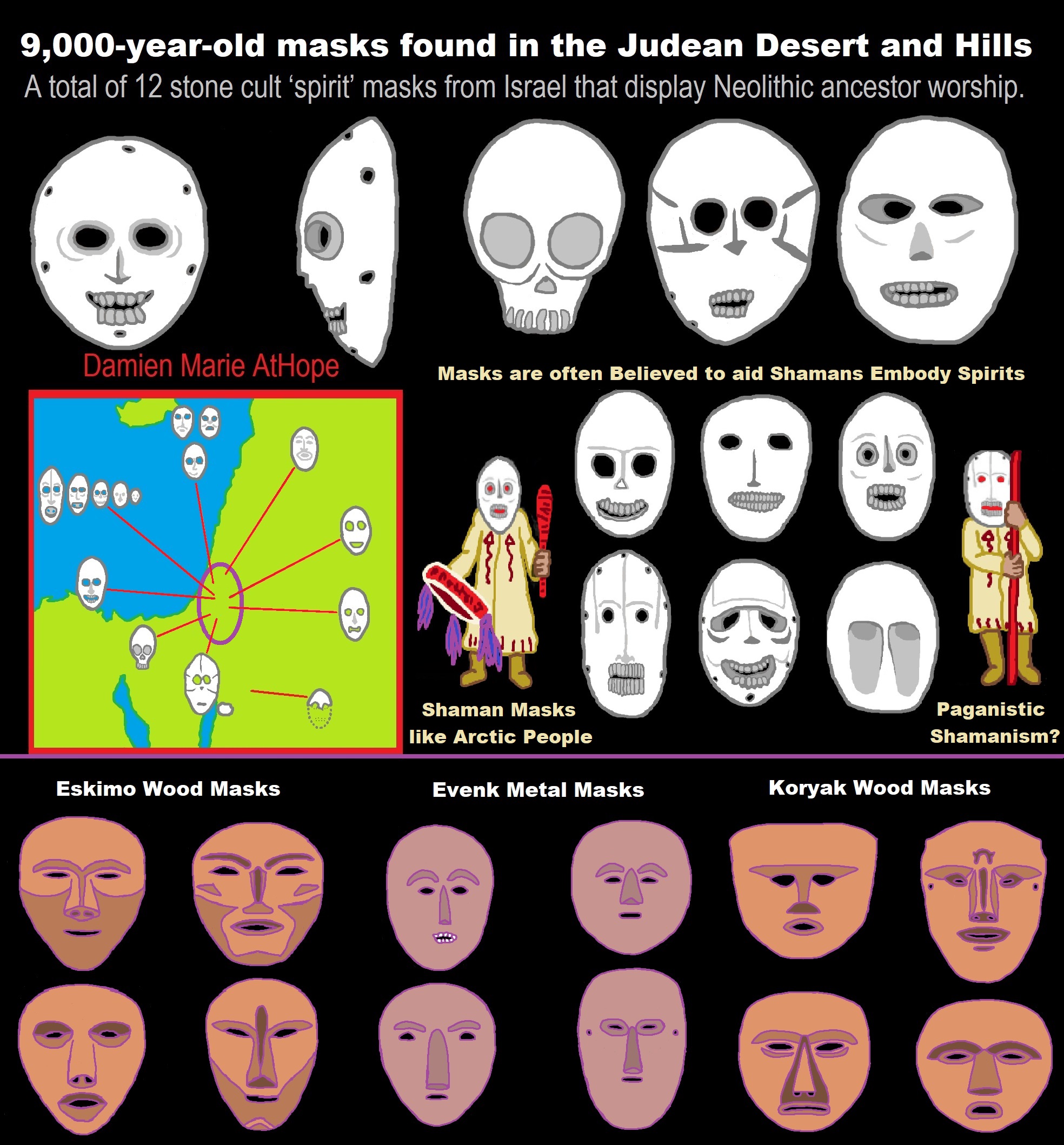

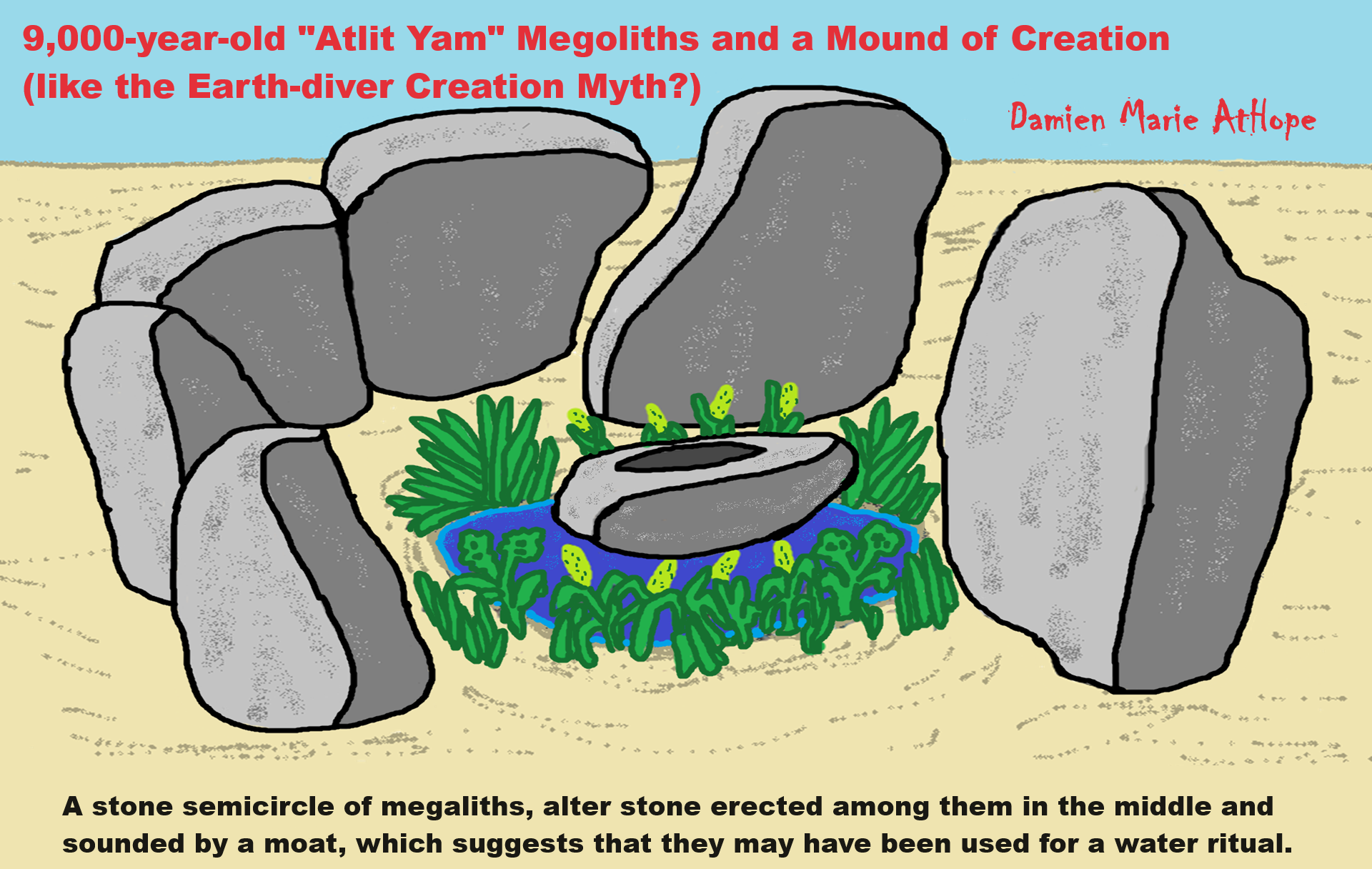
9,000-year-old “Atlit Yam” Megoliths and a Mound of Creation (like the Earth-diver Creation Myth?) A stone semicircle of megaliths, alter stone erected among them in the middle and sounded by a moat, which suggests that they may have been used for a water ritual.
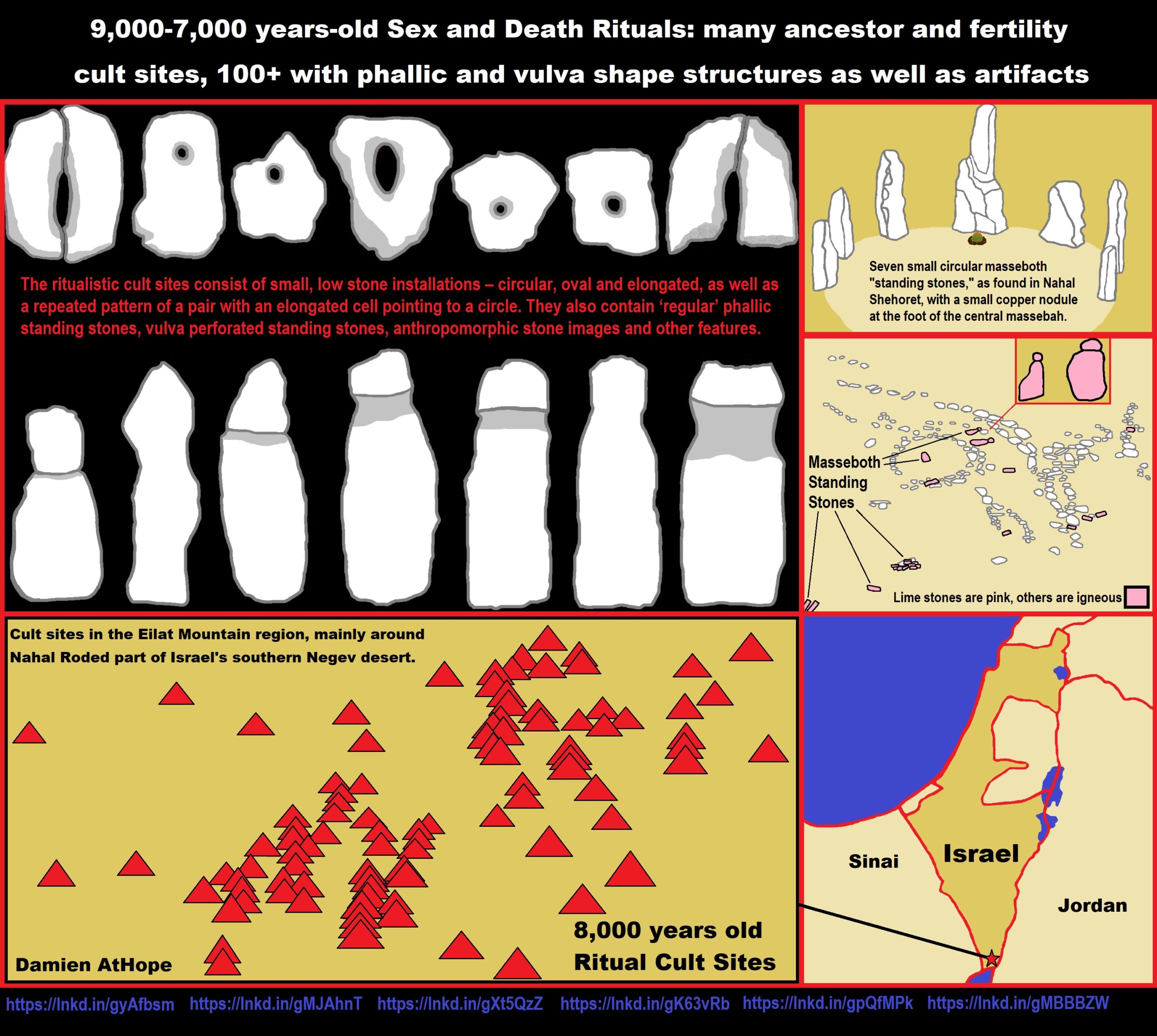
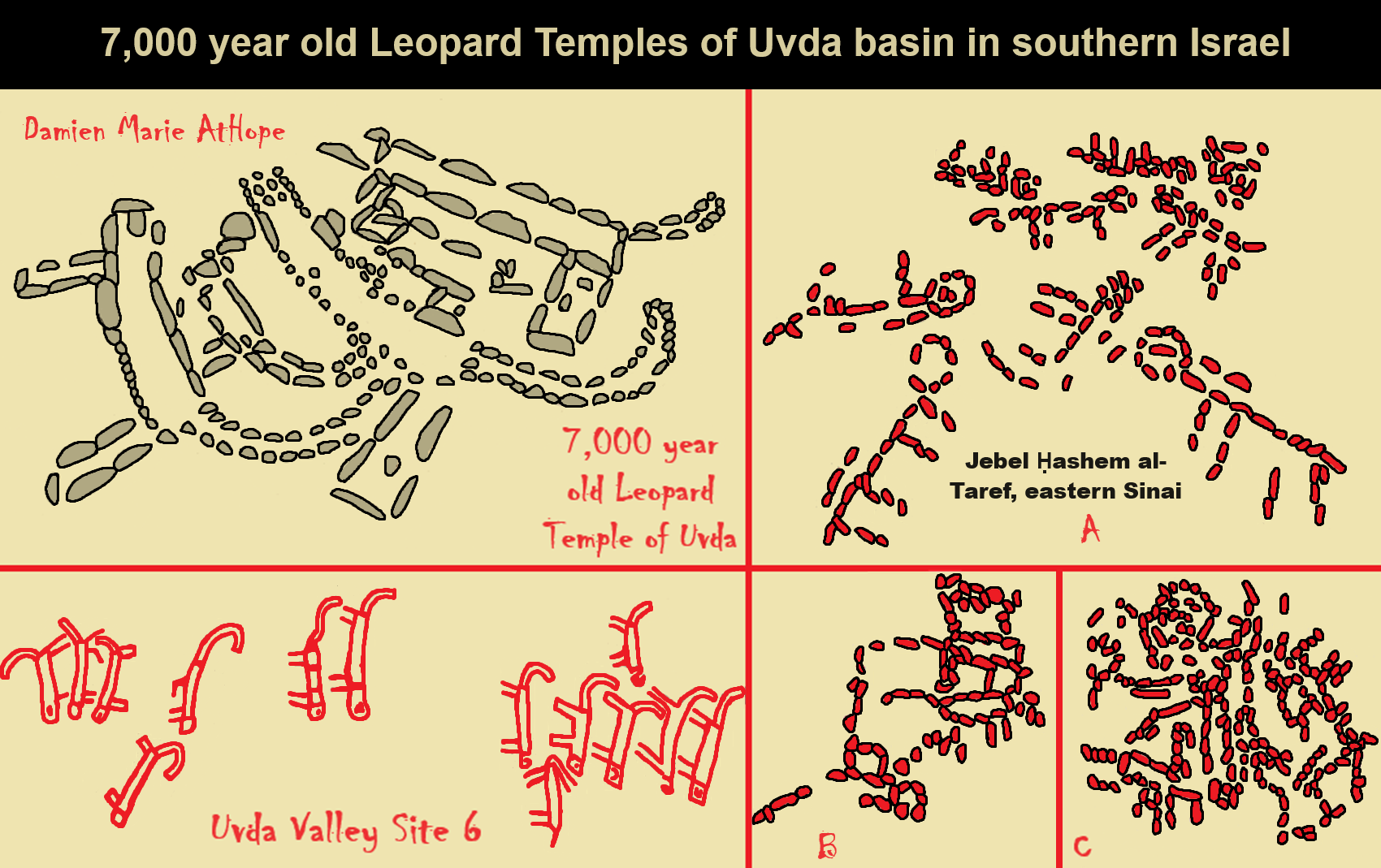
7,000-year-old Leopard Temples of Uvda basin in southern Israel
The 7,000 year old Masseboth Leopard Temple of Uvda
“7,000-year-old Leopard Temple of Uvda, in the Uvda basin in the desert of southern Israel. Uvda (Hebrew: עובדה) is the name of a region in the southern Negev desert, directly north of Eilat. The name derives from the Hebrew word uvda (meaning fact). The Uvda Valley is known for the 7000-year-old Leopard Temple archaeological site. They also began to worship something, perhaps the sun, perhaps their own ancestors, and intriguingly, perhaps the local scourge, the wild leopard.” ref, ref
“Uvda Valley Site 6, “stone drawings” of 15 leopards and one oryx, next to an open-air sanctuary, a vertical view (small stones indicate reconstruction).” ref
“Jebel Ḥashem al-Taref, eastern Sinai, three examples of “stone drawings” built next to pairs of open-air sanctuaries: (a) Excavated; (b,c) Unexcavated, dark stones—vertically set, light stones—fallen. Radiometric dates available to date from open sanctuaries are of the 6th and 5th millennia BCE. Nevertheless, Pre-Pottery Neolithic B flint items were also found in some of them (8th–7th millennia BCE), while other finds indicate continuation through the third millennium BCE, even the early second (Middle Bronze Age).” ref
“All open sanctuaries were built next to ancient roads (Figure 21c and Figure 27), while clusters of sanctuaries were built next to road junctions, for example, a cluster of 33 open sanctuaries near Jebel Ḥashem al-Taref in Sinai, 35 km west of Eilat; 4 pairs of sanctuaries at Ramat Saharonim; and 28 sanctuaries near Har Tzuriʻaz, in the southern Negev. Some sanctuaries were built in burial sites, also located next to ancient roads and road junctions.” ref
“This is also the female’s position in the drawing of a couple from Kuntilat ʻAjrud (Figure 17), slightly behind the male, presented as standing on a higher-like level, and her right leg is hidden behind the male’s left leg. Many open sanctuaries are circular, (Figure 21, Figure 28, and Figure 33). Most of them are 6–18 m in diameter, but tiny circular sanctuaries are also known, ca. 3 m in diameter (Figure 33), as well as large circular cult enclosures up to 70 m in diameter (Figure 33b). Stone alignments are attached to most of the circular sanctuaries, mainly in the form of “ladders,” which are chains of square cells made of a single line of stones or of small flagstones set vertically into the ground (Figure 34 and Figure 36). Their length ranges from a few meters to 78 m, and they present one of the combination of lines and circles.” ref
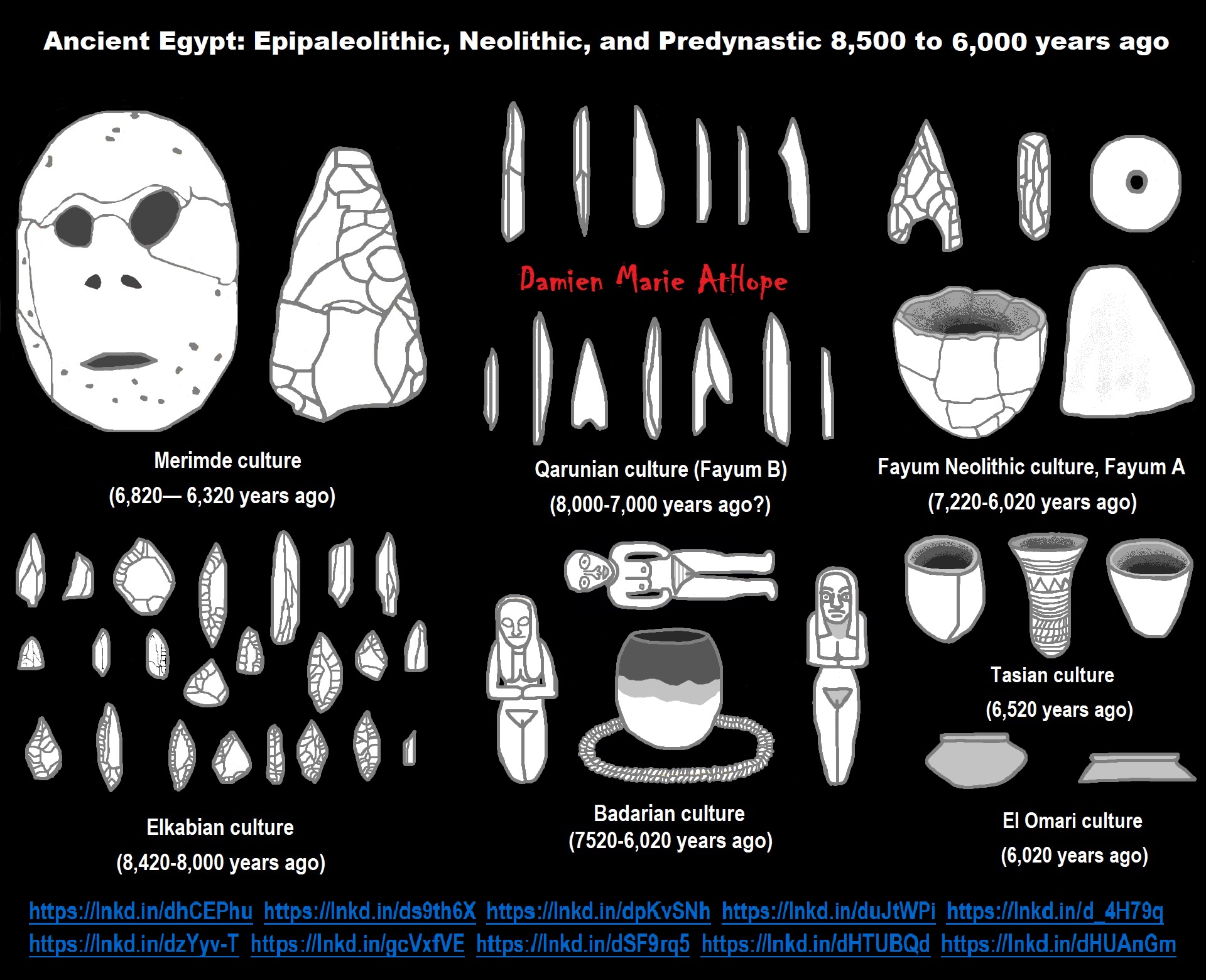
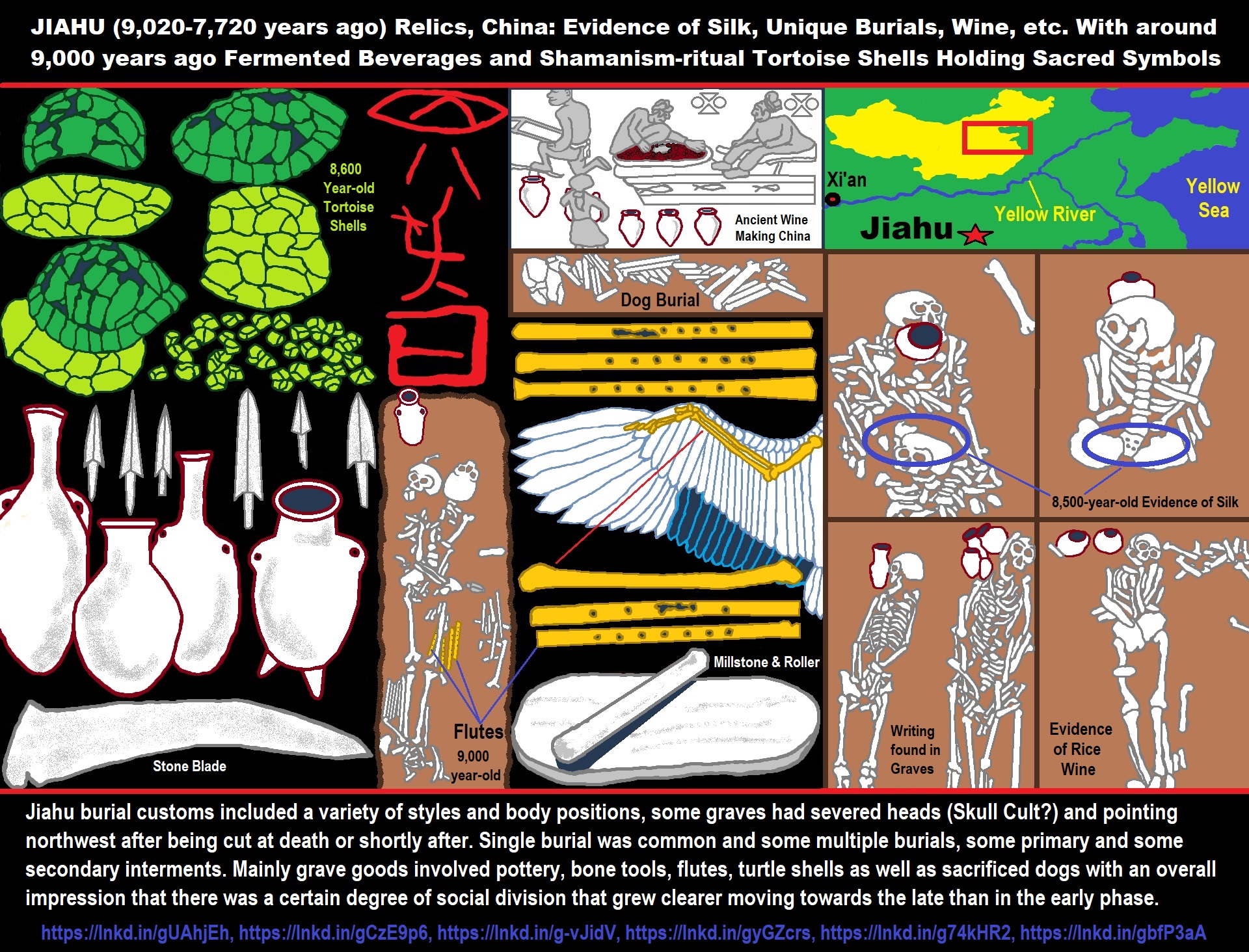
ref, ref, ref, ref, ref, ref, ref, ref, ref, ref, ref, ref
8,600-year-old Tortoise Shells in Neolithic graves in central China have Early Writing and Shamanism
The earliest of China’s Neolithic signs come from Jiahu, Damaidi and Dadiwan. Jiahu dated to around 8,600–8,200 years old Neolithic site in Henan Province, China in the basin of the Yellow River, that held turtle shells that were pitted and inscribed with markings known as the Jiahu symbols, meaningful use of such individual signs should not be easily equated with writing, although it may represent an earlier, formative stage. ref
In Damaidi, has 3,172 cliff carvings dating to 8,000–7,000 years old and are reported to express 8,453 different kinds of pictures like celestial bodies, deities or spirit beings and hunting or grazing scenes similar to some of the oracle bone characters, which is to be expected given that the oracle bones, which are true writing, retain a significant pictorials. ref
Dadiwan, is a 7.800–7,400 years old Neolithic site in the province of Gansu. Its earliest phase has yielded symbols painted on the inside surfaces of pottery and also uncovered a handful of Neolithic symbols. ref



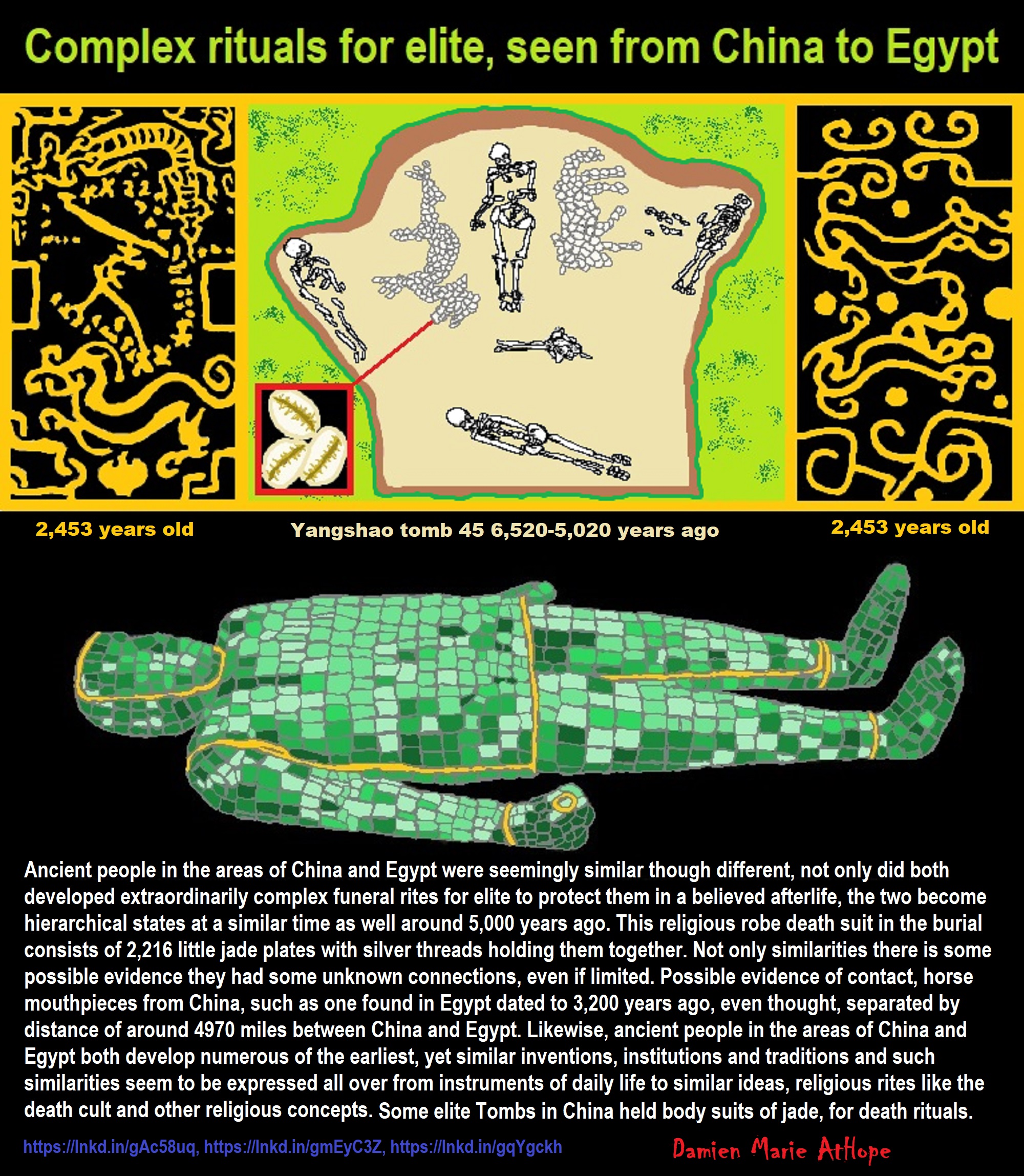
Neolithic clay amulet (retouched), in Romania. part of the Tărtăria tablets set, dated to 7,500–7,300 years ago and associated with the Turdaş-Vinča culture. The symbols are thought to be Vinča symbols although some scholars have considered them to be Sumerian. Three inscribed but unfired clay tablets, together with 26 clay and stone figurines and a shell bracelet, accompanied by the burnt, broken, and disarticulated bones of an adult female sometimes referred to as “Milady Tărtăria”, seems to suggest that the body was, if not that of a shaman or spirit-medium, that of a local most respected wise person. ref
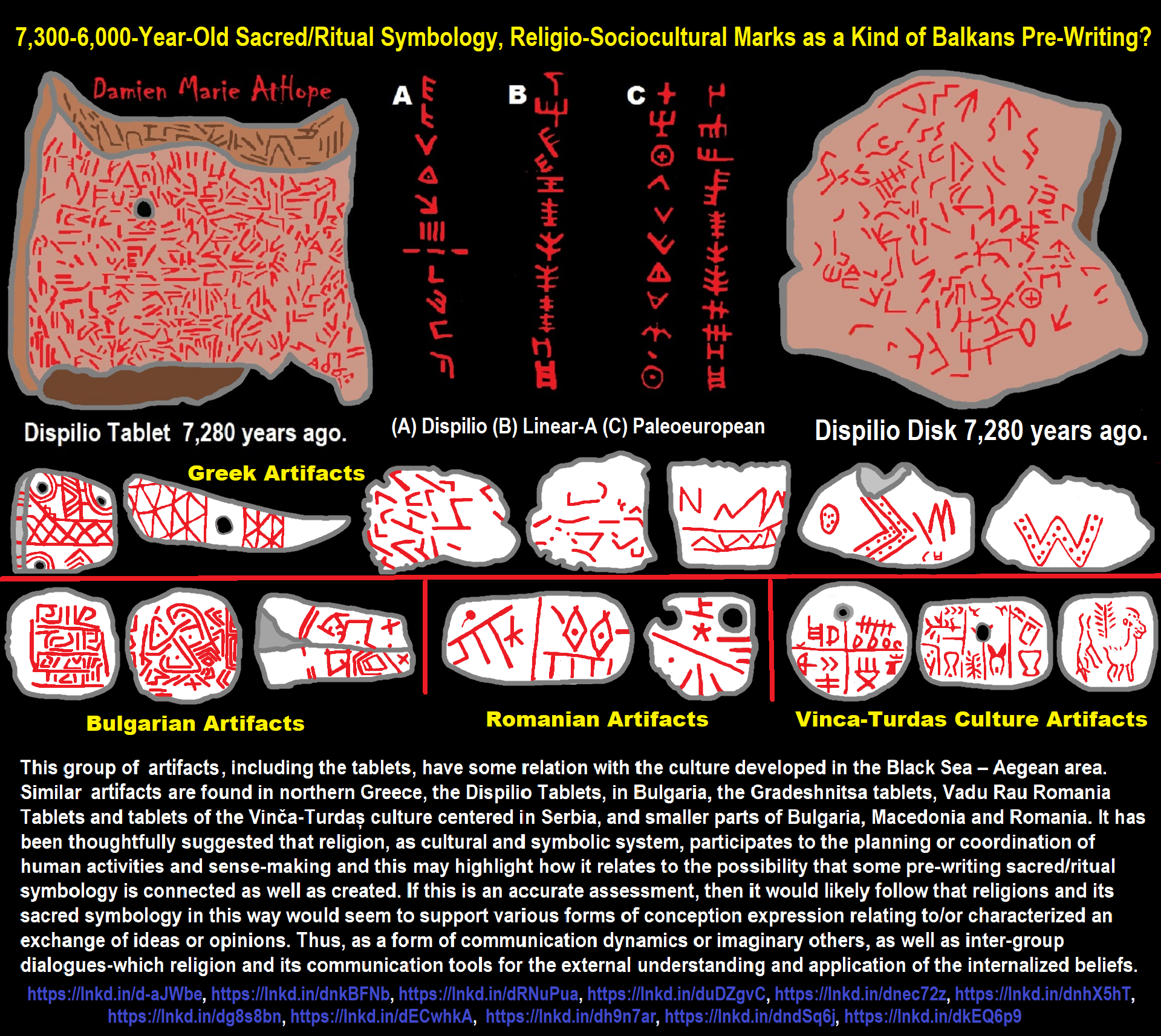
ref, ref, ref, ref, ref, ref, ref, ref, ref
“The Danube Valley civilization is one of the oldest civilizations known in Europe. It existed from between 5,500 and 3,500 BC in the Balkans and covered a vast area, in what is now Northern Greece to Slovakia (South to North), and Croatia to Romania (West to East). During the height of the Danube Valley civilization, it played an important role in south-eastern Europe through the development of copper tools, a writing system, advanced architecture, including two storey houses, and the construction of furniture, such as chairs and tables, all of which occurred while most of Europe was in the middle of the Stone Age. They developed skills such as spinning, weaving, leather processing, clothes manufacturing, and manipulated wood, clay and stone and they invented the wheel. They had an economic, religious and social structure.” ref
“One of the more intriguing and hotly debated aspects of the Danube Valley civilization is their supposed written language. While some archaeologists have maintained that the ‘writing’ is actually just a series of geometric figures and symbols, others have maintained that it has the features of a true writing system. If this theory is correct, it would make the script the oldest written language ever found, predating the Sumerian writings in Mesopotamia, and possibly even the Dispilio Tablet, which has been dated 5260 BC. Harald Haarmann, a German linguistic and cultural scientist, currently vice-president of the Institute of Archaeomythology, and leading specialist in ancient scripts and ancient languages, firmly supports the view that the Danube script is the oldest writing in the world. The tablets that were found are dated to 5,500 BC, and the glyphs on the tablets, according to Haarmann, are a form of language yet to be deciphered. The symbols, which are also called Vinca symbols, have been found in multiple archaeological sites throughout the Danube Valley areas, inscribed on pottery, figurines, spindles and other clay artifacts.” ref
Understanding Proto-Indo-Europeans and Paganism Religions.
Fear of Wars Violence and the Creation of Male God around 7,000 years ago?
And, to me, this area and time relates to the birth of the Creation of Male God around 7,000 years ago and proto-kings, such as seen in the royal nobility skeleton discovered in Grave No. 43 in the Varna culture (around 6,400-6,100 years ago) Chalcolithic Necropolis together with the numerous gold artifacts dating to the middle of the 5th Millenium BCE – and is the old processed gold in the world. Which took it to a few different areas but defiantly is seen in a new way as it moved north to the step lands of Eastern Europe and the Proto-Indo-European language as well as south into Jordan and Israel by 6,500 to 6,000 years ago at which time it then moves to Egypt becoming more advanced with the emergence of an emerging nation of Egypt around 5,000 years ago as well as Mesopotamia with Progressed organized religion.
“An Asherah pole is a sacred tree or pole that stood near Canaanite religious locations to honor the Ugaritic mother-goddess Asherah, consort of El. The relation of the literary references to an asherah and archaeological finds of Judaean pillar-figurines has engendered a literature of debate. The asherim were also cult objects related to the worship of the fertility goddess Asherah, the consort of either Ba’al or, as inscriptions from Kuntillet ‘Ajrud and Khirbet el-Qom attest, Yahweh, and thus objects of contention among competing cults. The Hebrew Bible suggests that the poles were made of wood. In the sixth chapter of the Book of Judges, God is recorded as instructing the Israelite judge Gideon to cut down an Asherah pole that was next to an altar to Baal. The wood was to be used for a burnt offering.” ref
“In translations that render the Hebrew asherim into English as “Asherah poles,” the insertion of “pole” begs the question by setting up unwarranted expectations for such a wooden object: “we are never told exactly what it was”, observes John Day. Though there was certainly a movement against goddess-worship at the Jerusalem Temple in the time of King Josiah (2 Chronicles 34:3), it did not long survive his reign, as the following four kings “did what was evil in the eyes of Yahweh” (2 Kings 23:32, 37; 24:9, 19)[citation needed]. Further exhortations came from Jeremiah. The traditional interpretation of the Biblical text is that the Israelites imported pagan elements such as the Asherah poles from the surrounding Canaanites. In light of archeological finds, however, modern scholars now theorize that the Israelite folk religion was Canaanite in its inception and always polytheistic, and it was the prophets and priests who denounced the Asherah poles who were the innovators; such theories inspire ongoing debate.” ref
“Asherim are mentioned in the Hebrew Bible in the books of Exodus, Deuteronomy, Judges, the Books of Kings, the second Book of Chronicles, and the books of Isaiah, Jeremiah, and Micah. The term often appears as merely אשרה, (Asherah) referred to as “groves” in the King James Version, which follows the Septuagint rendering as ἄλσος, pl. ἄλση, and the Vulgate lucus, and “poles” in the New Revised Standard Version; no word that may be translated as “poles” appears in the text. Scholars have indicated, however, that the plural use of the term (English “Asherahs”, translating Hebrew Asherim or Asherot) provides ample evidence that reference is being made to objects of worship rather than a transcendent figure. Some biblical archaeologists have suggested that until the 6th century BC the Israelite peoples had household shrines, or at least figurines, of Asherah, which are strikingly common in the archaeological remains. Raphael Patai identified the pillar figurines with Asherah in The Hebrew Goddess.” ref
“Deuteronomy 16:21 states that YHWH (rendered as “the Lord”) hated Asherim whether rendered as poles: “Do not set up any [wooden] Asherah [pole] beside the altar you build to the Lord your God” or as living trees: “You shall not plant any tree as an Asherah beside the altar of the Lord your God which you shall make”. That Asherahs were not always living trees is shown in 1 Kings 14:23: “their asherim, beside every luxuriant tree”. However, the record indicates that the Jewish people often departed from this ideal. For example, King Manassehplaced an Asherah pole in the Holy Temple (2 Kings 21:7). King Josiah’s reforms in the late 7th century BC included the destruction of many Asherah poles (2 Kings 23:14). Exodus 34:13 states: “Break down their altars, smash their sacred stones and cut down their Asherim [Asherah poles].” ref
There is so much to learn about the forgotten past.
Such as how the swastika was a Mesopotamia religious symbol around 7,500–6,800 and it was first connected to fertility cults. This is a Hattusa/Samarra bowl depicting 4 goddesses possibly the 4 elements to form a swastika. We need to rethink the past of the swastika, to do this it’s necessary to understand its underlying symbolism – the most important being that, in the art and mythology of the old religions, it’s first and foremost a feminine symbol. The swastika was widely used in ancient Greece to represent a variety of goddess figures. The word swastika is derived from the Sanskrit, svastikah, which means ‘being fortunate’: SVASTI-, can be divided into two parts: SU- ‘good; well’, and -ASTI- ‘is’; -ASTIKAH means ‘being’. While it has also been said that it is derived from Sanskrit words meaning “health mark” and that the reverse swastika represents darkness, misfortune, and suffering, this is not a thinking all support. ref
12,000 years old Swastikas appear on carvings on mammoth ivory from the Ukraine and Swastikas are seen on the oldest coinage in India. Persia, Asia Mior, and Greece represented the rotating axis mundi with the symbol of a swastika. The sign of the sun’s strength as the unstoppable whirling might of Will and as such is one of the holiest and oldest shared signs in the world, known in almost every tradition. A female swastika motif are common on Samarian pottery from Mesopotamia as well as throughout the ancient cultures of Europe and the Mediterranean, the swastika was widely used as a cypher to represent the Great Goddess, with the feminine deities Astarte, Athene and Artemis all being associated with this symbol. ref
One of the oldest goddess images unearthed – a lead figurine from Troy dating back to the between 5,000 to 4,000 years ago – has a swastika inscribed over its sexual triangle. The swastika was presented as a sacred sign of the Goddess Artemis on a Boeotian amphora around 2,700 years ago as well as the swastika representing many other deities from Iceland to Japan in addition to lands as far apart as from Scandinavia to North Africa. Also noteworthy is the swastika’s use as the specific emblem of Ganesha, the Hindu god of good luck, who is also represented as an elephant. It was much used in Troy and Mycenaie before the 3,300 years ago and in Japan, the reborn Amida, “Buddha of Immeasurable Light”, wore a left-handed swastika carved on his breast. ref
While Jainism represents the swastika in a clockwise manner, Tibetan Yungdrung Bön represents it counter-clockwise and there is little consistency in its use in the Americas. Many First Nations adorn their houses and doors with this sacred symbol, which is an auspicious symbol bearing good luck and there are many ancient graves in Ireland and England marked with swastikas. Moreover, the sign of Thor’s hammer on Scandinavian coins sometimes held a similar left-handed swastika and Trojan images of the Great Goddess showed a swastika within a female triangle on her belly, indicating the hidden god prior to his next rebirth. ref
“The Dispilio tablet was found in a Neolithic lake settlement in Northern Greece near the city of Kastoria. A group of people used to occupy the settlement 7,000 to 8,000 years ago. The Dispilio tablet was one of many artifacts that were found in the area, however, the importance of the table lies in the fact that it has an unknown written text on it that goes back further than 5,000 BC. The wooden tablet was dated using the C12 method to have been made in 5260 BC, making it significantly older than the writing system used by the Sumerians. The text on the tablet includes a type of engraved writing which probably consists of a form of writing that pre-existed Linear B writing used by the Mycenaean Greeks. As well as the tablet, many other ceramic pieces were found that also have the same type of writing on them. Professor Xourmouziadis has suggested that this type of writing, which has not yet been deciphered, could be any form of communication including symbols representing the counting of possessions.” ref
Roots of a changing early society
Roots of a changing early society 7,200-6,700 years ago Jordan and Israel
“Settlement at Tel Tsaf, near the Jordan River and the modern state of Jordan, dates to circa 5200-4700 BCE. According to the international team of researchers, the site offers “ideal conditions to study changes in household economies and emerging social complexity during the formative stages of the Late Chalcolithic period. The vessel was found in pieces two years ago in a room which appears to be connected to a burial complex filled with an unprecedented number of the bases of large wheat and barley storage silos upon which were found thousands of millennia-old seeds. The vessel was recently reassembled, and is believed to be a model for the construction of the larger containers, as well as a ritual object.” ref, ref
“Also found with the vessel pieces were ritual figurines and items of evident worth, including the earliest copper item found in the Levant and pieces made from obsidian. And due to the context in which the vessel was found and its uniqueness — clearly not a pot for everyday use — the archaeologists believe it was used for ritual purposes. In fact, the entire space was used for more than a domestic structure. Therefore, the findings at Tel Tsaf are first evidence for the connection between food storage at a large-scale, and between the existence of a ritual related to the successful storage and preservation of the agricultural products being stored.” ref, ref
“The combined discoveries of the model and large grain silos may force archaeologists to rethink the organization of prehistorical society. Moreover, evidence of other grain-storage rituals have been discovered in other ancient Near East societies, for example, in ancient Egypt or in Mesopotamia, however, this find at Tel Tsaf predates them by several thousand years, according to the archaeologists. Stone houses and artifacts dating back 7,000 years have been discovered in Jerusalem, demonstrating that the settlement existed even longer than had been supposed. It includes earliest-known houses in Jerusalem, gemstone beads and stone tools. The remains of an ancient settlement from the Chalcolithic period roughly 7,000 years ago (5th millennium BCE) were unearthed in a significant archaeological find. Back in the Chalcolithic period, people first began using tools made of copper, known as chalcos in Greek, while continuing to use tools made of stone, which is lithos in Greek – hence the name of the period. But the Chalcolithic period is also known in the Negev, the coastal plain, the Galilee and the Golan, but is almost completely absent in the Judean Hills and Jerusalem. Although there have been a few traces of Chalcolithic settlements, such as those at Abu Gosh, Motza Junction, and Jerusalem, they have been extremely sparse. But there has been more evidence such as Two houses were unearthed with significant remains from 7,000 years ago.” ref, ref
“Two houses revealed well-preserved remains and floors as well as pottery vessels, flint tools, and a basalt bowl. All of which are typical of the Chalcolithic period, and by the signs of maintenance and stages of construction in the buildings show they were used for a significant stretch of time. On completion of the excavations at Shuafat, it is quite evident that there was a thriving settlement in the Jerusalem area in ancient times. Apart from the pottery, the fascinating flint finds attest to the livelihood of the local population in prehistoric times: small sickle blades for harvesting cereal crops, chisels and polished axes for building, borers and awls, and even a bead made of carnelian (a gemstone), indicating that jewelry was either made or imported. There were grinding tools, mortars and pestles, like the basalt bowl, attest to technological skills as well as to the kinds of crafts practiced in the local community. There was a 7,000-year-old bead. Also recovered a few bones of sheep/goat and possibly cattle, permitting us to recreate the dietary habits of the people who lived here 7,000 years ago and enhancing our understanding of the settlement’s economy.” ref, ref
The Sumerian word for “sky” or “heaven” and “goddess” or “god” may connect to the Ghassulian Culture “Star “
The Sumerian word for “god” that originally was an ideogram for the Sumerian word “sky” or “heaven” was then extended to a logogram for the word (Dingir) (“goddess” or “god”). The three symbols relate to the holy triad: Inanna/Ishtar, Nanna/Sin, Utu/Shamash, that is morning star (Venus), lunar (moon crescent), solar disk (sun). The concept of “divinity” in Sumerian is closely associated with the heavens, as is evident from the fact that the cuneiform sign doubles as the ideogram for “sky”, and that its original shape is the picture of a star. The original association of “divinity” is thus with “bright” or “shining” hierophanies in the sky. A possible loan relation of Sumerian dingir with Turkic Tengri “sky, sky god” has been suggested by historian Mircea Eliade, but not picked up by linguists. ref
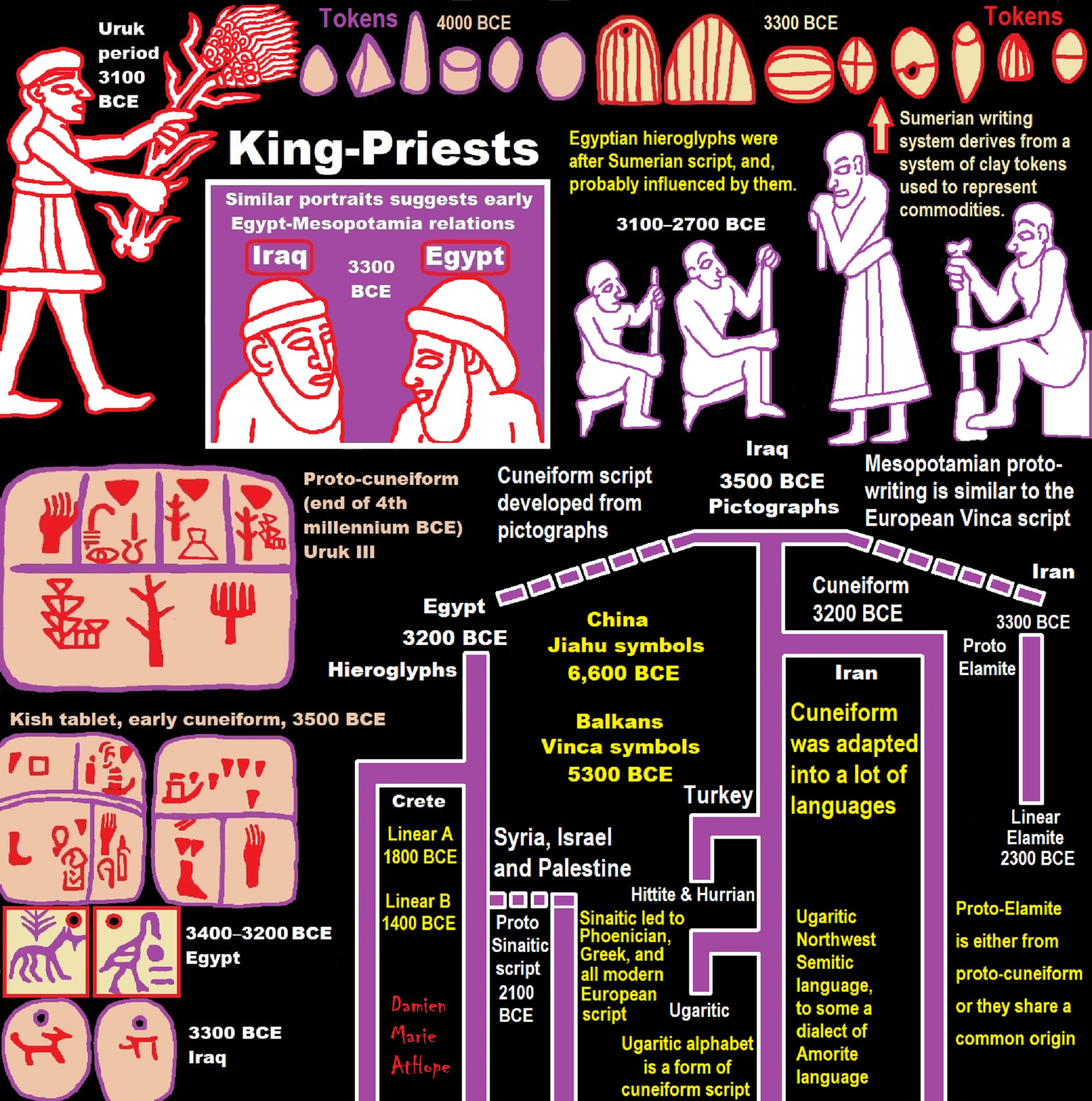
ref, ref, ref, ref, ref, ref, ref, ref, ref
“Hamoukar is a large archaeological site located in the Jazira region of northeastern Syria (Al Hasakah Governorate), near the Iraqi and Turkish borders. The early settlement dates back to the 5th millennium BCE, and it existed simultaneously with the Ubaid and the early Uruk cultures. It was a big centre of obsidian production. In the 3rd millennium, this was one of the largest cities of Northern Mesopotamia, and extended to 105 ha.” ref
1. Clay sealing with impression of large, abstract seal; from Area B, date: ca. 3,500 BCE.
2. Clay sealing with impression of seal depicting two dancers; from Area B, date: ca. 3,500 BCE.
3. Stamp seal, black stone, showing seal scene with two dancers holding hands. Right side shows modern impression. From Southern Extension; date: ca. 4,200 BCE. ref
At around 5,400 – 5,200 years ago, bone and ivory tags, pottery vessels, and clay seal impressions bearing hieroglyphs unearthed at Abydos, 300 miles south of Cairo, thus, some of the oldest known examples of Egyptian writing. ref
Indus script/Harappan script
The ‘fish’ signs themselves are combinations of the basic ‘fish’ pictogram and various diacritic marks and most likely that such compounded and diacritic signs in the Indus script have had the same function as in the readable pictographic writing systems of ancient Sumer and Egypt. Unfortunately, most of the Indus signs are so stylized and simplified that their original pictorial meaning cannot be recognized and thus remain subjective, however, some Indus signs whose pictorial meaning is beyond any reasonable doubt. ref
The Indus script (also known as the Harappan script) is a corpus of symbols produced by the Indus Valley Civilisation during the Kot Diji and Mature Harappan periods between 5,500 and 3,900 years ago. Most inscriptions containing these symbols are extremely short, making it difficult to judge whether or not these symbols constituted a script used to record a language, or even symbolize a writing system. ref, ref
The Indus civilization was built on trade with other civilizations. Traders brought the materials workers needed and took away finished goods to trade in other cities in a wide-ranging from Mesopotamia to China and Indus Valley traders even went to Mesopotamia as well as other countries as Indus seals have been found in there. Also, the Mesopotamians wrote about importing goods from the Indus people which further support the idea of a trading partnership between the two civilizations. ref
Pre to Early Harappan Site Found In Kutch western India 3300 BCE to 2600 BCE with over 100 burial sites in the area.
“Egyptian hieroglyphs were the formal writing system used in Ancient Egypt. Hieroglyphs combined logographic, syllabic and alphabetic elements, with a total of some 1,000 distinct characters. Cursive hieroglyphs were used for religious literature on papyrus and wood. The later hieratic and demotic Egyptian scripts were derived from hieroglyphic writing. The use of hieroglyphic writing arose from proto-literate symbol systems in the Early Bronze Age, around the 3200 BC (Naqada III) with the first decipherable sentence written in the Egyptian language dating to the Second Dynasty (2800 BC).” ref
“Kemetic “Hieratic” (3200 BC – 600 AD) The term, “Hieratic” was first coined by Saint Clement of Alexandria (c 200 AD), a Greek theologian who used the term “grammata hieratika” or priestly/sacerdotal writing. Although many scholars contend that “Hieratic” developed as an entirely distinct script from the Medu Neter, the obvious visual similarities prove that its also a somewhat simplified form of the Medu Neter that was mainly used for more administrative and scientific documents throughout the dynastic history of both Kemet and Kush (3200 BC – 600 AD). However, linquists have also shown similaries between it and the alphabetic Proto-Saharan or Thinite writing. Hieratic developed as a cursive form of hieroglyphic script in the Naqada III period, roughly 3200–3000 BCE. And is a cursive writing system used for Ancient Egyptian, and the principal script used to write that language from its development in the 3rd millennium BCE until the rise of Demotic in the mid 1st millennium BCE. It was primarily written in ink with a reed pen on papyrus.” ref, ref
“Jiroft culture” 5,100 – 4,200 years ago and the History of Iran
“The Proto-Elamite period is the time from ca. 3400 BC to 2500 BC. In archaeological terms, this corresponds to the late Banesh period, and it is recognized as the oldest civilization in Iran. The Proto-Elamite script is an Early Bronze Age writing system briefly in use before the introduction of Elamite cuneiform. The most important Proto-Elamite sites are Susa and Anshan. Another important site is Tepe Sialk, where the only remaining Proto-Elamite ziggurat is still seen. Texts in the undeciphered Proto-Elamite script found in Susa are dated to this period. It is thought that the Proto-Elamites were in fact Elamites (Elamite speakers), because of the many cultural similarities (for example, the building of ziggurats), and because no large-scale migration to this area seems to have occurred between the Proto-Elamite period and the later Elamites. But because their script is yet to be deciphered, this theory remains uncertain.” ref
This proto-literate tablet dating to around 5,100 – 4,900 years ago and it records the transfer of a piece of land. Archaic Sumerian 5,100 – 4,600 years ago spoken in Mesopotamia (modern-day Iraq). 5,000 to 4,000 years ago, an intimate cultural symbiosis developed between the Sumerians and the Semitic-speaking Akkadians. ref
Around 5,100-5,000 years ago Hor-Aha (Horus Aha) the second pharaoh of the first dynasty of ancient Egypt a time when pharaohs where called by their Horus-names. And the historical record, as evidenced in the Turin and Abydos king lists, uses an alternative royal titulary, the nebty-name. The different titular elements of a pharaoh’s name were often used in isolation, for brevity’s sake, although the choice varied according to circumstance and period. The same process has led to the identification of the historical Menes (a nebty-name) with the Narmer (a Horus-name) evidenced in figure credited with the unification of Egypt and as the first pharaoh of Dynasty I as the predecessor of Hor-Aha (the second pharaoh). ref
Naqada culture is an archaeological culture of Chalcolithic Predynastic Egypt (ca. 4400–3000 BC)
- Naqada I: Amratian (after the cemetery near El-Amrah); Naqada I (about 4400–3500 BC)
- black-topped and painted pottery
- trade with Nubia, Western Desert oases and Eastern Mediterranean[2]
- obsidian from Ethiopia
- Naqada II: Gerzean (after the cemetery near Gerzeh); Naqada II (about 3500–3200 BC)
- this culture represented throughout Egypt
- first marl pottery, and metalworking
- Naqada III: Semainean (after the cemetery near Es-Semaina); Naqada III (about 3200–3000 BC)
- more elaborate grave goods
- cylindrical jars
- writing ref
Egyptian Western Desert The Rock Inscriptions of Gebel Tjauti in the Theban
“It holds forty-five inscriptions from Gebel Tjauti and forty-five inscriptions from Wadi el-Hôl, two major concentrations of rock inscriptions and rock art on pharaonic caravan routes of the Egyptian Western Desert. The inscriptions range in date from predynastic to Christian. Inscriptions of particular interest in this first volume include from Gebel Tjauti: a Naqada IID/IIIA tableau revealing important new information concerning the unification of Upper Egypt and the founding of Dynasty 0; a road construction inscription of the Coptite nomarch Tjauti providing evidence for the beginnings of the northern expansion of the Theban realm during the middle Eleventh Dynasty; the depiction of a Nubian ranger; and Coptic cryptography; and from the Wadi el-Hôl: epigraphic evidence for the use of the Farshût Road for transport of supplies to the temple of Amun during the New Kingdom; a new Middle Egyptian literary inscription; a rock-cut letter that contributes to our understanding of the history of the textual variants of the Story of Sinuhe; and an inscription recounting desert celebrations in honor of the goddess Hathor. The inscriptions are published in photograph and facsimile drawing, with hieroglyphic transcriptions, translations, commentaries, and glossary.” ref
“Relating to the picture above, not only the Egyptians, the Chinese developed very complex funeral rites in order to protect their dead in the afterword. And the two become hierarchical states at a similar time as well around 5,000 years ago. This religious robe of the royal family was buried consists of 2,216 little jade plates with silver threads holding them together. China and Egypt are also cradles of the World.” Evidence of possible contact is seen in horse snaffles – a longish mouth piece made of bronze that is kept flexible by two interlocking rings in the middle enabling the rider to steer the horse to the right or left. One of them was found in Egypt dated to 3,,200 years ago. Seemingly separated by distance of around 4970 miles between China and Egypt. And yet, these two civilizations seen as the world’s earliest ones, developed numerous similar inventions, institutions and traditions – not only concerning instruments of daily life, but also religious rites like the death cult and other religious concepts. Also there is the fact that the simple dwellings in China resembled the ones used in Egypt and in both cultures, people kept dogs. A wide variety of statues, jewelry, ceramics and cosmetic vessels illustrate daily life patterns of the societies of both countries. Moreover, both Chinese and Egyptians used pretty much the same type of instruments for washing, a set consisting of a vessel with a handle, and a water bowl. Almost the only thing that differs is how these bronze vessels were decorated. What also differs are the materials used by both cultures, as available local raw materials were different. Along with bronze, the Chinese used varnish for their typical luxurious goods. In Egypt, by contrast, this material was not available. That’s why the Egyptians resorted to glass for their luxurious objects, as demonstrate 3,500-year-old bottles of opaque glass that were used to keep oils and perfumes. A comparison between Chinese and Egyptian cultures is particularly interesting when it comes to death cults. As precious burial objects show, both societies developed very complex rites and funeral customs.” Ref
Haplogroup X from Eurasia and Africa revealed two major branches, “X1” and “X2.” ref
X1 is restricted to the populations of North as well as East Africa and the Near East with diversity that indicates an early time compared to X2. ref
Overall, it appears that the populations of the Near East, the Caucasus, and Mediterranean Europe harbor X2 dating to around 17,900 ± 2,900, at higher levels than northern and northeastern Europe 21,600 ± 4,000 and X2 is rare in Eastern European as well as Central Asian, Siberian, and Indian populations and is virtually absent in the Finno-Ugric and Turkic-speaking people of the Volga-Ural region. Ref
X mtDNAs from North Africa
X1 largely restricted to the Afro-Asiatic–speaking populations of North Africa and neighboring areas, including Ethiopia, suggesting diffusion of X1 42,900 – 18,100 years ago alongside the Mediterranean Sea and the Red Sea subdivided into the two X1a dating to around 17,900 – 11,900 years ago and X1b, time of the entire 42,900 – 18,100 years ago. X2b1 subclade has been identified in a group of Moroccans. Moreover, virtually all (97.2%) haplogroup X mtDNAs from the Near East, the South Caucasus, and Europe belong to X2, as did 100% of those from Siberia and Central Asia and some 36.8% of those from North Africa. Ref
X mtDNAs from Native Americans
X2 includes the two complete Native American X sequences that constitute the distinctive X2a, an early split from the other X2, that lacks close relatives in the entire Old World, including Siberia where most natives of the Americas link too. Native American haplogroup X mtDNAs distinct from that of West Eurasians times seemingly ranged from 12,000–17,000 years ago to 23,000–36,000 years ago. The Native American X2a mutations seen in virtually all previously analyzed Native American X mtDNAs and a match a single X2* sequence from Iran, this Iranian mtDNA would share a common ancestor with the Native American X2a. If we assume that the two complete Native American X sequences (from one Navajo and one Ojibwa) began to diverge while their common ancestor was already in the Americas, implying an arrival time not later than 11,000 years ago. Ref
X mtDNAs from Siberia
Altaian Siberians X mtDNAs is the only X mtDNA in Siberians and is limited to populations of southwestern Siberia. Northeast of the Altai area, X sequences were detected in the Tungusic-speaking Evenks, of the Podkamennaya Tunguska basin (Central Siberia). In contrast to the Altaians, the Evenks did not harbor any West Eurasian mtDNA haplogroups other than X. However, neither of the two Evenk X seem related to the Native American clade X2a rather one was X2b and the other of X2*. Thus, several X haplotypes arrived in Siberia from western Asia during the Palaeolithic, but only X2a crossed Beringia surviving in modern Native Americans. Ref
X mtDNAs from Europe
X mtDNAs from Europe date to around 17,000–30,000 years ago, X2 relates to all X mtDNAs from Mediterranean Europe, western and Central Asia, Siberia, and the great majority of the Near East, as well as some North African samples. X2 relates to a more recent population expansion in Eurasia, most likely around or after the last glacial maximum. X mtDNAs from Europe 17,000–30,000 years ago and the Near East 13,700–26,600 years ago, which is consistent with a pre-Holocene origin some time befor 11,650 years ago and spread of this haplogroup into West Eurasia. ref, ref
X mtDNAs from the Near East
X mtDNAs from the Near East 13,700–26,600 years ago, which is consistent with a pre-Holocene origin some time befor 11,650 years ago and spread of this haplogroup into West Eurasia. Ref
X mtDNAs from Iran
All three Iranian populations exhibit similar frequencies of western Eurasian component, pointing to a first population expansion around 40,000–42,000 years ago, followed by a gradual decrease around 24,000 years ago. Western Eurasian N1, N2, N3, X, R0, R2’JT, and U, accounts for 90.9% in Azeris, 86.7% in Persians and 91.1% in Qashqais. A notable difference between Azeris and two other populations studied is the higher frequency of haplogroups X2 (9.1% versus 2.8% in Persians and 2.7% in Qashqais). Persians show a continuous, slightly stepped increase of population size to the present, whereas Azeris gradual increase from around 27,000 years ago and the Qashqais with two steps 10,000 years ago and 2,500 years ago. Seemingly consistent with the data showing absence or low frequencies of eastern Eurasian haplogroups in the populations from the Anatolian/Caucasus region and the Iranian Plateau. Ref
X mtDNAs from the Caucasus
97.2% of haplogroup X mtDNAs from the Near East, the South Caucasus, and Europe were belong to subhaplogroup X2, as did all (100%) of those from Siberia and Central Asia and some (36.8%) of those from North Africa. Thus, X2 is characterized by a very wide geographic range but also by an infrequent occurrence. 5% of X2 in West Eurasian and North African populations. Three exceptions include the Druze, the Georgians, and the Orkney Islanders, among whom the frequency of X2 reaches 11%, 8%, and 7%, respectively. The high frequencies of X2 in the Druze and the Orkney Islanders and the relatively high frequency in these populations is most likely due to genetic drift and founder events. Two-thirds of X2 sequences fall into the five clades X2b–X2f. Ref
Two sequences—one from Lebanon and one from Georgia seem to suggesting either the presence of an early X2 branch and sister groups X2b and X2c (X1 and X2, respectively, encompass one-third of the European sequences excluding the samples from the North Caucasus. It is of interest that some North African sequences (from Morocco and Algeria) belong to X2b as well. Around 12,000 to 10,800 years ago X2b seeming to express a post-glacial population expansion in both West Eurasia and North Africa. Clades X2e and X2f encompass 87.1% from the South Caucasus consistent with a Late Upper Paleolithic origin and a subsequent spread in the region. Ref
The Upper Paleolithic (around 40,000-10,000 years ago), which was a time of great transition in the world Aurignacian (45,000-29,000 years ago), Gravettian (29,000-22,000 years ago)/Epigravettian (21,000 – 10,000 years ago), Solutrean “replacing Gravettians in most of France and Spain” (22,000-18,000 years ago), Magdalenian(17,000-11,000 years ago), and Azilian/Federmesser(13,000-11,000 years ago). Ref
Significant differences between the North and South Caucasian samples X2e and X2f mtDNAs relate to all X sequences in the Altaians indicates a major geographical barrier between the two regions and as a result, a very low diversity of haplogroup X in the Altaian region different from the diversities for C and D in the same region. Moreover, the Altaian X mtDNAs seems to correspond to possablly around 6,700 years ago or less and it would suggest that Altaians have acquired haplogroup X2 along with the presence in the Altaians wide range of other West Eurasian haplogroups (H, J, I, T, U1, U4, and U5) that comprise around 27% of their mtDNAs. Indeed, likely expressing a migration (from the [southern] Caucasus region) that might have carried X2e mtDNA sequences to the Altai region also explain the other West Eurasian mtDNA haplogroups in modern Altaians. Ref
X variation is completely captured by two ancient clades X1 is largely restricted to North and East Africa, whereas X2 is spread widely throughout West Eurasia. The split between “African” X1 and “Eurasian” X2 of X are as deep as that within the branches of haplogroup U that also differ profoundly. Thus, U6 is largely restricted to North Africa (as X1), whereas U5 is widespread in West Eurasia (as X2). Times obtained suggest mtDNA haplogroups in West Eurasia and North Africa are ancient in this region. Finally, subclades of X suggests that the Near East is the likely geographical source for the spread of X2 occurred around, or after, the Late Upper Paleolithic origin when the climate make (something bad or unsatisfactory) better, around the times of a few possable groups such as Epigravettian (21,000 – 10,000 years ago), Solutrean “replacing Gravettian in most of France and Spain” (22,000-18,000 years ago), Magdalenian (17,000-11,000 years ago), and Azilian/Federmesser (13,000-11,000 years ago).. The presence of a daughter clade in northern Native Americans testifies to the range of this population expansion. Ref
There is relevant genetic populations in western Eurasia around 9,000 years ago are five. We’ll start with the first two:
Western Hunter-Gatherers or WHG*: this genetic population cluster occupied much of southern and western Europe at this time. In the north and east, they abutted…
Eastern Hunter-Gatherers or EHG*: this genetic population is a kind of a hybrid between WHG and a population from the steppe known as Ancestral North Eurasians (ANE, currently represented by one much older ancient DNA sample known as Ma’lta from the Lake Baikal Area). Ref
*These labels are those used by researchers in ancient genetics for the genetic clusters which they’ve identified.” Ref
“The boundary between WHG and EHG passed west to east through the Baltic region, dividing the Baltic states in the east before taking a southward turn to join the Black Sea at its western end. Populations either side of the boundary appears to be hybrids between WHG and EHG (e.g. Scandinavian Hunter-Gatherers or SHG and Ukraine Mesolithic), although there may be other minor components in the Balkans. And in the south-east, there are three other populations and these three populations appear to have interacted and mixed to some extent in the middle east in the period between around 9,000 – 6,000 years ago:” Ref
“Anatolian Neolithic: this population, located in Anatolia, is important in spreading farming to all of the Balkans, western Europe and parts of Ukraine between around 9,000 – 6,000 years ago. Unfortunately, the predecessors of AN in Anatolia have not yet been reported on. It is possible that it’s made up of a mix of earlier populations from the Balkans, Levant and Iran (due to their genetic similarity, on the diagram I’ve just lumped Anatolia and the Levant together in blue).” Ref
“Iran Neolithic: this population, found in NW Iran, shows some possible connection with modern south Asian populations.” Ref
“Caucasus Hunter-Gatherers or CHG: this population, found in the Caucasus of course, could be a mixture of Iran Neolithic and mixed EHG/WHG populations, perhaps from the steppe, but also needs to include another, unknown population (NB I’ve lumped these last two related populations together as yellow as it was just becoming too messy with them separate). ref
Language groups in the Caucasus have been found to have a close correlation to genetic ancestry. A genetic study in 2015 by Fu et al. of many modern European populations, identified a previously unidentified lineage, which was dubbed “Caucasian Hunter-Gatherer” (CHG). The study detected a split between CHG and so-called “Western European Hunter-Gatherer” (WHG) lineages, about 45,000 years ago, the presumed time of the original peopling of Europe. CHG separated from the “Early Anatolian Farmers” (EAF) lineage later, at 25,000 years ago, during the Last Glacial Maximum. (CHG was extrapolated from, among other sources, the genomes of two fossils from western Georgia – one about 13,300 years old (Late Upper Paleolithic) and the other 9,700 years (Mesolithic), which were compared to the 13,700-year-old Bichon man genome (found in Switzerland). There was probably a migration of populations from the Near East and Caucasus to Europe during the Mesolithic, around 14,000 years ago, much earlier than the migrations associated with the Neolithic Revolution. A few specimens from the Villabruna Cluster also show genetic affinities for East Asians that are derived from gene flow. The light skin pigmentation characteristic of modern Europeans is estimated to have spread across Europe in a “selective sweep” during the Mesolithic (19,000 to 11,000 years ago) ” Ref
The associated TYRP1 alleles, SLC24A5 and SLC45A2, emerge around 19,000 years ago – during the LGM and most likely in the Caucasus. The HERC2 variation for blue eyes first appears around 13,000 to 14,000 years ago in Italy and the Caucasus. Analyzing South Caucasian ancient mitochondrial DNA found continuity in descent in the maternal line for 8,000 years. The same study also found a rapid increase of the population at the end of the Last Glacial Maximum, about 18,000 years ago. The 2015 study by Fu et al. analysed “Eurasian steppe ancestry” – which is associated with the so-called Ancient North Eurasian lineage – among modern European populations, which is linked to the Indo-European expansion. The CHG lineage was found to have contributed significantly to the Yamnaya lineage of Chalcolithic pastoralists in the Pontic steppe, which in turn expanded into Europe from about 5,000 years ago (Indo-European expansion). CHG admixture was also found in South Asia, in a possible marker of the Indo-Aryan migration there. Yardumian et al. (2017) in a population genetics study on the Svans of northwestern Georgia found significant heterogeneity in mt-DNA, with common haplogroups including U1‐U7, H, K, and W6, while Y-DNA haplogroups were less diverse, 78% of Svan males being bearers of Y-haplogroup G2a. ref
Clay tokens from Susa, a city site in Iran, about 5,000 years old.
Neolithic clay tokens, above are just a few of the around 8,000 dated between 9,500–5,000 years with a wide diversity in shapes ranging from cones, spheres, cylinders, ovoids, disks, and pyramids. It could be that shapes of cups, baskets, and granaries relate to daily life or rituals with similarities in forms to shapes used in the later Mesopotamian written proto-cuneiform language. ref
“Urartian Hieroglyphics, around 3000 B.C.E., the Proto-Indo-European family of languages was probably closely unified, but by 2000 B.C.E., Greek and two extinct languages, Hittite and Sanskrit, were distinct languages. Though changes in grammar and meaning have taken place, analysis of vocabulary indicates that the people of the ancient Indo-European culture were metal-using farmers tending domestic animals. Recent discoveries suggest links to the Kurgan people, who lived on the steppes west of the Ural Mountains. In the Kingdom of Van, 810 BCE, inscriptions of economic and sacrificial nature were written in hieroglyphics. Specimens of Armenian hieroglyphics are also evident in Urartean excavations at Karmir-Blur, where pottery, bronze cups and cylinder seals were found. This type of writing was used by peoples living on the Ararat Plain, even before the penetration of the Urartian tribes, according to excavations at Cholagerd.” ref
“Anatolian hieroglyphs are an indigenous logographic script native to central Anatolia, consisting of some 500 signs. They were once commonly known as Hittite hieroglyphs, but the language they encode proved to be Luwian, not Hittite, and the term Luwian hieroglyphs is used in English publications. They are typologically similar to Egyptian hieroglyphs, but do not derive graphically from that script, and they are not known to have played the sacred role of hieroglyphs in Egypt. There is no demonstrable connection to Hittite cuneiform. As in Egyptian, characters may be logographic or phonographic—that is, they may be used to represent words or sounds. The number of phonographic signs is limited. Most represent CV syllables, though there are a few disyllabic signs. A large number of these are ambiguous as to whether the vowel is a or i. Some signs are dedicated to one use or another, but many are flexible.” ref
“Words may be written logographically, phonetically, mixed (that is, a logogram with a phonetic complement), and may be preceded by a determinative. Other than the fact that the phonetic glyphs form a syllabary rather than indicating only consonants, this system is analogous to the system of Egyptian hieroglyphs. A more elaborate monumental style is distinguished from more abstract linear or cursive forms of the script. In general, relief inscriptions prefer monumental forms, and incised ones prefer the linear form, but the styles are in principle interchangeable. Texts of several lines are usually written in boustrophedon style. Within a line, signs are usually written in vertical columns, but as in Egyptian hieroglyphs, aesthetic considerations take precedence over correct reading order.” ref
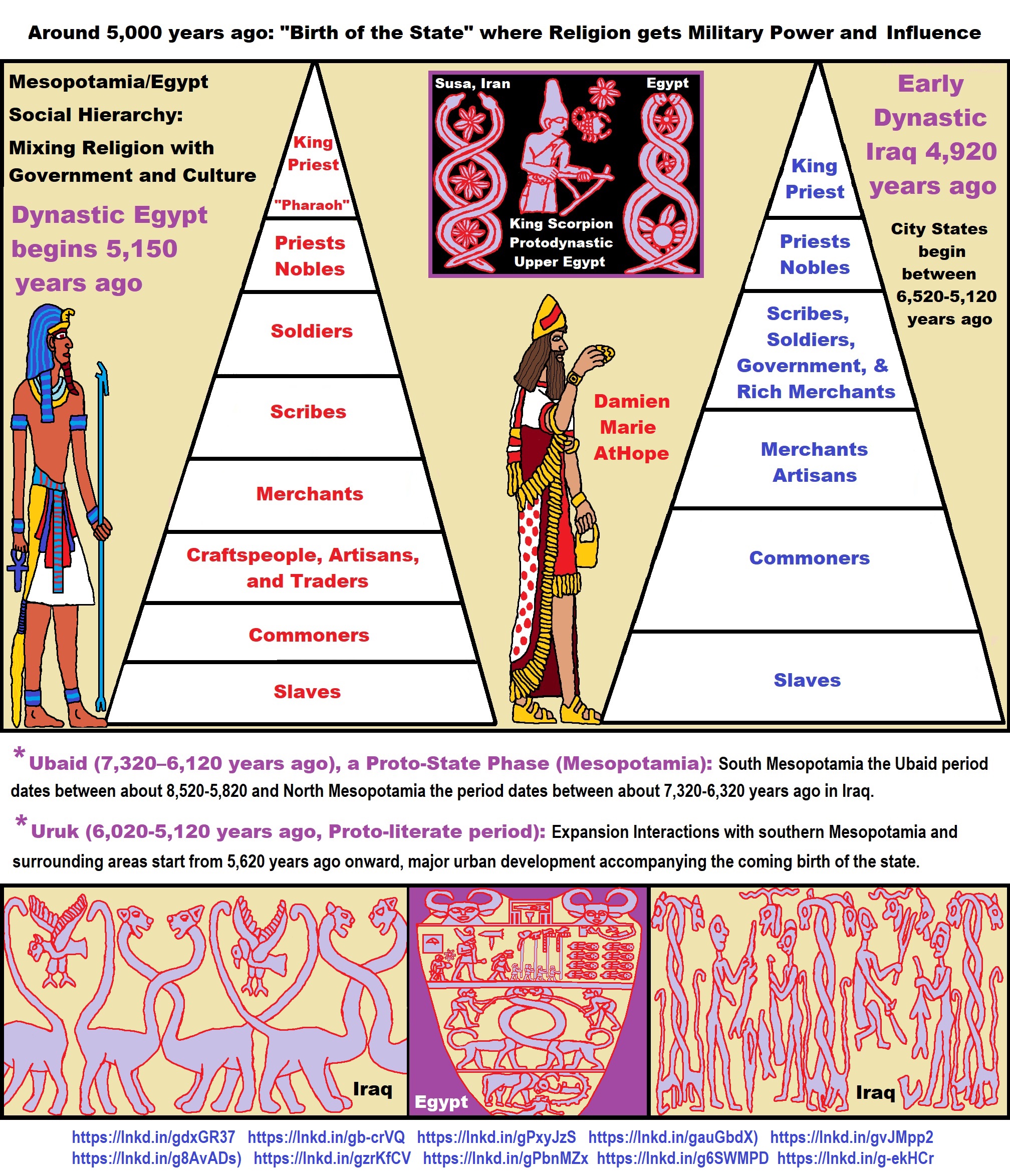
ref, ref, ref, ref, ref, ref, ref, ref, ref
Mesopotamia/Egypt Social Hierarchy: Mixing Religion with Government and Culture
*Ubaid (7,320–6,120 years ago): a Proto-State Phase (Mesopotamia): South Mesopotamia the Ubaid period dates between about 8,520-5,820 and North Mesopotamia the period dates between about 7,320-6,320 years ago in Iraq. ref
“The Ubaid period (c. 6500–3800 BCE or around 8,520-5,820 years ago) is a prehistoric period of Mesopotamia. The name derives from Tell al-‘Ubaid where the earliest large excavation of Ubaid period material was conducted initially by Henry Hall and later by Leonard Woolley. In South Mesopotamia, the period is the earliest known period on the alluvial plain although it is likely earlier periods exist obscured under the alluvium. In the south, it has a very long duration between about 6500 – 3800 BCE when it is replaced by the Uruk period. In North Mesopotamia, the period runs only between about 5300 – 4300 BCE or 7,320-6,320 years ago. It is preceded by the Halaf period and the Halaf-Ubaid Transitional period and succeeded by the Late Chalcolithic period.” ref
*Uruk (6,020-5,120 years ago, Proto-literate period): Expansion Interactions with southern Mesopotamia and surrounding areas start from 5,620 years ago onward, with major urban development accompanying the coming birth of the state. ref
“The Uruk period (ca. 4000 to 3100 BCE) existed from the protohistoric Chalcolithic to Early Bronze Age period in the history of Mesopotamia, after the Ubaid period and before the Jemdet Nasr period. Named after the Sumerian city of Uruk, this period saw the emergence of urban life in Mesopotamia and the Sumerian civilization. The late Uruk period (34th to 32nd centuries BCE) saw the gradual emergence of the cuneiform script and corresponds to the Early Bronze Age; it has also been described as the “Protoliterate period”. It was during this period that pottery painting declined as copper started to become popular, along with cylinder seals.” ref
The First City
“The first cities which fit both Chandler’s and Wirth’s definitions of a “city” and especially the City State developed in the region known as Mesopotamia between 4500 and 3100 BCE or 6,520-5,120 years ago. The city of Uruk, today considered the oldest in the world, was first settled in c. 4500 BCE or 6,520 years ago and walled cities, for defense, were common by 2900 BCE throughout the region. The city of Eridu, close to Uruk, was considered the first city in the world by the Sumerians while other cities that lay claim to the title of “first city” are Byblos, Jericho, Damascus, Aleppo, Jerusalem, Sidon, Luoyang, Athens, Argos, and Varasani. All of these cities are certainly ancient and are located in regions that have been populated from a very early date. Uruk, however, is the only contender for the title of `oldest city’ which has physical evidence and written documentation, in the form of cuneiform texts, dating the activities of the community from the earliest period. Sites such as Jericho, Sidon, and even Eridu, which were no doubt settled before Uruk, lack the same sort of documentation. Their age and continuity of habitation has been gauged based upon the foundations of buildings unearthed in archaeological excavations rather than primary documents found on site.” ref
“Historical city-states included Sumerian cities such as Uruk and Ur; Ancient Egyptian city-states, such as Thebes and Memphis; the Phoenician cities (such as Tyre and Sidon); the five Philistine city-states; the Berber city-states of the Guarantees; the city-states of ancient Greece (the poleis such as Athens, Sparta, Thebes, and Corinth); the Roman Republic (which grew from a city-state into a great power); the Mayan and other cultures of pre-Columbian Mesoamerica (including cities such as Chichen Itza, Tikal, Copán and Monte Albán); the central Asian cities along the Silk Road; the city-states of the Swahili coast; the Italian city-states, such as Florence, Siena, Genoa, Venice and Ferrara; Ragusa; states of the medieval Russian lands such as Novgorod and Pskov; and many others. Danish historian Poul Holm has classed the Viking colonial cities in medieval Ireland, most importantly Dublin, as city-states.” ref
What is a City-state?
“A city-state is an independent sovereign city which serves as the center of political, economic, and cultural life over its contiguous territory. They have existed in many parts of the world since the dawn of history, including cities such as Rome, Athens, Carthage, and the Italian city-states during the Middle Ages and Renaissance, such as Florence, Venice, Genoa, and Milan. With the rise of nation-states worldwide, only a few modern sovereign city-states exist, with some disagreement as to which qualify; Monaco, Singapore, and Vatican City are most commonly accepted as such. Singapore is the clearest example: with full self-governance, its own currency, a robust military, and a population of 5.6 million.” ref
Population in Ancient Cities
“The population of ancient cities, depending upon which definition of `city’ one uses, differed sharply from what one might consider proper for a city in the modern-day. Professor Smith claims, “Many ancient cities had only modest populations, often under 5,000 persons” while other scholars, such as Modelski, cite higher population possibilities in the range of 10,000 to 80,000 depending upon the period under consideration. Modelski, for example, cites the population of Uruk at 14,000 in the year 3700 BCE or 5,720 years ago, but 80,000 by the year 2800 BCE or 4,820 years ago. Historian Lewis Mumford, however, notes that “Probably no city in antiquity had a population of much more than a million inhabitants, not even Rome; and, except for China, there were no later “Romes” until the nineteenth century”. Mumford’s point highlights the problem of using population as a means of defining an ancient city as it has been proven that urban centers designated `settlements’ (such as Tell Brak) had larger populations than many modern cities in the present day. The gathering of the populace of a region into an urban center became more and more common following the rise of the cities in Mesopotamia and, once enclosed within the walls of a city, the population increased or, at least, such an increase became more measurable.” ref
Early Dynastic Period (Egypt) 5,170 – 4,706 years ago
“The Archaic or Early Dynastic Period of Egypt (also known as Thinite Period, from Thinis, the supposed hometown of its rulers) is the era immediately following the unification of Upper and Lower Egypt around 3100 BCE or 5,120 years ago. It is generally taken to include the First and Second Dynasties, lasting from the end of the Naqada III archaeological period until about 2686 BC, or the beginning of the Old Kingdom. With the First Dynasty, the capital moved from Thinis to Memphis with a unified Egypt ruled by an Egyptian god-king. Abydos remained the major holy land in the south. The hallmarks of ancient Egyptian civilization, such as art, architecture, and many aspects of religion, took shape during the Early Dynastic Period. Before the unification of Egypt, the land was settled with autonomous villages. With the early dynasties, and for much of Egypt’s history thereafter, the country came to be known as the Two Lands. The pharaohs established a national administration and appointed royal governors. The buildings of the central government were typically open-air temples constructed of wood or sandstone. The earliest Egyptian hieroglyphs appear just before this period, though little is known of the spoken language they represent.” ref
Early Dynastic Period (Mesopotamia: Mainly “Iraq”)
“The Early Dynastic period is an archaeological culture in Mesopotamia (modern-day Iraq) that is generally dated to c. 2900–2350 BC and was preceded by the Uruk and Jemdet Nasr periods. It saw the development of writing and the formation of the first cities and states. The Early Dynastic period itself was characterized by the existence of multiple city-states: small states with a relatively simple structure that developed and solidified over time. This development ultimately led to the unification of much of Mesopotamia under the rule of Sargon, the first monarch of the Akkadian Empire. Despite this political fragmentation, the Early Dynastic period city-states shared a relatively homogeneous material culture. Sumerian cities such as Uruk, Ur, Lagash, Umma, and Nippur located in Lower Mesopotamia were very powerful and influential. To the north and west stretched states centered on cities such as Kish, Mari, Nagar, and Ebla. The study of Central and Lower Mesopotamia has long been given priority over neighboring regions. Archaeological sites in Central and Lower Mesopotamia—notably Girsu but also Eshnunna, Khafajah, Ur, and many others—have been excavated since the 19th century. These excavations have yielded cuneiform texts and many other important artifacts. As a result, this area was better known than neighboring regions, but the excavation and publication of the archives of Ebla have changed this perspective by shedding more light on surrounding areas, such as Upper Mesopotamia, western Syria, and southwestern Iran. These new findings revealed that Lower Mesopotamia shared many socio-cultural developments with neighboring areas and that the entirety of the ancient Near East participated in an exchange network in which material goods and ideas were being circulated.” ref
“The First Dynasty of Ur was a 26th century-25th century BCE or 4,620-4,520 years ago, the dynasty of rulers of the city of Ur in ancient Sumer. It is part of the Early Dynastic period III of the History of Mesopotamia. It was preceded by the earlier First dynasty of Kish and the First Dynasty of Uruk. Like other Sumerians, the people of Ur were a non-Semitic people who may have come from the east circa 3300 BCE or 5,320 years ago, and spoke a language isolate. But during the 3rd millennium BC, a close cultural symbiosis developed between the Sumerians and the East-Semitic Akkadians, which gave rise to widespread bilingualism. The reciprocal influence of the Sumerian language and the Akkadian language is evident in all areas, from lexical borrowing on a massive scale, to syntactic, morphological, and phonological convergence. This has prompted scholars to refer to Sumerian and Akkadian in the 3rd millennium BCE or 5,020-3,020 years ago as a Sprachbund. Sumer was conquered by the Semitic-speaking kings of the Akkadian Empire around 2270 BCE or 4,290 years ago (short chronology), but Sumerian continued as a sacred language. Native Sumerian rule re-emerged for about a century in the Third Dynasty of Ur at approximately 2100–2000 BCE or 4,120-4,020 years ago, but the Akkadian language also remained in use.” ref
Before the First Mesopotamian Dynasty
“The more eminent time period preceding the First Dynasty, but taking place after the reign of Sargon the Great (the first ruler of the Akkadian Empire, around 2334–2284 BCE or 4,354-4,304 years ago), is referred to as the Third Dynasty of Ur or the Ur III period. This time period took place during the end of the third millennium BCE or 5,020-4,020 years ago and early second millennium BCE or 4,020-3,020 years ago. Common behaviors of the kings during this time period, especially Ur-Namma and Shulgi, included reunifying Mesopotamia and developing rules for the kingdom to abide by. Most notably, these rulers of Ur contributed to the development of ziggurats, which were religious monumental stepped towers that would in turn bring religious peoples together. In order to gain and retain power, it was not unfamiliar for Ur princesses to marry the kings of Elam; Elaminites were a commonly known enemy of Mesopotamians. Ur rulers would also, along with arranged marriage, send gifts and letters to other rulers as a peace offering. This is known because of the hefty amount of administrative records dating to the Ur III period.” ref
“The First Babylonian Empire, or Old Babylonian Empire, is dated to around 1894 – 1595 BCE or 3,914-3,615 years ago, and comes after the end of Sumerian power with the destruction of the 3rd dynasty of Ur, and the subsequent Isin-Larsa period. The chronology of the first dynasty of Babylonia is debated as there is a Babylonian King List A and a Babylonian King List B. In this chronology, the regnal years of List A are used due to their wide usage. The reigns in List B are longer, in general.” ref
Around 5,000 years ago: “Birth of the State” where Religion gets Military Power and Influence

ref, ref, ref, ref, ref, ref, ref, ref, ref, ref, ref, ref, ref, ref
“The ancient Hebrew alephbet has very little resemblence to the modern Hebrew alephbet, though the modern did evolve out of the ancient. The ancient twenty-two Hebrew letters were originally pictures of animals, tools or parts of the body.” ref
“Palaeo-Hebrew alphabet, is a variant of the Phoenician alphabet. Like the Phoenician alphabet, the Paleo-Hebrew alphabet contains 22 letters, all of which are consonants, and is described as an abjad. It apples to the term Phoenician to the script of the Hebrews is hardly suitable”. Still, the script is nearly identical to the Phoenician script. Archeological evidence of the use of the script by the Israelites for writing the Hebrew language dates to around the 10th century BCE. The Paleo-Hebrew alphabet began to fall out of use by the Jews in the 5th century BCE, when the Aramaic alphabet was adopted as the predominant writing system for Hebrew. The present Jewish “square-script” Hebrew alphabetevolved from the Aramaic alphabet. The Samaritans, now fewer than 1,000 people, have continued to use a derivative of the Paleo-Hebrew alphabet, known as the Samaritan alphabet. While the use of the script is negligible nowadays, it is present in some symbolic usage, such as the ₪1 coin and the logo of the Israeli town Nahariyah.” ref
Traces of Totemism In Judaism
Totemism (theoretical belief in a mythical relationship with powers/spirits through a totem item). Believe in spirit-filled life and/or afterlife can be attached to or be expressed in things or objects (you are a hidden totemist/Totemism: an approximately 50,000-year-old belief system)
“A totem is any species of plants or animals thought to possess supernatural powers. Each group within the society may have its own totem, including associated ceremonies. Totemic beliefs may not be as foreign to the Western mind as first expected; many Westerners have totems. School mascots, symbols, and emblems all constitute totems.” Ref
“The investigation of totemism is strictly the work of the anthropologist. Its mention in a study of this kind is necessitated by the fact that some maintain that the idea of a god was evolved from the idea of a totem and that honors to a god were but a form of magnification of honors to a totem. The eating of a sacrifice offered to a god was accordingly explained upon the basis of eating the god and thus incorporating his qualities. It is maintained by some and contested by others that every tribe of people has retained vestiges of original totemism and that therefore totemism is a true ancestor of religion. Scholars differ upon the thesis of the universality of early totemism. Totemistic practices are widely variant and totemism itself is a social philosophy rather than a religious tenet. Moreover, it is not necessary to suppose that the social and religious development of every people has been mechanically identical. After the entrance of human intellect and will upon the scene, it is impossible to make an accurate prediction of the succession of stages of progress, unless one is in possession of all the factors of choice. All that we can say is that totemism is a social state in which many peoples have once probably lived and some have surely lived. It is certainly one form which the eating of the sacred meal may have taken. It seems, however, to have been a sort of social excursion rather than a definite step in religious development. Since it was preceded by earlier social forms of life, it cannot be regarded as the origin of religion or of anything else.” Ref
Excerpts from the book Orpheus: A General History of Religions
By Salomon Reinach
“The Hebrews abstain from killing or eating animals such as the pig, whose ancestors (wild boars) had been the totems of their forefathers. These animals are designated either as sacred or unclean, two over-precise terms, which, if traced back to their origins, will be reduced to the idea of taboo, or prohibition. At a much later period it is suggested that the flesh of these animals was unwholesome, or that those ‘-who Rte it might contract vices of character. The Mosaic law merely formulates prohibitions which were already ancient; the Jews themselves believed these prohibitions to have been anterior to the Flood, for when Noah is about to take refuge in the Ark, the Eternal orders him to take with him two couples of every unclean beast and seven couples of every clean beast, without explaining what these words meant (Gen. vii. !!). Another evidence of the sacred character of the animals described 88 unclean was the clandestine custom reprobated by Isaiah (\xvi. 17): “They that sanctify themselves and purify themselves in the garden … eating swine’s flesh, and the abomination and the mouse, shall be consumed together, saith the Lord.” Here we have evidently the survival of one of these periodic sacrifices of totems, in which men sought to sanctify themselves by eating some sacred meat, the general use of which was forbidden. I will not insist on those names of men and tribes which are compounded of the names of animals, for it may always be objected to that these were merely nicknames; but the worship of that these were merely nicknames; but the worship of the bull and of the serpent among the Hebrews is an indubitable survival of totemism.” Ref
“It seems very probable that Jehovah was long represented by a bull. Portable gilded images of bulls were consecrated by Jeroboam (1 Kings, xii. !e8); the prophet Hosea inveighed against the worship of the bull in the kingdom of Israel (Hos. viii. 5; x. 5). The famous golden calf of the Israelites, the object of Moses’ anger, had nothing to do with the bull Apis, which was a live animal; it was a totemic idol of are compounded of the names of animals, for it may always be objected that these were merely nicknames; but the worship of the ‘bull and of the serpent among the Hebrews is an indubitable survival of totemism. It seems very probable that Jehovah was long by a bull. Portable gilded images of bulls were consecrated by Jeroboam (1 Kings, xii. !e8); the prophet Hosea inveighed against the worship of the bull in the kingdom of Israel (Hos. viii. 5; x. 5). The famous golden calf of the Israelites, the object of Moses’ anger, had nothing to do with the bull Apis, which was a live animal; it was a totemic idol of Isrealites, the object of Moses’ anger, had nothing to do with the bull Apis, which was a live animal; it was a totemic idol of a kind commonly found in the land of Canaan, where the bull “as the symbol, that is to say, the incarnation of a Baal. Although the law of Moses was hostile to every kind of idolatry, the worship of the serpent was practiced by Moses himself, who transformed his magic wand into a serpent (Ex. vii. 9-U) and made a brazen serpent to heal the people of the bites of serpents (Numbers xxi. 9). A brazen serpent, perhaps a totem of David’s family, was worshipped in the temple of Jerusalem and was only destroyed by He7.ekiah about 700 B.C. (2 Kings, xviii. 4).” Ref
“The prophetess Deborah, whose name means a bee, was no doubt like those priestesses of Diana of Ephesus who were called (melimii), the ministrant of a totemic worship of this insect. Samson, the lion.slayer, was probably a lion, whose strength.. lay in his luxuriant tawny mane. This lion was strength lay in his luxuriant tawny mane. This lion was identified with the SUD, as in Babylonia, hence the analogy of Samson’s name with that of the Babylonian solar god, Slumuuh. I might multiply these examples, and speak of Balaam’s eloquent ass, which may be compared with the Greek tradition of an ass- I headed god worshipped by the Israelites possibly those of Samaria-and the >part played by the ass in Zechariah ix. 9, and in the account of Christ’s entry into Jenlsalem. The dove which descended from Heaven upon Jesus at his baptism was also an ancient Syrian totem. I have already mentioned the fish, a Syrian totem adopted by the Jews, and the early Christians (p. iO). Of course, the Jews were unconscious totemists. Like all other peoples, they must have ceased to be totemists, in the strict sense of the word, as soon they owned domestic animals. Totemic worship is generally incompatible with the possession of cattle. SO. In opposition to the heathen races who surrounded Israel and whose practices were constantly alluring them, the Jewish priesthood, the authors of the Old Testament, were Jewish priesthood, the authors of the Old Testament, were hostile to all magic, and also to the popular belief in a future life, which was likely to result in the evocation of the dead or necromancy. But this strategy of animism is so natural to man that the Bible nevertheless contains numerous instances of it. Moses and Aaron were magicilUls who rivalled Pharaoh’. magicians (Ex. vii. 11-00). Balaam was a magician who pronounced incantations against Israel, and afterwards passed over to the service of Jehovah (Numbers xxii. et 8eq.; Micah vi. 5.” Ref
“Jacob resorted to a kind of sympathetic magic to procure the birth of speckled sheep (Gen. xxx. 89). Divination, which is the use of magic to discover the will of spiritual beings, was practiced by means Urim and Thummim , a kind of dice enclosed in a sacred receptacle called an ephod. “Thou shalt not suffer a witch to live it is written in Exodus xxii. Fatal words which the Christian Churches have obeyed only too faithfully! They offered at once an affirmation of the reality of witchcraft, and a tendency which still survives even in these days to look upon witchcraft as an appanage of the weaker sex. Both churches and secular tribunals have burnt favorite witches than wizards. The herem, or vow of destruction, tabooed everything; hence the sin of preserving anything in Jericho (Joshua vii). Some think that the notion of unclean animals was brought from Egypt with the rite of circumcision. This rite was probably part of a tribal initiation-ceremony, afterwards performed at an earlier time of life, but it was not a Semitic heritage, as it is unknown to the Eastern Semites and to the Philistines.’ The worship of stones, trees, wells, and serpents may have been agricultural or nomadic.· So too of such traits as fasting (Neh. ix. I); absence of the lex talionis (Gen. iv. 23); the practice of the Rechabites (Jer. xxxv.); the use of bitter water as an oracle; the scape-goat, etc. These are primitive, but whether nomadic or not is uncertain.’ The ark may well have been a survival of nomadic life. It’ served as an oracle and was taboo to the touch (I Sam. ivviL). It is said to have contained (meteoric?) stones. The ark of Shiloh may have been the home of the Lord of the practice of the Rechabites (Jer. xxxv.); the use of bitter water as an oracle; the scape-goat, etc. These are primitive, but whether nomadic or not is uncertain.’ The ark may well have been a survival of nomadic life. It served as an oracle and was taboo to the touch (I Sam. ivvii.). It is said to have contained (meteoric?) stones. The ark of Shiloh may have been the home of the Lord of Shechem, Baal-Berith, afterward identified with Yahweh.” Ref
From TOTEMISM: By: Joseph Jacobs
A primitive social system in which members of a clan reckoned kinship through their mothers, and worshiped some animal or plant which they regarded as their ancestor and the image of which they bore tattooed on their persons. The following are the chief arguments in favor of the existence of totem clans among the ancient Israelites:
I. Animal and Plant Names: Arguments in Favor of Totemism.
“A considerable number of persons and places in the Old Testament have names derived from animals or plants. Jacobs (“Studies in Biblical Archæology,” pp. 94-103) has given a list of over 160 such names, including Oreb (the raven) and Zeeb (the wolf), princes of the Midianites; Caleb (the dog), Tola (the worm), Shual (the fox), Zimri (the chamois), Jonah (the dove), Huldah (the weasel), Jael (the ibex), Nahash (the serpent), Kezia (the cassia), Shaphan (the rock-badger), Ajalon (the great stag), and Zeboim (the hyena). Many of these, however, are personal names; but among the Israelitish tribes mentioned in Num. xxvi. are the Shualites, or fox clan of Asher; the Shuphamites, or serpent clan of Benjamin; the Bachrites, or camel clan; and the Arelites, or lion clan of Gad. Other tribes having similar names are the Zimrites, or hornet clan, and the Calebites, or dog tribe. In the genealogy of the Horites (Gen. xxxvi.) several animal names occur, such as Shobal (the young lion), Zibeon (the hyena), Anah (the wild ass), Dishan (the gazel), Akan (the roe), Aiah (the kite), Aran (the ass), and Cheran (the lamb). The occurrence of such a large number of animal names in one set of clan names suggests the possibility that the Horites, who were nomads, were organized on the totem-clan system.” Ref
II. Exogamy
“is the system under which any member of a clan may not marry within his own clan, but must marry a member of a kindred clan. Smith deduces the existence of such clans among the Horites from the mention of Anah clans and Dishan clans in the list. He also draws attention to Shimeis among the Levites, Reubenites, and Benjamites. Female descent is the only means of tracing kinship in exogamous clans; and Smith sees a survival of this in the case of the marriage of Abraham and Sarah, who were not of the same mother, while Abimelech appealed to his mother’s clan as being of his flesh (Judges viii. 19), and Naomi told Ruth to return to her mother’s house (Ruth i. 8) .” Ref
III. Ancestor and Animal Worship:
“Smith attributes the friendship between David and Nahash, King of the Ammonites, to the fact that they were both members of a serpent clan spread throughout Canaan. That animals were worshiped among the Hebrews is well known, as is shown by the legends of the golden calf and the brazen serpent. The second commandment prohibits this. Smith draws attention to the case of animal worship in Ezek. viii. 7-11, where Ezekiel sees “every form of creeping things, and abominable beasts, and all the idols of the house of Israel, portrayed upon the wall round about,” and in the midst of them stood Jaazaniah ben Shaphan (the rock-badger), “with every man his censer in his hand, and a thick cloud of incense went up.” Here there is animal worship connected with the name of a person who appears to be connected with an unclean beast, the “shaphan.” See also Ancestor Worship.” Ref
IV. Forbidden Food:
Members of a totem clan did not eat the totem animal. As such totems gradually spread throughout the nation, a list of forbidden animals would arise which might be analogous to the list of forbidden animals given in Lev. xi. and Deut. xv. Jacobs, however, has shown that in the list of animal names given by him forty-three are clean as against forty-two unclean.” Ref
V. Tattooing and Clan Crests: Absence of Historic Connection.
“A totem is tattooed on the skin of the totem worshiper; and there is evidence in Lev. xix. 28 that the Israelites were forbidden to make tattoo-marks, while an allusion to this practise may be contained in Isa. xliv. 5 and in Ezek. ix. 4. The mark of Cain may perhaps have been a tattoo-mark. In none of these instances, however, are there indications that the tattoo-marks were in an animal form or connected with animal worship. The tribes of Israel when on the marchhad standards (Num. i. 52, ii. 2 et seq.); and rabbinic literature gives details of the crests (see Flag), which were derived from the blessings of Jacob (Gen. xlix.) and Moses (Deut. xxxiii.). In these most of the tribes are compared to an animal: Judah to a lion; Issachar to an ass; Dan to a serpent; etc. In Moses’ blessing, however, Dan is compared to a lion’s whelp, which seems to show that the tribes were not arranged on a totemic system.” Ref
VI. Blood Feud:
“The practical side of the totem system insured the existence of relatives scattered throughout a tribe, who would guarantee the taking up of the blood feud in case one of the members of the totem clan was injured or killed. The existence of the blood feud can be recognized in Israel (see Go’el), but there is no evidence of a connection with totemism. Altogether, while traces and survivals are found of institutions similar to those of the totem clan, there is not sufficient evidence to show that it existed in Israel during historic times, though it is possible that some such system was found among the Edomites.” Ref
Anthropomorphic cult statues were a major focus of religious practice in Mesopotamia, Egypt, and the Levant. These images provided a focal point for worshippers to experience the deity ‘face-to-face’ in the context of religious festivals and temple service. Deities were thought to be manifest in their cult statues, where they could taste and smell votive offerings and hear worshipper’s prayers. There was no one biblical understanding of divine images. The various law codes, for example, prohibit different things:
Decalogue Exod 20:4 = Deut 5:8 “You will not make a hewn image (pesel) whether in the form of anything that is in heaven above or on earth below or in the waters below the earth.” [Only hewn images are prohibited.]
Covenant Code Exod 20:23 “You will not make gods of silver alongside me (ˀittî) nor will you make gods of gold for yourselves.” [This verse seems to suggest that Yahweh had the exclusive right to be represented in cult statues]
Holiness Code Lev 19:4 “Do not turn to idols (hā-ˀĕlîlîm) nor make cast images of gods (ˀĕlōhê massēkâ) for yourselves!”
Holiness Code Lev 26:1 “You will not make idols (ˀĕlîlîm) or a hewn image (pesel) for yourselves. And you will not erect a standing stone (maṣṣēbâ) for yourselves or put a figured stone (ˀaben maśkît) to worship it.”
Covenant Curses Deut 27:15 “Cursed be the man who makes a hewn image (pesel) or cast image (massēkâ), abhorrent to the lord, the work of the hands of the artisan and sets it up in secret.”
‘Ritual’ Decalogue Exod 34:17 “You will not make cast images of gods (ˀĕlōhê massēkâ) for yourself.”
These laws are normative. The proliferation of prohibitions suggests that images continued to be made, which fits archaeological and biblical data.
Excavators found a bronze bull figurine dated to ca. 1200 b.c.e. at Dothan near Samaria in what is believed to be a cult site. It is unclear, however, whether this site was Israelite at this time period. Nevertheless, the figurine recalls the bull statues that Jereboam installed in Dan and Bethel (1 Kgs 12:28-29). Ref
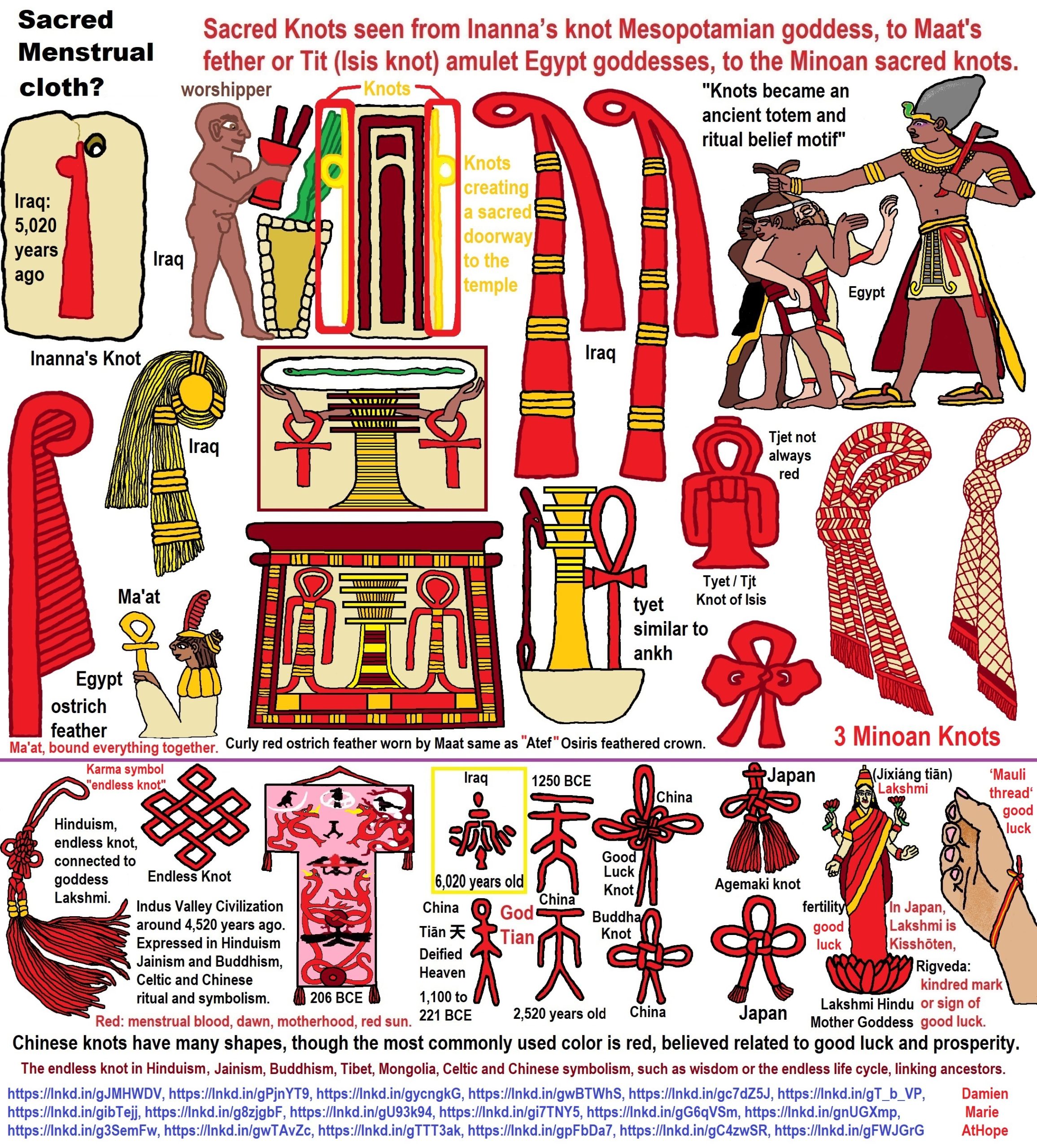
ref, ref, ref, ref, ref, ref, ref, ref, ref, ref, ref, ref, ref, ref, ref, ref, ref, ref, ref, ref, ref, ref, ref, ref
Confucianism’s Tiān (Shangdi god 4,000 years old): Supernaturalism, Pantheism or Theism?
The Venus symbol () consists of a circle with a small cross below it. It originates in Late Antiquity as an astrological symbol for the planet Venus (associated with the goddess Venus), and hence as alchemical symbol for copper. In modern times, it is still used as the astronomical symbol for Venus, although its use is discouraged by the International Astronomical Union. The ancient oracle and bronze ideograms for dà 大 depict a (headless?) stick figure person with arms stretched out. Ref
However, the sinologist Herrlee Creel, who wrote a comprehensive study on “The Origin of the Deity T’ien” (1970:493–506), gives this overview. For three thousand years it has been believed that from time immemorial all Chinese revered T’ien 天, “Heaven,” as the highest deity, and that this same deity was also known as Ti 帝 or Shang Ti 上帝. But the new materials that have become available in the present century, and especially the Shang inscriptions, make it evident that this was not the case. It appears rather that T’ien is not named at all in the Shang inscriptions, which instead refer with great frequency to Ti or Shang Ti. T’ien appears only with the Chou, and was apparently a Chou deity. After the conquest the Chou considered T’ien to be identical with the Shang deity Ti (or Shang Ti), much as the Romans identified the Greek Zeus with their Jupiter. Ref
Tian (天), a Chinese religious concept, often translated as “Heaven”
“Having established that Tian was not a deity of the Shang people, Creel (1970:501–6) proposes a hypothesis for how it originated. Both the Shang and Zhou peoples pictographically represented da 大 as “a large or great man”. The Zhou subsequently added a head on him to denote tian 天 meaning “king, kings” (cf. wang 王 “king; ruler”, which had oracle graphs picturing a line under a “great person” and bronze graphs that added the top line). From “kings”, tian was semantically extended to mean “dead kings; ancestral kings”, who controlled “fate; providence”, and ultimately a single omnipotent deity Tian “Heaven”. In addition, tian named both “the heavens” (where ancestral kings and gods supposedly lived) and the visible “sky”. Another possibility is that Tian may be related to Tengri and possibly was a loan word from a prehistoric Central Asian language.” Ref
So, to me, it could be that the first monotheism god was from Aisa, not the middle east around 4,000 years ago?
Single God Religions (Monotheism) = Man-o-theism started around 4,000 years ago?
“The modern Chinese character天 and early seal script both combine dà大 “great; large” and yī一 “one”, but some of the original characters in Shāng oracle bone script and Zhōu bronzeware script anthropomorphically portray a large head on a great person. The ancient oracle and bronze ideograms for dà 大 depict a stick figure person with arms stretched out denoting “great; large”. The oracle and bronze characters for tiān 天 emphasize the cranium of this “great (person)”, either with a square or round head, or head marked with one or two lines. Schuessler (2007:495) notes the bronze graphs for tiān, showing a person with a round head, resemble those for dīng丁 “4th Celestial stem“, and suggests “The anthropomorphic graph may or may not indicate that the original meaning was ‘deity’, rather than ‘sky’.” Two variant Chinese characters for tiān 天 “heaven” are 兲 (written with 王wáng “king” and 八bā “8”) and the Daoist coinage 靝(with 青qīng “blue” and 氣 “qì“, i.e., “blue sky”) .” ref, ref
“Tian was the name in modern languages include Mongolian: Тэнгэр (“sky”), Bulgarian: Тангра, Azerbaijani: Tanrı. The Chinese word for “sky” 天 (Mandarin: tiān, Classical Chinese: thīn] and Japanese Han Dynasty loanword ten) may also be related, possibly a loan from a prehistoric Central Asian language. .” ref, ref
“Tengri (Old Turkic: ????????????????; Bulgarian: Тангра; Modern Turkish: Tanrı; Proto-Turkic *teŋri / *taŋrɨ; Mongolian script: ᠲᠩᠷᠢ, Tngri; Modern Mongolian: Тэнгэр, Tenger), is one of the names for the primary chief deity since the early Turkic (Xiongnu, Hunnic, Bulgar) and Mongolic (Xianbei) peoples. Worship of Tengri is Tengrism. The core beings in Tengrism are Heavenly-Father (Tengri/Tenger Etseg) and Earth Mother (Eje/Gazar Eej). It involves shamanism, animism, totemism and ancestor worship. The Turkic form, Tengri, is attested in the 8th century Orkhon inscriptions as the Old Turkic form ???????????????? Teŋri. In modern Turkish, the derived word “Tanrı” is used as the generic word for “god”, or for the Abrahamic God, and is used today by Turkish people to refer to any god. The supreme deity of the traditional religion of the Chuvash is Tură..” ref, ref
“Tengri was the national god of the Göktürks, described as the “god of the Turks” (Türük Tängrisi). The Göktürk khans based their power on a mandate from Tengri. These rulers were generally accepted as the sons of Tengri who represented him on Earth. They wore titles such as tengrikut, kutluġ or kutalmysh, based on the belief that they attained the kut, the mighty spirit granted to these rulers by Tengri. Tengri was the chief deity worshipped by the ruling class of the Central Asian steppe peoples in 6th to 9th centuries (Turkic peoples, Mongols and Hungarians). It lost its importance when the Uighuric kagans proclaimed Manichaeism the state religion in the 8th century. The worship of Tengri was brought into Eastern Europe by the Huns and early Bulgars. Tengri is considered to be the chief god who created all things. In addition to this celestial god, they also had minor divinities (Alps) that served the purposes of Tengri. As Gök Tanrı, he was the father of the sun (Koyash) and moon (Ay Tanrı) and also Umay, Erlik, and sometimes Ülgen.” ref, ref
Confucianism revolves around the pursuit of the unity of the self and Tiān (Heaven, or the traditional high god of the Zhou), and the relationship of humankind to the Heaven.
“Although Confucianism is often followed in a religious manner by the Chinese, many argue that its values are secular and that it is, therefore, less a religion than a secular morality. Proponents argue, however, that despite the secular nature of Confucianism’s teachings, it is based on a worldview that is religious. Confucianism discusses elements of the afterlife and views concerning Heaven, but it is relatively unconcerned with some spiritual matters often considered essential to religious thought, such as the nature of souls. However, Confucius is said to have believed in astrology, saying: “Heaven sends down its good or evil symbols and wise men act accordingly”. n the Analects, Confucius presents himself as a “transmitter who invented nothing”. .” ref, ref
“The principle of Heaven (Tiān lǐ 天理 or Dào 道), is the order of the creation and divine authority, monistic in its structure. Tiān (天), a key concept in Chinese thought, refers to the sky, or the heavens, nature, “heaven and earth” (that is, “all things”), and to the awe-inspiring forces beyond human control. Confucius used the term in a religious way. He wrote in the Analects (7.23) that Tian gave him life, and that Tian watched and judged. (6.28; 9.12). A person can know the movement of the Tiān, giving the sense of having a special place in the universe. (9.5) Confucius wrote that Tian spoke to him, though not in words (17.19), but the scholar Ronnie Littlejohn warns that Tian was not a personal God comparable to the God of the Abrahamic faiths in the sense of an independent creator or transcendent Being. When Confucians spoke of Tian they often meant something like what the Taoists meant by Tao (Dào): “the way things are” or “the regularities of the world.” Tiān can also be compared to the Brahman of Hindu and Vedic traditions. Zǐgòng, a disciple of Confucius, said that Tiān had set the master on the path to become a wise man (Analects 9.6). In Analects 7.23 Confucius says that he has no doubt left that the Tiān gave him life, and from it he had developed the virtue (Dé, 德). In Analects 8.19 he says that the lives of the sages and their communion with Tian are interwoven. Regarding personal gods (shén, energies who emanate from and reproduce the Tiān) enliving nature, in Analects 6.22 Confucius says that it is appropriate (義/义, yì) for people to worship (敬, jìng) them, though through proper rites (禮/礼, lǐ), implying respect of positions and discretion.” ref, ref
“The concept of Heaven (Tian, 天) is pervasive in Confucianism. Confucius had a deep trust in Heaven and believed that Heaven overruled human efforts. He also believed that he was carrying out the will of Heaven, and that Heaven would not allow its servant, Confucius, to be killed until his work was done. Many attributes of Heaven were delineated in his Analects.” ref
“Confucius honored Heaven as the supreme source of goodness: The Master said, “Great indeed was Yao as a sovereign! How majestic was he! It is only Heaven that is grand, and only Yao corresponded to it. How vast was his virtue! The people could find no name for it. How majestic was he in the works which he accomplished! How glorious in the elegant regulations which he instituted!” (VIII, xix, tr. Legge 1893:214). Confucius felt himself personally dependent upon Heaven (VI, xxviii, tr. Legge 1893:193): “Wherein I have done improperly, may Heaven reject me! may Heaven reject me!” Confucius believed that Heaven cannot be deceived: The Master being very ill, Zi Lu wished the disciples to act as ministers to him. During a remission of his illness, he said, “Long has the conduct of You been deceitful! By pretending to have ministers when I have them not, whom should I impose upon? Should I impose upon Heaven? Moreover, than that I should die in the hands of ministers, is it not better that I should die in the hands of you, my disciples? And though I may not get a great burial, shall I die upon the road?” (IX, xi, tr. Legge 1893:220-221). Confucius believed that Heaven gives people tasks to perform to teach them of virtues and morality: The Master said, “At fifteen, I had my mind bent on learning. At thirty, I stood firm. At forty, I had no doubts. At fifty, I knew the decrees of Heaven. At sixty, my ear was an obedient organ for the reception of truth. At seventy, I could follow what my heart desired, without transgressing what was right.” (II, iv, tr. Legge 1893:146). He believed that Heaven knew what he was doing and approved of him, even though none of the rulers on earth might want him as a guide: The Master said, “Alas! there is no one that knows me.” Zi Gong said, “What do you mean by thus saying – that no one knows you?” The Master replied, “I do not murmur against Heaven. I do not grumble against men. My studies lie low, and my penetration rises high. But there is Heaven – that knows me!” (XIV, xxxv, tr. Legge 1893:288-9) Perhaps the most remarkable saying, recorded twice, is one in which Confucius expresses complete trust in the overruling providence of Heaven: The Master was put in fear in Kuang. He said, “After the death of King Wen, was not the cause of truth lodged here in me? If Heaven had wished to let this cause of truth perish, then I, a future mortal, should not have got such a relation to that cause. While Heaven does not let the cause of truth perish, what can the people of Kuang do to me?” (IX, v and VII, xxii, tr. Legge 1893:217-8)” ref
“Confucius himself was a ritual and sacrificial master. In Analects 3.12 he explains that religious rituals produce meaningful experiences. Rites and sacrifices to the gods have an ethical importance: they generate good life, because taking part in them leads to the overcoming of the self. Analects 10.11 tells that Confucius always took a small part of his food and placed it on the sacrificial bowls as an offering to his ancestors.” ref, ref, ref
“In original Confucianism the concept of Tiān expresses a form of pantheism. Other philosophical currents, like Mohism, developed a more theistic idea of the Tiān. In Taoism and Confucianism, Tiān (the celestial aspect of the cosmos, often translated as “Heaven”) is mentioned in relationship to its complementary aspect of Dì (地, often translated as “Earth”). These two aspects of Daoist cosmology are representative of the dualistic nature of Taoism. They are thought to maintain the two poles of the Three Realms (三界) of reality, with the middle realm occupied by Humanity (人, Rén),[2] and the lower world occupied by Demons (魔, Mó) and Ghosts (鬼, Guǐ). Tiān (天) is one of the oldest Chinese terms for heaven and a key concept in Chinese mythology, philosophy, and religion.” ref, ref, ref
“During the Shang Dynasty (17–11th centuries BCE), the Chinese referred to their supreme god as Shàngdì (上帝, “Lord on High”) or Dì (帝,”Lord”). During the following Zhou Dynasty, Tiān became synonymous with this figure. Heaven worship was, before the 20th century, an orthodox state religion of China. The modern Chinese character 天 and early seal script both combine dà 大 “great; large” and yī 一 “one”, but some of the original characters in Shāng oracle bone script and Zhōu bronzeware script anthropomorphically portray a large head on a great person. The ancient oracle and bronze ideograms for dà 大 depict a stick figure person with arms stretched out denoting “great; large”. The oracle and bronze characters for tiān 天 emphasize the cranium of this “great (person)”, either with a square or round head, or head marked with one or two lines. Schuessler (2007:495) notes the bronze graphs for tiān, showing a person with a round head, resemble those for dīng 丁 “4th Celestial stem”, and suggests “The anthropomorphic graph may or may not indicate that the original meaning was ‘deity’, rather than ‘sky’.” Two variant Chinese characters for tiān 天 “heaven” are 兲 (written with 王 wáng “king” and 八 bā “8”) and the Daoist coinage 靝 (with 青 qīng “blue” and 氣 “qì”, i.e., “blue sky”). The sinologist Herrlee Creel, who wrote a comprehensive study on “The Origin of the Deity T’ien” (1970:493–506), gives this overview.” ref, ref, ref
“For three thousand years it has been believed that from time immemorial all Chinese revered T’ien 天, “Heaven,” as the highest deity, and that this same deity was also known as Ti 帝 or Shang Ti 上帝. But the new materials that have become available in the present century, and especially the Shang inscriptions, make it evident that this was not the case. It appears rather that T’ien is not named at all in the Shang inscriptions, which instead refer with great frequency to Ti or Shang Ti. T’ien appears only with the Chou, and was apparently a Chou deity. After the conquest the Chou considered T’ien to be identical with the Shang deity Ti (or Shang Ti), much as the Romans identified the Greek Zeus with their Jupiter. (1970:493). Creel refers to the historical shift in ancient Chinese names for “god”; from Shang oracles that frequently used di and shangdi and rarely used tian to Zhou bronzes and texts that used tian more frequently than its synonym shangdi.” ref, ref, ref
“First, Creel analyzes all the tian and di occurrences meaning “god; gods” in Western Zhou era Chinese classic texts and bronze inscriptions. The Yi Jing “Classic of Changes” has 2 tian and 1 di; the Shi Jing “Classic of Poetry” has 140 tian and 43 di or shangdi; and the authentic portions of the Shu Jing “Classic of Documents” have 116 tian and 25 di or shangdi. His corpus of authenticated Western Zhou bronzes (1970:464–75) mention tian 91 times and di or shangdi only 4 times. Second, Creel contrasts the disparity between 175 occurrences of di or shangdi on Shang era oracle inscriptions with “at least” 26 occurrences of tian. Upon examining these 26 oracle scripts that scholars (like Guo Moruo) have identified as tian 天 “heaven; god” (1970:494–5), he rules out 8 cases in fragments where the contextual meaning is unclear. Of the remaining 18, Creel interprets 11 cases as graphic variants for da “great; large; big” (e.g., tian i shang 天邑商 for da i shang 大邑商 “great settlement Shang”), 3 as a place name, and 4 cases of oracles recording sacrifices yu tian 于天 “to/at Tian” (which could mean “to Heaven/God” or “at a place called Tian”.) The Shu Jing chapter “Tang Shi” (湯誓 “Tang’s Speech”) illustrates how early Zhou texts used tian “heaven; god” in contexts with shangdi “god”. According to tradition, Tang of Shang assembled his subjects to overthrow King Jie of Xia, the infamous last ruler of the Xia Dynasty, but they were reluctant to attack.” ref, ref, ref
“The king said, “Come, ye multitudes of the people, listen all to my words. It is not I, the little child [a humble name used by kings], who dare to undertake what may seem to be a rebellious enterprise; but for the many crimes of the sovereign of Hsiâ [Xia] Heaven has given the charge [tianming, see Compounds below] to destroy him. Now, ye multitudes, you are saying, ‘Our prince does not compassionate us, but (is calling us) away from our husbandry to attack and punish the ruler of Hsiâ.’ I have indeed heard these words of you all; but the sovereign of Hsiâ is an offender, and, as I fear God [shangdi], I dare not but punish him. Now you are saying, ‘What are the crimes of Hsiâ to us?’ The king of Hsiâ does nothing but exhaust the strength of his people, and exercise oppression in the cities of Hsiâ. His people have all become idle in his service, and will not assist him. They are saying, ‘When will this sun expire? We will all perish with thee.’ Such is the course of the sovereign of Hsiâ, and now I must go and punish him. Assist, I pray you, me, the one man, to carry out the punishment appointed by Heaven [tian]. I will greatly reward you. On no account disbelieve me; — I will not eat my words. If you do not obey the words which I have spoken to you, I will put your children with you to death; — you shall find no forgiveness.” (tr. James Legge 1865:173–5).” ref, ref, ref
“Having established that Tian was not a deity of the Shang people, Creel (1970:501–6) proposes a hypothesis for how it originated. Both the Shang and Zhou peoples pictographically represented da 大 as “a large or great man”. The Zhou subsequently added a head on him to denote tian 天 meaning “king, kings” (cf. wang 王 “king; ruler”, which had oracle graphs picturing a line under a “great person” and bronze graphs that added the top line). From “kings”, tian was semantically extended to mean “dead kings; ancestral kings”, who controlled “fate; providence”, and ultimately a single omnipotent deity Tian “Heaven”. In addition, tian named both “the heavens” (where ancestral kings and gods supposedly lived) and the visible “sky.” ref, ref, ref
“Another possibility is that Tian may be related to Tengri and possibly was a loan word from a prehistoric Central Asian language (Müller 1870).
The Chinese philosopher Feng Youlan differentiates five different meanings of tian in early Chinese writings:
(1) A material or physical T’ien or sky, that is, the T’ien often spoken of in apposition to earth, as in the common phrase which refers to the physical universe as ‘Heaven and Earth’ (T’ien Ti 天地).
(2) A ruling or presiding T’ien, that is, one such as is meant in the phrase, ‘Imperial Heaven Supreme Emperor’ (Huang T’ien Shang Ti), in which anthropomorphic T’ien and Ti are signified.
(3) A fatalistic T’ien, equivalent to the concept of Fate (ming 命), a term applied to all those events in human life over which man himself has no control. This is the T’ien Mencius refers to when he says: “As to the accomplishment of a great deed, that is with T’ien” ([Mencius], Ib, 14).
(4) A naturalistic T’ien, that is, one equivalent to the English word Nature. This is the sort of T’ien described in the ‘Discussion on T’ien’ in the [Hsün Tzǔ] (ch. 17).
(5) An ethical T’ien, that is, one having a moral principle and which is the highest primordial principle of the universe. This is the sort of T’ien which the [Chung Yung] (Doctrine of the Mean) refers to in its opening sentence when it says: “What T’ien confers (on man) is called his nature.” (1952:31).” ref, ref, ref
“The Oxford English Dictionary enters the English loanword t’ien (also tayn, tyen, tien, and tiān) “Chinese thought: Heaven; the Deity.” The earliest recorded usages for these spelling variants are: 1613 Tayn, 1710 Tien, 1747 Tyen, and 1878 T’ien. For the etymology of tiān, Schuessler (2007:495) links it with the Mongolian word tengri “sky, heaven, heavenly deity” or the Tibeto-Burman words taleŋ (Adi) and tǎ-lyaŋ (Lepcha), both meaning “sky”. Schuessler (2007:211) also suggests a likely connection between Chinese tiān 天, diān 巔 “summit, mountaintop”, and diān 顛 “summit, top of the head, forehead”, which have cognates such as Naga tiŋ “sky.” ref, ref, ref
“Confucianism went through a number of phases of being repressed or unpopular, as in the earlier part of the Han dynasty, or being tolerated, even accepted, with the later Han years being an example of this. It is not until the 12th century AD, though, that it has become such an accepted part of the state that the Analects themselves are integrated into civil service tests. This success came via Neo-Confucianism, an attempt to reform the philosophy, which had been influenced by Taoism and Buddhism and was seen as moving toward mysticism and superstition.” ref, ref, ref
“Neo-Confucianism was an attempt to create a more rationalist and secular form of Confucianism by rejecting superstitious and mystical elements of Taoism and Buddhism that had influenced “Confucianism during and after the Han Dynasty. Although the Neo-Confucianists were critical of Taoism and Buddhism, the two did have an influence on the philosophy, and the Neo-Confucianists borrowed terms and concepts from both. However, unlike the Buddhists and Taoists, who saw metaphysics as a catalyst for spiritual development, religious enlightenment, and immortality, the Neo-Confucianists used metaphysics as a guide for developing a rationalist ethical philosophy. Neo-Confucianism has its origins in the Tang Dynasty; the Confucianist scholars Han Yu and Li Ao are seen as forebears of the Neo-Confucianists of the Song Dynasty. The Song Dynasty philosopher Zhou Dunyi (1017–1073) is seen as the first true “pioneer” of Neo-Confucianism, using Daoist metaphysics as a framework for his ethical philosophy. Neo-Confucianism developed both as a renaissance of traditional Confucian ideas, and as a reaction to the ideas of Buddhism and religious Daoism. Although the Neo-Confucianists denounced Buddhist metaphysics, Neo-Confucianism did borrow Daoist and Buddhist terminology and concepts.” ref, ref, ref
In Buddhism: The Tian are the heaven worlds and pure lands in Buddhist cosmology. Some devas are also called Tian. Ref
In Buddhism is one of many different types of non-human beings who share the godlike characteristics of being more powerful, longer-lived, and, in general, much happier than humans, although the same level of veneration is not paid to them as to buddhas. The concept of devas was adopted in Japan partly because of the similarity to the Shinto‘s concept of kami. Other words used in Buddhist texts to refer to similar supernatural beings are devatā (“divinity”) and devaputta (“son of god”). While the former is a synonym for deva (“deity”), the latter refers specifically to one of these beings who is young and has newly arisen in its heavenly world. Ref
Taoism: The number of vertical heaven layers in Taoism is different, the most common saying is the 36 Tian developed from Durenjing (度人經). Ref
I-Kuan Tao: In I-Kuan Tao, Tian are divided into 3 vertical worlds. Li Tian (理天) “heaven of truth”, Qi Tian (氣天) “heaven of spirit” and Xiang Tian (象天) “heaven of matter”. Ref
“Monotheism is distinguished from henotheism, a religious system in which the believer worships one god without denying that others may worship different gods with equal validity, and monolatrism, the recognition of the existence of many gods but with the consistent worship of only one deity. Monotheism has been defined as the belief in the existence of only one god that created the world, is all-powerful and intervenes in the world. A broader definition of monotheism is the belief in one god. A distinction may be made between exclusive monotheism, and both inclusive monotheism and pluriform (panentheistic) monotheism which, while recognizing various distinct gods, postulate some underlying unity. The broader definition of monotheism characterizes the traditions of Bábism, the Bahá’í Faith, Balinese Hinduism, Cao Dai (Caodaiism), Cheondoism (Cheondogyo), Christianity, Deism, Eckankar, Hindu sects such as Shaivism and Vaishnavism, Islam, Judaism, Mandaeism, Rastafari, Seicho no Ie, Sikhism, Tengrism (Tangrism), Tenrikyo (Tenriism), Yazidism, and Zoroastrianism, and elements of pre-monotheistic thought are found in early religions such as Atenism, ancient Chinese religion, and Yahwism. Quasi-monotheistic claims of the existence of a universal deity date to the Late Bronze Age, with Akhenaten‘s Great Hymn to the Aten. A possible inclination towards monotheism emerged during the Vedic period in Iron-Age South Asia. The Rigveda exhibits notions of monism of the Brahman, particularly in the comparatively late tenth book, which is dated to the early Iron Age, e.g. in the Nasadiya sukta. Since the 2,600 years ago, Zoroastrians have believed in the supremacy of one God above all: Ahura Mazda as the “Maker of All” and the first being before all others.” ref, ref
“Nonetheless, Zoroastrianism was not strictly monotheistic because it venerated other yazatas alongside Ahura Mazda. Ancient Hindu theology, meanwhile, was monist, but was not strictly monotheistic in worship because it still maintained the existence of many gods, who were envisioned as aspects of one supreme God, Brahman. Numerous ancient Greek philosophers, including Xenophanes of Colophon and Antisthenes believed in a similar polytheistic monism that came close to monotheism, but fell short. Judaism was the first religion to conceive the notion of a personal monotheistic God within a monist context. The concept of ethical monotheism, which holds that morality stems from God alone and that its laws are unchanging, first occurred in Judaism, but is now a core tenet of most modern monotheistic religions, including Zoroastrianism, Christianity, Islam, Sikhism, and Bahá’í Faith. Around 2,800 years ago, the worship of YHWH in Israel was in competition with many other cults, described by the Yahwist faction collectively as Baals. The oldest books of the Hebrew Bible reflect this competition, as in the books of Hosea and Nahum, whose authors lament the “apostasy” of the people of Israel, threatening them with the wrath of God if they do not give up their polytheistic cults. Ancient Israelite religion was originally polytheistic; the Israelites worshipped many deities, including El, Baal, Asherah, and Astarte. YHWH was originally the national god of the Kingdom of Israel and the Kingdom of Judah. As time progressed, the henotheistic cult of Yahweh grew increasingly militant in its opposition to the worship of other gods. Later, the reforms of King Josiah imposed a form of strict monolatrism. After the fall of Judah to Babylon, a small circle of priests and scribes gathered around the exiled royal court, where they first developed the concept of YHWH as the sole God of the world. Amenhotep IV initially introduced Atenism in Year 5 of his reign (3,348/3346 years ago) during the 18th dynasty of the New Kingdom.” ref, ref
“He raised Aten, once a relatively obscure Egyptian Solar deity representing the disk of the sun, to the status of Supreme God in the Egyptian pantheon. The orthodox faith system held by most dynasties of China since at least the Shang Dynasty (3,766 years ago) until the modern period centered on the worship of Shangdi (literally “Above Sovereign”, generally translated as “God”) or Heaven as an omnipotent force. This faith system pre-dated the development of Confucianism and Taoism and the introduction of Buddhism and Christianity. It has features of monotheism in that Heaven is seen as an omnipotent entity, a noncorporeal force with a personality transcending the world. From the writings of Confucius in the Analects, it is known Confucius believed that Heaven cannot be deceived, Heaven guides people’s lives and maintains a personal relationship with them, and that Heaven gives tasks for people to fulfill in order to teach them of virtues and morality. However, this faith system was not truly monotheistic since other lesser gods and spirits, which varied with locality, were also worshiped along with Shangdi. Still, later variants such as Mohism (2,470 – 2,391 years ago) approached true monotheism, teaching that the function of lesser gods and ancestral spirits is merely to carry out the will of Shangdi, akin to angels in Abrahamic religions. The first – 上, Shàng – means “high”, “highest”, “first”, “primordial”; the second – 帝, Dì – is typically considered as a short hand for huangdi (皇帝)in modern Chinese, the title of the emperors of China first employed by Qin Shi Huang, and is usually translated as “emperor”. The word itself is derived from Three “Huang” and Five “Di”, including Yellow Emperor (Huangdi 黃帝), the mythological originator of the Chinese civilization and the ancestor of the Chinese race.” ref, ref
“However, 帝 refers to the High God of Shang, thus means “deity” (manifested god). Thus, the name Shangdi should be translated as “Highest Deity”, but also have the implied meaning of “Primordial Deity” or “First Deity” in Classical Chinese. The deity preceded the title and the emperors of China were named after him in their role as Tianzi, the sons of Heaven. In the classical texts the highest conception of the heavens is frequently identified with Shang Di, who is described somewhat anthropomorphically. He is also associated with the pole star. The conceptions of the Supreme Ruler (Shang Di) and of the Sublime Heavens (Huang-t’ien)afterward coalesce or absorb each other. The earliest references to Shangdi are found in oracle bone inscriptions of the Shang Dynasty in the around 4,000 years ago, although the later work Classic of History claims yearly sacrifices were made to him by Emperor Shun, even before the Xia Dynasty. “Shang Di” is the pinyin romanization of two Chinese characters that in modern Chinese, the title of the emperors of China first employed by Qin Shi Huang, and is usually translated as “emperor”, the mythological originator of the Chinese civilization and the ancestor of the Chinese race. However, 帝 refers to the High God of Shang, thus means “deity” (manifested god). Thus, the name Shangdi should be translated as “Highest Deity”, but also have the implied meaning of “Primordial Deity” or “First Deity” in Classical Chinese. In the classical texts, the highest conception of the heavens is frequently identified with Shang Di, who is described somewhat anthropomorphically. He is also associated with the pole star.” ref, ref
“The conceptions of the Supreme Ruler (Shang Di) and of the Sublime Heavens (Huang-t’ien)afterward coalesce or absorb each other. Under Shangdi or his later names, the deity received sacrifices from the ruler of China in every Chinese dynasty annually at a great Temple of Heaven in the imperial capital. Following the principles of Chinese geomancy, this would always be located in the southern quarter of the city. During the ritual, a completely healthy bull would be slaughtered and presented as an animal sacrifice to Shangdi. It is important to note that Shangdi is never represented with either images or idols. Instead, in the center building of the Temple of Heaven, in a structure called the “Imperial Vault of Heaven”, a “spirit tablet” (神位, shénwèi) inscribed with the name of Shangdi is stored on the throne, Huangtian Shangdi (皇天上帝). During an annual sacrifice, the emperor would carry these tablets to the north part of the Temple of Heaven, a place called the “Prayer Hall For Good Harvests”, and place them on that throne. It was during Ming and Qing dynasty, when Roman Catholicism was introduced by Jesuit Priest Matteo Ricci, that the idea of “Shangdi” started to be applied to the Christian conception of God. While initially, he utilized the term Tianzhu, Ricci gradually changed the translation into “Shangdi” instead. His usage of Shangdi was contested by Confucians, as they believed that the concept of Tian and “Shangdi” is different from that of Christian’s God: Zhōng Shǐ-shēng, through his books, stated that Shangdi only governs, while Christian’s God is a creator, and thus differ. Ricci’s translation also invited the displeasure of Dominicans and that of the Roman Curia; On March 19, 1715, Pope Clement XI released the Edict Ex Illa Die, stating that Catholics must use “Tianzhu” instead of “Shangdi” for Christianity’s God.” ref, ref
Single God Religions (Monotheism)
Could almost be called “Man-o-theism,” as it is a ‘male-god’ centric, which is a general practice, conscious or otherwise, of placing a masculine is supreme point with a male god leader and men over women as the general view at the center of one’s world view, culture, and history understanding, thereby culturally marginalizing femininity and rejecting woman as a deity and commonly women’s freedom and rights as well as a general lowering of women’s worth seen in all the sexism and supported abuse found in them all. Rape, Sexism and Religion?
Sexism is that evil weed that can sadly grow even in the well tended garden of the individual with an otherwise developed mind. Which is why it particularly needs to be attacked and exposed; and is why I support feminism.
Sexism in the Major World Religions
Could it be that the first monotheism god was from Aisa, the Great Sky Spirit/God Tiān, not the middle east around 4,000 years ago?
Monotheism is distinguished from henotheism, a religious system in which the believer worships one god without denying that others may worship different gods with equal validity, and monolatrism, the recognition of the existence of many gods but with the consistent worship of only one deity. Monotheism has been defined as the belief in the existence of only one god that created the world, is all-powerful and intervenes in the world. A broader definition of monotheism is the belief in one god. A distinction may be made between exclusive monotheism, and both inclusive monotheism and pluriform (panentheistic) monotheism which, while recognizing various distinct gods, postulate some underlying unity. The broader definition of monotheism characterizes the traditions of Bábism, the Bahá’í Faith, Balinese Hinduism, Cao Dai (Caodaiism), Cheondoism (Cheondogyo), Christianity, Deism, Eckankar, Hindu sects such as Shaivism and Vaishnavism, Islam, Judaism, Mandaeism, Rastafari, Seicho no Ie, Sikhism, Tengrism (Tangrism), Tenrikyo (Tenriism), Yazidism, and Zoroastrianism, and elements of pre-monotheistic thought are found in early religions such as Atenism, ancient Chinese religion, and Yahwism. ref, ref
Quasi-monotheistic claims of the existence of a universal deity date to the Late Bronze Age, with Akhenaten‘s Great Hymn to the Aten. A possible inclination towards monotheism emerged during the Vedic period in Iron-Age South Asia. The Rigveda exhibits notions of monism of the Brahman, particularly in the comparatively late tenth book, which is dated to the early Iron Age, e.g. in the Nasadiya sukta. Since the 2,600 years ago, Zoroastrians have believed in the supremacy of one God above all: Ahura Mazda as the “Maker of All” and the first being before all others. Nonetheless, Zoroastrianism was not strictly monotheistic because it venerated other yazatas alongside Ahura Mazda. Ancient Hindu theology, meanwhile, was monist, but was not strictly monotheistic in worship because it still maintained the existence of many gods, who were envisioned as aspects of one supreme God, Brahman. Numerous ancient Greek philosophers, including Xenophanes of Colophon and Antisthenes believed in a similar polytheistic monism that came close to monotheism, but fell short. Judaism was the first religion to conceive the notion of a personal monotheistic God within a monist context. The concept of ethical monotheism, which holds that morality stems from God alone and that its laws are unchanging, first occurred in Judaism, but is now a core tenet of most modern monotheistic religions, including Zoroastrianism, Christianity, Islam, Sikhism, and Bahá’í Faith. Around 2,800 years ago, the worship of YHWH in Israel was in competition with many other cults, described by the Yahwist faction collectively as Baals. ref, ref
The oldest books of the Hebrew Bible reflect this competition, as in the books of Hosea and Nahum, whose authors lament the “apostasy” of the people of Israel, threatening them with the wrath of God if they do not give up their polytheistic cults. Ancient Israelite religion was originally polytheistic; the Israelites worshipped many deities, including El, Baal, Asherah, and Astarte. YHWH was originally the national god of the Kingdom of Israel and the Kingdom of Judah. As time progressed, the henotheistic cult of Yahweh grew increasingly militant in its opposition to the worship of other gods. Later, the reforms of King Josiah imposed a form of strict monolatrism. After the fall of Judah to Babylon, a small circle of priests and scribes gathered around the exiled royal court, where they first developed the concept of YHWH as the sole God of the world. Amenhotep IV initially introduced Atenism in Year 5 of his reign (3,348/3346 years ago) during the 18th dynasty of the New Kingdom. He raised Aten, once a relatively obscure Egyptian Solar deity representing the disk of the sun, to the status of Supreme God in the Egyptian pantheon. The orthodox faith system held by most dynasties of China since at least the Shang Dynasty (3,766 years ago) until the modern period centered on the worship of Shangdi (literally “Above Sovereign”, generally translated as “God”) or Heaven as an omnipotent force. This faith system pre-dated the development of Confucianism and Taoism and the introduction of Buddhism and Christianity. ref, ref
It has features of monotheism in that Heaven is seen as an omnipotent entity, a noncorporeal force with a personality transcending the world. From the writings of Confucius in the Analects, it is known Confucius believed that Heaven cannot be deceived, Heaven guides people’s lives and maintains a personal relationship with them, and that Heaven gives tasks for people to fulfill in order to teach them of virtues and morality. However, this faith system was not truly monotheistic since other lesser gods and spirits, which varied with locality, were also worshiped along with Shangdi. Still, later variants such as Mohism (2,470 – 2,391 years ago) approached true monotheism, teaching that the function of lesser gods and ancestral spirits is merely to carry out the will of Shangdi, akin to angels in Abrahamic religions. ref, ref
Tiān (天) is one of the oldest Chinese terms for heaven and a key concept in Chinese mythology, philosophy, and religion.
During the Shang Dynasty (17–11th centuries BCE), the Chinese referred to their supreme god as Shàngdì (上帝, “Lord on High”) or Dì (帝,”Lord”). During the following Zhou Dynasty, Tiān became synonymous with this figure. Heaven worship was, before the 20th century, an orthodox state religion of China. In Taoism and Confucianism, Tiān (the celestial aspect of the cosmos, often translated as “Heaven“) is mentioned in relationship to its complementary aspect of Dì (地, often translated as “Earth“). These two aspects of Daoist cosmology are representative of the dualisticnature of Taoism. They are thought to maintain the two poles of the Three Realms (三界) of reality, with the middle realm occupied by Humanity (人, Rén), and the lower world occupied by demons (魔, Mó) and ghosts (鬼, Guǐ). ref, ref, ref
The first – 上, Shàng – means “high”, “highest”, “first”, “primordial”; the second – 帝, Dì – is typically considered as a short hand for huangdi (皇帝)in modern Chinese, the title of the emperors of China first employed by Qin Shi Huang, and is usually translated as “emperor”. The word itself is derived from Three “Huang” and Five “Di”, including Yellow Emperor (Huangdi 黃帝), the mythological originator of the Chinese civilization and the ancestor of the Chinese race. However, 帝 refers to the High God of Shang, thus means “deity” (manifested god). Thus, the name Shangdi should be translated as “Highest Deity”, but also have the implied meaning of “Primordial Deity” or “First Deity” in Classical Chinese. The deity preceded the title and the emperors of China were named after him in their role as Tianzi, the sons of Heaven. In the classical texts, the highest conception of the heavens is frequently identified with Shang Di, who is described somewhat anthropomorphically. He is also associated with the pole star. The conceptions of the Supreme Ruler (Shang Di) and of the Sublime Heavens (Huang-t’ien)afterward coalesce or absorb each other. ref, ref, ref
The earliest references to Shangdi are found in oracle bone inscriptions of the Shang Dynasty in the around 4,000 years ago, although the later work Classic of History claims yearly sacrifices were made to him by Emperor Shun, even before the Xia Dynasty. “Shang Di” is the pinyin romanization of two Chinese characters that in modern Chinese, the title of the emperors of China first employed by Qin Shi Huang, and is usually translated as “emperor”, the mythological originator of the Chinese civilization and the ancestor of the Chinese race. However, 帝 refers to the High God of Shang, thus means “deity” (manifested god). Thus, the name Shangdi should be translated as “Highest Deity”, but also have the implied meaning of “Primordial Deity” or “First Deity” in Classical Chinese. In the classical texts, the highest conception of the heavens is frequently identified with Shang Di, who is described somewhat anthropomorphically. He is also associated with the pole star. The conceptions of the Supreme Ruler (Shang Di) and of the Sublime Heavens (Huang-t’ien)afterward coalesce or absorb each other. ref, ref, ref
Under Shangdi or his later names, the deity received sacrifices from the ruler of China in every Chinese dynasty annually at a great Temple of Heaven in the imperial capital. Following the principles of Chinese geomancy, this would always be located in the southern quarter of the city. During the ritual, a completely healthy bull would be slaughtered and presented as an animal sacrifice to Shangdi. It is important to note that Shangdi is never represented with either images or idols. Instead, in the center building of the Temple of Heaven, in a structure called the “Imperial Vault of Heaven”, a “spirit tablet” (神位, shénwèi) inscribed with the name of Shangdi is stored on the throne, Huangtian Shangdi (皇天上帝). During an annual sacrifice, the emperor would carry these tablets to the north part of the Temple of Heaven, a place called the “Prayer Hall For Good Harvests”, and place them on that throne. It was during Ming and Qing dynasty, when Roman Catholicism was introduced by Jesuit Priest Matteo Ricci, that the idea of “Shangdi” started to be applied to the Christian conception of God. ref, ref, ref
While initially, he utilized the term Tianzhu, Ricci gradually changed the translation into “Shangdi” instead. His usage of Shangdi was contested by Confucians, as they believed that the concept of Tian and “Shangdi” is different from that of Christian’s God: Zhōng Shǐ-shēng, through his books, stated that Shangdi only governs, while Christian’s God is a creator, and thus differ. Ricci’s translation also invited the displeasure of Dominicans and that of the Roman Curia; On March 19, 1715, Pope Clement XI released the Edict Ex Illa Die, stating that Catholics must use “Tianzhu” instead of “Shangdi” for Christianity’s God. ref, ref, ref
Prototype of Ancient Analemmatic Sundials around 3,900-3,150 years ago and a
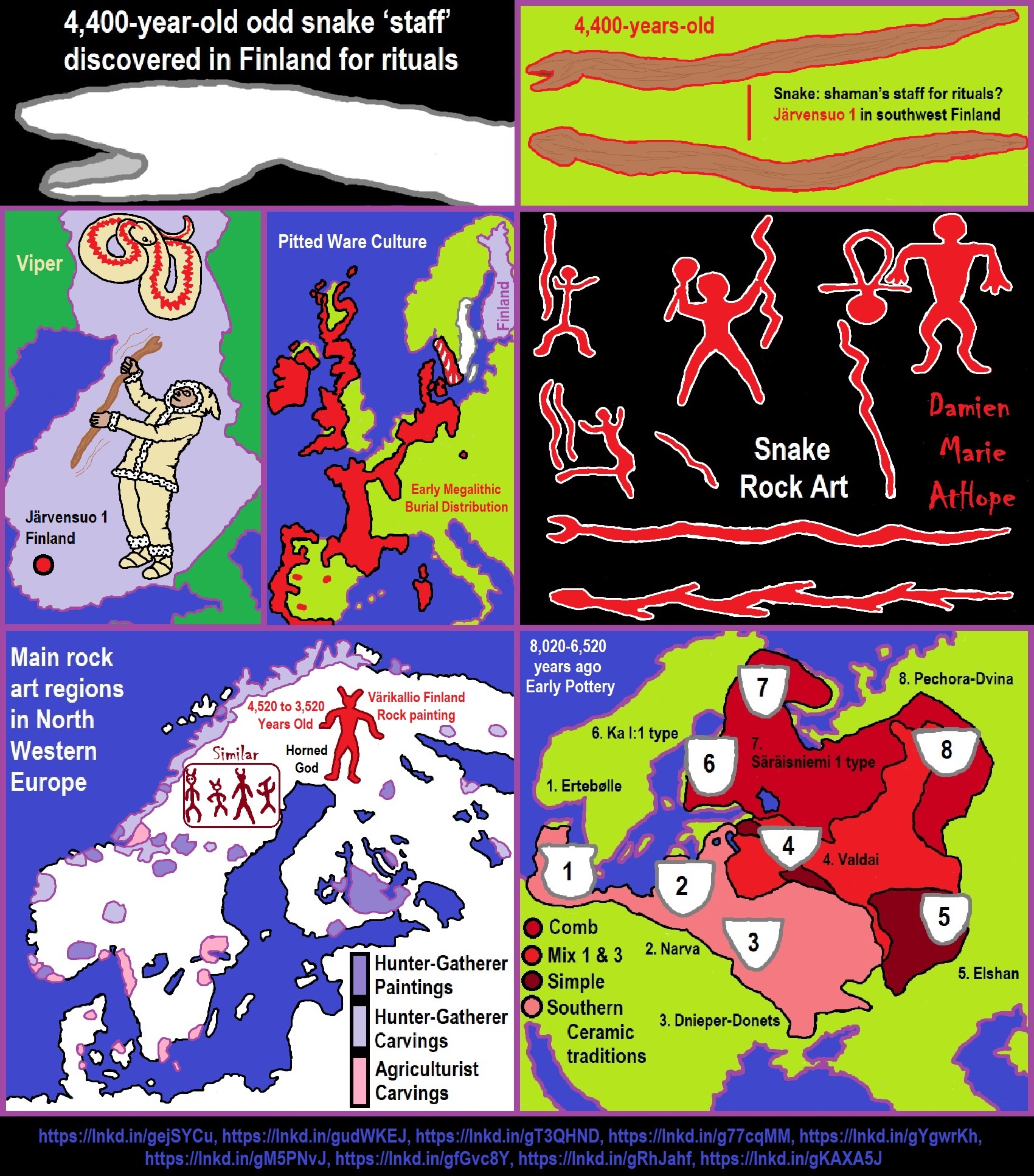
Finland’s Horned Shaman and Pre-Horned-God at least 4,500 years ago?
Early Religions Thought to Express Proto-Monotheistic Systems around 4,000 years ago
4,000-year-Old Dolmens in Israel: A Connected Dolmen Religious Phenomenon?
Confucianism’s Tiān (Shangdi god 4,000 years old): Supernaturalism, Pantheism or Theism?
When was the beginning: TIMELINE OF CURRENT RELIGIONS? Around 4,000 years ago
Kultepe? An archaeological site with a 4,000 years old women’s rights document.

ref, ref, ref, ref, ref, ref, ref, ref, ref, ref, ref, ref, ref, ref, ref, ref, ref, ref, ref, ref, ref, ref, ref, ref, ref, ref
Sacred Snakes or Dragons and Rivers? To me, it’s snakes/dragons in one theme express as rivers thus developed on animism to gods or totem and other believed sacred beings
Snake Worship?
“Snake worship is seen in several ancient cultures, particularly, snake as renewal. Snake worship is devotion to serpent deities. The tradition is present in several ancient cultures, particularly in religion and mythology, where snakes were seen as entities of strength and renewal.” ref
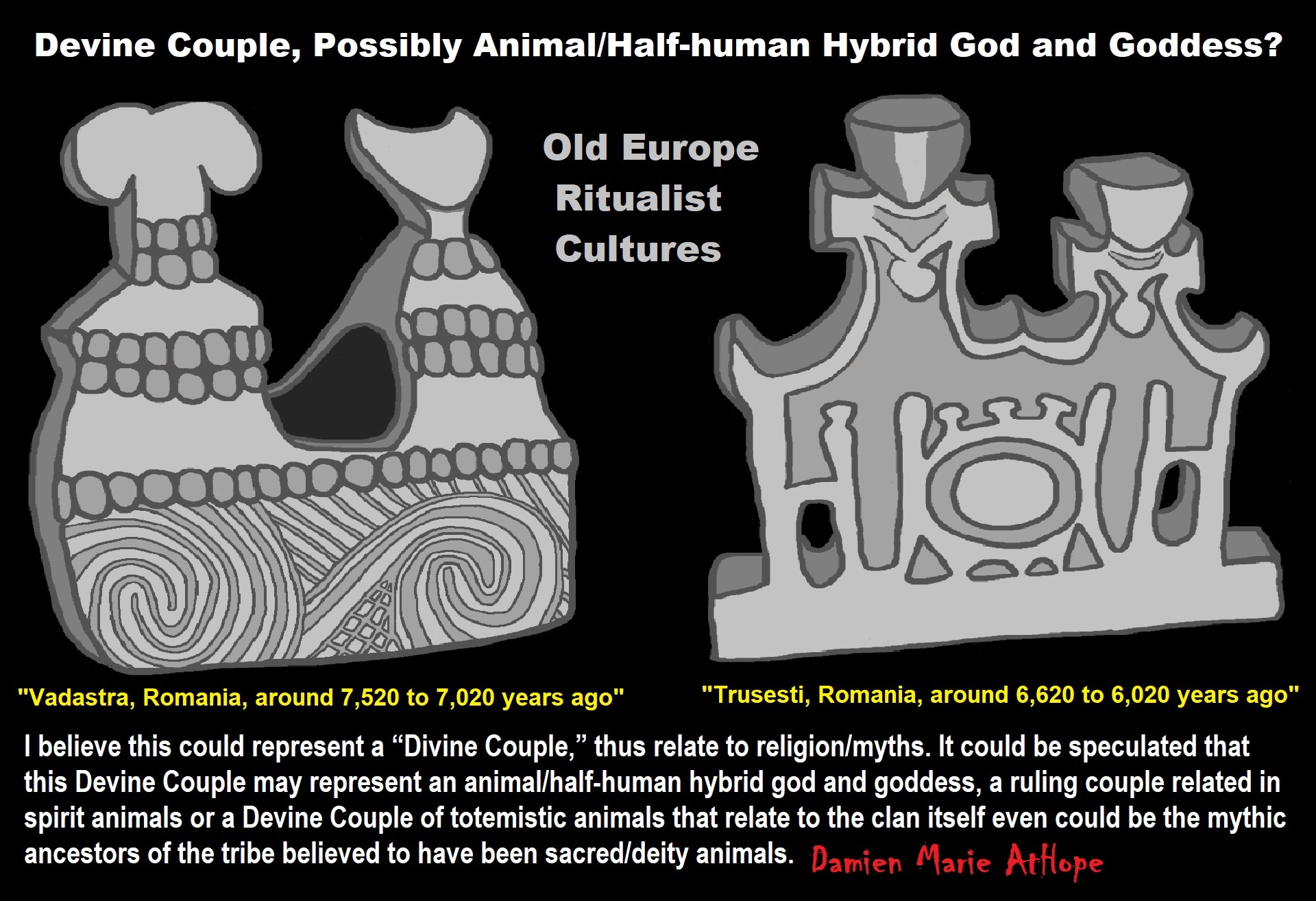
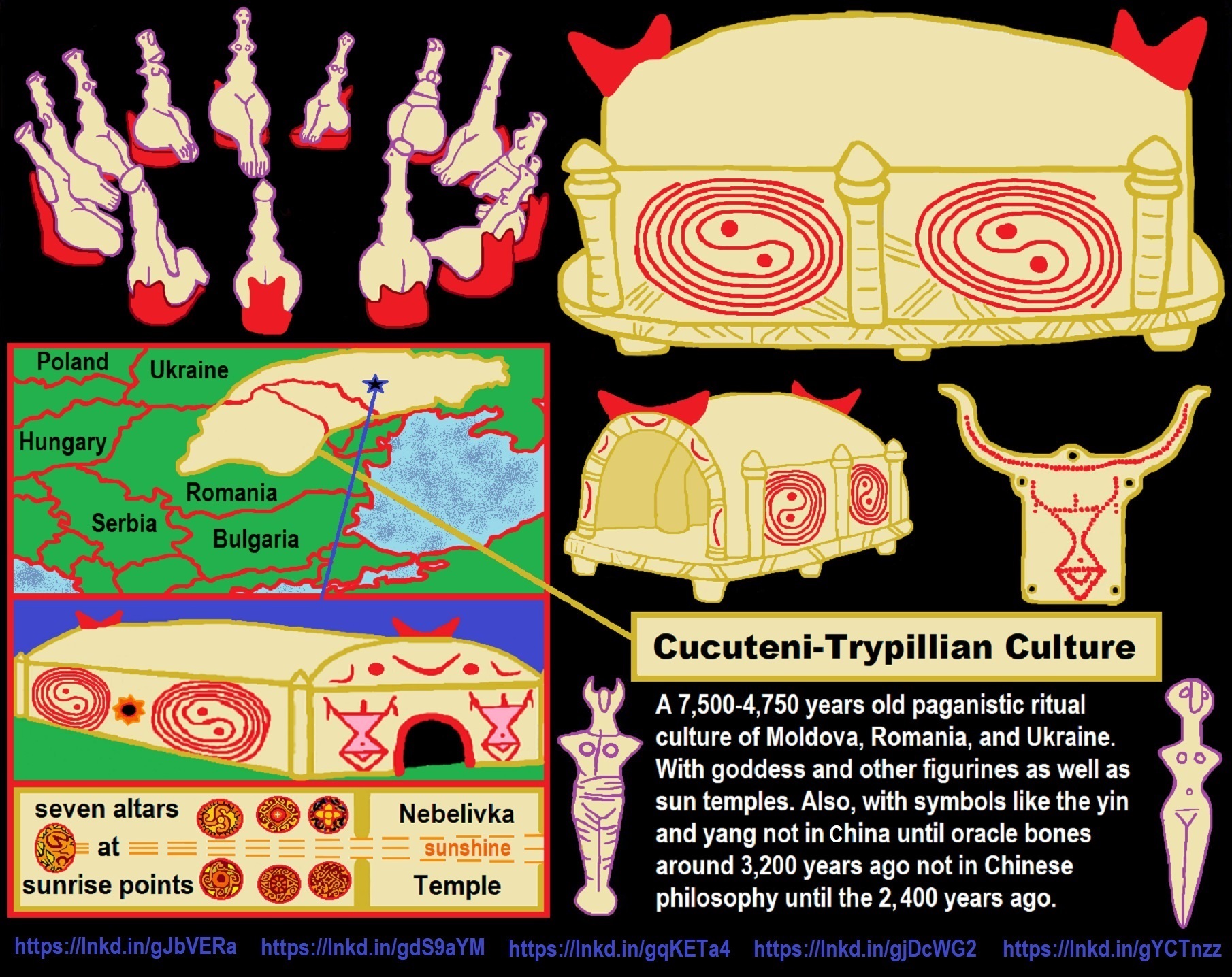
ref, ref, ref, ref, ref, ref, ref, ref, ref, ref, ref, ref
A 7,500-4,750 years old paganistic ritual culture of Moldova, Romania, and Ukraine. With goddess and other figurines as well as sun temples. Also, with symbols like the yin and yang were not in China until oracle bones around 3,200 years ago, and not in Chinese philosophy until the 2,400 years ago. ref, ref
“Figurines also differ in poses – standing or sitting. Near the sitting figurines, mostly at the earlier stages of the culture, stylised little chairs were often found. Researchers call some of them “horned”, since their backs are shaped as horns with their edges pointing upwards. Such “horned” images, or a crescent with its horns pointing upwards as a component of the ancient AllatRa sign, were often depicted on ceramics as well as on clay models of Trypillian houses. There are also figurines with “hats” having a shape of a crescent with its horns pointing upwards, which provides some researchers with a ground to associate such female images with lunar symbolism and call them Lunar Goddesses. Moreover, some researchers believe that the placement of such figures on a chair-throne emphasizes a special status of women in the society.” ref
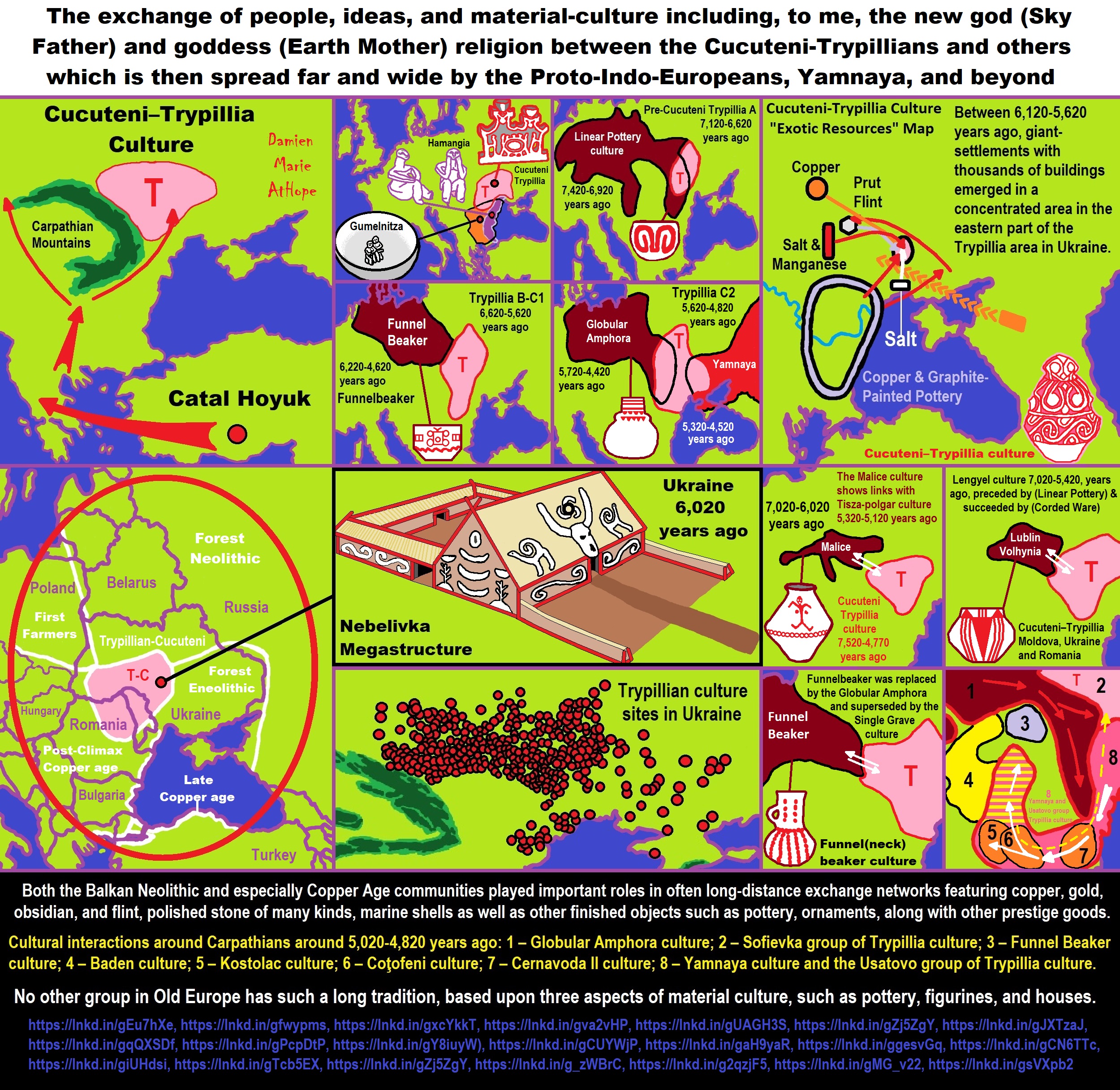
ref, ref, ref, ref, ref, ref, ref, ref, ref, ref, ref, ref, ref, ref, ref, ref, ref, ref, ref, ref
The exchange of people, ideas, and material-culture including, to me, the new god (Sky Father) and goddess (Earth Mother) religion between the Cucuteni-Trypillians and others which is then spread far and wide by the Proto-Indo-Europeans, Yamnaya, and beyond?
“These ideas are my speculations from the evidence.”
European Culture Links:

Seated Woman of Çatalhöyük
“The Seated Woman of Çatalhöyük (also Çatal Höyük) is a baked-clay, nude female form, seated between feline-headed arm-rests. It is generally thought to depict a corpulent and fertile Mother goddess in the process of giving birth while seated on her throne, which has two hand rests in the form of feline (lioness, leopard, or panther) heads in a Mistress of Animals motif. The statuette, one of several iconographically similar ones found at the site, is associated to other corpulent prehistoric goddess figures, of which the most famous is the Venus of Willendorf. It is a neolithic sculpture shaped by an unknown artist, and was completed in approximately 6000 BCE.” ref
Kubaba
“Kubaba is the only queen on the Sumerian King List, which states she reigned for 100 years – roughly in the Early Dynastic III period (ca. 2500–2330 BCE) of Sumerian history. A connection between her and a goddess known from Hurro–Hittite and later Luwian sources cannot be established on the account of spatial and temporal differences. Kubaba is one of very few women to have ever ruled in their own right in Mesopotamian history. Most versions of the king list place her alone in her own dynasty, the 3rd Dynasty of Kish, following the defeat of Sharrumiter of Mari, but other versions combine her with the 4th dynasty, that followed the primacy of the king of Akshak. Before becoming monarch, the king list says she was an alewife, brewess or brewster, terms for a woman who brewed alcohol.” ref
“Kubaba was a Syrian goddess associated particularly closely with Alalakh and Carchemish. She was adopted into the Hurrian and Hittite pantheons as well. After the fall of the Hittite empire, she continued to be venerated by Luwians. A connection between her and the similarly named legendary Sumerian queen Kubaba of Kish, while commonly proposed, cannot be established due to spatial and temporal differences. Emmanuel Laroche proposed in 1960 that Kubaba and Cybele were one and the same. This view is supported by Mark Munn, who argues that the Phrygian name Kybele developed from Lydian adjective kuvavli, first changed into kubabli and then simplified into kuballi, and finally kubelli. However, such an adjective is a purely speculative construction.” ref
Cybele
“Cybele (Phrygian: “Kubileya/Kubeleya Mother”, perhaps “Mountain Mother”) is an Anatolian mother goddess; she may have a possible forerunner in the earliest neolithic at Çatalhöyük, where statues of plump women, sometimes sitting, have been found in excavations. Phrygia‘s only known goddess, she was probably its national deity. Greek colonists in Asia Minor adopted and adapted her Phrygian cult and spread it to mainland Greece and to the more distant western Greek colonies around the 6th century BCE. In Greece, Cybele met with a mixed reception. She became partially assimilated to aspects of the Earth-goddess Gaia, of her possibly Minoan equivalent Rhea, and of the harvest–mother goddess Demeter. Some city-states, notably Athens, evoked her as a protector, but her most celebrated Greek rites and processions show her as an essentially foreign, exotic mystery-goddess who arrives in a lion-drawn chariot to the accompaniment of wild music, wine, and a disorderly, ecstatic following.” ref
“Uniquely in Greek religion, she had a eunuch mendicant priesthood. Many of her Greek cults included rites to a divine Phrygian castrate shepherd-consort Attis, who was probably a Greek invention. In Greece, Cybele became associated with mountains, town and city walls, fertile nature, and wild animals, especially lions. In Rome, Cybele became known as Magna Mater (“Great Mother”). The Roman State adopted and developed a particular form of her cult after the Sibylline oracle in 205 BCE recommended her conscription as a key religious ally in Rome’s second war against Carthage (218 to 201 BCE). Roman mythographers reinvented her as a Trojan goddess, and thus an ancestral goddess of the Roman people by way of the Trojan prince Aeneas. As Rome eventually established hegemony over the Mediterranean world, Romanized forms of Cybele’s cults spread throughout Rome’s empire. Greek and Roman writers debated and disputed the meaning and morality of her cults and priesthoods, which remain controversial subjects in modern scholarship.” ref
“Isis was a major goddess in ancient Egyptian religion believed to help the dead enter the afterlife. She was usually portrayed in art as a human woman wearing a throne-like hieroglyph on her head. During the New Kingdom (3,550–3,070 years ago), as she took on traits that originally belonged to Hathor, the preeminent goddess of earlier times, Isis came to be portrayed wearing Hathor’s headdress: a sun disk between the horns of a cow. Likewise, the expression of moon disks headdress: a moon disk between the horns of a cow. Her reputed magical power was greater than that of all other gods, and she was said to protect the kingdom from its enemies, govern the skies and the natural world, and have power over fate itself. Whereas some Egyptian deities appeared in the late Predynastic Period (before 5,100 years ago), neither Isis nor her husband Osiris were clearly mentioned before the Fifth Dynasty (4,494–4,345 years ago). The hieroglyphic writing of her name incorporates the sign for a throne, which Isis also wears on her head as a sign of her identity. Like other goddesses, such as Hathor, she also acted as a mother to the deceased, providing protection and nourishment. Thus, like Hathor, she sometimes took the form of Imentet, the goddess of the west, who welcomed the deceased soul into the afterlife as her child.” ref
“Isis is treated as the mother of Horus even in the earliest copies of the Pyramid Texts. Yet there are signs that Hathor was originally regarded as his mother, and other traditions make an elder form of Horus the son of Nut.” ref
“Egyptian mythology, Nut was the goddess of the sky, she was seen as a star-covered nude woman arching over the earth, or as a cow. The ancient Egyptians believed that Nut swallowed the sun-god, Ra, every night and gave birth to him every morning. In direct contrast to most other mythologies which usually develop a sky father associated with an Earth mother (or Mother Nature), she personified the sky and he the Earth. Nut was Mistress of All or “She who Bore the Gods”: Originally, Nut was said to be lying on top of Geb (Earth) and continually having intercourse. Nut was the goddess of the sky and all heavenly bodies, a symbol of protecting the dead when they enter the afterlife. According to the Egyptians, during the day, the heavenly bodies—such as the sun and moon—would make their way across her body. Then, at dusk, they would be swallowed, pass through her belly during the night, and be reborn at dawn. Nut is also the barrier separating the forces of chaos from the ordered cosmos in the world. She was pictured as a woman arched on her toes and fingertips over the earth; her body portrayed as a star-filled sky. Nut’s fingers and toes were believed to touch the four cardinal points or directions of north, south, east, and west.” ref
Paganism: Goddesses around 12,000 years ago then Male Gods after 7,000 years ago
Migrations and Changing Europeans Beginning around 8,000 Years Ago
Mythology, a Lunar Deity is a Goddess or God of the Moon
Myths and Folklore: “Trickster gods and goddesses”
Goddesses/Demigoddesses/Grandmother-Mother Ancestor Spirits from Catal Huyuk?
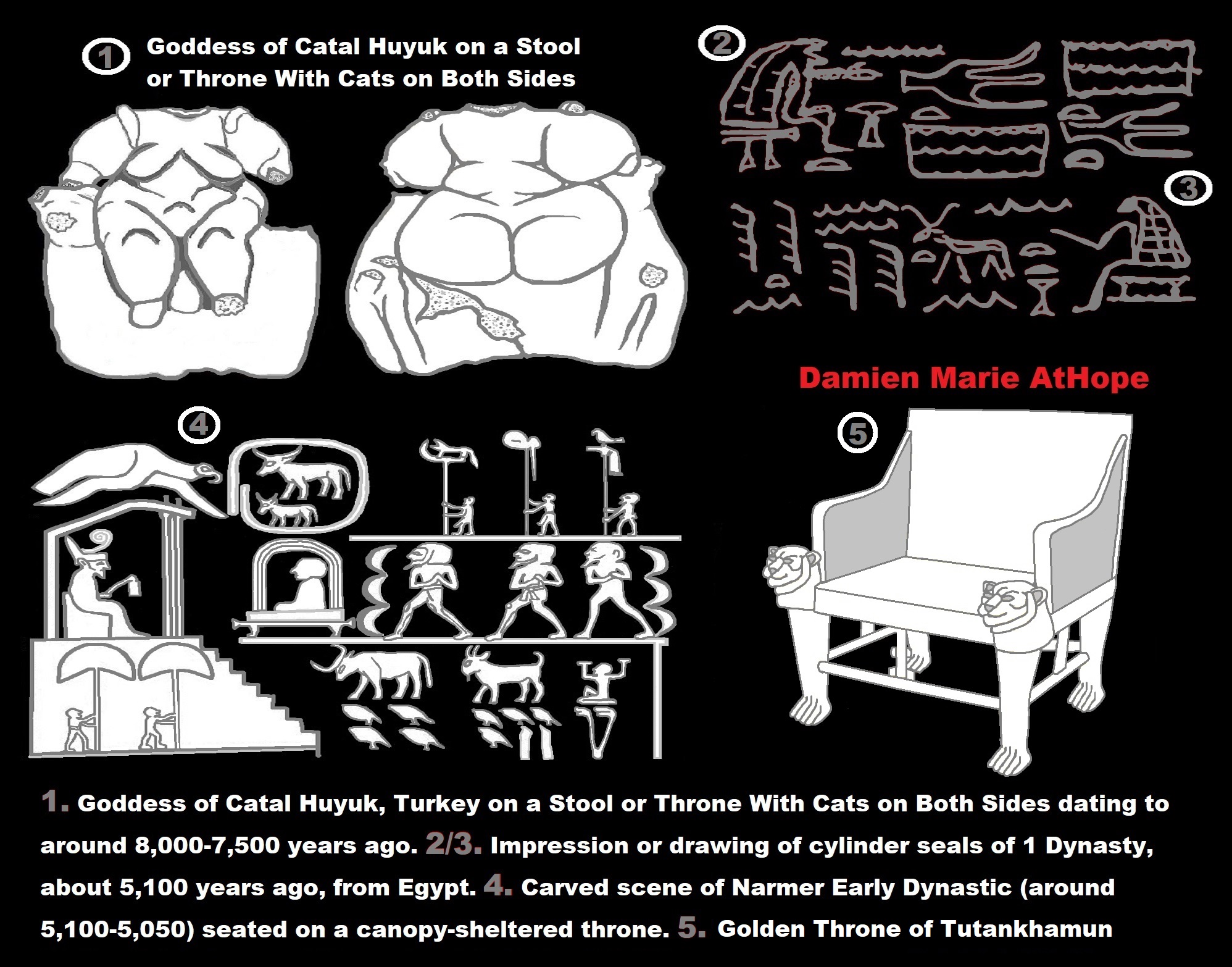
“The first piece of domestic furniture seen in use is the stool with a rectangular frame. It is found over and over again on early Egyptian cylinder seals. These seals, short and fat, usually of black steatite (soapstone), are peculiar to the earliest dynastic period 5,100 years ago. The inscriptions they bear – among the first exam-pies of writing – often give the name and title of some priest or official, followed by a group of signs that represent the deceased seated on a stool behind a pile of offerings (Figures 2, 3). For the stool, or the chair, has always been the mark of an important personage: it raises him above the level of his inferiors. (Most people in Egypt and other parts of the Near East seem to still sit/squatting on the ground) This sign, scarcely changing, remained the determinative for a person of rank in Egyptian hieroglyphic writing.” ref
“The stools on the seals are seen either from the side (Figure 2), or from the top (Figure 3) in what was to become a characteristic Egyptian mode of illustration: the representation of each separate part of the whole in its most recognizable aspect. Many of these early seals show a feature retained in pictures of stools throughout the dynastic period and much exaggerated in late times: the frames end in projections shaped like papyrus umbels, suggesting that the first Egyptian furniture was of wickerwork and that the frames were made of bundles of reeds bound together. Sometimes the legs of the stools shown on the seals were carved in the form of bulls’ legs.” ref
“And when the legs of lions began to replace those of bulls, about the end of the III Dynasty, the idea was similar: the sitter was to share the characteristic qualities of the King of Beasts; spool-like supports under the animal hooves or paws. Known as casters, even though rigid, they were always present with animal feet. Although, as one might expect, stools were made before chairs, there is a picture of a royal throne of about the same period as the cylinder seals. Narmer, the first king of Egypt, dedicated a giant mace head – symbolizing the weapon with which he had conquered his enemies and united Upper and Lower Egypt – in the temple at Hierakonpolis.” ref
‘One of the scenes carved on its surface pictures Narmer seated on a canopy-sheltered throne mounted on a high stepped dais (Figure 4). The throne seems to be a rectangular block scooped out to fit the king’s posterior and offer support for his back. But possibly he is really shown suspended, as it were, above curving arms, and this, accordingly, would be one of the first examples of the Egyptian artist’s reluctance to conceal any part of an object by another closer to the spectator. There is no indication of the material of the throne, but the dais, to judge by its Egyptian name, was of wood. A couch of the I Dynasty was actually more a commodious stool and several beds. The couch also has the familiar bull legs.” ref
“The stool, no matter how it is embellished, remains a raised seat without back or arms. But as early as the II Dynasty, officials, as well as kings, seemed to feel the need of support behind them, and the world’s first chairs were born. A hieroglyph in the pyramid of Pepi I of the 6th Dynasty (4,323-4,150 years ago) implies that his “shining throne” had lions’ heads and constitute the Old Kingdom of Dynastic Egypt with a pyramid built at Saqqara. (Figure 5) Arm panel of the throne of Tuthmosis iv, from his tomb, Thebes, xviii Dynasty, about 3,420 years ago, Cedar, height 94 inches.” ref
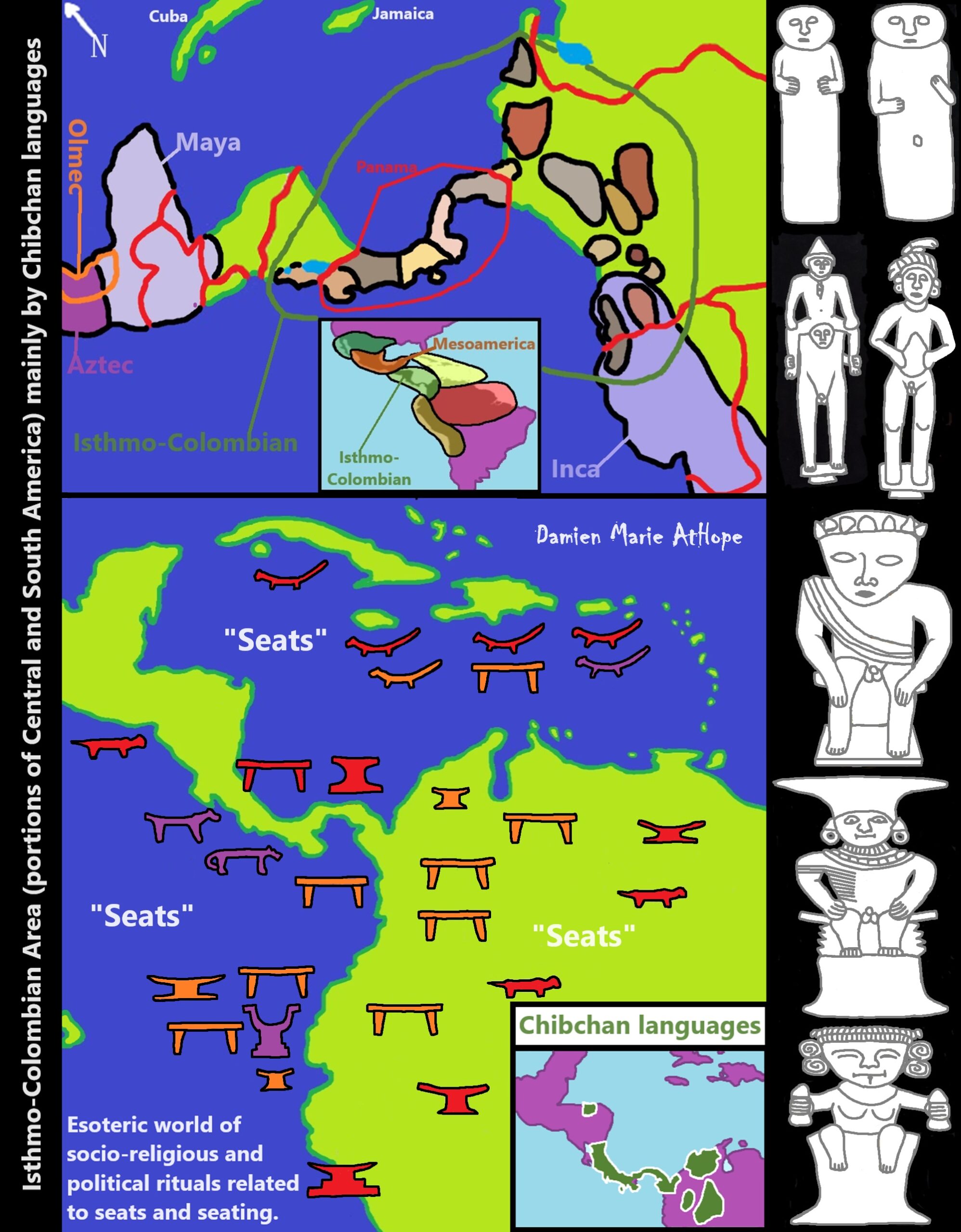
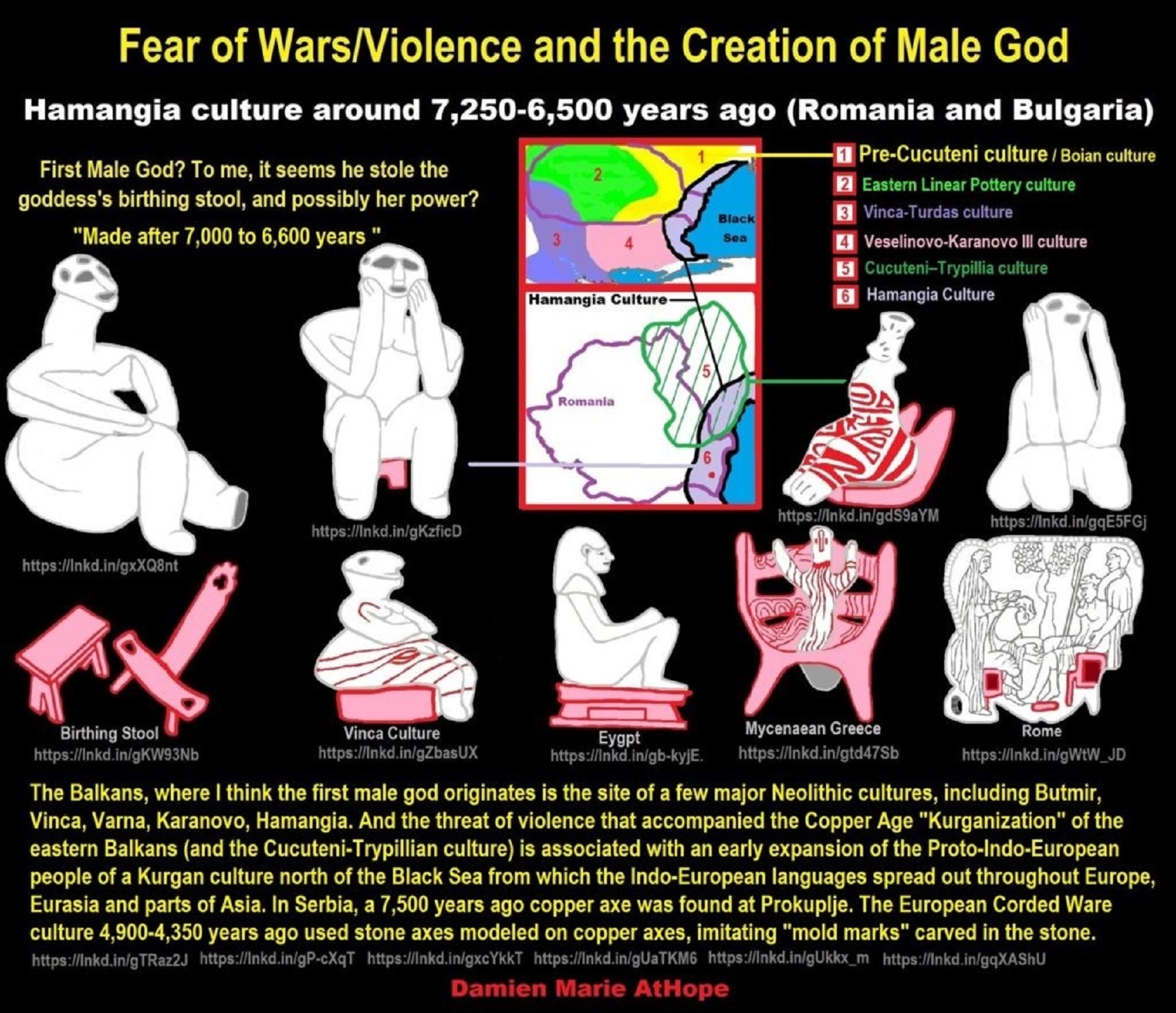
ref, ref, ref, ref, ref, ref, ref, ref, ref, ref, ref, ref, ref, ref, ref, ref, ref
The Hamangia culture began around 7,250-7,200 years ago and lasted until around 6,550-6,500 years ago It was absorbed by the expanding Boian culture in its transition towards the Gumelnitsa. Its cultural links with Anatolia suggest that it was the result of a settlement by people from Anatolia, unlike the neighboring cultures, which appear descended from an earlier Neolithic settlement. ref
“The Hamangia culture is a Late Neolithic archaeological culture of Dobruja (Romania and Bulgaria) between the Danube and the Black Sea and Muntenia in the south. It is named after the site of Baia-Hamangia. The Hamangia culture began around 5250/5200 BCE and lasted until around 4550/4500 BCE. It was absorbed by the expanding Boian culture in its transition towards the Gumelniţa. Pottery figurines are normally extremely stylized and show standing naked faceless women with emphasized breasts and buttocks. Cernavodă, the necropolis where the famous statues “The Thinker” and “The Sitting Woman” were discovered.” ref
“The Boian culture emerged from two earlier Neolithic groups: the Dudeşti culture that originated in Anatolia (present-day Turkey); and the Musical note culture (also known as the Middle Linear Pottery culture or LBK) from the northern Subcarpathian region of southeastern Poland and western Ukraine. There have not been many artifacts found in Boian culture sites of sculptures or figurines. There is evidence that the Boian culture acquired the technology for copper metallurgy; as a result, this culture bridged the change from the Neolithic to the Copper Age.” ref
“ Hamangia culture and then Boian culture was followed or taken over by the Varna culture. Burials at Varna have the oldest human-modified gold artifacts in history jewelry. There are crouched and extended inhumations. Some graves do not contain a skeleton, but grave gifts (cenotaphs). The symbolic (empty) graves are the richest in gold artifacts. 3000 gold artifacts were found, with a weight of approximately 6 kilograms. Grave 43 contained more gold than has been found in the entire rest of the world for that epoch. The culture had sophisticated religious beliefs about afterlife and developed hierarchical status differences: it constitutes the oldest known burial evidence of an elite male. The end of the fifth millennium BC is the time that Marija Gimbutas, founder of the Kurgan hypothesis claims the transition to male dominance began in Europe. The high-status male was buried with remarkable amounts of gold, held a war axe or mace, and wore a gold penis sheath. The bull-shaped gold platelets perhaps also venerated virility, instinctive force, and warfare.” ref
The First Expression of the Male God around 7,000 years ago?

ref, ref, ref, ref, ref, ref, ref, ref, ref, ref, ref, ref, ref, ref, ref, ref, ref
From the Evidence, I Speculate, the First Human-Male God was Created in the Balkans around or after 7,000 years ago following Harsher climate, Emerging social hierarchy, and Fear of violence.
Fear of Wars Violence and the Creation of Male God: Hamangia culture around 7,250-6,500 years ago (Romania and Bulgaria)?
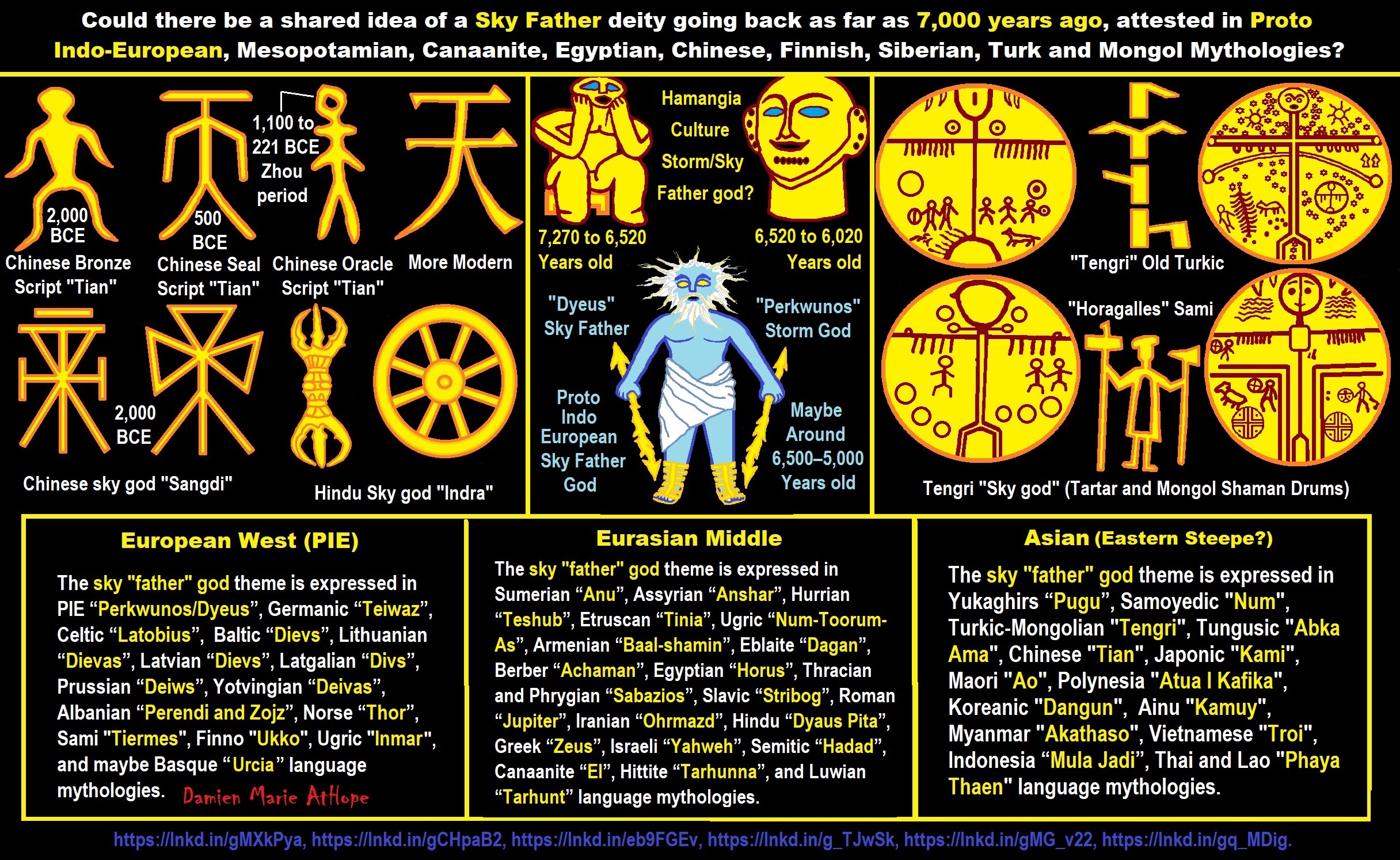
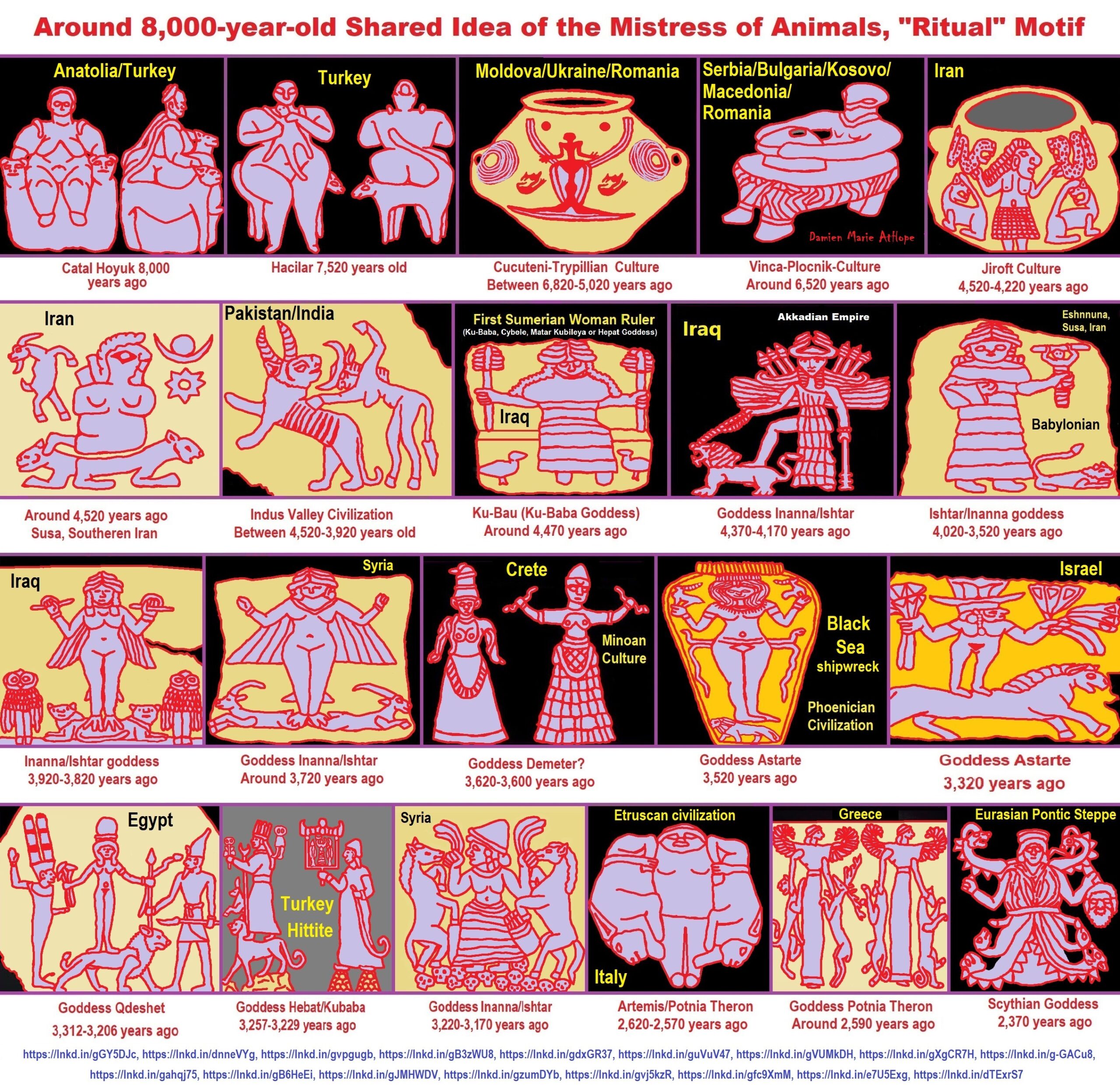
ref, ref, ref, ref, ref, ref, ref, ref, ref, ref, ref, ref, ref, ref, ref, ref, ref, ref, ref, ref
Mistress of Wild Animals
“The Mistress of Wild Animals is similar to the Master of Animals motif seen in ancient art commonly showing a human between and grasping two confronted animals. There are other versions of animal domination or companionship. It is very widespread in the art of the Ancient Near East and Egypt. The Mistress/Master figure is commonly shown as human or half-human, the animals may be realistic or fantastical, and the figure may have animal elements such as horns, or an animal’s upper body. Unless he is shown with specific divine attributes, he is typically described as a hero, although what the motif represented to the cultures which created the works probably varies greatly.” ref
“The Mistress of the Wild Animals (Potnia theron) or Queen of the Wild Bees appears under many names. Her Minoan name was Britomartis or Sweet Virgin and she was related to Dictynna. The name Potnia is known from the Linear script B tablets and was used for the principal Mycenaean female deity. The type of goddess who — in iconography — was surrounded by animals, and who appeared in archaic Greek art, was usually called Potnia theron, or sometimes Artemis.” ref
“The Potnia Theron (Ancient Greek: Ἡ Πότνια Θηρῶν, “The Animal Mistress”) or Mistress of Animals is a widespread motif in ancient art from the Mediterranean world and the ancient Near East, showing a central human, or human-like, female figure who grasps two animals, one to each side. Although the connections between images and concepts in the various ancient cultures concerned remain very unclear, such images are often referred to by the Greek term Potnia Theron regardless of the culture of origin. The term is first used once by Homer as a descriptor of Artemis and often used to describe female divinities associated with animals. The word Potnia, meaning mistress or lady, was a Mycenaean Greek word inherited by Classical Greek, with the same meaning, cognate to Sanskrit patnī. The oldest such depiction, the Seated Woman of Çatalhöyük, is a clay sculpture from Çatalhöyük in modern Turkey, made c 6,000 BC. This motif is more common in later Near Eastern and Mesopotamian art with a male figure, called the Master of Animals.” ref
“During the fifteenth century BCE, the Mycenaeans, heavily influenced by Minoan culture, presented the Mistress of Animals in a Minoan manner and with her usual sacred symbols. However, by the Late Mycenaean period, the old type of deity flanked by animals was forgotten. On wall-paintings, the goddess is sometimes accompanied by a griffin, but generally, new iconographical religious themes and types were applied. The Mistress of Animals, a counterpart of the Master of Animals, is usually described as a hunting deity, but some authors associate her not only with wild animals, snakes, and birds, but further with a sacred tree and pillar, with poppy and some lily, and eventually, she looked like a Mistress of Trees and Mountains. M.P. Nilsson believed that she was an earlier form of the Minoan Mother of Mountains. The Mycenaeans adopted the iconographical type of the Mistress of Animals and applied it to the goddess of nature, who was represented with vegetation — mainly palms and papyrus flowers. The archaic Greeks, following the tradition, used the old iconographical scheme with their own aesthetic program, but over time the name of Potnia Theron and her attributes and functions were integrated into Artemis.” ref
“Minoan seal reliefs depict the Mistress of Animals in frontal position with raised hands, turning the lower part of her body, and dressed in a Minoan skirt. She is flanked by animals, a double ax, and snakes, which are evidence of her divinity. Her close relationship with nature and her domination over animals is illustrated on the relief — one of the griffins, accompanying the deity, is suckling her breast. Another representation on a golden ring shows the deity with a galloping griffin. The griffins, the same as the beasts, became followers of the divinity and also function as her guardians. Occasionally, the mythical animals and the wild animals are depicted on their own, or with some religious equipment (such as an altar or a column), which provides information about the presence of the deity or about her sacred places. In early archaic Greek art, the Mistress of Animals emerges again. The relief on the pithos of Thebes shows her in a frontal position with raised hands, accompanied by lions and two small human figures, while a Boeotian vase illustrates her domination over many kinds of animals. Necklace plaques, decorated with the Mistress of Animals, and dating from the second half of the seventh century BCE, present her with wings in a daedalic style, surrounded by lions, or with a body of bees without the company of animals. Finally, the vase by the François painter depicts the type of deity with wings again, holding a lion and a deer, but in this situation, she is sometimes Potnia Theron and sometimes Artemis.” ref
“Homer’s mention of Potnia Theron refers to Artemis; Walter Burkert describes this mention as “a well-established formula”. An Artemis-type deity, a “Mistress of the Animals”, is often assumed to have existed in prehistoric religion and often referred to as Potnia Theron with some scholars positing a relationship between Artemis and goddesses depicted in Minoan art. An early example of Italian Potnia theròn is in the Museo civico archeologico di Monte Rinaldo in Italy: a plate illustrates a goddess that wears a long dress and holds hands with two lionesses. In the Aeneid, Virgil mentions that inside of Psychro’s Cave, in Crete, lived the goddess Cybele whose chariot was drawn by two lions.” ref
“No contemporary text or myth survives to attest the original character and nature of Cybele’s Phrygian cult. She may have evolved from a statuary type found at Çatalhöyük in Anatolia, dated to the 6th millennium BCE and identified by some as a mother goddess. In Phrygian art of the 8th century BC, the cult attributes of the Phrygian mother-goddess include attendant lions, a bird of prey, and a small vase for her libations or other offerings. The inscription Matar Kubileya/Kubeleya at a Phrygian rock-cut shrine, dated to the first half of the 6th century BCE, is usually read as “Mother of the mountain”, a reading supported by ancient classical sources, and consistent with Cybele as any of several similar tutelary goddesses, each known as “mother” and associated with specific Anatolian mountains or other localities: a goddess thus “born from stone”. She is ancient Phrygia’s only known goddess, the divine companion or consort of its mortal rulers, and was probably the highest deity of the Phrygian state. Her name, and the development of religious practices associated with her, may have been influenced by cult to the deified Sumerian queen Kubaba.” ref
“In the 2nd century CE, the geographer Pausanias attests to a Magnesian (Lydian) cult to “the mother of the gods”, whose image was carved into a rock-spur of Mount Sipylus. This was believed to be the oldest image of the goddess, and was attributed to the legendary Broteas. At Pessinos in Phrygia, the mother goddess—identified by the Greeks as Cybele—took the form of an unshaped stone of black meteoric iron, and may have been associated with or identical to Agdistis, Pessinos’ mountain deity. This was the aniconic stone that was removed to Rome in 204 BCE. Images and iconography in funerary contexts, and the ubiquity of her Phrygian name Matar (“Mother”), suggest that she was a mediator between the “boundaries of the known and unknown”: the civilized and the wild, the worlds of the living and the dead. Her association with hawks, lions, and the stone of the mountainous landscape of the Anatolian wilderness, seem to characterize her as mother of the land in its untrammeled natural state, with power to rule, moderate or soften its latent ferocity, and to control its potential threats to a settled, civilized life. Anatolian elites sought to harness her protective power to forms of ruler-cult; in Lydia, her cult had possible connections to the semi-legendary king Midas, as her sponsor, consort, or co-divinity. As protector of cities, or city states, she was sometimes shown wearing a mural crown, representing the city walls. At the same time, her power “transcended any purely political usage and spoke directly to the goddess’ followers from all walks of life”.” ref
“Some Phrygian shaft monuments are thought to have been used for libations and blood offerings to Cybele, perhaps anticipating by several centuries the pit used in her taurobolium and criobolium sacrifices during the Roman imperial era. Over time, her Phrygian cults and iconography were transformed, and eventually subsumed, by the influences and interpretations of her foreign devotees, at first Greek and later Roman. From around the 6th century BCE, cults to the Anatolian mother-goddess were introduced from Phrygia into the ethnically Greek colonies of western Anatolia, mainland Greece, the Aegean islands, and the westerly colonies of Magna Graecia. The Greeks called her Mātēr or Mētēr (“Mother”), or from the early 5th century Kubelē; in Pindar, she is “Mistress Cybele the Mother”. In Homeric Hymn 14 she is “the Mother of all gods and all human beings.” Walter Burkert places her among the “foreign gods” of Greek religion, a complex figure combining the Minoan-Mycenaean tradition with the Phrygian cult imported directly from Asia Minor. In Greece, as in Phrygia, she was a “Mistress of animals” (Potnia Therōn), with her mastery of the natural world expressed by the lions that flank her, sit in her lap or draw her chariot. She was readily assimilated to the Minoan-Greek earth-mother Rhea, “Mother of the gods”, whose raucous, ecstatic rites she may have acquired. As an exemplar of devoted motherhood, she was partly assimilated to the grain-goddess Demeter, whose torchlight procession recalled her search for her lost daughter, Persephone; but she also remained a Phrygian and outsider, “Mother of the Mountains” as well as “Mother of all”.” ref
“As with other deities viewed as foreign introductions, the spread of Cybele’s cult was attended by conflict and crisis. Herodotus says that when Anacharsis returned to Scythia after traveling and acquiring knowledge among the Greeks in the 6th century BCE, his brother, the Scythian king, put him to death for joining the cult. In Athenian tradition, the city’s metroon was founded around 500 BCE to placate Cybele, who had visited a plague on Athens when one of her wandering priests was killed for his attempt to introduce her cult. The account may have been a later invention to explain why a public building was dedicated to an imported deity, as the earliest source is the Hymn To The Mother Of The Gods (362 CE) by the Roman emperor Julian. Her cults most often were funded privately, rather than by the polis. Her “vivid and forceful character” and association with the wild set her apart from the Olympian gods. Cybele’s early Greek images are small votive representations of her monumental rock-cut images in the Phrygian highlands. She stands alone within a naiskos, which represents her temple or its doorway, and is crowned with a polos, a high, cylindrical hat. A long, flowing chiton covers her shoulders and back. She is sometimes shown with lion attendants. Around the 5th century BCE, Agoracritos created a fully Hellenised and influential image of Cybele that was set up in the Athenian agora. It showed her enthroned, with a lion attendant, and a tympanon, the hand drum that was a Greek introduction to her cult and a salient feature in its later developments.” ref
“For the Greeks, the tympanon was a marker of foreign cults, suitable for rites to Cybele, her close equivalent Rhea, and Dionysus; of these, only Cybele holds the tympanon herself. She appears with Dionysus, as a secondary deity in Euripides‘ Bacchae, 64 – 186, and Pindar‘s Dithyramb II.6 – 9. In the Bibliotheca formerly attributed to Apollodorus, Cybele is said to have cured Dionysus of his madness. Their cults shared several characteristics: the foreigner-deity arrived in a chariot, drawn by exotic big cats (Dionysus by tigers, Cybele by lions), accompanied by wild music and an ecstatic entourage of exotic foreigners and people from the lower classes. At the end of the 1st century BC Strabo notes that Rhea-Cybele’s popular rites in Athens were sometimes held in conjunction with Dionysus’ procession. Both were regarded with caution by the Greeks, as having distinctly un-Hellenic temperaments, to be simultaneously embraced and “held at arm’s length.” ref
“In contrast to her public role as a protector of cities, Cybele was also the focus of mystery cult, private rites with a chthonic aspect connected to hero cult and exclusive to those who had undergone initiation, though it is unclear who Cybele’s initiates were. Reliefs show her alongside young female and male attendants with torches, and vessels for purification. Literary sources describe joyous abandonment to the loud, percussive music of tympanon, castanets, clashing cymbals and flutes, and to the frenzied “Phrygian dancing”, perhaps a form of circle-dancing by women, to the roar of “wise and healing music of the gods”. Conflation with Rhea led to Cybele’s association with various male demigods who served Rhea as attendants, or as guardians of her son, the infant Zeus, as he lay in the cave of his birth. In cult terms, they seem to have functioned as intercessors or intermediaries between goddess and mortal devotees, through dreams, waking trance, or ecstatic dance and song. They include the armed Kouretes, who danced around Zeus and clashed their shields to amuse him; their supposedly Phrygian equivalents, the youthful Corybantes, who provided similarly wild and martial music, dance, and song; and the dactyls and Telchines, magicians associated with metalworking.” ref
Cybele’s major mythographic narratives attach to her relationship with Attis, who is described by ancient Greek and Roman sources and cults as her youthful consort, and as a Phrygian deity. In Phrygia, “Attis” was not a deity, but both a commonplace and priestly name, found alike in casual graffiti, the dedications of personal monuments and several of Cybele’s Phrygian shrines and monuments. His divinity may therefore have begun as a Greek invention based on what was known of Cybele’s Phrygian cult. His earliest certain image as deity appears on a 4th-century BCE Greek stele from Piraeus, near Athens. It shows him as the Hellenised stereotype of a rustic, eastern barbarian; he sits at ease, sporting the Phrygian cap and shepherd’s crook of his later Greek and Roman cults. Before him stands a Phrygian goddess (identified by the inscription as Agdistis) who carries a tympanon in her left hand. With her right, she hands him a jug, as if to welcome him into her cult with a share of her own libation. Later images of Attis show him as a shepherd, in similar relaxed attitudes, holding or playing the syrinx (panpipes). In Demosthenes‘ On the Crown (330 BCE), attes is “a ritual cry shouted by followers of mystic rites”. Attis seems to have accompanied the diffusion of Cybele’s cult through Magna Graecia; there is evidence of their joint cult at the Greek colonies of Marseilles (Gaul) and Lokroi (southern Italy) from the 6th and 7th centuries BCE. After Alexander the Great‘s conquests, “wandering devotees of the goddess became an increasingly common presence in Greek literature and social life; depictions of Attis have been found at numerous Greek sites”. When shown with Cybele, he is always the younger, lesser deity, or perhaps her priestly attendant; the difference is one of relative degree, rather than essence, as priests were sacred in their own right and were closely identified with their gods. In the mid 2nd century, letters from the king of Pergamum to Cybele’s shrine at Pessinos consistently address its chief priest as “Attis”.” ref
Roman Cybele
Romans knew Cybele as Magna Mater (“Great Mother”), or as Magna Mater deorum Idaea (“great Idaean mother of the gods”), equivalent to the Greek title Meter Theon Idaia (“Mother of the Gods, from Mount Ida”). Rome officially adopted her cult during the Second Punic War (218 to 201 BCE), after dire prodigies, including a meteor shower, a failed harvest and famine, seemed to warn of Rome’s imminent defeat. The Roman Senate and its religious advisers consulted the Sibylline oracle and decided that Carthage might be defeated if Rome imported the Magna Mater (“Great Mother”) of Phrygian Pessinos. As this cult object belonged to a Roman ally, the Kingdom of Pergamum, the Roman Senate sent ambassadors to seek the king’s consent; en route, a consultation with the Greek oracle at Delphi confirmed that the goddess should be brought to Rome. The goddess arrived in Rome in the form of Pessinos’ black meteoric stone. Roman legend connects this voyage, or its end, to the matron Claudia Quinta, who was accused of unchastity but proved her innocence with a miraculous feat on behalf of the goddess. Publius Cornelius Scipio Nasica, supposedly the “best man” in Rome, was chosen to meet the goddess at Ostia; and Rome’s most virtuous matrons (including Claudia Quinta) conducted her to the temple of Victoria, to await the completion of her temple on the Palatine Hill. Pessinos’ stone was later used as the face of the goddess’ statue. In due course, the famine ended and Hannibal was defeated.” ref
“Most modern scholarship agrees that Cybele’s consort,Attis, and her eunuch Phrygian priests (Galli) would have arrived with the goddess, along with at least some of the wild, ecstatic features of her Greek and Phrygian cults. The histories of her arrival deal with the piety, purity, and status of the Romans involved, the success of their religious stratagem, and the power of the goddess herself; she has no consort or priesthood, and seems fully Romanised from the first. Some modern scholars assume that Attis must have followed much later; or that the Galli, described in later sources as shockingly effeminate and flamboyantly “un-Roman”, must have been an unexpected consequence of bringing the goddess in blind obedience to the Sibyl; a case of “biting off more than one can chew”. Others note that Rome was well versed in the adoption (or sometimes, the “calling forth”, or seizure) of foreign deities, and the diplomats who negotiated Cybele’s move to Rome would have been well-educated, and well-informed. Romans believed that Cybele, considered a Phrygian outsider even within her Greek cults, was the mother-goddess of ancient Troy (Ilium). Some of Rome’s leading patrician families claimed Trojan ancestry; so the “return” of the Mother of all Gods to her once-exiled people would have been particularly welcome, even if her spouse and priesthood were not; its accomplishment would have reflected well on the principals involved and, in turn, on their descendants. The upper classes who sponsored the Magna Mater’s festivals delegated their organization to the plebeian aediles, and honored her and each other with lavish, private festival banquets from which her Galli would have been conspicuously absent. Whereas in most of her Greek cults she dwelt outside the polis, in Rome she was the city’s protector, contained within her Palatine precinct, along with her priesthood, at the geographical heart of Rome’s most ancient religious traditions. She was promoted as patrician property; a Roman matron – albeit a strange one, “with a stone for a face” – who acted for the clear benefit of the Roman state.” ref
“Augustan ideology identified Magna Mater with Imperial order and Rome’s religious authority throughout the empire. Augustus claimed a Trojan ancestry through his adoption by Julius Caesar and the divine favor of Venus; in the iconography of Imperial cult, the empress Livia was Magna Mater’s earthly equivalent, Rome’s protector and symbolic “Great Mother”; the goddess is portrayed with Livia’s face on cameos and statuary. By this time, Rome had absorbed the goddess’s Greek and Phrygian homelands, and the Roman version of Cybele as Imperial Rome’s protector was introduced there. Imperial Magna Mater protected the empire’s cities and agriculture — Ovid “stresses the barrenness of the earth before the Mother’s arrival. Virgil’s Aeneid (written between 29 and 19 BCE) embellishes her “Trojan” features; she is Berecyntian Cybele, mother of Jupiter himself, and protector of the Trojan prince Aeneas in his flight from the destruction of Troy. She gives the Trojans her sacred tree for shipbuilding, and begs Jupiter to make the ships indestructible. These ships become the means of escape for Aeneas and his men, guided towards Italy and a destiny as ancestors of the Roman people by Venus Genetrix. Once arrived in Italy, these ships have served their purpose and are transformed into sea nymphs. Stories of Magna Mater’s arrival were used to promote the fame of its principals, and thus their descendants. Claudia Quinta‘s role as Rome’s castissima femina (purest or most virtuous woman) became “increasingly glorified and fantastic”; she was shown in the costume of a Vestal Virgin, and Augustan ideology represented her as the ideal of virtuous Roman womanhood. The emperor Claudius claimed her among his ancestors. Claudius promoted Attis to the Roman pantheon and placed his cult under the supervision of the quindecimviri (one of Rome’s priestly colleges).” ref
Kubaba Queen and (Goddess)
“Kubaba, Sumerian: ????????????????, kug-Dba-u₂, is the only queen on the Sumerian King List, which states she reigned for 100 years – roughly in the Early Dynastic III period (ca. 2500–2330 BCE) of Sumerian history. In the early Hittite period, she was worshipped as a goddess. Kubaba is one of the very few women to have ever ruled in their own right in Mesopotamian history. Most versions of the king list place her alone in her own dynasty, the 3rd Dynasty of Kish, following the defeat of Sharrumiter of Mari, but other versions combine her with the 4th dynasty, which followed the primacy of the king of Akshak. Before becoming monarch, the king list says she was an alewife.” ref
“The Weidner Chronicle is a propagandistic letter, attempting to date the shrine of Marduk at Babylon to an early period, and purporting to show that each of the kings who had neglected its proper rites had lost the primacy of Sumer. It contains a brief account of the rise of “the house of Kubaba” occurring in the reign of Puzur-Nirah of Akshak:
“In the reign of Puzur-Nirah, king of Akšak, the freshwater fishermen of Esagila were catching fish for the meal of the great lord Marduk; the officers of the king took away the fish. The fisherman was fishing when 7 (or 8) days had passed […] in the house of Kubaba, the tavern-keeper […] they brought to Esagila. At that time BROKEN[4] anew for Esagila […] Kubaba gave bread to the fisherman and gave water, she made him offer the fish to Esagila. Marduk, the king, the prince of the Apsû, favored her and said: “Let it be so!” He entrusted to Kubaba, the tavern-keeper, sovereignty over the whole world.” ref
“Her son Puzur-Suen and grandson Ur-Zababa followed her on the throne of Sumer as the fourth Kish dynasty on the king list, in some copies as her direct successors, in others with the Akshak dynasty intervening. Ur-Zababa is also known as the king said to be reigning in Sumer during the youth of Sargon the Great of Akkad, who militarily brought much of the Near East under his control shortly afterward. Shrines in honor of Kubaba spread throughout Mesopotamia. In the Hurrian area, she may be identified with Kebat, or Hepat, one title of the Hurrian Mother goddess Hannahannah (from Hurrian hannah, “mother”). Abdi-Heba was the palace mayor, ruling Jerusalem at the time of the Amarna letters (1350 BC).” ref
“Kubaba became the tutelary goddess who protected the ancient city of Carchemish on the upper Euphrates, in the late Hurrian/early Hittite period. Relief carvings, now at the Museum of Anatolian Civilizations (Anadolu Medeniyetleri Müzesi), Ankara, show her seated, wearing a cylindrical headdress like the polos and holding probably a tympanum (hand drum) or possibly a mirror in one hand and a poppy capsule (or perhaps pomegranate) in the other. She plays a role in Luwian texts and a minor role in Hittite texts, mainly in Hurrian rituals. According to Emanuel Laroche, Maarten J. Vermaseren, and Mark Munn, her cult later spread, and her name was adapted for the main goddess of the Hittite successor kingdoms in Anatolia. This deity later developed into the Phrygian matar kubileya (“mother Cybele”), who was depicted in petroglyphs and mentioned in accompanying inscriptions. The Phrygian goddess otherwise bears little resemblance to Kubaba, who – according to Herodotus – was a sovereign deity at Sardis. Her Lydian name was Kuvav or Kufav which Ionian Greeks initially transcribed Kybêbê, rather than Kybele; Jan Bremmer notes in this context the 7th-century Semonides of Amorgos, who calls one of her Hellene followers a kybêbos. Bremmer observes that in the following century she was further Hellenized by Hipponax, as “Kybêbê, daughter of Zeus”.” ref
Inanna (Goddess)
“Inanna is an ancient Mesopotamian goddess associated with love, beauty, sex, war, justice, and political power. She was originally worshiped in Sumer under the name “Inanna”, and was later worshipped by the Akkadians, Babylonians, and Assyrians under the name Ishtar. She was known as the “Queen of Heaven” and was the patron goddess of the Eanna temple at the city of Uruk, which was her main cult center. She was associated with the planet Venus and her most prominent symbols included the lion and the eight-pointed star. Her husband was the god Dumuzid (later known as Tammuz) and her sukkal, or personal attendant, was the goddess Ninshubur (who later became the male deity Papsukkal). Inanna was worshiped in Sumer at least as early as the Uruk period (c. 4000 – c. 3100 BCE), but she had little cult before the conquest of Sargon of Akkad. During the post-Sargonic era, she became one of the most widely venerated deities in the Sumerian pantheon, with temples across Mesopotamia. The cult of Inanna/Ishtar, which may have been associated with a variety of sexual rites, was continued by the East Semitic-speaking people (Akkadians, Assyrians and Babylonians) who succeeded and absorbed the Sumerians in the region. She was especially beloved by the Assyrians, who elevated her to become the highest deity in their pantheon, ranking above their own national god Ashur. Inanna/Ishtar is alluded to in the Hebrew Bible and she greatly influenced the Phoenician goddess Astoreth, who later influenced the development of the Greek goddess Aphrodite. Her cult continued to flourish until its gradual decline between the first and sixth centuries AD in the wake of Christianity, though it survived in parts of Upper Mesopotamia among Assyrian communities as late as the eighteenth century.” ref
“Inanna appears in more myths than any other Sumerian deity. Many of her myths involve her taking over the domains of other deities. She was believed to have stolen the mes, which represented all positive and negative aspects of civilization, from Enki, the god of wisdom. She was also believed to have taken over the Eanna temple from An, the god of the sky. Alongside her twin brother Utu (later known as Shamash), Inanna was the enforcer of divine justice; she destroyed Mount Ebih for having challenged her authority, unleashed her fury upon the gardener Shukaletuda after he raped her in her sleep, and tracked down the bandit woman Bilulu and killed her in divine retribution for having murdered Dumuzid. In the standard Akkadian version of the Epic of Gilgamesh, Ishtar asks Gilgamesh to become her consort. When he refuses, she unleashes the Bull of Heaven, resulting in the death of Enkidu and Gilgamesh’s subsequent grapple with his mortality. Inanna/Ishtar’s most famous myth is the story of her descent into and return from Kur, the ancient Sumerian Underworld, a myth in which she attempts to conquer the domain of her older sister Ereshkigal, the queen of the Underworld, but is instead deemed guilty of hubris by the seven judges of the Underworld and struck dead. Three days later, Ninshubur pleads with all the gods to bring Inanna back, but all of them refuse her except Enki, who sends two sexless beings to rescue Inanna. They escort Inanna out of the Underworld, but the galla, the guardians of the Underworld, drag her husband Dumuzid down to the Underworld as her replacement. Dumuzid is eventually permitted to return to heaven for half the year while his sister Geshtinanna remains in the Underworld for the other half, resulting in the cycle of the seasons.” ref
Cybele (Goddess)
“Cybele, Phrygian: Matar Kubileya/Kubeleya “Kubileya/Kubeleya Mother”, perhaps “Mountain Mother”; Lydian Kuvava; Greek: Κυβέλη Kybele, Κυβήβη Kybebe, Κύβελις Kybelis) is an Anatolian mother goddess; she may have a possible forerunner in the earliest neolithic at Çatalhöyük, where statues of plump women, sometimes sitting, have been found in excavations. Phrygia‘s only known goddess, she was probably its national deity. Greek colonists in Asia Minor adopted and adapted her Phrygian cult and spread it to mainland Greece and to the more distant western Greek colonies around the 6th century BCE. In Greece, Cybele met with a mixed reception. She became partially assimilated to aspects of the Earth-goddess Gaia, of her possibly Minoan equivalent Rhea, and of the harvest–mother goddess Demeter. Some city-states, notably Athens, evoked her as a protector, but her most celebrated Greek rites and processions show her as an essentially foreign, exotic mystery-goddess who arrives in a lion-drawn chariot to the accompaniment of wild music, wine, and a disorderly, ecstatic following. Uniquely in Greek religion, she had a eunuch mendicant priesthood.” ref
“Many of her Greek cults included rites to a divine Phrygian castrate shepherd-consort Attis, who was probably a Greek invention. In Greece, Cybele became associated with mountains, town and city walls, fertile nature, and wild animals, especially lions. In Rome, Cybele became known as Magna Mater (“Great Mother”). The Roman State adopted and developed a particular form of her cult after the Sibylline oracle in 205 BCE recommended her conscription as a key religious ally in Rome’s second war against Carthage (218 to 201 BCE). Roman mythographers reinvented her as a Trojan goddess, and thus an ancestral goddess of the Roman people by way of the Trojan prince Aeneas. As Rome eventually established hegemony over the Mediterranean world, Romanized forms of Cybele’s cults spread throughout Rome’s empire. Greek and Roman writers debated and disputed the meaning and morality of her cults and priesthoods, which remain controversial subjects in modern scholarship.” ref
Inara (Goddess)
“Inara, in Hittite–Hurrian mythology, was the goddess of the wild animals of the steppe and daughter of the Storm-god Teshub/Tarhunt. She corresponds to the “potnia theron” of Greek mythology, better known as Artemis. Inara’s mother is probably Hebat and her brother is Sarruma. After the dragon Illuyanka wins an encounter with the storm god, the latter asks Inara to give a feast, most probably the Purulli festival. Inara decides to use the feast to lure and defeat Illuyanka, who was her father’s archenemy and enlists the aid of a mortal named Hupasiyas of Zigaratta by becoming his lover. The dragon and his family gorge themselves on the fare at the feast, becoming quite drunk, which allows Hupasiyas to tie a rope around them. Inara’s father can then kill Illuyanka, thereby preserving creation.” ref
“Inara built a house on a cliff and gave it to Hupasiyas. She left one day with instructions that he was not to look out the window, as he might see his family. But he looked and the sight of his family made him beg to be allowed to return home. It is not known what happened next, but there is speculation that Inara killed Hupasiyas for disobeying her, or for hubris, or that he was allowed to return to his family. The mother goddess Hannahanna promises Inara land and a man during a consultation by Inara. Inara then disappears. Her father looks for her, joined by Hannahanna with a bee. The story resembles that of Demeter and her daughter Persephone, in Greek myth.” ref
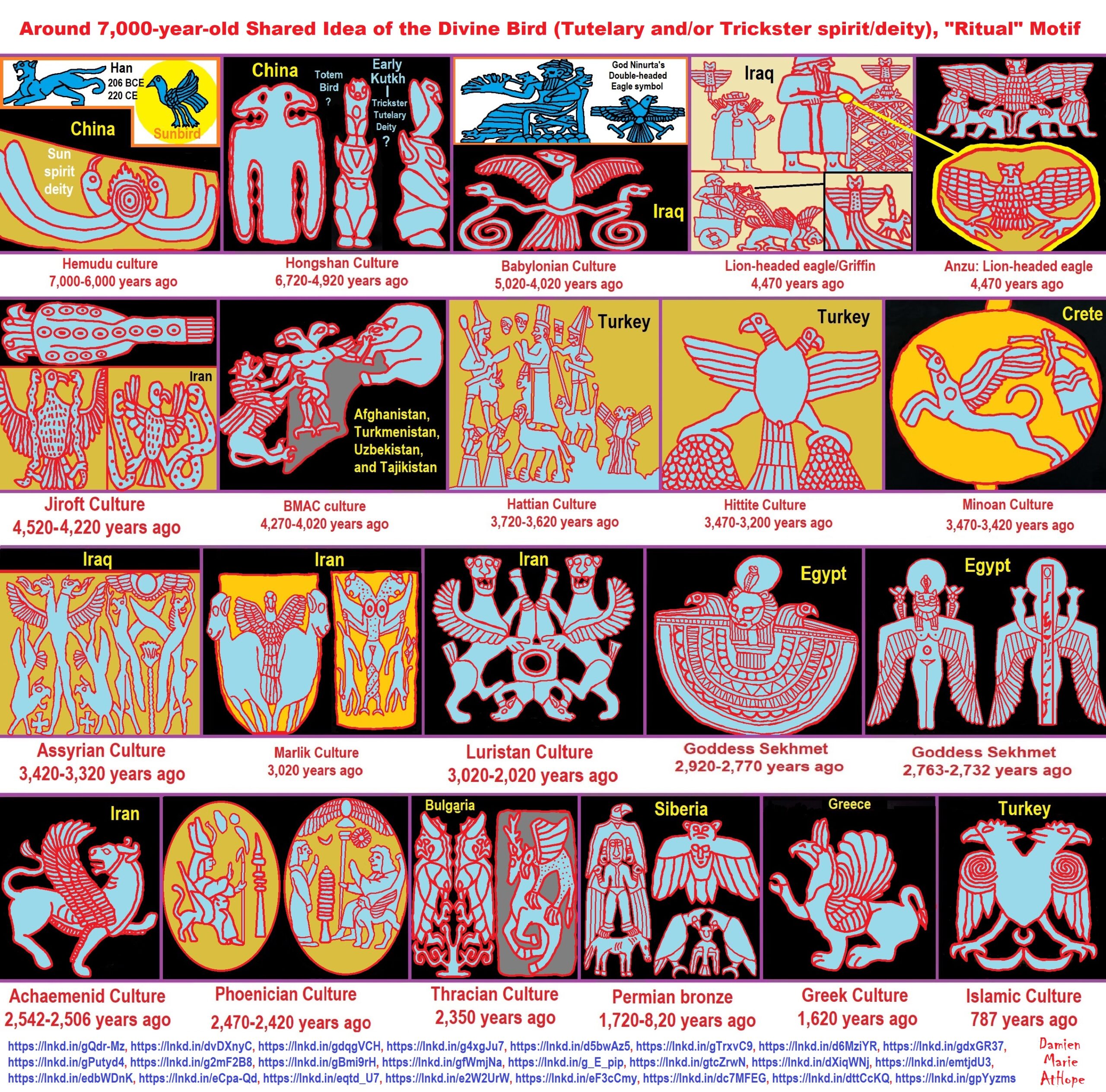
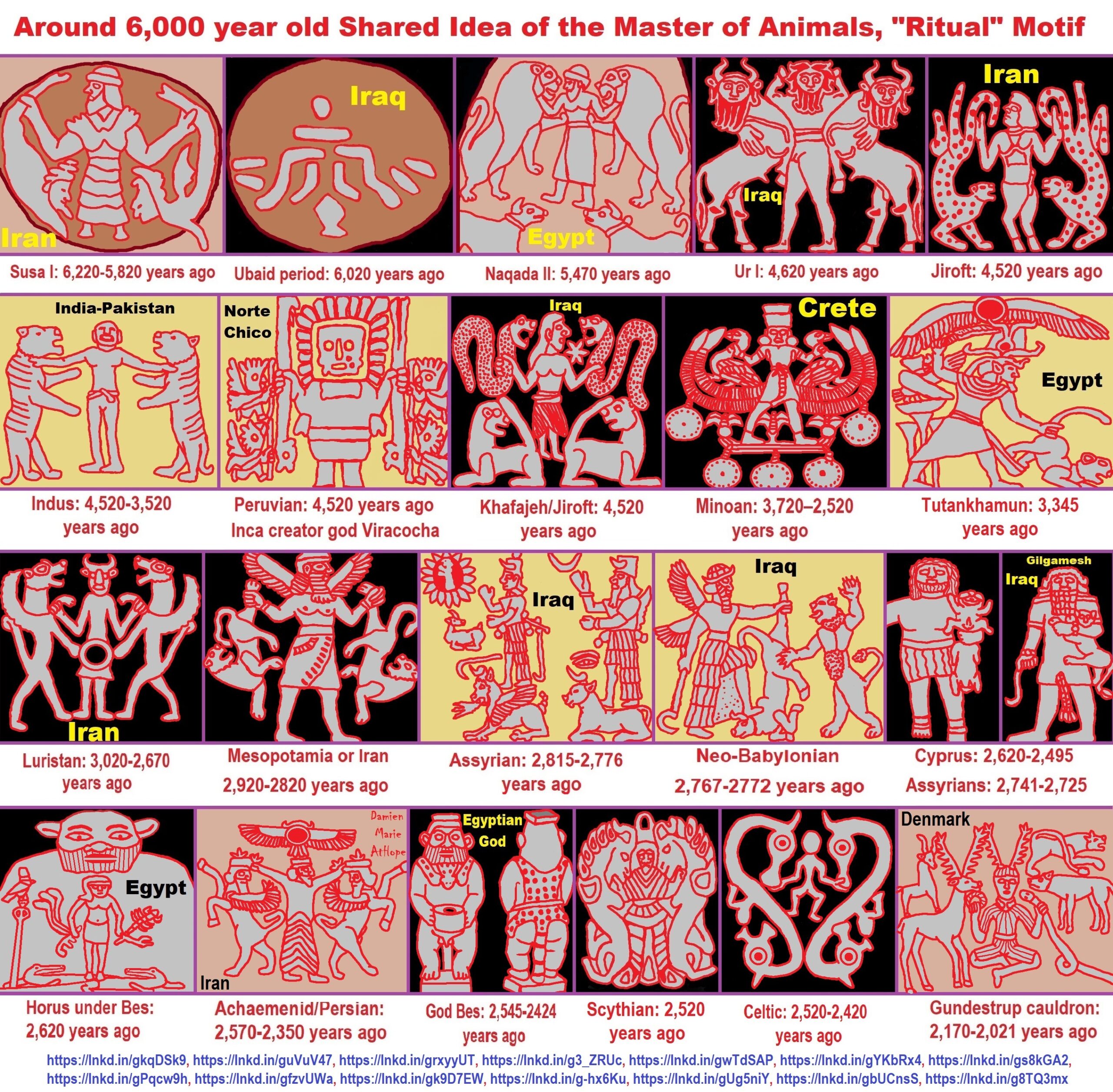

People don’t commonly teach religious history, even that of their own claimed religion. No, rather they teach a limited “pro their religion” history of their religion from a religious perspective favorable to the religion of choice.

Do you truly think “Religious Belief” is only a matter of some personal choice?
Do you not see how coercive one’s world of choice is limited to the obvious hereditary belief, in most religious choices available to the child of religious parents or caregivers? Religion is more commonly like a family, culture, society, etc. available belief that limits the belief choices of the child and that is when “Religious Belief” is not only a matter of some personal choice and when it becomes hereditary faith, not because of the quality of its alleged facts or proposed truths but because everyone else important to the child believes similarly so they do as well simply mimicking authority beliefs handed to them. Because children are raised in religion rather than being presented all possible choices but rather one limited dogmatic brand of “Religious Belief” where children only have a choice of following the belief as instructed, and then personally claim the faith hereditary belief seen in the confirming to the belief they have held themselves all their lives. This is obvious in statements asked and answered by children claiming a faith they barely understand but they do understand that their family believes “this or that” faith, so they feel obligated to believe it too. While I do agree that “Religious Belief” should only be a matter of some personal choice, it rarely is… End Hereditary Religion!

Animism: Respecting the Living World by Graham Harvey
“How have human cultures engaged with and thought about animals, plants, rocks, clouds, and other elements in their natural surroundings? Do animals and other natural objects have a spirit or soul? What is their relationship to humans? In this new study, Graham Harvey explores current and past animistic beliefs and practices of Native Americans, Maori, Aboriginal Australians, and eco-pagans. He considers the varieties of animism found in these cultures as well as their shared desire to live respectfully within larger natural communities. Drawing on his extensive casework, Harvey also considers the linguistic, performative, ecological, and activist implications of these different animisms.” ref

We are like believing machines we vacuum up ideas, like Velcro sticks to almost everything. We accumulate beliefs that we allow to negatively influence our lives, often without realizing it. Our willingness must be to alter skewed beliefs that impend our balance or reason, which allows us to achieve new positive thinking and accurate outcomes.

My thoughts on Religion Evolution with external links for more info:
- (Pre-Animism Africa mainly, but also Europe, and Asia at least 300,000 years ago), (Pre-Animism – Oxford Dictionaries)
- (Animism Africa around 100,000 years ago), (Animism – Britannica.com)
- (Totemism Europe around 50,000 years ago), (Totemism – Anthropology)
- (Shamanism Siberia around 30,000 years ago), (Shamanism – Britannica.com)
- (Paganism Turkey around 12,000 years ago), (Paganism – BBC Religion)
- (Progressed Organized Religion “Institutional Religion” Egypt around 5,000 years ago), (Ancient Egyptian Religion – Britannica.com)
- (CURRENT “World” RELIGIONS after 4,000 years ago) (Origin of Major Religions – Sacred Texts)
- (Early Atheistic Doubting at least by 2,600 years ago) (History of Atheism – Wikipedia)
“Religion is an Evolved Product” and Yes, Religion is Like Fear Given Wings…
Atheists talk about gods and religions for the same reason doctors talk about cancer, they are looking for a cure, or a firefighter talks about fires because they burn people and they care to stop them. We atheists too often feel a need to help the victims of mental slavery, held in the bondage that is the false beliefs of gods and the conspiracy theories of reality found in religions.
Understanding Religion Evolution:
- Pre-Animism (at least 300,000 years ago)
- Animism (Africa: 100,000 years ago)
- Totemism (Europe: 50,000 years ago)
- Shamanism (Siberia: 30,000 years ago)
- Paganism (Turkey: 12,000 years ago)
- Progressed organized religion (Egypt: 5,000 years ago), (Egypt, the First Dynasty 5,150 years ago)
- CURRENT “World” RELIGIONS (after 4,000 years ago)
- Early Atheistic Doubting (at least by 2,600 years ago)
“An Archaeological/Anthropological Understanding of Religion Evolution”
It seems ancient peoples had to survived amazing threats in a “dangerous universe (by superstition perceived as good and evil),” and human “immorality or imperfection of the soul” which was thought to affect the still living, leading to ancestor worship. This ancestor worship presumably led to the belief in supernatural beings, and then some of these were turned into the belief in gods. This feeble myth called gods were just a human conceived “made from nothing into something over and over, changing, again and again, taking on more as they evolve, all the while they are thought to be special,” but it is just supernatural animistic spirit-belief perceived as sacred.
Quick Evolution of Religion?
Pre-Animism (at least 300,000 years ago) pre-religion is a beginning that evolves into later Animism. So, Religion as we think of it, to me, all starts in a general way with Animism (Africa: 100,000 years ago) (theoretical belief in supernatural powers/spirits), then this is physically expressed in or with Totemism (Europe: 50,000 years ago) (theoretical belief in mythical relationship with powers/spirits through a totem item), which then enlists a full-time specific person to do this worship and believed interacting Shamanism (Siberia/Russia: 30,000 years ago) (theoretical belief in access and influence with spirits through ritual), and then there is the further employment of myths and gods added to all the above giving you Paganism (Turkey: 12,000 years ago) (often a lot more nature-based than most current top world religions, thus hinting to their close link to more ancient religious thinking it stems from). My hypothesis is expressed with an explanation of the building of a theatrical house (modern religions development). Progressed organized religion (Egypt: 5,000 years ago) with CURRENT “World” RELIGIONS (after 4,000 years ago).
Historically, in large city-state societies (such as Egypt or Iraq) starting around 5,000 years ago culminated to make religion something kind of new, a sociocultural-governmental-religious monarchy, where all or at least many of the people of such large city-state societies seem familiar with and committed to the existence of “religion” as the integrated life identity package of control dynamics with a fixed closed magical doctrine, but this juggernaut integrated religion identity package of Dogmatic-Propaganda certainly did not exist or if developed to an extent it was highly limited in most smaller prehistoric societies as they seem to lack most of the strong control dynamics with a fixed closed magical doctrine (magical beliefs could be at times be added or removed). Many people just want to see developed religious dynamics everywhere even if it is not. Instead, all that is found is largely fragments until the domestication of religion.
Religions, as we think of them today, are a new fad, even if they go back to around 6,000 years in the timeline of human existence, this amounts to almost nothing when seen in the long slow evolution of religion at least around 70,000 years ago with one of the oldest ritual worship. Stone Snake of South Africa: “first human worship” 70,000 years ago. This message of how religion and gods among them are clearly a man-made thing that was developed slowly as it was invented and then implemented peace by peace discrediting them all. Which seems to be a simple point some are just not grasping how devastating to any claims of truth when we can see the lie clearly in the archeological sites.
I wish people fought as hard for the actual values as they fight for the group/clan names political or otherwise they think support values. Every amount spent on war is theft to children in need of food or the homeless kept from shelter.
Here are several of my blog posts on history:
- To Find Truth You Must First Look
- (Magdalenian/Iberomaurusian) Connections to the First Paganists of the early Neolithic Near East Dating from around 17,000 to 12,000 Years Ago
- Natufians: an Ancient People at the Origins of Agriculture and Sedentary Life
- Possible Clan Leader/Special “MALE” Ancestor Totem Poles At Least 13,500 years ago?
- Jewish People with DNA at least 13,200 years old, Judaism, and the Origins of Some of its Ideas
- Baltic Reindeer Hunters: Swiderian, Lyngby, Ahrensburgian, and Krasnosillya cultures 12,020 to 11,020 years ago are evidence of powerful migratory waves during the last 13,000 years and a genetic link to Saami and the Finno-Ugric peoples.
- The Rise of Inequality: patriarchy and state hierarchy inequality
- Fertile Crescent 12,500 – 9,500 Years Ago: fertility and death cult belief system?
- 12,400 – 11,700 Years Ago – Kortik Tepe (Turkey) Pre/early-Agriculture Cultic Ritualism
- Ritualistic Bird Symbolism at Gobekli Tepe and its “Ancestor Cult”
- Male-Homosexual (female-like) / Trans-woman (female) Seated Figurine from Gobekli Tepe
- Could a 12,000-year-old Bull Geoglyph at Göbekli Tepe relate to older Bull and Female Art 25,000 years ago and Later Goddess and the Bull cults like Catal Huyuk?
- Sedentism and the Creation of goddesses around 12,000 years ago as well as male gods after 7,000 years ago.
- Alcohol, where Agriculture and Religion Become one? Such as Gobekli Tepe’s Ritualistic use of Grain as Food and Ritual Drink
- Neolithic Ritual Sites with T-Pillars and other Cultic Pillars
- Paganism: Goddesses around 12,000 years ago then Male Gods after 7,000 years ago
- First Patriarchy: Split of Women’s Status around 12,000 years ago & First Hierarchy: fall of Women’s Status around 5,000 years ago.
- Natufians: an Ancient People at the Origins of Agriculture and Sedentary Life
- J DNA and the Spread of Agricultural Religion (paganism)
- Paganism: an approximately 12,000-year-old belief system
- Paganism 12,000 years old: related to “Anarchism and Socialism” (Pre-Capitalism)
- Shaman burial in Israel 12,000 years ago and the Shamanism Phenomena
- Need to Mythicized: gods and goddesses
- 12,000 – 7,000 Years Ago – Paleo-Indian Culture (The Americas)
- 12,000 – 2,000 Years Ago – Indigenous-Scandinavians (Nordic)
- Norse did not wear helmets with horns?
- Pre-Pottery Neolithic Skull Cult around 11,500 to 8,400 Years Ago?
- 10,400 – 10,100 Years Ago, in Turkey the Nevail Cori Religious Settlement
- 9,000-6,500 Years Old Submerged Pre-Pottery/Pottery Neolithic Ritual Settlements off Israel’s Coast
- Catal Huyuk “first religious designed city” around 9,500 to 7,700 years ago (Turkey)
- Cultic Hunting at Catal Huyuk “first religious designed city”
- Special Items and Art as well as Special Elite Burials at Catal Huyuk
- New Rituals and Violence with the appearance of Pottery and People?
- Haplogroup N and its related Uralic Languages and Cultures
- Ainu people, Sámi people, Native Americans, the Ancient North Eurasians, and Paganistic-Shamanism with Totemism
- Ideas, Technology and People from Turkey, Europe, to China and Back again 9,000 to 5,000 years ago?
- First Pottery of Europe and the Related Cultures
- 9,000 years old Neolithic Artifacts Judean Desert and Hills Israel
- 9,000-7,000 years-old Sex and Death Rituals: Cult Sites in Israel, Jordan, and the Sinai
- 9,000-8500 year old Horned Female shaman Bad Dürrenberg Germany
- Neolithic Jewelry and the Spread of Farming in Europe Emerging out of West Turkey
- 8,600-year-old Tortoise Shells in Neolithic graves in central China have Early Writing and Shamanism
- Swing of the Mace: the rise of Elite, Forced Authority, and Inequality begin to Emerge 8,500 years ago?
- Migrations and Changing Europeans Beginning around 8,000 Years Ago
- My “Steppe-Anatolian-Kurgan hypothesis” 8,000/7,000 years ago
- Around 8,000-year-old Shared Idea of the Mistress of Animals, “Ritual” Motif
- Pre-Columbian Red-Paint (red ochre) Maritime Archaic Culture 8,000-3,000 years ago
- 7,522-6,522 years ago Linear Pottery culture which I think relates to Arcane Capitalism’s origins
- Arcane Capitalism: Primitive socialism, Primitive capital, Private ownership, Means of production, Market capitalism, Class discrimination, and Petite bourgeoisie (smaller capitalists)
- 7,500-4,750 years old Ritualistic Cucuteni-Trypillian culture of Moldova, Romania, and Ukraine
- Roots of a changing early society 7,200-6,700 years ago Jordan and Israel
- Agriculture religion (Paganism) with farming reached Britain between about 7,000 to 6,500 or so years ago and seemingly expressed in things like Western Europe’s Long Barrows
- My Thoughts on Possible Migrations of “R” DNA and Proto-Indo-European?
- “Millet” Spreading from China 7,022 years ago to Europe and related Language may have Spread with it leading to Proto-Indo-European
- Proto-Indo-European (PIE), ancestor of Indo-European languages: DNA, Society, Language, and Mythology
- The Dnieper–Donets culture and Asian varieties of Millet from China to the Black Sea region of Europe by 7,022 years ago
- Kurgan 6,000 years ago/dolmens 7,000 years ago: funeral, ritual, and other?
- 7,020 to 6,020-year-old Proto-Indo-European Homeland of Urheimat or proposed home of their Language and Religion
- Ancient Megaliths: Kurgan, Ziggurat, Pyramid, Menhir, Trilithon, Dolman, Kromlech, and Kromlech of Trilithons
- The Mytheme of Ancient North Eurasian Sacred-Dog belief and similar motifs are found in Indo-European, Native American, and Siberian comparative mythology
- Elite Power Accumulation: Ancient Trade, Tokens, Writing, Wealth, Merchants, and Priest-Kings
- Sacred Mounds, Mountains, Kurgans, and Pyramids may hold deep connections?
- Between 7,000-5,000 Years ago, rise of unequal hierarchy elite, leading to a “birth of the State” or worship of power, strong new sexism, oppression of non-elites, and the fall of Women’s equal status
- Paganism 7,000-5,000 years old: related to “Anarchism and Socialism” (Capitalism) (World War 0) Elite & their slaves
- Hell and Underworld mythologies starting maybe as far back as 7,000 to 5,000 years ago with the Proto-Indo-Europeans?
- The First Expression of the Male God around 7,000 years ago?
- White (light complexion skin) Bigotry and Sexism started 7,000 years ago?
- Around 7,000-year-old Shared Idea of the Divine Bird (Tutelary and/or Trickster spirit/deity), “Ritual” Motif
- Nekhbet an Ancient Egyptian Vulture Goddess and Tutelary Deity
- 6,720 to 4,920 years old Ritualistic Hongshan Culture of Inner Mongolia with 5,000-year-old Pyramid Mounds and Temples
- First proto-king in the Balkans, Varna culture around 6,500 years ago?
- 6,500–5,800 years ago in Israel Late Chalcolithic (Copper Age) Period in the Southern Levant Seems to Express Northern Levant Migrations, Cultural and Religious Transfer
- KING OF BEASTS: Master of Animals “Ritual” Motif, around 6,000 years old or older…
- Around 6000-year-old Shared Idea of the Solid Wheel & the Spoked Wheel-Shaped Ritual Motif
- “The Ghassulian Star,” a mysterious 6,000-year-old mural from Jordan; a Proto-Star of Ishtar, Star of Inanna or Star of Venus?
- Religious/Ritual Ideas, including goddesses and gods as well as ritual mounds or pyramids from Northeastern Asia at least 6,000 years old, seemingly filtering to Iran, Iraq, the Mediterranean, Europe, Egypt, and the Americas?
- Maykop (5,720–5,020 years ago) Caucasus region Bronze Age culture-related to Copper Age farmers from the south, influenced by the Ubaid period and Leyla-Tepe culture, as well as influencing the Kura-Araxes culture
- 5-600-year-old Tomb, Mummy, and First Bearded Male Figurine in a Grave
- Kura-Araxes Cultural 5,520 to 4,470 years old DNA traces to the Canaanites, Arabs, and Jews
- Minoan/Cretan (Keftiu) Civilization and Religion around 5,520 to 3,120 years ago
- Evolution Of Science at least by 5,500 years ago
- 5,500 Years old birth of the State, the rise of Hierarchy, and the fall of Women’s status
- “Jiroft culture” 5,100 – 4,200 years ago and the History of Iran
- Stonehenge: Paganistic Burial and Astrological Ritual Complex, England (5,100-3,600 years ago)
- Around 5,000-year-old Shared Idea of the “Tree of Life” Ritual Motif
- Complex rituals for elite, seen from China to Egypt, at least by 5,000 years ago
- Around 5,000 years ago: “Birth of the State” where Religion gets Military Power and Influence
- The Center of the World “Axis Mundi” and/or “Sacred Mountains” Mythology Could Relate to the Altai Mountains, Heart of the Steppe
- Progressed organized religion starts, an approximately 5,000-year-old belief system
- China’s Civilization between 5,000-3,000 years ago, was a time of war and class struggle, violent transition from free clans to a Slave or Elite society
- Origin of Logics is Naturalistic Observation at least by around 5,000 years ago.
- Paganism 5,000 years old: progressed organized religion and the state: related to “Anarchism and Socialism” (Kings and the Rise of the State)
- Ziggurats (multi-platform temples: 4,900 years old) to Pyramids (multi-platform tombs: 4,700 years old)
- Did a 4,520–4,420-year-old Volcano In Turkey Inspire the Bible God?
- Finland’s Horned Shaman and Pre-Horned-God at least 4,500 years ago?
- 4,000-year-Old Dolmens in Israel: A Connected Dolmen Religious Phenomenon?
- Creation myths: From chaos, Ex nihilo, Earth-diver, Emergence, World egg, and World parent
- Bronze Age “Ritual” connections of the Bell Beaker culture with the Corded Ware/Single Grave culture, which were related to the Yamnaya culture and Proto-Indo-European Languages/Religions
- Low Gods (Earth/ Tutelary deity), High Gods (Sky/Supreme deity), and Moralistic Gods (Deity enforcement/divine order)
- The exchange of people, ideas, and material-culture including, to me, the new god (Sky Father) and goddess (Earth Mother) religion between the Cucuteni-Trypillians and others which is then spread far and wide
- Koryaks: Indigenous People of the Russian Far East and Big Raven myths also found in Tlingit, Haida, Tsimshian, and other Indigenous People of North America
- 42 Principles Of Maat (Egyptian Goddess of the justice) around 4,400 years ago, 2000 Years Before Ten Commandments
- “Happy Easter” Well Happy Eostre/Ishter
- 4,320-3,820 years old “Shimao” (North China) site with Totemistic-Shamanistic Paganism and a Stepped Pyramid
- 4,250 to 3,400 Year old Stonehenge from Russia: Arkaim?
- 4,100-year-old beaker with medicinal & flowering plants in a grave of a woman in Scotland
- Early European Farmer ancestry, Kelif el Boroud people with the Cardial Ware culture, and the Bell Beaker culture Paganists too, spread into North Africa, then to the Canary Islands off West Africa
- Flood Accounts: Gilgamesh epic (4,100 years ago) Noah in Genesis (2,600 years ago)
- Paganism 4,000 years old: related to “Anarchism and Socialism” (First Moralistic gods, then the Origin time of Monotheism)
- When was the beginning: TIMELINE OF CURRENT RELIGIONS, which start around 4,000 years ago.
- Early Religions Thought to Express Proto-Monotheistic Systems around 4,000 years ago
- Kultepe? An archaeological site with a 4,000 years old women’s rights document.
- Single God Religions (Monotheism) = “Man-o-theism” started around 4,000 years ago with the Great Sky Spirit/God Tiān (天)?
- Confucianism’s Tiān (Shangdi god 4,000 years old): Supernaturalism, Pantheism or Theism?
- Yes, Your Male God is Ridiculous
- Mythology, a Lunar Deity is a Goddess or God of the Moon
- Sacred Land, Hills, and Mountains: Sami Mythology (Paganistic Shamanism)
- Horse Worship/Sacrifice: mythical union of Ruling Elite/Kingship and the Horse
- The Amorite/Amurru people’s God Amurru “Lord of the Steppe”, relates to the Origins of the Bible God?
- Bronze Age Exotic Trade Routes Spread Quite Far as well as Spread Religious Ideas with Them
- Sami and the Northern Indigenous Peoples Landscape, Language, and its Connection to Religion
- Prototype of Ancient Analemmatic Sundials around 3,900-3,150 years ago and a Possible Solar Connection to gods?
- Judaism is around 3,450 or 3,250 years old. (“Paleo-Hebrew” 3,000 years ago and Torah 2,500 years ago)
- The Weakening of Ancient Trade and the Strengthening of Religions around 3000 years ago?
- Are you aware that there are religions that worship women gods, explain now religion tears women down?
- Animistic, Totemistic, and Paganistic Superstition Origins of bible god and the bible’s Religion.
- Myths and Folklore: “Trickster gods and goddesses”
- Jews, Judaism, and the Origins of Some of its Ideas
- An Old Branch of Religion Still Giving Fruit: Sacred Trees
- Dating the BIBLE: naming names and telling times (written less than 3,000 years ago, provable to 2,200 years ago)
- Did a Volcano Inspire the bible god?
- The Amorite/Amurru people’s God Amurru “Lord of the Steppe”, relates to the Origins of the Bible God?
- Dené–Yeniseian language, Old Copper Complex, and Pre-Columbian Mound Builders?
- No “dinosaurs and humans didn’t exist together just because some think they are in the bible itself”
- Sacred Shit and Sacred Animals?
- Everyone Killed in the Bible Flood? “Nephilim” (giants)?
- Hey, Damien dude, I have a question for you regarding “the bible” Exodus.
- Archaeology Disproves the Bible
- Bible Battle, Just More, Bible Babble
- The Jericho Conquest lie?
- Canaanites and Israelites?
- Accurate Account on how did Christianity Began?
- Let’s talk about Christianity.
- So the 10 commandments isn’t anything to go by either right?
- Misinformed christian
- Debunking Jesus?
- Paulism vs Jesus
- Ok, you seem confused so let’s talk about Buddhism.
- Unacknowledged Buddhism: Gods, Savior, Demons, Rebirth, Heavens, Hells, and Terrorism
- His Foolishness The Dalai Lama
- Yin and Yang is sexist with an ORIGIN around 2,300 years ago?
- I Believe Archaeology, not Myths & Why Not, as the Religious Myths Already Violate Reason!
- Archaeological, Scientific, & Philosophic evidence shows the god myth is man-made nonsense.
- Aquatic Ape Theory/Hypothesis? As Always, Just Pseudoscience.
- Ancient Aliens Conspiracy Theorists are Pseudohistorians
- The Pseudohistoric and Pseudoscientific claims about “Bakoni Ruins” of South Africa
- Why do people think Religion is much more than supernaturalism and superstitionism?
- Religion is an Evolved Product
- Was the Value of Ancient Women Different?
- 1000 to 1100 CE, human sacrifice Cahokia Mounds a pre-Columbian Native American site
- Feminist atheists as far back as the 1800s?
- Promoting Religion as Real is Mentally Harmful to a Flourishing Humanity
- Screw All Religions and Their Toxic lies, they are all fraud
- Forget Religions’ Unfounded Myths, I Have Substantiated “Archaeology Facts.”
- Religion Dispersal throughout the World
- I Hate Religion Just as I Hate all Pseudoscience
- Exposing Scientology, Eckankar, Wicca and Other Nonsense?
- Main deity or religious belief systems
- Quit Trying to Invent Your God From the Scraps of Science.
- Archaeological, Scientific, & Philosophic evidence shows the god myth is man-made nonsense.
- Ancient Alien Conspiracy Theorists: Misunderstanding, Rhetoric, Misinformation, Fabrications, and Lies
- Misinformation, Distortion, and Pseudoscience in Talking with a Christian Creationist
- Judging the Lack of Goodness in Gods, Even the Norse God Odin
- Challenging the Belief in God-like Aliens and Gods in General
- A Challenge to Christian use of Torture Devices?
- Yes, Hinduism is a Religion
- Trump is One of the Most Reactionary Forces of Far-right Christian Extremism
- Was the Bull Head a Symbol of God? Yes!
- Primate Death Rituals
- Christian – “God and Christianity are objectively true”
- Australopithecus afarensis Death Ritual?
- You Claim Global Warming is a Hoax?
- Doubter of Science and Defamer of Atheists?
- I think that sounds like the Bible?
- History of the Antifa (“anti-fascist”) Movements
- Indianapolis Anti-Blasphemy Laws #Free Soheil Rally
- Damien, you repeat the golden rule in so many forms then you say religion is dogmatic?
- Science is a Trustable Methodology whereas Faith is not Trustable at all!
- Was I ever a believer, before I was an atheist?
- Atheists rise in reason
- Mistrust of science?
- Open to Talking About the Definition of ‘God’? But first, we address Faith.
- ‘United Monarchy’ full of splendor and power – Saul, David, and Solomon? Most likely not.
- Is there EXODUS ARCHAEOLOGY? The short answer is “no.”
- Lacking Proof of Bigfoots, Unicorns, and Gods is Just a Lack of Research?
- Religion and Politics: Faith Beliefs vs. Rational Thinking
- Hammer of Truth that lying pig RELIGION: challenged by an archaeologist
- “The Hammer of Truth” -ontology question- What do You Mean by That?
- Navigation of a bad argument: Ad Hominem vs. Attack
- Why is it Often Claimed that Gods have a Gender?
- Why are basically all monotheistic religions ones that have a male god?
- Shifting through the Claims in support of Faith
- Dear Mr. AtHope, The 20th Century is an Indictment of Secularism and a Failed Atheist Century
- An Understanding of the Worldwide Statistics and Dynamics of Terrorist Incidents and Suicide Attacks
- Intoxication and Evolution? Addressing and Assessing the “Stoned Ape” or “Drunken Monkey” Theories as Catalysts in Human Evolution
- Sacred Menstrual cloth? Inanna’s knot, Isis knot, and maybe Ma’at’s feather?
- Damien, why don’t the Hebrews accept the bible stories?
- Dealing with a Troll and Arguing Over Word Meaning
- Knowledge without Belief? Justified beliefs or disbeliefs worthy of Knowledge?
- Afrocentrism and African Religions
- Crecganford @crecganford offers history & stories of the people, places, gods, & culture
- Empiricism-Denier?
I am not an academic. I am a revolutionary that teaches in public, in places like social media, and in the streets. I am not a leader by some title given but from my commanding leadership style of simply to start teaching everywhere to everyone, all manner of positive education.



To me, Animism starts in Southern Africa, then to West Europe, and becomes Totemism. Another split goes near the Russia and Siberia border becoming Shamanism, which heads into Central Europe meeting up with Totemism, which also had moved there, mixing the two which then heads to Lake Baikal in Siberia. From there this Shamanism-Totemism heads to Turkey where it becomes Paganism.





Not all “Religions” or “Religious Persuasions” have a god(s) but
All can be said to believe in some imaginary beings or imaginary things like spirits, afterlives, etc.
Totemism is associated with kinship and the veneration of some natural objects, animals, plants, elements, and other physical objects, believed to have some spiritual or supernatural powers. So, harming of totemic animals is considered a taboo in most African cultures. Animism (‘breath, spirit, life’) belief objects, places, and nature may possess spiritual essence spirit.
Animism
“Animism (from Latin: anima, ‘breath, spirit, life‘) is the belief that objects, places, and creatures all possess a distinct spiritual essence. Potentially, animism perceives all things—animals, plants, rocks, rivers, weather systems, human handiwork, and perhaps even words—as animated and alive. Animism is used in the anthropology of religion as a term for the belief system of many indigenous peoples, especially in contrast to the relatively more recent development of organised religions. Although each culture has its own different mythologies and rituals, animism is said to describe the most common, foundational thread of indigenous peoples’ “spiritual” or “supernatural” perspectives. The animistic perspective is so widely held and inherent to most indigenous peoples that they often do not even have a word in their languages that corresponds to “animism” (or even “religion”); the term is an anthropological construct.” ref
“Aka people” Central African nomadic Mbenga pygmy people (Animist)
“Aka are very warm and hospitable. Relationships between men and women are extremely egalitarian. Men and women contribute equally to a household’s diet, either a husband or wife can initiate divorce, and violence against women is very rare. No cases of rape have been reported. The Aka are fiercely egalitarian and independent. No individual has the right to force or order another individual to perform an activity against his or her will. Aka have a number of informal methods for maintaining their egalitarianism. First, they practice “prestige avoidance”; no one draws attention to his or her own abilities. Individuals play down their achievements.” ref
Mbuti People of the Congo (Animist)
“The Mbuti hunter-gatherers in the Congo’s Ituri Forest have traditionally lived in stateless communities with gift economies and largely egalitarian gender relations. They were a people who had found in the forest something that made life more than just worth living, something that made it, with all its hardships and problems and tragedies, a wonderful thing full of joy and happiness and free of care. Pygmies, like the Inuit, minimize discrimination based upon sex and age differences. Adults of all genders make communal decisions at public assemblies. The Mbuti do not have a state, or chiefs or councils.” ref
Hadza people of East Africa (Animist)
“The Hadza of Tanzania in East Africa are egalitarian, meaning there are no real status differences between individuals. While the elderly receive slightly more respect, within groups of age and sex all individuals are equal, and compared to strictly stratified societies, women are considered fairly equal. This egalitarianism results in high levels of freedom and self-dependency. When conflict does arise, it may be resolved by one of the parties voluntarily moving to another camp. Ernst Fehr and Urs Fischbacher point out that the Hadza people “exhibit a considerable amount of altruistic punishment” to organize these tribes. The Hadza live in a communal setting and engage in cooperative child-rearing, where many individuals (both related and unrelated) provide high-quality care for children. Having no tribal or governing hierarchy, the Hadza trace descent bilaterally (through paternal and maternal lines), and almost all Hadza can trace some kin tie to all other Hadza people. ” ref

Paganism 12,000-4,000 years old
12,000-7,000 years old: related to (Pre-Capitalism)
7,000-5,000 years old: related to (Capitalism) (World War 0) Elite and their slaves!
5,000 years old: related to (Kings and the Rise of the State)
4,000 years old: related to (First Moralistic gods, then the Origin time of Monotheism)

ref, ref, ref, ref, ref, ref, ref, ref, ref, ref, ref, ref, ref, ref, ref, ref, ref, ref, ref, ref, ref
Low Gods “Earth” or Tutelary deity and High Gods “Sky” or Supreme deity
“An Earth goddess is a deification of the Earth. Earth goddesses are often associated with the “chthonic” deities of the underworld. Ki and Ninhursag are Mesopotamian earth goddesses. In Greek mythology, the Earth is personified as Gaia, corresponding to Roman Terra, Indic Prithvi/Bhūmi, etc. traced to an “Earth Mother” complementary to the “Sky Father” in Proto-Indo-European religion. Egyptian mythology exceptionally has a sky goddess and an Earth god.” ref
“A mother goddess is a goddess who represents or is a personification of nature, motherhood, fertility, creation, destruction or who embodies the bounty of the Earth. When equated with the Earth or the natural world, such goddesses are sometimes referred to as Mother Earth or as the Earth Mother. In some religious traditions or movements, Heavenly Mother (also referred to as Mother in Heaven or Sky Mother) is the wife or feminine counterpart of the Sky father or God the Father.” ref
“Any masculine sky god is often also king of the gods, taking the position of patriarch within a pantheon. Such king gods are collectively categorized as “sky father” deities, with a polarity between sky and earth often being expressed by pairing a “sky father” god with an “earth mother” goddess (pairings of a sky mother with an earth father are less frequent). A main sky goddess is often the queen of the gods and may be an air/sky goddess in her own right, though she usually has other functions as well with “sky” not being her main. In antiquity, several sky goddesses in ancient Egypt, Mesopotamia, and the Near East were called Queen of Heaven. Neopagans often apply it with impunity to sky goddesses from other regions who were never associated with the term historically. The sky often has important religious significance. Many religions, both polytheistic and monotheistic, have deities associated with the sky.” ref
“In comparative mythology, sky father is a term for a recurring concept in polytheistic religions of a sky god who is addressed as a “father”, often the father of a pantheon and is often either a reigning or former King of the Gods. The concept of “sky father” may also be taken to include Sun gods with similar characteristics, such as Ra. The concept is complementary to an “earth mother“. “Sky Father” is a direct translation of the Vedic Dyaus Pita, etymologically descended from the same Proto-Indo-European deity name as the Greek Zeûs Pater and Roman Jupiter and Germanic Týr, Tir or Tiwaz, all of which are reflexes of the same Proto-Indo-European deity’s name, *Dyēus Ph₂tḗr. While there are numerous parallels adduced from outside of Indo-European mythology, there are exceptions (e.g. In Egyptian mythology, Nut is the sky mother and Geb is the earth father).” ref
Tutelary deity
“A tutelary (also tutelar) is a deity or spirit who is a guardian, patron, or protector of a particular place, geographic feature, person, lineage, nation, culture, or occupation. The etymology of “tutelary” expresses the concept of safety and thus of guardianship. In late Greek and Roman religion, one type of tutelary deity, the genius, functions as the personal deity or daimon of an individual from birth to death. Another form of personal tutelary spirit is the familiar spirit of European folklore.” ref
“A tutelary (also tutelar) in Korean shamanism, jangseung and sotdae were placed at the edge of villages to frighten off demons. They were also worshiped as deities. Seonangshin is the patron deity of the village in Korean tradition and was believed to embody the Seonangdang. In Philippine animism, Diwata or Lambana are deities or spirits that inhabit sacred places like mountains and mounds and serve as guardians. Such as: Maria Makiling is the deity who guards Mt. Makiling and Maria Cacao and Maria Sinukuan. In Shinto, the spirits, or kami, which give life to human bodies come from nature and return to it after death. Ancestors are therefore themselves tutelaries to be worshiped. And similarly, Native American beliefs such as Tonás, tutelary animal spirit among the Zapotec and Totems, familial or clan spirits among the Ojibwe, can be animals.” ref
“A tutelary (also tutelar) in Austronesian beliefs such as: Atua (gods and spirits of the Polynesian peoples such as the Māori or the Hawaiians), Hanitu (Bunun of Taiwan‘s term for spirit), Hyang (Kawi, Sundanese, Javanese, and Balinese Supreme Being, in ancient Java and Bali mythology and this spiritual entity, can be either divine or ancestral), Kaitiaki (New Zealand Māori term used for the concept of guardianship, for the sky, the sea, and the land), Kawas (mythology) (divided into 6 groups: gods, ancestors, souls of the living, spirits of living things, spirits of lifeless objects, and ghosts), Tiki (Māori mythology, Tiki is the first man created by either Tūmatauenga or Tāne and represents deified ancestors found in most Polynesian cultures). ” ref, ref, ref, ref, ref, ref, ref
Mesopotamian Tutelary Deities can be seen as ones related to City-States
“Historical city-states included Sumerian cities such as Uruk and Ur; Ancient Egyptian city-states, such as Thebes and Memphis; the Phoenician cities (such as Tyre and Sidon); the five Philistine city-states; the Berber city-states of the Garamantes; the city-states of ancient Greece (the poleis such as Athens, Sparta, Thebes, and Corinth); the Roman Republic (which grew from a city-state into a vast empire); the Italian city-states from the Middle Ages to the early modern period, such as Florence, Siena, Ferrara, Milan (which as they grew in power began to dominate neighboring cities) and Genoa and Venice, which became powerful thalassocracies; the Mayan and other cultures of pre-Columbian Mesoamerica (including cities such as Chichen Itza, Tikal, Copán and Monte Albán); the central Asian cities along the Silk Road; the city-states of the Swahili coast; Ragusa; states of the medieval Russian lands such as Novgorod and Pskov; and many others.” ref
“The Uruk period (ca. 4000 to 3100 BCE; also known as Protoliterate period) of Mesopotamia, named after the Sumerian city of Uruk, this period saw the emergence of urban life in Mesopotamia and the Sumerian civilization. City-States like Uruk and others had a patron tutelary City Deity along with a Priest-King.” ref
“Chinese folk religion, both past, and present, includes myriad tutelary deities. Exceptional individuals, highly cultivated sages, and prominent ancestors can be deified and honored after death. Lord Guan is the patron of military personnel and police, while Mazu is the patron of fishermen and sailors. Such as Tu Di Gong (Earth Deity) is the tutelary deity of a locality, and each individual locality has its own Earth Deity and Cheng Huang Gong (City God) is the guardian deity of an individual city, worshipped by local officials and locals since imperial times.” ref
“A tutelary (also tutelar) in Hinduism, personal tutelary deities are known as ishta-devata, while family tutelary deities are known as Kuladevata. Gramadevata are guardian deities of villages. Devas can also be seen as tutelary. Shiva is the patron of yogis and renunciants. City goddesses include: Mumbadevi (Mumbai), Sachchika (Osian); Kuladevis include: Ambika (Porwad), and Mahalakshmi. In NorthEast India Meitei mythology and religion (Sanamahism) of Manipur, there are various types of tutelary deities, among which Lam Lais are the most predominant ones. Tibetan Buddhism has Yidam as a tutelary deity. Dakini is the patron of those who seek knowledge.” ref
“A tutelary (also tutelar) The Greeks also thought deities guarded specific places: for instance, Athena was the patron goddess of the city of Athens. Socrates spoke of hearing the voice of his personal spirit or daimonion:
You have often heard me speak of an oracle or sign which comes to me … . This sign I have had ever since I was a child. The sign is a voice which comes to me and always forbids me to do something which I am going to do, but never commands me to do anything, and this is what stands in the way of my being a politician.” ref
“Tutelary deities who guard and preserve a place or a person are fundamental to ancient Roman religion. The tutelary deity of a man was his Genius, that of a woman her Juno. In the Imperial era, the Genius of the Emperor was a focus of Imperial cult. An emperor might also adopt a major deity as his personal patron or tutelary, as Augustus did Apollo. Precedents for claiming the personal protection of a deity were established in the Republican era, when for instance the Roman dictator Sulla advertised the goddess Victory as his tutelary by holding public games (ludi) in her honor.” ref
“Each town or city had one or more tutelary deities, whose protection was considered particularly vital in time of war and siege. Rome itself was protected by a goddess whose name was to be kept ritually secret on pain of death (for a supposed case, see Quintus Valerius Soranus). The Capitoline Triad of Juno, Jupiter, and Minerva were also tutelaries of Rome. The Italic towns had their own tutelary deities. Juno often had this function, as at the Latin town of Lanuvium and the Etruscan city of Veii, and was often housed in an especially grand temple on the arx (citadel) or other prominent or central location. The tutelary deity of Praeneste was Fortuna, whose oracle was renowned.” ref
“The Roman ritual of evocatio was premised on the belief that a town could be made vulnerable to military defeat if the power of its tutelary deity were diverted outside the city, perhaps by the offer of superior cult at Rome. The depiction of some goddesses such as the Magna Mater (Great Mother, or Cybele) as “tower-crowned” represents their capacity to preserve the city. A town in the provinces might adopt a deity from within the Roman religious sphere to serve as its guardian, or syncretize its own tutelary with such; for instance, a community within the civitas of the Remi in Gaul adopted Apollo as its tutelary, and at the capital of the Remi (present-day Rheims), the tutelary was Mars Camulus.” ref
Household deity (a kind of or related to a Tutelary deity)
“A household deity is a deity or spirit that protects the home, looking after the entire household or certain key members. It has been a common belief in paganism as well as in folklore across many parts of the world. Household deities fit into two types; firstly, a specific deity – typically a goddess – often referred to as a hearth goddess or domestic goddess who is associated with the home and hearth, such as the ancient Greek Hestia.” ref
“The second type of household deities are those that are not one singular deity, but a type, or species of animistic deity, who usually have lesser powers than major deities. This type was common in the religions of antiquity, such as the Lares of ancient Roman religion, the Gashin of Korean shamanism, and Cofgodas of Anglo-Saxon paganism. These survived Christianisation as fairy-like creatures existing in folklore, such as the Anglo-Scottish Brownie and Slavic Domovoy.” ref
“Household deities were usually worshipped not in temples but in the home, where they would be represented by small idols (such as the teraphim of the Bible, often translated as “household gods” in Genesis 31:19 for example), amulets, paintings, or reliefs. They could also be found on domestic objects, such as cosmetic articles in the case of Tawaret. The more prosperous houses might have a small shrine to the household god(s); the lararium served this purpose in the case of the Romans. The gods would be treated as members of the family and invited to join in meals, or be given offerings of food and drink.” ref
“In many religions, both ancient and modern, a god would preside over the home. Certain species, or types, of household deities, existed. An example of this was the Roman Lares. Many European cultures retained house spirits into the modern period. Some examples of these include:
- Brownie (Scotland and England) or Hob (England) / Kobold (Germany) / Goblin / Hobgoblin
- Domovoy (Slavic)
- Nisse (Norwegian or Danish) / Tomte (Swedish) / Tonttu (Finnish)
- Húsvættir (Norse)” ref
“Although the cosmic status of household deities was not as lofty as that of the Twelve Olympians or the Aesir, they were also jealous of their dignity and also had to be appeased with shrines and offerings, however humble. Because of their immediacy they had arguably more influence on the day-to-day affairs of men than the remote gods did. Vestiges of their worship persisted long after Christianity and other major religions extirpated nearly every trace of the major pagan pantheons. Elements of the practice can be seen even today, with Christian accretions, where statues to various saints (such as St. Francis) protect gardens and grottos. Even the gargoyles found on older churches, could be viewed as guardians partitioning a sacred space.” ref
“For centuries, Christianity fought a mop-up war against these lingering minor pagan deities, but they proved tenacious. For example, Martin Luther‘s Tischreden have numerous – quite serious – references to dealing with kobolds. Eventually, rationalism and the Industrial Revolution threatened to erase most of these minor deities, until the advent of romantic nationalism rehabilitated them and embellished them into objects of literary curiosity in the 19th century. Since the 20th century this literature has been mined for characters for role-playing games, video games, and other fantasy personae, not infrequently invested with invented traits and hierarchies somewhat different from their mythological and folkloric roots.” ref
“In contradistinction to both Herbert Spencer and Edward Burnett Tylor, who defended theories of animistic origins of ancestor worship, Émile Durkheim saw its origin in totemism. In reality, this distinction is somewhat academic, since totemism may be regarded as a particularized manifestation of animism, and something of a synthesis of the two positions was attempted by Sigmund Freud. In Freud’s Totem and Taboo, both totem and taboo are outward expressions or manifestations of the same psychological tendency, a concept which is complementary to, or which rather reconciles, the apparent conflict. Freud preferred to emphasize the psychoanalytic implications of the reification of metaphysical forces, but with particular emphasis on its familial nature. This emphasis underscores, rather than weakens, the ancestral component.” ref
“William Edward Hearn, a noted classicist, and jurist, traced the origin of domestic deities from the earliest stages as an expression of animism, a belief system thought to have existed also in the neolithic, and the forerunner of Indo-European religion. In his analysis of the Indo-European household, in Chapter II “The House Spirit”, Section 1, he states:
The belief which guided the conduct of our forefathers was … the spirit rule of dead ancestors.” ref
“In Section 2 he proceeds to elaborate:
It is thus certain that the worship of deceased ancestors is a vera causa, and not a mere hypothesis. …
In the other European nations, the Slavs, the Teutons, and the Kelts, the House Spirit appears with no less distinctness. … [T]he existence of that worship does not admit of doubt. … The House Spirits had a multitude of other names which it is needless here to enumerate, but all of which are more or less expressive of their friendly relations with man. … In [England] … [h]e is the Brownie. … In Scotland this same Brownie is well known. He is usually described as attached to particular families, with whom he has been known to reside for centuries, threshing the corn, cleaning the house, and performing similar household tasks. His favorite gratification was milk and honey.” ref

ref, ref, ref, ref, ref, ref, ref, ref, ref, ref, ref, ref, ref, ref, ref, ref, ref
“These ideas are my speculations from the evidence.”
I am still researching the “god‘s origins” all over the world. So you know, it is very complicated but I am smart and willing to look, DEEP, if necessary, which going very deep does seem to be needed here, when trying to actually understand the evolution of gods and goddesses. I am sure of a few things and less sure of others, but even in stuff I am not fully grasping I still am slowly figuring it out, to explain it to others. But as I research more I am understanding things a little better, though I am still working on understanding it all or something close and thus always figuring out more.
Sky Father/Sky God?
“Egyptian: (Nut) Sky Mother and (Geb) Earth Father” (Egypt is different but similar)
Turkic/Mongolic: (Tengri/Tenger Etseg) Sky Father and (Eje/Gazar Eej) Earth Mother *Transeurasian*
Hawaiian: (Wākea) Sky Father and (Papahānaumoku) Earth Mother *Austronesian*
New Zealand/ Māori: (Ranginui) Sky Father and (Papatūānuku) Earth Mother *Austronesian*
Proto-Indo-European: (Dyḗus/Dyḗus ph₂tḗr) Sky Father and (Dʰéǵʰōm/Pleth₂wih₁) Earth Mother
Indo-Aryan: (Dyaus Pita) Sky Father and (Prithvi Mata) Earth Mother *Indo-European*
Italic: (Jupiter) Sky Father and (Juno) Sky Mother *Indo-European*
Etruscan: (Tinia) Sky Father and (Uni) Sky Mother *Tyrsenian/Italy Pre–Indo-European*
Hellenic/Greek: (Zeus) Sky Father and (Hera) Sky Mother who started as an “Earth Goddess” *Indo-European*
Nordic: (Dagr) Sky Father and (Nótt) Sky Mother *Indo-European*
Slavic: (Perun) Sky Father and (Mokosh) Earth Mother *Indo-European*
Illyrian: (Deipaturos) Sky Father and (Messapic Damatura’s “earth-mother” maybe) Earth Mother *Indo-European*
Albanian: (Zojz) Sky Father and (?) *Indo-European*
Baltic: (Perkūnas) Sky Father and (Saulė) Sky Mother *Indo-European*
Germanic: (Týr) Sky Father and (?) *Indo-European*
Colombian-Muisca: (Bochica) Sky Father and (Huythaca) Sky Mother *Chibchan*
Aztec: (Quetzalcoatl) Sky Father and (Xochiquetzal) Sky Mother *Uto-Aztecan*
Incan: (Viracocha) Sky Father and (Mama Runtucaya) Sky Mother *Quechuan*
China: (Tian/Shangdi) Sky Father and (Dì) Earth Mother *Sino-Tibetan*
Sumerian, Assyrian and Babylonian: (An/Anu) Sky Father and (Ki) Earth Mother
Finnish: (Ukko) Sky Father and (Akka) Earth Mother *Finno-Ugric*
Sami: (Horagalles) Sky Father and (Ravdna) Earth Mother *Finno-Ugric*
Puebloan-Zuni: (Ápoyan Ta’chu) Sky Father and (Áwitelin Tsíta) Earth Mother
Puebloan-Hopi: (Tawa) Sky Father and (Kokyangwuti/Spider Woman/Grandmother) Earth Mother *Uto-Aztecan*
Puebloan-Navajo: (Tsohanoai) Sky Father and (Estsanatlehi) Earth Mother *Na-Dene*
ref, ref, ref, ref, ref, ref, ref, ref, ref, ref, ref, ref, ref, ref, ref, ref, ref, ref, ref, ref, ref, ref, ref, ref, ref, ref, ref

Hinduism around 3,700 to 3,500 years old. ref
Judaism around 3,450 or 3,250 years old. (The first writing in the bible was “Paleo-Hebrew” dated to around 3,000 years ago Khirbet Qeiyafa is the site of an ancient fortress city overlooking the Elah Valley. And many believe the religious Jewish texts were completed around 2,500) ref, ref
Judaism is around 3,450 or 3,250 years old. (“Paleo-Hebrew” 3,000 years ago and Torah 2,500 years ago)
“Judaism is an Abrahamic, its roots as an organized religion in the Middle East during the Bronze Age. Some scholars argue that modern Judaism evolved from Yahwism, the religion of ancient Israel and Judah, by the late 6th century BCE, and is thus considered to be one of the oldest monotheistic religions.” ref
“Yahwism is the name given by modern scholars to the religion of ancient Israel, essentially polytheistic, with a plethora of gods and goddesses. Heading the pantheon was Yahweh, the national god of the Israelite kingdoms of Israel and Judah, with his consort, the goddess Asherah; below them were second-tier gods and goddesses such as Baal, Shamash, Yarikh, Mot, and Astarte, all of whom had their own priests and prophets and numbered royalty among their devotees, and a third and fourth tier of minor divine beings, including the mal’ak, the messengers of the higher gods, who in later times became the angels of Judaism, Christianity and Islam. Yahweh, however, was not the ‘original’ god of Israel “Isra-El”; it is El, the head of the Canaanite pantheon, whose name forms the basis of the name “Israel”, and none of the Old Testament patriarchs, the tribes of Israel, the Judges, or the earliest monarchs, have a Yahwistic theophoric name (i.e., one incorporating the name of Yahweh).” ref
“El is a Northwest Semitic word meaning “god” or “deity“, or referring (as a proper name) to any one of multiple major ancient Near Eastern deities. A rarer form, ‘ila, represents the predicate form in Old Akkadian and in Amorite. The word is derived from the Proto-Semitic *ʔil-, meaning “god”. Specific deities known as ‘El or ‘Il include the supreme god of the ancient Canaanite religion and the supreme god of East Semitic speakers in Mesopotamia’s Early Dynastic Period. ʼĒl is listed at the head of many pantheons. In some Canaanite and Ugaritic sources, ʼĒl played a role as father of the gods, of creation, or both. For example, in the Ugaritic texts, ʾil mlk is understood to mean “ʼĒl the King” but ʾil hd as “the god Hadad“. The Semitic root ʾlh (Arabic ʾilāh, Aramaic ʾAlāh, ʾElāh, Hebrew ʾelōah) may be ʾl with a parasitic h, and ʾl may be an abbreviated form of ʾlh. In Ugaritic the plural form meaning “gods” is ʾilhm, equivalent to Hebrew ʾelōhîm “powers”. In the Hebrew texts this word is interpreted as being semantically singular for “god” by biblical commentators. However the documentary hypothesis for the Old Testament (corresponds to the Jewish Torah) developed originally in the 1870s, identifies these that different authors – the Jahwist, Elohist, Deuteronomist, and the Priestly source – were responsible for editing stories from a polytheistic religion into those of a monotheistic religion. Inconsistencies that arise between monotheism and polytheism in the texts are reflective of this hypothesis.” ref
Jainism around 2,599 – 2,527 years old. ref
Confucianism around 2,600 – 2,551 years old. ref
Buddhism around 2,563/2,480 – 2,483/2,400 years old. ref
Christianity around 2,o00 years old. ref
Shinto around 1,305 years old. ref
Islam around 1407–1385 years old. ref

Knowledge to Ponder:
Stars/Astrology:
- Possibly, around 30,000 years ago (in simpler form) to 6,000 years ago, Stars/Astrology are connected to Ancestors, Spirit Animals, and Deities.
- The star also seems to be a possible proto-star for Star of Ishtar, Star of Inanna, or Star of Venus.
- Around 7,000 to 6,000 years ago, Star Constellations/Astrology have connections to the “Kurgan phenomenon” of below-ground “mound” stone/wood burial structures and “Dolmen phenomenon” of above-ground stone burial structures.
- Around 6,500–5,800 years ago, The Northern Levant migrations into Jordon and Israel in the Southern Levant brought new cultural and religious transfer from Turkey and Iran.
- “The Ghassulian Star,” a mysterious 6,000-year-old mural from Jordan may have connections to the European paganstic kurgan/dolmens phenomenon.
“Astrology is a range of divinatory practices, recognized as pseudoscientific since the 18th century, that claim to discern information about human affairs and terrestrial events by studying the apparent positions of celestial objects. Different cultures have employed forms of astrology since at least the 2nd millennium BCE, these practices having originated in calendrical systems used to predict seasonal shifts and to interpret celestial cycles as signs of divine communications. Most, if not all, cultures have attached importance to what they observed in the sky, and some—such as the Hindus, Chinese, and the Maya—developed elaborate systems for predicting terrestrial events from celestial observations. Western astrology, one of the oldest astrological systems still in use, can trace its roots to 19th–17th century BCE Mesopotamia, from where it spread to Ancient Greece, Rome, the Islamicate world and eventually Central and Western Europe. Contemporary Western astrology is often associated with systems of horoscopes that purport to explain aspects of a person’s personality and predict significant events in their lives based on the positions of celestial objects; the majority of professional astrologers rely on such systems.” ref
Around 5,500 years ago, Science evolves, The first evidence of science was 5,500 years ago and was demonstrated by a body of empirical, theoretical, and practical knowledge about the natural world. ref
Around 5,000 years ago, Origin of Logics is a Naturalistic Observation (principles of valid reasoning, inference, & demonstration) ref
Around 4,150 to 4,000 years ago: The earliest surviving versions of the Sumerian Epic of Gilgamesh, which was originally titled “He who Saw the Deep” (Sha naqba īmuru) or “Surpassing All Other Kings” (Shūtur eli sharrī) were written. ref
Hinduism:
- 3,700 years ago or so, the oldest of the Hindu Vedas (scriptures), the Rig Veda was composed.
- 3,500 years ago or so, the Vedic Age began in India after the collapse of the Indus Valley Civilization.
Judaism:
- around 3,000 years ago, the first writing in the bible was “Paleo-Hebrew”
- around 2,500 years ago, many believe the religious Jewish texts were completed
Myths: The bible inspired religion is not just one religion or one myth but a grouping of several religions and myths
- Around 3,450 or 3,250 years ago, according to legend, is the traditionally accepted period in which the Israelite lawgiver, Moses, provided the Ten Commandments.
- Around 2,500 to 2,400 years ago, a collection of ancient religious writings by the Israelites based primarily upon the Hebrew Bible, Tanakh, or Old Testament is the first part of Christianity’s bible.
- Around 2,400 years ago, the most accepted hypothesis is that the canon was formed in stages, first the Pentateuch (Torah).
- Around 2,140 to 2,116 years ago, the Prophets was written during the Hasmonean dynasty, and finally the remaining books.
- Christians traditionally divide the Old Testament into four sections:
- The first five books or Pentateuch (Torah).
- The proposed history books telling the history of the Israelites from their conquest of Canaan to their defeat and exile in Babylon.
- The poetic and proposed “Wisdom books” dealing, in various forms, with questions of good and evil in the world.
- The books of the biblical prophets, warning of the consequences of turning away from God:
- Henotheism:
- Exodus 20:23 “You shall not make other gods besides Me (not saying there are no other gods just not to worship them); gods of silver or gods of gold, you shall not make for yourselves.”
- Polytheism:
- Judges 10:6 “Then the sons of Israel again did evil in the sight of the LORD, served the Baals and the Ashtaroth, the gods of Aram, the gods of Sidon, the gods of Moab, the gods of the sons of Ammon, and the gods of the Philistines; thus they forsook the LORD and did not serve Him.”
- 1 Corinthians 8:5 “For even if there are so-called gods whether in heaven or on earth, as indeed there are many gods and many lords.”
- Monotheism:
- Isaiah 43:10 “You are my witnesses,” declares the LORD, “and my servant whom I have chosen, so that you may know and believe me and understand that I am he. Before me no god was formed, nor will there be one after me.
Around 2,570 to 2,270 Years Ago, there is a confirmation of atheistic doubting as well as atheistic thinking, mainly by Greek philosophers. However, doubting gods is likely as old as the invention of gods and should destroy the thinking that belief in god(s) is the “default belief”. The Greek word is apistos (a “not” and pistos “faithful,”), thus not faithful or faithless because one is unpersuaded and unconvinced by a god(s) claim. Short Definition: unbelieving, unbeliever, or unbelief.

Expressions of Atheistic Thinking:
- Around 2,600 years ago, Ajita Kesakambali, ancient Indian philosopher, who is the first known proponent of Indian materialism. ref
- Around 2,535 to 2,475 years ago, Heraclitus, Greek pre-Socratic philosopher, a native of the Greek city Ephesus, Ionia, on the coast of Anatolia, also known as Asia Minor or modern Turkey. ref
- Around 2,500 to 2,400 years ago, according to The Story of Civilization book series certain African pygmy tribes have no identifiable gods, spirits, or religious beliefs or rituals, and even what burials accrue are without ceremony. ref
- Around 2,490 to 2,430 years ago, Empedocles, Greek pre-Socratic philosopher and a citizen of Agrigentum, a Greek city in Sicily. ref
- Around 2,460 to 2,370 years ago, Democritus, Greek pre-Socratic philosopher considered to be the “father of modern science” possibly had some disbelief amounting to atheism. ref
- Around 2,399 years ago or so, Socrates, a famous Greek philosopher was tried for sinfulness by teaching doubt of state gods. ref
- Around 2,341 to 2,270 years ago, Epicurus, a Greek philosopher known for composing atheistic critics and famously stated, “Is God willing to prevent evil, but not able? Then he is not omnipotent. Is he able, but not willing? Then he is malevolent. Is he both able and willing? Then whence cometh evil? Is he neither able nor willing? Then why call him god?” ref
This last expression by Epicurus, seems to be an expression of Axiological Atheism. To understand and utilize value or actually possess “Value Conscious/Consciousness” to both give a strong moral “axiological” argument (the problem of evil) as well as use it to fortify humanism and positive ethical persuasion of human helping and care responsibilities. Because value-blindness gives rise to sociopathic/psychopathic evil.

“Theists, there has to be a god, as something can not come from nothing.”
Well, thus something (unknown) happened and then there was something. This does not tell us what the something that may have been involved with something coming from nothing. A supposed first cause, thus something (unknown) happened and then there was something is not an open invitation to claim it as known, neither is it justified to call or label such an unknown as anything, especially an unsubstantiated magical thinking belief born of mythology and religious storytelling.


While hallucinogens are associated with shamanism, it is alcohol that is associated with paganism.
The Atheist-Humanist-Leftist Revolutionaries Shows in the prehistory series:
Show two: Pre-animism 300,000 years old and animism 100,000 years old: related to “Anarchism and Socialism”
Show tree: Totemism 50,000 years old: related to “Anarchism and Socialism”
Show four: Shamanism 30,000 years old: related to “Anarchism and Socialism”
Show five: Paganism 12,000 years old: related to “Anarchism and Socialism”
Show six: Emergence of hierarchy, sexism, slavery, and the new male god dominance: Paganism 7,000-5,000 years old: related to “Anarchism and Socialism” (Capitalism) (World War 0) Elite and their slaves!
Prehistory: related to “Anarchism and Socialism” the division of labor, power, rights, and recourses: VIDEO
Pre-animism 300,000 years old and animism 100,000 years old: related to “Anarchism and Socialism”: VIDEO
Totemism 50,000 years old: related to “Anarchism and Socialism”: VIDEO
Shamanism 30,000 years old: related to “Anarchism and Socialism”: VIDEO
Paganism 12,000 years old: related to “Anarchism and Socialism” (Pre-Capitalism): VIDEO
Paganism 7,000-5,000 years old: related to “Anarchism and Socialism” (Capitalism) (World War 0) Elite and their slaves: VIEDO
Paganism 5,000 years old: progressed organized religion and the state: related to “Anarchism and Socialism” (Kings and the Rise of the State): VIEDO
Paganism 4,000 years old: related to “Anarchism and Socialism” (First Moralistic gods, then the Origin time of Monotheism): VIEDO
I do not hate simply because I challenge and expose myths or lies any more than others being thought of as loving simply because of the protection and hiding from challenge their favored myths or lies.
The truth is best championed in the sunlight of challenge.
An archaeologist once said to me “Damien religion and culture are very different”
My response, So are you saying that was always that way, such as would you say Native Americans’ cultures are separate from their religions? And do you think it always was the way you believe?
I had said that religion was a cultural product. That is still how I see it and there are other archaeologists that think close to me as well. Gods too are the myths of cultures that did not understand science or the world around them, seeing magic/supernatural everywhere.
I personally think there is a goddess and not enough evidence to support a male god at Çatalhöyük but if there was both a male and female god and goddess then I know the kind of gods they were like Proto-Indo-European mythology.
This series idea was addressed in, Anarchist Teaching as Free Public Education or Free Education in the Public: VIDEO
Our 12 video series: Organized Oppression: Mesopotamian State Force and the Politics of power (9,000-4,000 years ago), is adapted from: The Complete and Concise History of the Sumerians and Early Bronze Age Mesopotamia (7000-2000 BC): https://www.youtube.com/watch?v=szFjxmY7jQA by “History with Cy“
Show #1: Mesopotamian State Force and the Politics of Power (Samarra, Halaf, Ubaid)
Show #2: Mesopotamian State Force and the Politics of Power (Eridu “Tell Abu Shahrain”)
Show #3: Mesopotamian State Force and the Politics of Power (Uruk and the First Cities)
Show #4: Mesopotamian State Force and the Politics of Power (First Kings)
Show #5: Mesopotamian State Force and the Politics of Power (Early Dynastic Period)
Show #6: Mesopotamian State Force and the Politics of Power (King/Ruler Lugalzagesi)
Show #7: Mesopotamian State Force and the Politics of Power (Sargon and Akkadian Rule)
Show #9: Mesopotamian State Force and the Politics of Power (Gudea of Lagash and Utu-hegal)
Show #12: Mesopotamian State Force and the Politics of Power (Aftermath and Legacy of Sumer)

The “Atheist-Humanist-Leftist Revolutionaries”
Cory Johnston ☭ Ⓐ Atheist Leftist @Skepticallefty & I (Damien Marie AtHope) @AthopeMarie (my YouTube & related blog) are working jointly in atheist, antitheist, antireligionist, antifascist, anarchist, socialist, and humanist endeavors in our videos together, generally, every other Saturday.
Why Does Power Bring Responsibility?
Think, how often is it the powerless that start wars, oppress others, or commit genocide? So, I guess the question is to us all, to ask, how can power not carry responsibility in a humanity concept? I know I see the deep ethical responsibility that if there is power their must be a humanistic responsibility of ethical and empathic stewardship of that power. Will I be brave enough to be kind? Will I possess enough courage to be compassionate? Will my valor reach its height of empathy? I as everyone, earns our justified respect by our actions, that are good, ethical, just, protecting, and kind. Do I have enough self-respect to put my love for humanity’s flushing, over being brought down by some of its bad actors? May we all be the ones doing good actions in the world, to help human flourishing.
I create the world I want to live in, striving for flourishing. Which is not a place but a positive potential involvement and promotion; a life of humanist goal precision. To master oneself, also means mastering positive prosocial behaviors needed for human flourishing. I may have lost a god myth as an atheist, but I am happy to tell you, my friend, it is exactly because of that, leaving the mental terrorizer, god belief, that I truly regained my connected ethical as well as kind humanity.
Cory and I will talk about prehistory and theism, addressing the relevance to atheism, anarchism, and socialism.
At the same time as the rise of the male god, 7,000 years ago, there was also the very time there was the rise of violence, war, and clans to kingdoms, then empires, then states. It is all connected back to 7,000 years ago, and it moved across the world.
Cory Johnston: https://damienmarieathope.com/2021/04/cory-johnston-mind-of-a-skeptical-leftist/?v=32aec8db952d
The Mind of a Skeptical Leftist (YouTube)
Cory Johnston: Mind of a Skeptical Leftist @Skepticallefty
The Mind of a Skeptical Leftist By Cory Johnston: “Promoting critical thinking, social justice, and left-wing politics by covering current events and talking to a variety of people. Cory Johnston has been thoughtfully talking to people and attempting to promote critical thinking, social justice, and left-wing politics.” http://anchor.fm/skepticalleft
Cory needs our support. We rise by helping each other.
Cory Johnston ☭ Ⓐ @Skepticallefty Evidence-based atheist leftist (he/him) Producer, host, and co-host of 4 podcasts @skeptarchy @skpoliticspod and @AthopeMarie
Damien Marie AtHope (“At Hope”) Axiological Atheist, Anti-theist, Anti-religionist, Secular Humanist. Rationalist, Writer, Artist, Poet, Philosopher, Advocate, Activist, Psychology, and Armchair Archaeology/Anthropology/Historian.
Damien is interested in: Freedom, Liberty, Justice, Equality, Ethics, Humanism, Science, Atheism, Antiteism, Antireligionism, Ignosticism, Left-Libertarianism, Anarchism, Socialism, Mutualism, Axiology, Metaphysics, LGBTQI, Philosophy, Advocacy, Activism, Mental Health, Psychology, Archaeology, Social Work, Sexual Rights, Marriage Rights, Woman’s Rights, Gender Rights, Child Rights, Secular Rights, Race Equality, Ageism/Disability Equality, Etc. And a far-leftist, “Anarcho-Humanist.”
I am not a good fit in the atheist movement that is mostly pro-capitalist, I am anti-capitalist. Mostly pro-skeptic, I am a rationalist not valuing skepticism. Mostly pro-agnostic, I am anti-agnostic. Mostly limited to anti-Abrahamic religions, I am an anti-religionist.
To me, the “male god” seems to have either emerged or become prominent around 7,000 years ago, whereas the now favored monotheism “male god” is more like 4,000 years ago or so. To me, the “female goddess” seems to have either emerged or become prominent around 11,000-10,000 years ago or so, losing the majority of its once prominence around 2,000 years ago due largely to the now favored monotheism “male god” that grow in prominence after 4,000 years ago or so.
My Thought on the Evolution of Gods?
Animal protector deities from old totems/spirit animal beliefs come first to me, 13,000/12,000 years ago, then women as deities 11,000/10,000 years ago, then male gods around 7,000/8,000 years ago. Moralistic gods around 5,000/4,000 years ago, and monotheistic gods around 4,000/3,000 years ago.
To me, animal gods were likely first related to totemism animals around 13,000 to 12,000 years ago or older. Female as goddesses was next to me, 11,000 to 10,000 years ago or so with the emergence of agriculture. Then male gods come about 8,000 to 7,000 years ago with clan wars. Many monotheism-themed religions started in henotheism, emerging out of polytheism/paganism.


Damien Marie AtHope (Said as “At” “Hope”)/(Autodidact Polymath but not good at math):
Axiological Atheist, Anti-theist, Anti-religionist, Secular Humanist, Rationalist, Writer, Artist, Jeweler, Poet, “autodidact” Philosopher, schooled in Psychology, and “autodidact” Armchair Archaeology/Anthropology/Pre-Historian (Knowledgeable in the range of: 1 million to 5,000/4,000 years ago). I am an anarchist socialist politically. Reasons for or Types of Atheism
My Website, My Blog, & Short-writing or Quotes, My YouTube, Twitter: @AthopeMarie, and My Email: damien.marie.athope@gmail.com
